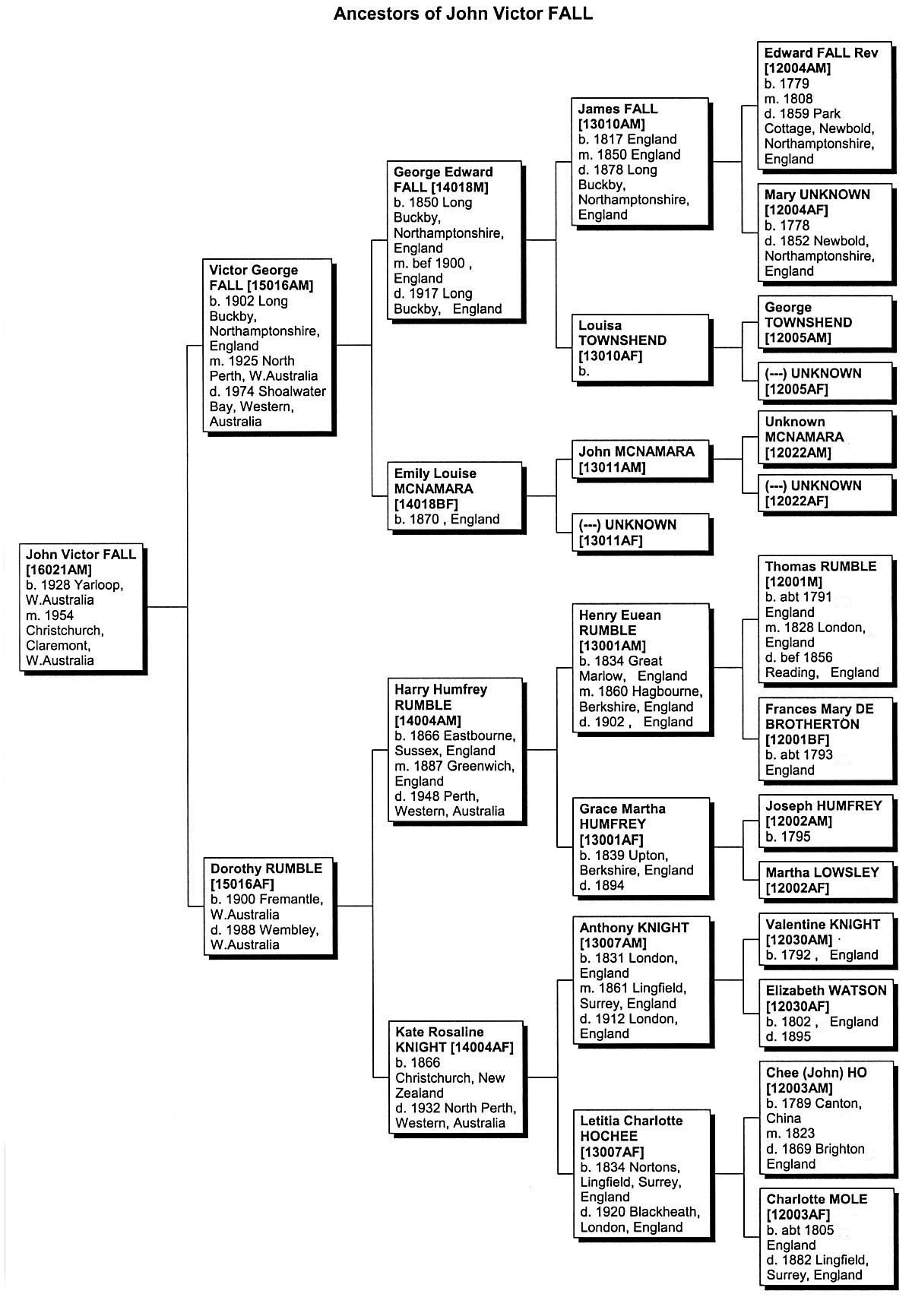
Below is the entire document as an HTML page, this allows internet searching, but to read the document itself, as originally set out, you may prefer to open it as a pdf. If so then email me for the file mark.rumble@freeuk.com
John Fall
2005 Technical Data
This volume was written using a WordPerfect 10 word processor The body of the text is in 12 point Times New Roman font Most quotations are in Lapidiary 333 BT 14 point font
Images were either scanned with a Cannon D1250 U2F scanner or obtained from a Nikon D 70 digital camera. They w ere processed with the Adobe Ph otoshop Elements image editing program
The Family Tree charts were generated as PDF files from the Personal Ancestral File 5.2 genealogical program of the Church of Latter Day Saints using the Personal Ancestral File Companion 5.1 program and were converted to JPEG image form at for inclusion in the text.
The final text was converted to PDF format and processed with the Adobe Acrobat 7.0 program, and stored on a compact disk, from which it was printed.
© Copy right 2005, John Fall 29 Paterson Gardens, Winthrop, Western Australia
Much of the material for this volume was drawn from two previous volumes that I wrote some time ago:
The Rumble Family Register, 1994 The Pot of Gold - The Autobiography of John Fall, 1998
Other major sources for my Chinese ancestry have been:
Guy Duncan: The Lives of John Hochee and John Fullerton Elphinstone, 2003 Peter Morris Jones: Family History, 2000
Both Guy and Peter are my third cousins.
Other members within the family who have assisted me are my second cousin Henry Knight and his daughter, Alexandra.
Andrew Williams - my second cousin removed by one generation was involved in discovering some family members, as outlined at the beginning of the book.
Within the Rumble family I was assisted by Mark Rumble and Michael Rumble and by Joyce, Joseph and Frances Rumble. Their relationship to me is shown in the chart on page 85.
Brenda Rohl, my first cousin removed by one generation, made a substantial research contribution when I was collecting material for the Rumble Family Register
I am also indebted to the Long Buckby Local History Society - and especially to Phil Davis - for early maps and photographs of Long Buckby village and for general background. This helped me enormously with putting together a more complete outline of the life of George Fall, my father’s father.
As always, my wife Kay has been of constant help in checking and proof-reading the material.
Introduction ......................................................... 1
My Ancestral tree to great-great-grandparents ........................... 2
Andy Williams and the ‘Four Generations’ photograph .................... 5
Part of the Hochee, Knight & Rumble Family Trees ...................... 6
The Background history of the Knights .................................... 7
My descendancy from Valentine Knight 10009 born 1722 ................. 9
The Valentine Knight burglary & Old Bailey Trial ................... 11
The second and third Valentine Knights ............................... 14
Memoir of Valentine Knight [12030] .............................. 15
His homes in later life ................................... 18
His family tree (his children) .............................. 20
The Family of Anthony Knight [13007] .................................. 22
His children: Family tree ........................................... 22
The first search for Ho Chee [12003] .................................... 23
Hochee and his children: Family tree ................................. 25
Alexandra Knight’s history of Ho Chee ............................... 27
Hochee photo album .............................................. 32
Hochee Almshouses .............................................. 37
Ancestors of Charlotte Mole [12003] ................................. 40
Charlotte Mole’s background .................................... 41
The Welch family ...................................... 42
Family charts .................................... 44
The Chamberlaine family ................................. 47
The Milton family ...................................... 49
Charlotte Mole’s life ........................................... 50
Third cousin Guy Duncan is discovered .................................. 51
The second search for Ho Chee ...................................... 53
Ho Chee’s origins in China ...................................... 56
The search for Ho Chee’s arrival in Britain ......................... 58
Ho Chee in Braughing and Lingfield .............................. 61
John Hochee’s later life ......................................... 64
The last days of John Hochee .................................... 65
curious comment on Hochee ................................... 66
Charlotte Hochee and the almshouses.............................. 67
Recent family pilgrimages to Lingfield ................................ 68
The launching of Guy Duncan’s book on Hochee & Elphinstone ........... 69
The children of John and Charlotte Hochee ............................ 70
Anthony Knight and his wife Letitia Hochee .............................. 72
The children of Anthony and Letitia .................................. 82
Kate Rosaline Knight and Harry Humfrey Rumble .......................... 85
Kate Knight’s life as a child ........................................ 86
Marriage .................................................... 88
Harry Humfrey Rumble his ancestry ..................................................... 90
The Humfrey background .......................................... 91
: 4 generation family tree .................... 92
Thomas Humfrey 06001 ........................................ 93
: 4 generation family tree .................... 96
: 3 generation family tree ..................... 97
The children of Joseph Humfrey ........................... 98
Grace Humfrey 13001 ............................................ 100
The de Brotherton Ancestry .................................... 100
Framlingham Castle .................................... 102
De Brotherton coat of arms .............................. 105
The Rumble Ancestry Thomas Rumble 12001 Descendancy chart for 3 generations ....................... 106
His life .............................................. 107
Frances Mary de Broltherton.................................... 109
The children of Thomas and Frances ....................... 110
Henry Euean Rumble 13001 .................................... 111
Architectural drawings .................................. 113
His children .......................................... 116
Ernest Rumble & his drawings............................ 118
Joseph Rumble’s drawings............................... 120
Harry Humfrey Rumble & Kate Rosaline Knight 14004..................... 122
The Family Quarrels ............................................. 122
Migration to Sydney ............................................. 123
The move to Western Australia ..................................... 124
Photos of early Fremantle ......................................... 125
Harry’s transfer to Perth .......................................... 130
The Barracks ................................................... 131
Their house in Colin Street, West Perth .............................. 132
Family photos, 1905 ............................................. 134
Harry’s work in the bush .......................................... 136
Harry’s photographic hobby: City buildings ........................... 138
The years in Perth before transfer to Bunbury.......................... 145
Silver Wedding .............................................. 145
Harry’s problem with drink..................................... 146
Harry becomes resident engineer at Bunbury .......................... 147
Blasting stone at Roelands ..................................... 148
Harry’s work ................................................ 149
Easter 1916 ................................................. 151
Harry’s motorcycle ........................................... 153
The First World War ............................................. 155
The End of World War I .......................................... 156
Their last days in Bunbury......................................... 161
Legacies received by Kate ......................................... 162
Short Holiday in Perth .......................................... 163
Buying a house in North Perth ...................................... 164
Geraldton Harbour Works ......................................... 166
Kate’s Death and Will ............................................ 167
Kate, Harry and Religion.......................................... 168
Harry Rumble’s eccentricities and problems........................... 170
Harry’s 80th birthday............................................. 176
Harry and Kate’s family Horace ........................................................ 177
Eric .......................................................... 179
Leslie ......................................................... 179
Maude ........................................................ 179
Euean Humfrey ................................................. 179
Phyllis ........................................................ 179
Dorothy Rumble [15016] ............................................. 180
The background of Victor George Fall [15016] ........................... 187
Rev. Edward Fall - my great-great-grandfather [12004].................. 187
Our search for Edward Fall ..................................... 191
Edward’s Bible flyleaf family record ............................. 192
Descendants of Edward Fall ....................................... 197
Edward Fall’s family ............................................. 197
Edward’s daughters: Emma, Hannah, Mary, Susanna & Rebekah ....... 198
Thomas Fall[13024] .......................................... 198
James Fall - my great grandfather [13010] ......................... 198
Long Buckby ................................................... 200
1884 Ordnance Survey map .................................... 202
The Family of James & Louisa Fall .............................. 204
George Edward Fall - my grandfather [14018] ......................... 204
Long Buckby’s background .................................... 205
George Fall’s clothing business ................................. 206
We visit the Firs ............................................. 207
Long Buckby photos .......................................209-212
George Fall’s marriage & Family ................................ 213
The descendants of John McNamara (Chart) ................. 214
The McNamara Family ................................. 215
The Children of George & Emily Fall ...................... 215
Victor George Fall .................................................. 217
Victor goes to sea ............................................... 219
Victor’s indenture papers ...................................... 220
Life at sea .................................................. 221
Victor and Dorothy ................................................. 230
Victor migrates and joins Millars’ Timber & Trading Company ........... 235
Fifty years of Forestry in Western Australia ........................... 236
Photographs of the early timber industry ............................. 237
and Dolly become engaged..................................... 239
Their wedding photograph ..................................... 240
Married Life at Mornington Mills ................................... 241
Transfer to Yarloop .............................................. 244
The town of Yarloop .......................................... 245
The Workshops ....................................... 246
Life in Yarloop The birth of Dorothy Joan ............................... 250
The birth of John Victor................................. 251
The Great Depression of the Thirties ................................ 254
v vii
is promoted to Chief Clerk ..................................... 255
My memories of living in the Yarloop House .......................... 257
Victor and Douglas Social Credit ................................... 259
Yarloop Annual Sports Day........................................ 260
Vic’s interest in Aircraft .......................................... 264
The Yarloop swimming pool ....................................... 265
The Baby Ford car ............................................... 266
The move to the city ............................................. 267
The Second World War ........................................... 268
joins the RAF: Singapore & Malaya .......................... 269
Japan enters the war: Victor becomes a prisoner of war ............... 272
Life as a prisoner of war................................. 273
Dorothy’s life during this period .......................... 275
The end of the war: Vic returns home ............................. 275
Pictures from POW Camp, Java ................................. 277
Settling back into civilian life ...................................... 278
Joan becomes engaged & travels to the US......................... 270
Vic’s recovery ............................................... 282
Retirement - a home in Warnbro, then in Shoalwater Bay ................ 284
Extended holidays ............................................ 285
The Rockingham Historical Society .............................. 286
takes up writing and published two books ...................... 286
The Death of Victor in 1974 .................................... 288
Dorothy’s life after the death of Victor ............................... 288
Joan and Joe visit Western Australia.............................. 290
Dorothy moves to Wearne hostel ................................ 291
second visit from Joan ....................................... 292
The death of Dorothy ......................................... 293
Dorothy’s descendants ........................................294 - 295
Appendix I - Old Bailey transcript re burglary of Valentine Knight ............ 296
John Fall
My Ancestral Tree - Back to Great-Great-Grandparents

 here
are many reasons why I decided to search for my ancestors.
here
are many reasons why I decided to search for my ancestors.
Between 1958 and 1960 I spent some time in Britain, and sought out the gravestones of a few of my forebears; I have portraits and
photos of grandfathers, great-grandfathers and even of a great-great grandfather. My mother spoke of my Chinese ancestry, while my father told me of a great-great grandfather, the Reverend Edward Fall, a Baptist minister in Rugby, who was known as the “Silver tongued.”
Of course, with a minimum of information it is possible to draw a chart of one’s ancestors, as I have done on the preceding page - but this tells us nothing about the people apart from where they fit in the family.
On the left in the chart, we start with myself and then my parents, Victor Fall and Dorothy Rumble, while on the right we have my great-great grandparents. In a few cases - for the Knights and the Humfreys - I can trace back to earlier generations. Excluding myself, this chart could include thirty ancestors but, unfortunately, we do not have details for them all.
But as orderly and as attractive as this chart may be, it is not how we actually find our ancestors. It is too logical, and too neatly laid out. In reality we find them by following leads from various sources - from family records, letters, old photos, census records and even from family folklore passed on by word of mouth.
We find items of “truth”, record them, and then our search changes course; or we find new leads which sometimes lead to contradictions and the need to revise our “truth” .
The search I am about to present, is not orderly but will twist and turn. Although I started half-heartedly in the 1950s, and then tackled it earnestly from 1989 onward, there is no better way to illustrate the random path of progress than to start with Andy Williams, a second cousin of mine, removed by one generation, and whom I did not discover until 2002.
Found in Andy Williams’ Attic: Left to right - Elizabeth Watson 12030AF (b1802) who married Valentine Knight 12030AM, her son Anthony Knight 13007AM (b1831), his daughter Mary Knight 14001AF (b~1872) who married Herbert Rumble 14001AM, and their daughter Lottie Rumble 15001AF (b1893). My grandmother Kate Knight was Mary’s sister, while Kate’s husband was Harry Humfrey Rumble, brother of Herbert Rumble
FOUR GENERATIONS
![]() ndy Williams was born in 1957 and is almost the same age
as my son Peter. Until 2002 I had never heard of him. Andy married a
Chinese girl Ka-Yin Leung from Hong Kong and in 2000 they had a
daughter, Maya. Two years later he decided to track down the family
legend that he had a Chinese ancestor of his own, but everyone in the
family seemed very vague about it. Early in 2002 he recalled:
ndy Williams was born in 1957 and is almost the same age
as my son Peter. Until 2002 I had never heard of him. Andy married a
Chinese girl Ka-Yin Leung from Hong Kong and in 2000 they had a
daughter, Maya. Two years later he decided to track down the family
legend that he had a Chinese ancestor of his own, but everyone in the
family seemed very vague about it. Early in 2002 he recalled:
My grandmother, Lottie, always claimed that she had a Chinese ancestor. She said that he was a Chinese merchant with a pig-tail, but didn’t know his name or how far back he was in history. Lottie was a scatterbrained lady: great fun, a very good artist, woodcarver and cook, but hard facts were not her strong suit.
Lottie’s husband, Herbert Graham Rickard* Williams, on the other hand, was very keen on tracing his family. With the help of the family bible and quite a few old documents, he traced the Williams’ line back to 1640, and a baronetcy which he missed by a whisker. (* NOTE: ‘Rickard’ is the correct spelling, with a ‘k’)
My dad, John Williams, who died in May 2001, was strangely uninterested in his Rumble relatives and ancestors. He dismissed the Chinese ancestor as “just one of Mum’s stories”.
Andy decided to rummage around in the attic of their home at Stroud in Gloucestershire, UK. He knew that many of his grandfather’s old belongings were there, probably covered in dust. Unexpectedly he found a fine old metal bowl in a box of his grandfather’s belongings that had been stored there for 15 years since Herbert had died. Ka-Yin identified it as being of Chinese origin from the early Ming dynasty in the sixteenth century. Maybe there was some truth in a Chinese background to his family! He became obsessed with finding out.
He also found two other items of interest: One was an old photograph titled
- FOUR GENERATIONS - 1/7/94
as reproduced on the previous page. Beneath the picture itself (but not shown on our reproduction here) was the handwritten name of his grandmother: Lottie. He knew that Lottie had been born on 17 May 1893 - so the baby in
the photo tallied with the name. Andy presumed that she was sitting on the lap of her mother, Mary Rumble - so that accounted for two of the four generations. But who were the other two people? He did not know. Tracking down their identity lay in the future and would involve other family members of whom, at that time, he had never heard.
The next clue that Andy found was a newspaper cutting that dropped out of one of his grandfather’s books in the attic. It referred to a Horace Rumble in Perth, Western Australia. Andy recalled:
When my Mum Pamela pointed out that Horace was my grandmother’s cousin,
not brother, I assumed that that his line couldn’t help much in my quest for the
Knights, but I decided to follow it up, just in case.
ANDY WILLIAMS AND HIS FAMILY SEARCH
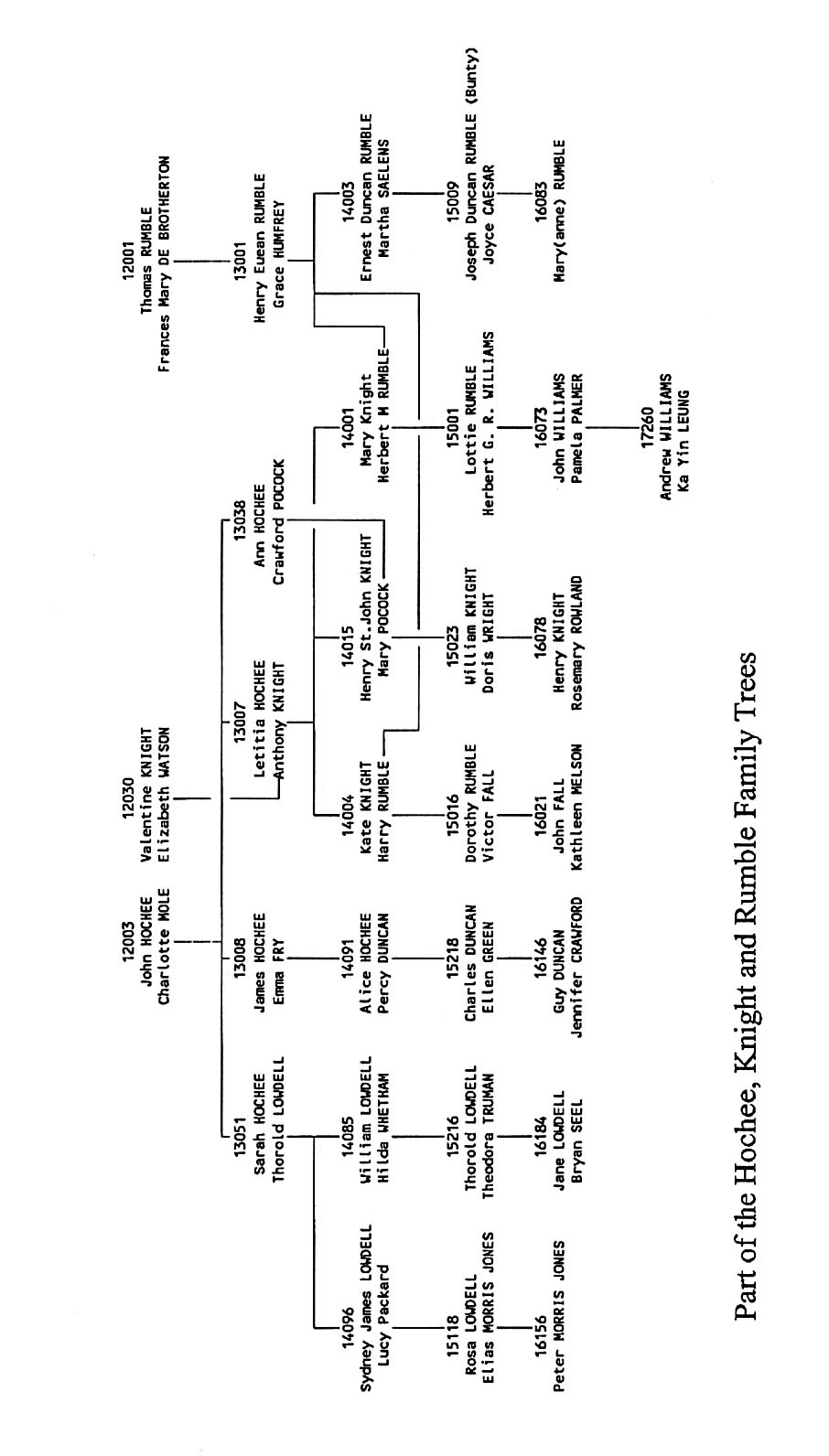
ANDY WILLIAMS FINDS HIS WIDER FAMILY 7
The old newspaper cutting that Andy had found referred to Horace Rumble as the oldest member of the Royal Perth Yacht Club in Western Australia. Andy, was not only the same age as my son, but worked in the same industry - in the area of electronics and integrated circuits, so he was very familiar with computers. It did not take him long to find the Internet web address for the yacht club1. He wrote an email to them enquiring about Horace Rumble, not knowing that my uncle Horace had died long ago in December 1989. Fortunately Horace’s son, Peter, was still a member of the club, and the club contacted him.
In 1994 I had written a Who’s Who of the Rumble family2, but Peter could not find Andrew Williams within his copy, so he phoned me and gave me Andy’s email address. I already knew that Lottie Rumble had married Herbert Williams and I had a record of one son, John. I emailed Andy and asked if he was the son of John Williams. He replied that he was - being the second of four children. Soon he knew much about John Hochee and his Chinese Ancestry, and I put him in touch with my second cousin Henry Knight and third cousin Guy Duncan both of whom had completed research into the family. I had already encountered both of these people in my earlier research.
Photo
of John Fall and Guy Duncan, 2008.
We were still in doubt about the identity of the remaining two people in the “Four Generations” photograph. Andy, Henry Knight and his wife Rosemary, my wife Kay and I debated the issue at length. We finally established that the man was Anthony Knight - the father of both Mary Knight and of my own grandmother, Kate Knight. There was a double connection in the family as the two girls, Mary and Kate, had married two brothers, Herbert Rumble and Harry Humfrey Rumble, my grandfather.
The remaining person in the picture had to be from an earlier generation. After much examination we decided that it was Elizabeth Watson, who had married Valentine Knight, Anthony’s father. Elizabeth had been born in 1802 so that in the photo she would be 92 years of age. We thought that she did not look that age; Using digital techniques on my computer I refined and magnified her face from the photograph and examined her eyes and the loose skin under her chin: Yes, I decided, she could be 92 years of age. Henry and Rosemary concerned themselves with the shine on her “hair” : was it her hair, or something else? They discussed her clothing style. The outcome was that everything pointed to her being whom we thought. Elizabeth died the following year in 1895.
Andy found one other photograph in the attic which seemed to clinch the matter. It was a photo of Herbert Rumble sitting on the beach with an older couple. The man was clearly the same person as in the “Four Generations” photo - so we presumed it was Anthony Knight.
1
http://www.rpyc.com.au 2 Fall, John: The Rumble Family Register, 1994 Privately published
THE MYSTERY OF THE ‘FOUR GENERATIONS’ PHOTO
8
The woman with him we thought would be his wife Letitia. When I looked at the photo I saw a strong resemblance to my own mother, Dorothy Rumble. Henry Knight also noted family resemblances to ‘Letitia’ in the beach scene. He remarked: ‘I can see my niece Karen Jakobsen looking straight at me.’
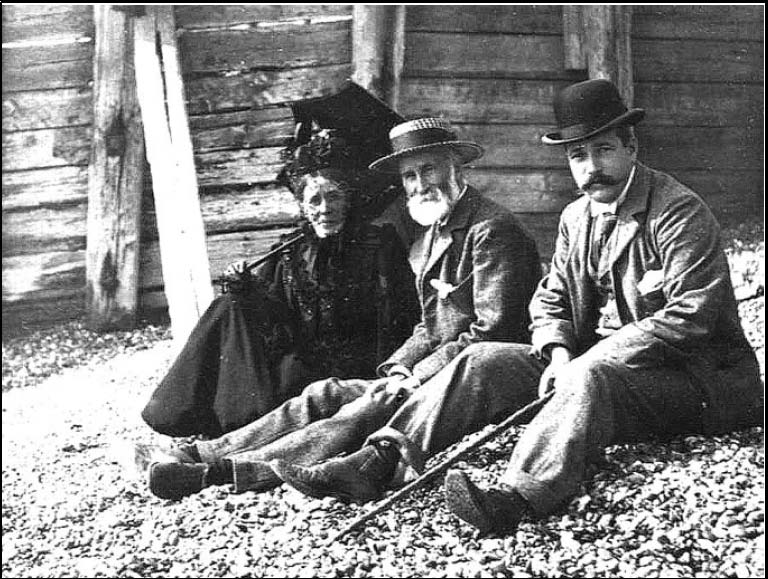
Letitia Knight (nee Hochee), Anthony Knight & Herbert Rumble
Henry Knight also saw resemblances in the ‘Four Generations’ photo. He wrote:
‘Four generations’ has caused much excitement across the land.... We are convinced that the older lady on the left is Elizabeth Knight, the man her son Anthony Knight, then Mary Georgina and Lottie. We have compared heads of the man with Anthony's grandson Ernest St John Knight and find great similarities. Also to my father. The picture was taken at Vanbrugh Terrace, Blackheath, 4 days before Henry St John Knight married Ellen Theresa Glanville on 5/7/1894. My father used to say that Elizabeth travelled to Blackheath from Eastbourne in her 90's 'on a bus'. She died the following year. It all fits.
I already had some information from my earlier researches:
Elizabeth, the daughter of William Watson, was probably born in 1802. She married Valentine Knight on 13 December 1823, and died on 10 March 1895. This information was in an old diary found by Henry St.John Knight at No.2. Vanbrugh Terrace, Blackheath, London, when Letitia Knight died in 1920. Henry St.John Knight wrote to his sister Kate giving this information. Part of the letter is in the possession of John Fall.3
3extract from Fall, J: The Rumble Family Register page 116
THE BACKGROUND HISTORY OF THE KNIGHTS
9
10009 Valentine Knight b1722 Sp. Ann | 11010 Valentine Knight b? Sp. Mary | 12030 Valentine Knight b 1792 Sp. Elizabeth Watson b1802 | 13007 Anthony Knight b 1831 Sp. Letitia Hochee b 1834 | 14004 Kate Knight b 1866 Sp. Harry Rumble b 1866 | 15016 Dorothy Rumble b 1900 Sp. Victor Fall b 1902 | 16021 John Fall b 1928 Sp. Kathleen Melson b1926
The abbreviated chart on the left shows the line of descent from the earliest known member of the Knight family down to myself. Anthony Knight was my great-grandfather, but we know of three generations before him - and in each case they were named ‘Valentine’4. Much of our information stems from the research of Alexandra Knight, the elder daughter of Henry.
Alexandra discovered that Valentine Knight [10009] was born around 1722. He was apprenticed to Hugh Davis on 1 August 1739 to learn the trade of leatherselling. He was made a Freeman of the Leathersellers' Company by Servitude on 1 August 1749 and was admitted to the Livery in 1760-1.
By this time he was married to Ann, of whom we know nothing, and he later became a jeweller in Foster Lane, off Noble Street, London. He died in February or March 1769.
We know that Valentine and Ann had a family, but only know the names of two children - Valentine [11010] and Robert.
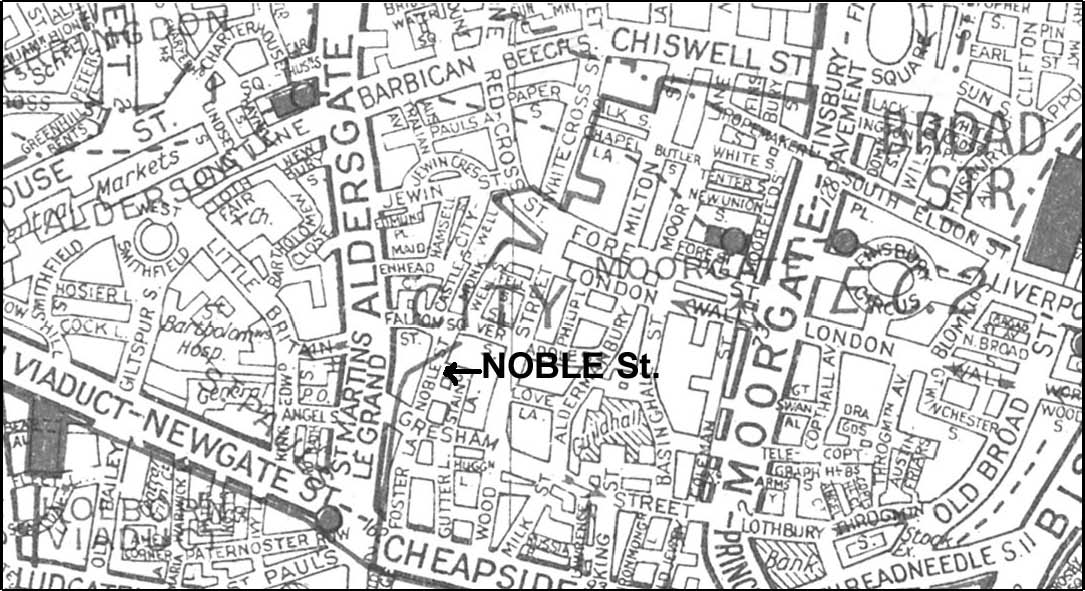
Noble Street is near Cheapside and Aldersgate Street in central London, as marked in the map above.5
Because many people in families are given the same name - for example, there are three ‘Valentine’ Knights in the chart above, I have associated a unique ID number with each person to avoid confusion. T he first two digits represent a ‘generation’ number (arbitrarily 16 for me, 15 for my parents, and so on). The next three digits give a ‘family’ number within that generation. I first adopted this for the 1994 Rumble Family Register.
5 This map is taken from a 1958 London Street Directory
The above is a typical London street not far from Noble Street, in the 1800s
This is Cheapside, also not far from Noble Street, but about 100 years after the time of Valentine Knight
If it were not for further research in 2004 by Alexandra Knight, the above would be the sum total of our knowledge of our first Valentine Knight. However, Alexandra gained access to the Internet website6 of the Old Bailey7 in London and searched for ‘Knight’. She discovered the transcript of a trial in which John Andrew Martin stood trial for theft and burglary of the Knight’s home on 17 October 1768. The transcript lists Valentine’s wife as Mary, although Alexandra’s records show her as Ann. The transcript commences with:
John Andrew Martin was indicted for breaking and entering the dwelling-house of Valentine Knight , on the 17th of Oct. about the hour of two in the night, and stealing seven pair of snam-garnet gold buttons, value £6. 6 s. six pair of garnet ear-rings, set in gold, value £3. [a very long list of items stolen follows]8
Following this list, an opening statement was made by Valentine’s wife, the first part of which, follows:
I am wife to Valentine Knight, we live in Noble-street, Foster-lane, he is a jeweller. On the 18th of October last, I was alarmed about three in the morning; our bell rang, we lissened to know what was the meaning; I heard a person run up stairs. Mr. Reynoldson, that lodges in our house, call'd, and said, he believed there were thieves in the house; he came down into my chamber and took the keys, and went down stairs.
I followed him immediately after; my husband was ill in bed; and is so ill now he cannot attend the Court. When I came into the parlour, I found the flap of the cellar window was torn up, and a padlock torn from the cellar door, that opens into the street upon the cellar stairs; the door shuts on the flap, and was padlock'd on the inside. There is a window seat like in the parlour, which was a head-way front, the top of that was wrench'd off, and the top of it lay upon the ground; by that means a passage was opened into the parlour, close to the bureau where our goods were locked up: I locked them up myself, about eleven o'clock over night; I am always the last up, and know the cellar door and flap were safe at that time. . . .
Various witnesses were called and some of the stolen items were recovered. Martin was also accused of fourteen other indictments against him for burglaries, and he had been tried twice previously for other offences.
The transcripts gave a simple verdict: GUILTY - Death.
Hanging was, in those days, a very public affair, as illustrated by Hogarth on the next page.
6 Website: ww w. oldbaileyonline. org. John Andrew M artin 7 December 1768, The Proceedin gs of the Old Bailey Ref: t176812 07-9
7 The Old Bailey was the Central Criminal Court in London
8 The full transcript is given in Appendix 1 - page 296
Up until 1783 Tyburn Hill was the principal place of execution of criminals. This drawing by William Hogarth (1697-1764) is typical of the scene faced by Martin at his hanging
Before we examine the son and grandson of our first Valentine Knight, I will pause to look briefly at some pictures from the family album:
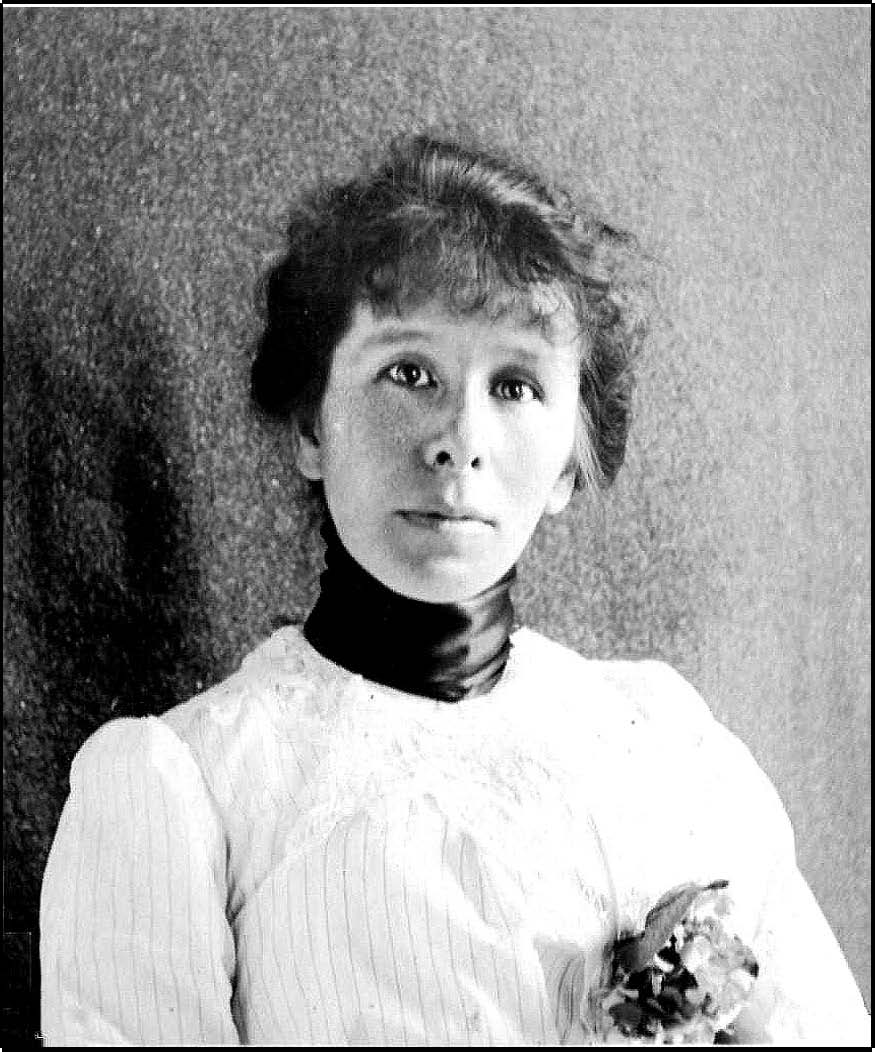
Mary Knight [14001AF]
Mary Georgina Knight, born in 1872, was the younger sister of my grandmother, Kate. She appears in the “Four Generations” photo on page 4, and in the family chart on page 6. She married Herbert Rumble in 1891 and had five children of whom Lottie Georgina, born in 1893, was the first.
Herbert, always known as Bertie, trained as a mechanical engineer. In1897 he was working in Buenos Aires while Mary and her children lived at her parents’ home which, by then, was at 2 Vanbrugh Terrace, Blackheath, London.
Little Lottie Rumble (page 4) grew up and married Herbert Graham Williams in 1921. They are shown in later years in the photo on the left. They were Andy Williams’ grandparents.
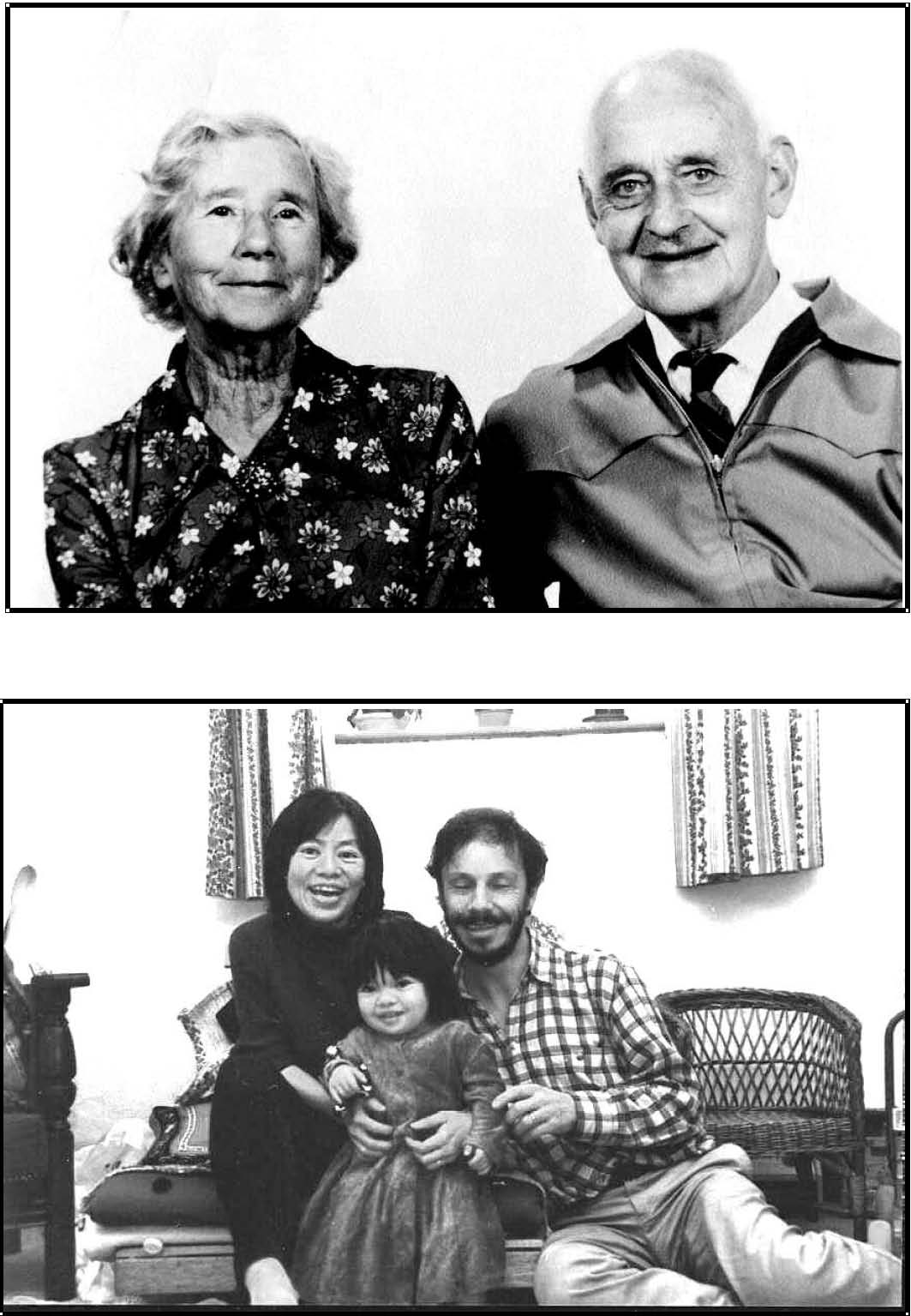
Kay-Yin, Maya & Andrew Williams
Those who contributed to research on the Valentine Knights are shown here. Above, Andy Williams and his family in February 2002 and, on the right, Henry Knight [16078] with Guy Duncan [16146] - who will enter our story when we explore our Chinese connection.
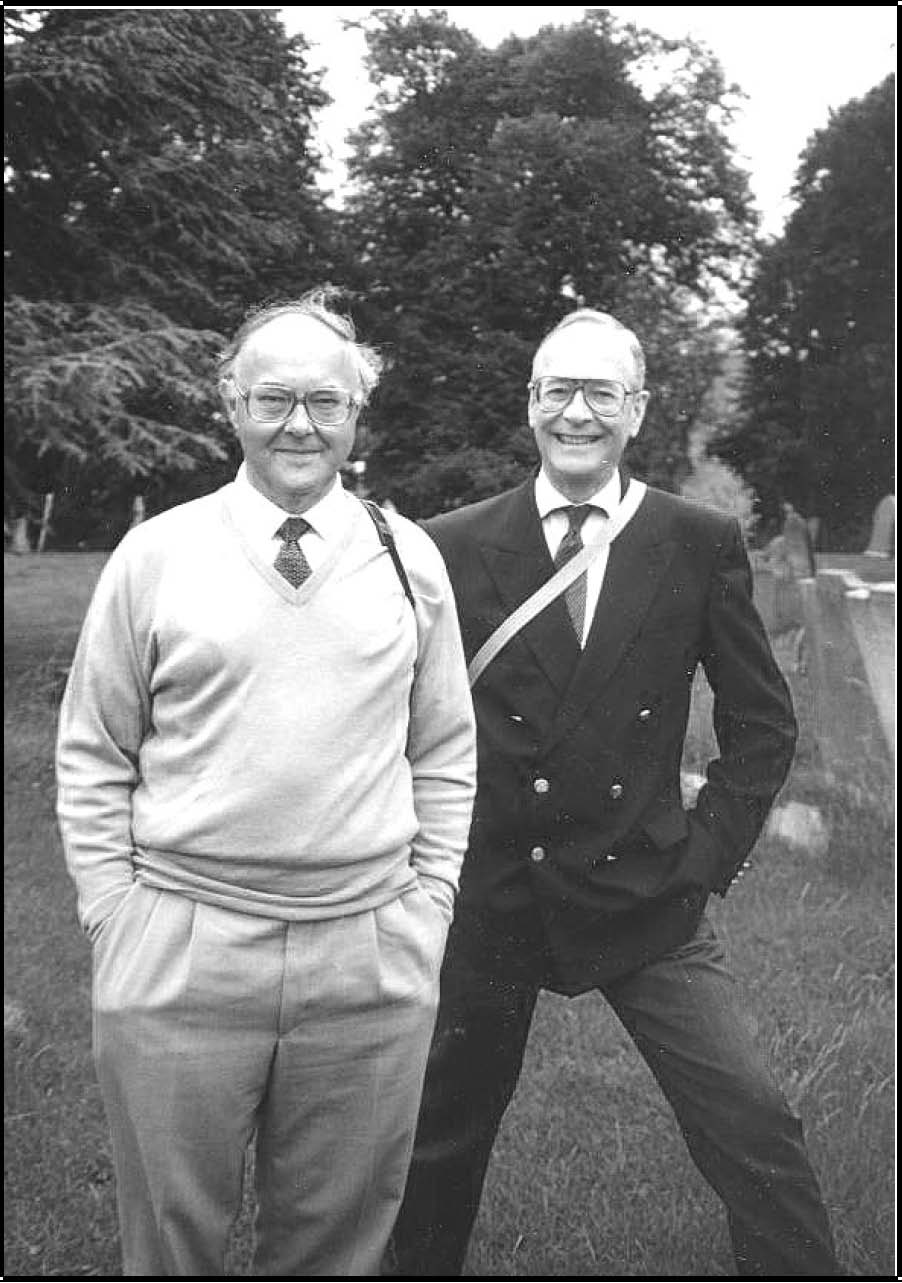 Henry
Knight & Guy Duncan
Henry
Knight & Guy Duncan
We know very little about Valentine [11010], the son of Valentine and Ann Knight. He was probably born in 1754. His brother, Robert, was apprenticed to learn the art of engraving, while on 13 January 1767, Valentine was apprenticed to Richard North, a Goldsmith of Lombard Street. Lombard street, not far from Noble Street, was in the hub of the City of London, and became a famous banking area. It derived its name from the Lombards, merchants, money-lenders, and bankers who settled there in the twelfth century from Genoa, Venice and Florence. The Lombard street of today probably bears little resemblance to the street towards the end of the eighteenth century because at that time six famous streets: Threadneedle Street (of Bank of England Fame), Cornhill, Lombard Street, Wallbrook, Poultry and Princes Street all converged in this area, but extensive changes were made in 1831 when buildings were pulled down and two new streets created.
Valentine became a Freeman of the Goldsmith’s Hall by Servitude on 1 February, 1775. Both he and his brother Robert eventually became jewellers in Noble Street. We know that Valentine married Mary and that they had a son - also named Valentine [12030], but we do not know if there were other children, nor when he and his wife died. 9
It is a very different matter with the next Valentine. He made quite a name for himself and much is recorded about him. He was born in 1792 in London and was baptised 1 January 1793. We know little of his very early life but first hear of him when, on 5 December 1821 at the age of 29, he became a Freeman of the Goldsmith's Hall by Patrimony10. Two years later, on 13 December 1823, he married Elizabeth Watson, the daughter of William Watson a watch-case maker at St.James, Clerkenwell. Between 1825 and 1843 Valentine and Elizabeth had ten children.
Initially the family lived at 4 Newcastle Place, Clerkenwell Close, where Valentine had recently set up as a goldsmith specialising in engine turning - a process for producing symmetrically patterned engravings. He found a substantial demand for engraved gold and silver dials for clocks and watches and pursued this line of business in particular. The business flourished due to Valentine' s dedication and the high quality of his work. He died on 17 November 1867 in his 75th year. His wife survived him, to die at the age of 93 on 10 March 1895. Both were buried at Highgate cemetery.
9 Research by Alexandra Knight [17149]
10 When discussing the Valentine Knights, two words - Servitude and Patrimony - have been used. Patrimony is something inherited from one’s father or ancestors. If one’s father was a goldsmith and his son follows him into the trade, then he gained entry to the profession by patrimony (or by inheritance). If one’s family was not already in the profession, a young person could become an apprentice to someone in that profession and eventually gain member ship ‘by servitude’. Strictly, servitude is a condition in which one lacks liberty to determine one’s way of life
THE THIRD VALENTINE KNIGHT [12030] - A SELF-MADE MAN
15
Brenda Rohl11 visited this cemetery in 1989 and gave the following account:
Highgate cemetery is the most amazing place; very Victorian!! I had to walk up the "Egyptian Avenue" and around the "Circle of Lebanon" where the crypts are. The poor Knights seem like the paupers on the block!! The grave is mottled brown marble and is only about knee height.
Among other things, Valentine became the Founding President of the British Horological Institute and their Journal published on 1 December 1867, contained an obituary that gives an excellent insight into his life and standing in the community:
With deep regret it becomes our sad duty to record the death of Valentine Knight Esq., President of the British Horological Institute, which happened on the 17th November, 1867, at his residence, Thorncroft, Leatherhead, in Middlesex. He was in his 75th year, but until lately was hale and active, having a much younger appearance.
Valentine Knight was essentially a self-made man. The scene of his earliest life was in Newcastle Place, Clerkenwell Close, where for many years he conducted a flourishing business as gold and silver dial-maker and engine-turner. For some years before quitting the business, he joined partnership with Mr Burr. He was renowned for the style and excellence of his work in the palmier days of watch making, particularly for his success in the color of his dials. At the annual dinner of the Institute in 1863, he said of himself, in the genial manner peculiar to him :-
“I have always felt a deep interest in the welfare of Clerkenwell, and I hope I shall always continue to do so. At an early age I set up in business in it, in the engine-turning and gold-dial departments. I happened to have a very lucky rise. I chanced to make an article in the gold line, such as I believe I may say with truth was equalled by no other person. When Americans came to Coventry or London to give orders for watches, they almost always insisted upon having Knight's dials. That was a very great advantage to me. To a certain extent I was a child of fortune. I succeeded much beyond my expectations. During many years I worked sixteen and eighteen hours a day, and sometimes all night. Such an enormous business I was sure could not last, and I therefore thought it better to make hay while the sun was shining. I did so, and at a comparatively early age was enabled to retire from business.”
11 Brenda [17033], born 1965, is the daughter of my first cousin Robin Furphy.
His retirement from the business in Clerkenwell, only however necessitated employment in other affairs for a mind so active and a head so clear as his.
He was one of the earliest directors of the Mutual Life Assurance Society, a flourishing association, which was the first (excepting the Amicable) to raise its claims to public support on purely mutual principles. Having its origin among Clerkenwell supporters, it is gratifying to know, the Mutual is one of the solidist institutions discharging the important functions of Life Assurance. Mr Knight's business habits led him to take a very active interest in those great works of modern times, railways, and his voice was often effectively raised at their public meetings against prodigal expenditure. After giving up his trade pursuits, Mr Knight filled for some years the office of Magistrate for Middlesex. He was elected to, and liberally and worthily discharged the duties of President to several trade institutions.
He was President of the Watch and Clock Makers' Asylum, to which he contributed generously. He was intimately associated with the Horological Institute from its very beginning, having been called upon by the Preliminary Committee to preside over the public meetings which they had called, and which took place at the "Belvidere Tavern," Pentonville, on the 15th June, 1858, having for its object the founding of the Institute. To that call he responded, and by his capital ability as chairman, and by starting a subscription list with his own cheque for ten guineas, he made an acknowledged success of that first effort.
When the institute had been organised, Mr Knight was unanimously elected to the honorable post of President, to which he has been year by year unanimously re-elected ever since. His lamented decease causes the first vacancy in the presidentship. At the Inaugural Dinner of the Institute, he said,
"Other countries might have carried the science of horology to a great extent, but
it would be a disgrace to Clerkenwell to be second to any nation under the face
of the sun in that art."
And he invariably insisted upon the claims of the Institute, not only upon the trade, but the public also.
He pronounced the Institute to be an association which was wanted for the honor of the country and the trade, to enable it to flourish as it ought to do; and he was sure that through its means, watchmaking would prosper.
THE THIRD VALENTINE KNIGHT [12030] - A SELF-MADE MAN 17
Although he considered himself an outsider of the trade, he should be happy at all times to give all the assistance to it which lay in his power, not only by personal attendance at its meetings, but by subscribing to its funds, and assisting it in causing it to prosper to the extent which it so highly deserved. He felt deeply interested in horology, and had a high respect for every man connected with it, and should always feel pleasure in meeting them upon such happy and convivial occasions.
How faithfully he bore in mind and acted upon his promise, never swerving or becoming lukewarm, is well known to the members.
During his presidency, the British Horological Institute has been greatly indebted to him; firstly, for his great attention to the duties of his office, secondly, for his warm advocacy of the claims of the Institute to public support, but above all, for the great influence he possessed with all connected with horology whether immediately or remotely, this influence being constantly exerted to expand the Institute and its funds, while few could withstand the solicitations of one so generally beloved.
His social position was eminently conducive to the success of his kind intentions. He had retired from business in Clerkenwell long enough to prevent even the memory of trade jealousy to remain, even if he had ever exhibited any, which is very doubtful, for he was personally of an excellent presence, a very amiable temper, and possessed of a manner well calculated to endear him to those with whom he was brought into contact. He was, without exception, the most liberal supporter of the Institute, took the warmest interest in it, and made it a point of honor and duty to assist whenever his services were required, or he could aid it by his influence. Whenever it was necessary to confer with him, upon the affairs of the Institute, he was always a ready listener, and from his great and varied experience, and good judgement, he was an excellent counsellor.
At the anniversary dinner in 1861, he stated modestly, but how truthfully his conduct has always shown;
"I shall never deem it a condescension on my part to do what I possibly can to promote the interests of any society which tends to the welfare of the parish of Clerkenwell, and more particularly to the watch trade. Having spent many years of my life within that district, and having taken some money out of it, I should be ashamed of myself if I looked back without having a feeling of kindness and good fellowship towards those with whom I was formerly associated; and until the last day of my life I assure you that I shall have very great pleasure in forwarding the interests of all the societies connected with the parish."
Valentine Knight lived at No.3 Cornwall Terrace, Regents Park, London (above) from about 1840 to 1860. No.3 is just to the left of the four round columns on the right side. The first floor half-round window belongs to it

Valentine finally retired to Thorncroft, Leatherhead, Surrey (formerly, Middle
sex) - as shown above
THE THIRD VALENTINE KNIGHT [12030] - A SELF-MADE MAN 19
At the anniversary dinner which took place this year he said he was fast getting into the sere and yellow leaf, but as long as he lived and could appear before the members of the Horological Institute, nothing would give him greater pleasure.
Those who heard these words little thought how soon he who uttered them would be lost to them. Peace be with him! Clerkenwell will long remember him, self-made men, yea all men, might well have imitated his happy disposition, and geniality of character.
Before his retirement in 1851, the family had moved to number 3 Cornwall Terrace on the Outer Circle of Regents' Park, near the top of Baker Street. They later moved to Thorncroft, an elegant country manor, built in the 1770's, on the outskirts of Leatherhead, then in the county of Middlesex, but now in Surrey. There had been a house on this site since before Domesday and it held one of the two Manorial Courts in the area. The house still stands today but is used as offices.
While we know much of Valentine, we know little of his wife Elizabeth. In her Will, dated 1882, she left her house for her son William to occupy for three years after her death with the option to purchase it for £4,725 stg. Otherwise the house was to be sold and the proceeds then became part of her estate, which was divided equally amongst her children. In 1882, a house of this value, must have been substantial. She also refers in her Will to marble busts of herself and her late husband by E.H. Baily, the man who produced the Statue of Nelson in Trafalgar Square, London.
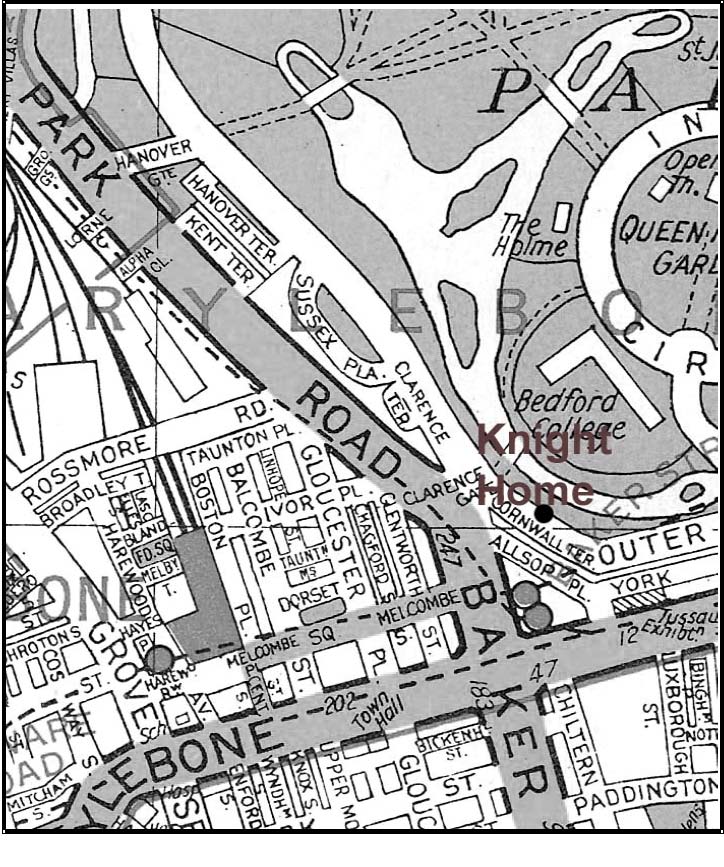 As
a small aside to this, in February 2005, Henry Knight [16078] wrote:
As
a small aside to this, in February 2005, Henry Knight [16078] wrote:
My daughter, Alexandra, rang rather excitedly to say that Sotheby's, the auction house, was selling a bust by EH Baily just listed as a 'Gentleman 1843'. We reckoned that the features were reasonably closely aligned to various members of the Knight family and by rough science estimated that there was a 1 in 4 or 5 chance that it was Valentine. So we went to the auction. Lot 99 quickly came under the hammer and the auctioneer uttered the words ‘possibly Palmerston’12
I made my bid according to plan and pushed the price well beyond the pre-auction estimate but let it go to a telephone bid when it looked like becoming an expensive investment. As for Valentine Knight, he may still be out there somewhere.....
12 Former Prime Minister and Foreign Secretary of Gunboat Diplomacy fame.
As is shown in the chart on the preceding page, Valentine and Elizabeth Knight had ten children. We know only a little about their children except for Anthony:
Valentine Catherwood Knight was born in 1825, matriculated to University College in 1844, graduating in 1848. He was called to the Bar, Inner Temple, in 1850, and later became curate at Pucklechurch, near Bristol. He died on 28 August 1876 near Boulogne, France.
Elizabeth Knight was born in 1826 and married William Atkinson Langdale in 1857 being his second wife. William was the fourth child of Marmaduke Robert Langdale and Louisa Jordan. He was born on 6 November 1818. There is an entry for him in The Landed Gentry which stated his address as Ladbroke Square, London. He had four sons by his first marriage; after his wife died, he married Elizabeth. He died on 30 October 1874.
William Watson Knight, the third child, was born in 1828 and remained a bachelor. He died at Eastbourne on 16 April 1893
John Watson Knight, the fourth child, was born on 10 March 1830. We know very little about him except that he married, and that the 1895 marriage certificate of his son John Aubrey shows his father as a witness and describes him as ‘Gentleman’ - in those days this word would have indicated that John was a member of the Landed Gentry.
The next child was Anthony, my great-grandfather. We will leave him to last.
Frederick Knight was the sixth child. He was baptised on 4 March 1834, became a member of Her M ajesty’s 69th Regiment and died at the age of thirty on the 8th June 1864 at Marylebone.
Charlotte Russell Knight was the seventh child, baptised on 13 May 1836. She married William Hill, later Lieutenant-General of Her M ajesty’s 2nd West India Regiment. They had a son, Valentine Hill [14097]. We only know of his existence through the Will of his grandfather Valentine Knight [12030], which stated:
I direct that twelve months after the death of my wife five hundred pounds shall be invested in lieu of her lapsed income for the benefit of my grandson Valentine Knight should he then be living to be paid to him with accumulations at the age of 21. In the same way two hundred pounds to my grandson Valentine Hill.
Katharine Knight the eighth child was baptised on 6 December 1838. Her marriage to Arthur Drinkwater Bethune Chapman is shown in the December 1881 records for the parish of Eastbourne. My grandmother, Kate Knight [14004] received a letter from Arthur on 5 May 1919. This was probably not long after Katharine’s death. It is interesting to note that a former owner of Thorncroft, the elegant country manor to which Katharine’s parents retired, was a Colonel Drinkwater Bethune.
Henry Knight, the ninth child was born on 13 June 1841. He matriculated to Brasenose College in 1860. We know nothing more of him.
Alice Mary Knight, the tenth and last child was born on 27 July 1843. She married the Reverend Henry Vincent Shortland as noted in the July 1881 quarter records of the parish of Kensington.
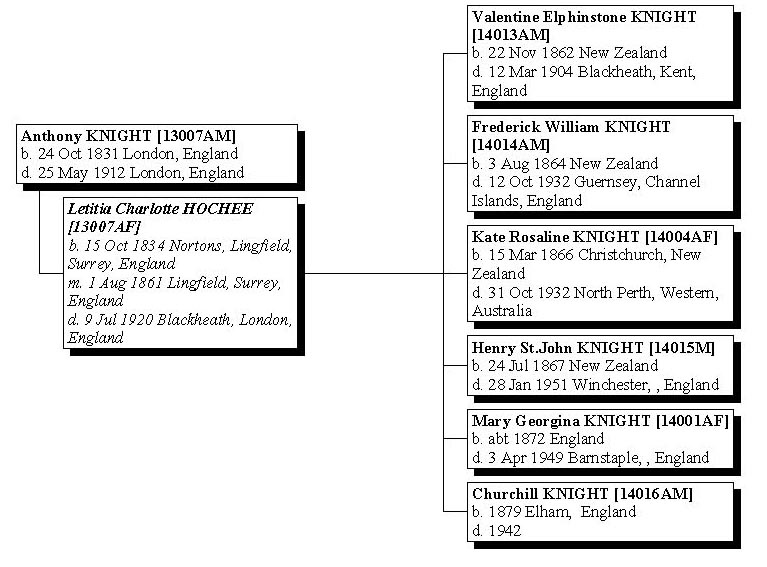
Anthony Knight, my great-grandfather, was born in London on 24 October 1831, being the fifth child of Valentine and Elizabeth Knight. He married Letitia Hochee at Lingfield, Surrey, England on 1 August 1861 and died on 25 May 1912. They raised six children, as shown in the chart, above.
My mother, Dorothy Rumble [15016], always romanticised about her ancestors. When I was very young, she told me that Anthony was a very rich man who had no need to work for a living. He dabbled, she said, on the stock exchange, implying that this was simply an amusing, gentlemanly pursuit. She also said that his wife, Letitia Hochee, was the daughter of a rich Chinese man, Ho Chee, who had married a young seventeen year old English girl. She said that Ho Chee may have been the Chinese Ambassador to Britain
- but, whatever he was, she implied that he was of high social status.
Anthony and Letitia, she told me, were so rich that they travelled to New Zealand with all their family and servants and that it was in Christchurch that my grandmother, Kate Rosaline Knight [14004] was born. I was also to discover that, at the time, there was no Chinese Ambassador to Britain, and that Anthony’s life was not exactly as my mother imagined but, before we look at Anthony and Letitia’s life, we will examine the Chinese connection, alluded to at the start of this search13.
13 See page 5
When my mother died in 1988 I found amongst her papers the addresses of English relatives with whom she corresponded. These were all on the Rumble side of the family, so I wrote to them. Over a period of time they gave me much information about my Rumble ancestors but at that time I had no contacts for the Knights.
One day, amongst my mother’s papers, I came across a small hand-written family tree in which the name of Ho Chee appeared. Against this was written “From Oxford University. ” I decided to follow up this scrap of information as I had a contact at Oxford.
Brenda Furphy, My first cousin, removed by one generation, had married Andrew Rohl, and Andrew was now studying for his doctorate at Oxford. I wrote to
Brenda and asked if she could look at the records of Oxford University to see if there was any men-
tion of our Chinese ancestor. I knew that he could not be a Chinese ambassador to Britain, as my
mother had hinted, but there might be a connection with Oxford. Brenda checked Foster’s Alumni
Oxonensis from 1715 to 1886 without success. However, Brenda became interested in my project and, not
working or studying at the time, decided to undertake research for me. She wrote that she had applied for a birth certificate for Ho Chee’s daughter, Ann (13038), whom she had discovered in the Records Office. Birth certificates usually show the occupation of the father, so we hoped to find something about Ho Chee from that.
When the certificate arrived, he was simply classified as “Gentleman” which probably meant that he owned landed property. However, the certificate also showed a place-name in 1840 as “Nortons, Lingfield”. From this Brenda consulted census and other records and slowly built up a picture of him. She applied for many birth, marriage and death certificates, obtained photocopies of Wills, and visited cemeteries. The search for Ho Chee and his family became a combination of detective work and jigsaw puzzle. We had false leads, and sometimes misinterpreted the information we received.
Brenda found the Will of Charlotte, the wife of John Hochee14, as he became known. This referred to an oil painting of our Chinese ancestor. We became even more determined to persevere with our research.
14 In C hina the custom is to place the family name before the giv en name , whereas it is the other way around in Britain. To avoid him being referred to as Mr Chee in Britain, the two names were joined as a single surname Hochee. He then acquired the given name, ‘John’ probably after his benefactor, John Elphinstone -as we shall see later.
Then we obtained copies of his 1839 letter to the Government applying for “denization”15. In this he wrote:
“I have reason to believe I should come possessed of freehold landed estate. . . if
the disability of my being alien born were removed by Letters of Denization. . .”
How was he to gain possession of freehold estate? We did not know.
Next, we discovered details of his other children and found that his first son was baptised John Elphinstone Fatqua Hochee. Where did the name “Elphinstone” come from? Was it the maiden name of an ancestor on his mother’s side? Eventually we discovered that that name was “Milton”, and that in later life this son was known as John Milton, not as John Meredith, as my mother had once told me. “Elphinstone” remained a mystery.
Before I started my search, there was much confusion over the number and names of John Hochee' s children. Dorothy Fall knew of two daughters, Letitia and Florence. She said there was also a son who became a captain in the army and changed his name to Meredith as he did not like the Chinese name. Further information was given by Anton Knight (15020), grandson of Letitia Hochee and Anthony Knight. Anton was brought up for most of his childhood by Letitia.
In a letter to Dorothy Fall he omitted the names of Florence and Meredith, but added Annie and Netta Hochee. Henry St.John Knight (14015) in an 1897 letter to his sister Kate (14004) stated that "Elphin Hochee married on 20.2.1895," also "Uncle James Hochee died at Finchley at the end of 1896."
At that stage I had such flimsy material to work on. We now know that Florence (14095) was the granddaughter, not the daughter of John Hochee, being a child of his son James (13008). We also know that John Hochee' s other son, John Elphinstone Fatqua Hochee (13009), did indeed become an officer in the army but changed his name to Milton, not to Meredith. The Elphin Hochee who married in 1895 was found to be John Elphinstone James Hochee (14088), the first child of James Hochee. "Netta" was Henrietta (13039). I was still much confused.
And then, one day I received a letter from Brenda: she had made an important breakthrough. She had made contact with a Henry Knight16 (16078) and his daughter Alexandra (17194). Henry Knight’s grandfather had been Henry St. John Knight (14015), my grandmother Kate’s brother. Henry (16078) was ten years younger than me and was my second cousin. Henry and his daughter Alexandra had already researched both the Knight and the Hochee families. They knew where the portrait was located, and they knew the significance of the name “Elphinstone”. I contacted Henry and Alexandra, and soon I had in my hands a copy of the research written up by Alexandra.
A major part of this is presented on page 27:
15 Denizen = an alien admitted to residence and to certain rights of citizenship in a country.
16 See chart on page 6
JOHN AND CHARLOTTE HOCHEE AND THEIR CHILDREN
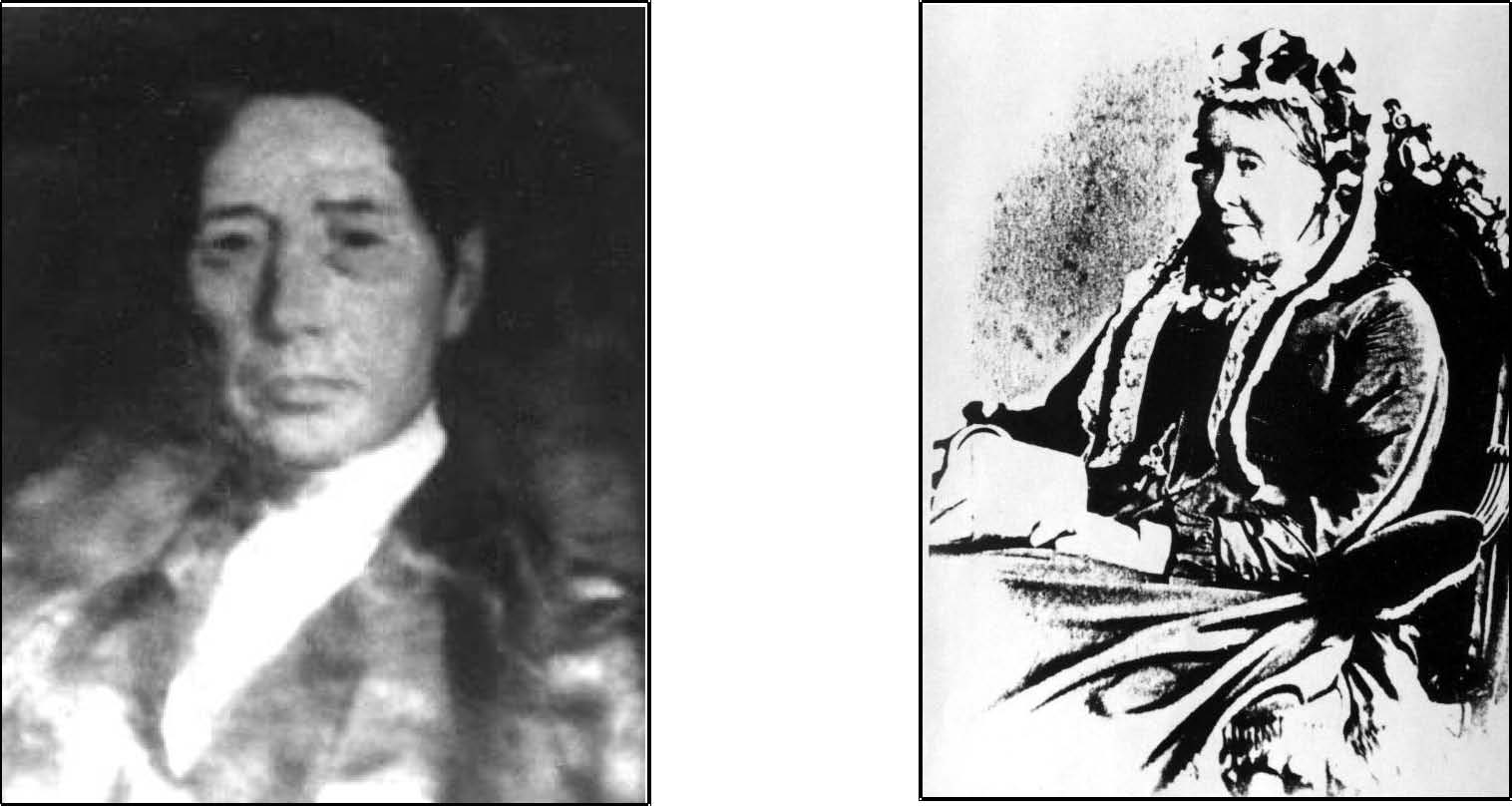 Our
first pictures of John Hochee and of Charlotte ( née) Mole The
portrait of Hochee is in the hands of the Seel family (See page 6)
Our
first pictures of John Hochee and of Charlotte ( née) Mole The
portrait of Hochee is in the hands of the Seel family (See page 6)
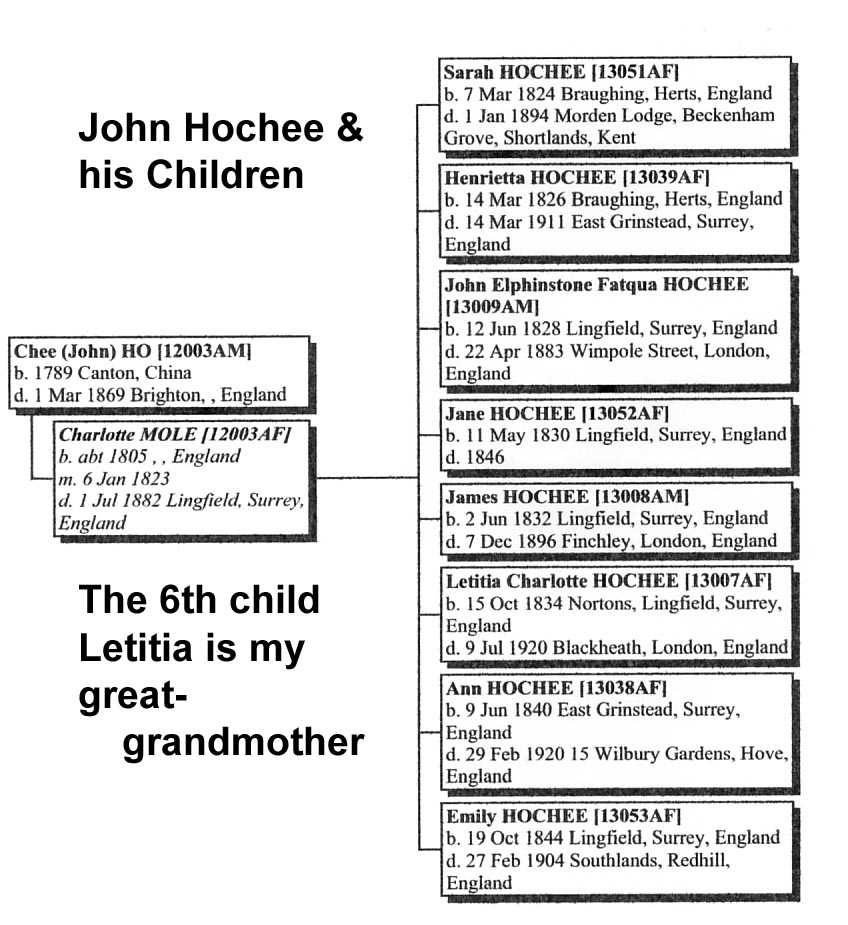 OUR
FIRST HISTORY OF JOHN HOCHEE 27
OUR
FIRST HISTORY OF JOHN HOCHEE 27
Ho Chee was born in Canton, China, in 1789 during the Qing (or Manchu) dynasty. Very little is known about his life except that he was the son of Ho Foo, a mandarin. The family lived at Hyan-Shan in Canton (now known as Guangzhou in the province of Guangdong) and were landowners. Mandarins were the qualified Government officials and Ho Foo may have been dealing with trade matters, the chief occupation of Canton, which brought him into contact with the East India Company. At this time Canton was a major trading post for the company in China; the East India Company had large tea factories in Canton and had a lucrative and flourishing trade there.
The history of this company in helping to open up China to Western trade is of some interest. With the coming of the industrial revolution, Britain' s need for raw materials at home, and markets for manufactured goods and investments abroad, induced that country to take the lead in “opening” China. This was accomplished ultimately by war, in and after 1839, consequent upon more than two centuries of peaceful relations.
Attempts at establishing relationships were made from 1635. The Chinese emperor Ch’ien Lung (1736-96) commended George III for his “ respectful humility” in sending a “memorial and tribute.” The request that an English envoy be permitted to reside in Peking was refused, it being disclosed that China itself had no desire to be represented abroad. Ch’ien Lung’s official wrote, “As your Ambassador can see for himself, we possess all things. I set no value on objects strange or ingenious, and have no use for your country' s manufactures. ” China' s goods, however, are “ absolute necessities to European nations”; therefore, “as a signal mark of favour” trade might be carried on at Canton - but not, as the English had asked, at “Ningpo, Chusan, Tientsin and other places . . .,” including storage of goods at Peking.
Having dispatched to China an envoy whose conveyances inland bore flags marked “ Ambassador bearing tribute from the country of England, ” and who presented gifts (“ tribute”) to the imperial court even though he did not perform the kowtow, Britain was definitely rated as a vassal kingdom.
For almost half a century, despite increasing friction over impositions and limitations upon its trade, England maintained peace with the Manchus and their subjects. It was during the Anglo-Chinese wars of 1839-42 and again 1856-60 that Britain took the lead in challenging Manchu-Chinese pretensions to “sway the ten thousand kingdoms,” and in insisting upon recognition by Peking of the western state-equality concept.
Another cause for friction leading to the Anglo-Chinese wars was the opium trade. Foreign, as opposed to native, opium was imported into China first by the Portuguese but later by other westerners. Until April 1834, the East India Company held a monopoly on English trade with China. The Company began farming out opium in Bengal in 1773, in which year the drug was first imported through Calcutta into Canton. Determination of the West to have Chinese teas and products; small demand by the Chinese for western products, including English woollens; unwillingness of the English to pay for Chinese goods with silver bullion; the high value of opium and its popularity for smoking; all these explain the phenomenal growth of the opium trade despite Chinese imperial anti-opium edicts from 1729. These edicts were disregarded by native officials and non-officials and aliens alike.
This opium trade may have triggered the wars beginning 1839, but the conflict was basically one between two worlds and two different concepts of international relations.
It would appear that it was through the East India Company that Ho Foo and his son Ho Chee met John Fullerton Elphinstone, eldest son of the Hon. William Fullerton Elphinstone, one of the directors of the company. John Elphinstone was a "Supercargo" in Canton, responsible for managing the sale of goods.
Perhaps Ho Chee and Elphinstone came into contact through their work and became close friends. Elphinstone returned home in January 1816 arriving around April/May 1816. Local stories in Dormansland17 say that Ho Chee accompanied Elphinstone to England when he became ill, and East India Company records confirm that Elphinstone was indeed prone to ill health. However, we now know from Ho Chee' s application for denization that Ho Chee did not arrive in England until August 1819.
Although Elphinstone had fully intended to return to China, he had retired from the East India Company in 1818 due to ill health. The following year we find Ho Chee arriving in England. We can only speculate as to the reasons, but it appears to have been due to their close friendship. This is possibly not the whole story for his coming. Ho Chee was undoubtedly able to speak English and with his knowledge of China and its customs he would have been particularly useful to a merchant such as Elphinstone and the East India Company connections. It is also known that George III had been keen on establishing diplomatic relations with China and Ho Chee's advice via the East India Company could have been valuable in this respect.
No love was lost between the English and the Chinese; the official term for the chief of the supercargo’s council was “Red-Haired Devil, ” and all Englishmen were known as “ Red-Haired Devil’s Imps”. In view of this, it is remarkable that Ho Chee and Elphinstone should have become friends. The following extract from “Lords of the East - The East India Company and its Ships” by Jean Sutton, shows the lack of understanding and distrust between the English and the Chinese at that time:
“These seemingly innocent articles in the officers' private trade - generally termed ‘sing-songs’ - bedevilled the company's trade with China for a hundred years. The Emperor collected them, and so they were highly sought after by the mandarins for bribing their superiors. On the slightest pretext, the mandarin in charge of the customs, the ‘hoppo,’ stopped the trade, threatening the company with huge demurrage bills until a bribe, of which the ‘sing-songs’ constituted the most important part, was exacted. Extortion was facilitated by the system of trade with the Europeans. A handful of Chinese merchants, the Co-Hong, bought the right to a monopoly of the trade. Each member of the Ho-Cong was appointed a security merchant to a few European ships and dealt with every aspect of the trade with the ships' supercargoes and, later, the council of supercargoes resident in the season at Canton.
17 Dor mans Land, sometimes written as “ Dormansland” is the area in Surrey that includes Lingfield, where Hochee settled.
OUR FIRST HISTORY OF JOHN HOCHEE 29
It was therefore the security merchant who was forced to purchase the ‘singsongs’ to placate the 'hoppo.' Captain Wordsworth's chiming clock, at £150, was relatively cheap; the more sophisticated - with figures dancing minuets, jigs, and gavottes, birds singing and waterfalls cascading - were extremely expensive, frequently bringing the security merchants to the verge of bankruptcy and so threatening to increase the already unhealthy monopoly of the Co-Hong.”
The voyage from China to England was geared to the monsoons; outward journeys were normally only undertaken between April and September, and homeward between November and March. The larger ships (usually those of more than 1200 tons) were used for trade with China. The East India Company used ships of its own fleet, amongst which were ships such as the “Elphinstone” and the “Broxbournebury. ” The ships were necessarily fast journeys taking approximately four months - not only for trading reasons but also to outmanoeuvre pirate boats. They were also armed to ward off pirate attacks. Goods brought to England included fans, ivory carvings, lacquerware and porcelain. After 1700, tea was the major commodity as well as lead, cotton and silks. Commanders and officers were able to trade privately, and traded in sugar, bamboos and spices as well as other luxury goods.
The Amsterdam typica l of the sh ips of the day a lthoug h no t a ship belonging to the British East India Company
Braughingbury 175 acre Farm where Charlotte Mole lived until her marriage
Ho Chee and Charlotte were married on 6 January 1823 at St. Mary' s, Church
Braughingbury
OUR FIRST HISTORY OF JOHN HOCHEE 31
Ho Chee may well have had it in mind to return to China after visiting his friend but, presumably because of the close bond with John Elphinstone, decided to stay. He later became a naturalised British subject by denization (denization 1839; naturalisation 1854).
There is a short gap in our information here, but Ho Chee somehow found his way to the village of Braughing in Hertfordshire. We believe Elphinstone lived in or near the parish. It was here in Braughing that Ho Chee met seventeen-year-old Charlotte Mole (12003), the ninth child of Chamberlain Mole (11017) who rented Braughingbury Farm, covering approximately 175 acres.
Ho Chee and Charlotte were married on 6 January 1823 at St. Mary' s, Braughing, and they continued to live in the parish for another three years. Ho Chee gradually became known as John Hochee and Charlotte took Hochee for her surname. The following year their first child, Sarah [13051], was born on 7 March 1824, and she was baptised at St.Mary' s on 27 July the same year.
Early in 1826, John Elphinstone purchased Ford Manor, in what is now the village of Dormansland in the Parish of Lingfield, Surrey, but at that time numbered a few houses and surrounding farms. On 14 March that year, their second daughter, Henrietta (13039), was born at Braughing and they moved to Ford Manor with Elphinstone before she was baptised at the Parish Church of St. Peter and St. Paul, Lingfield on 30 July 1826. Dormansland and the Parish of Lingfield became home to the Hochee family and it was to remain so, for some time at least, into the next century.
On 12 June 1828, the Hochee' s first son was born and was named John Elphinstone Fatqua Hochee [13009], probably in gratitude for the help and friendship of John Elphinstone, who may also have been a God-father. It is also known that one of the Chinese security merchants in Canton was named Fatqua and may have been a relative. However, John Elphinstone Fatqua Hochee was not christened until May 1831 when he was baptised along with his year-old sister, Jane (13052). John E.F. Hochee later used the name John E. Milton, although this was probably not until after his father' s death. He later became a lieutenant in the Madras Army.
In 1831, Elphinstone purchased Nortons Cottage which he let to Ho Chee. It seems that a new house was built on the same site around this time. This house still stands although its name has been changed several times. It is an impressive building for the area; it has been described by a local historian as a “country house of quiet distinction.”
Their younger son, James [13008], was baptised in 1832. Letitia Charlotte (13007) (baptised 12 April 1835) and Ann Hochee (13038) (born 9 June 1840) followed. Their last child, Emily (13053), was baptised on New Year' s day 1845.
Only a year later, on 1 April 1846, their daughter Jane, died at the age of sixteen. She was buried in Lingfield churchyard, where she was to be joined, many years later, by her elder brother and her mother.
[This account continues on page 35]
Nortons “Cottage” as it stands today.
Described by a local historian as a “ Country house of quiet distinction”
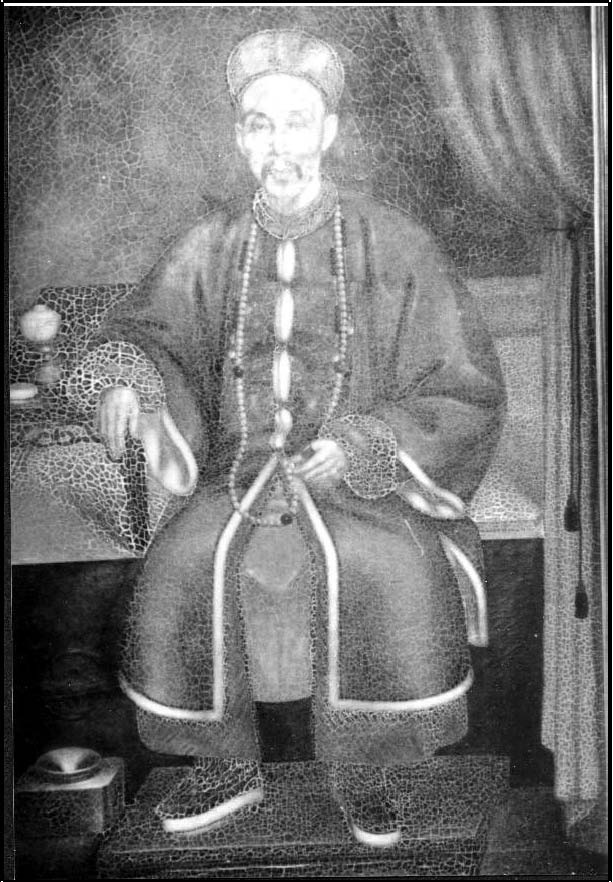
< This is Ho Foo.
Both John Ho Chee’s father and his nephew have been described with this name. Present day family members believe this portrait is of John Hochee’s father, but we cannot be sure -it may be his nephew.
This is a photo of the dining room at Braughingbury farm where C harlotte Mole grew up

< The Parish Church of St. Peter and St. Paul at Lingfield.
Many members of the family were Christened there; others were married there, and some were buried there.
Although their second child, Henrietta, was born at Braughing on the 14th March 1826, the family moved to Lingfield and she was Christened in this church on 30 July 1826.
The photos on this page were taken from the book: Peter Morris-Jones: Family History18 Peter was a third-cousin whom I discovered in 2001. Peter can be located in the Family chart on page 6.
At top left there is a photo of John Hochee, and at the top right he is shown playing chess with George Lowdell [12031], the father-in-law of his daughter Sarah [13051 ]. Two of Hochee’s daughters married into the Lowdell family.
< Hochee playing chess with his first son, John
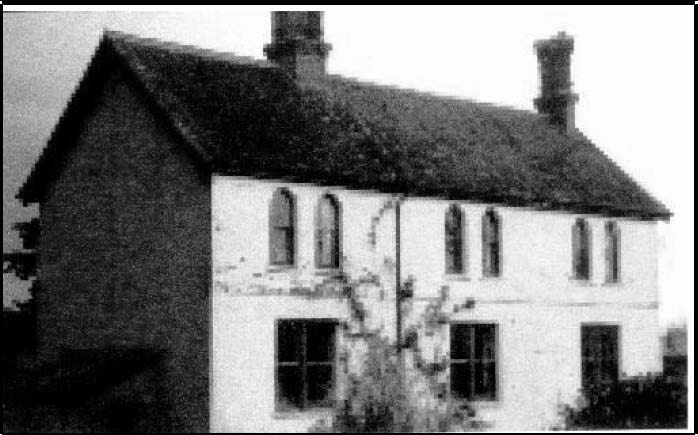
< Milkhouse farm cottage was given to Hochee by John Elphinstone
Nortons cottage, Milkhouse farm and Ford Manor were all given to Hochee by his benefactor.
In 1867 - two years before Ho
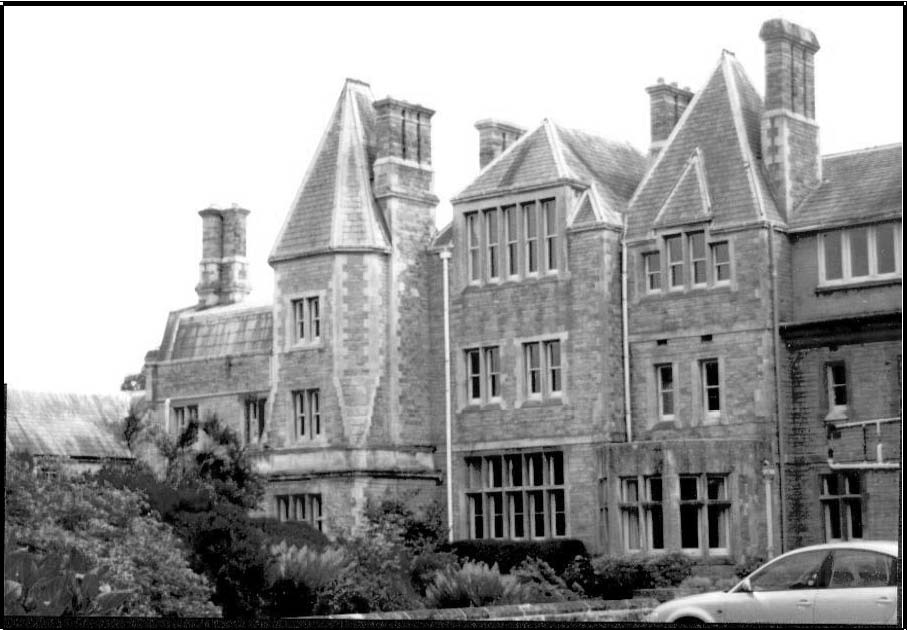
Greathed M ano r - bu ilt after Hoch ee’s Death
chee’s death, Ford Manor and its land were sold. The following year a new house -known as Greathed Manor (shown on the left) - was built near to Ford Manor by the new owners.
Hochee and his family were never connected with Greathed Manor, it simply marks the location of land once owned by Hochee.
18 Published privately 2002. The pictures r eproduced here are of poor quality because they were scanned from his low-resolution images in the book.
It is not known whether either Elphinstone or Ho Chee ever went abroad again. Ho Chee is always referred to as a gentleman on certificates and in Parish Registers, although he may have acted as a secretary to John Elphin -stone. Elphinstone owned several other properties in England and Scotland and it seems that Ho Chee managed Ford estate while he was away. Hoopers Farm provided a home for Charlotte' s brother Thomas Mole [12050] and his wife, and a house known as ‘Crosses’ was occupied by John Sue Achow, also Chinese, and his family.
Achow arrived later in 1832. Thorold Lowdell [13051] wrote that, when he was a boy, there were elderly residents who could recall seeing the Chinese about the village.
Ho Chee petitioned for denization on the 26 July 1839 giving his status as a yeoman and
‘reason to believe I should become possessed of Freehold Landed estate..... if the
Disability of my being alien born were removed by Letters Patent of Denization
or otherwise by Royal Concession or Favour.’
Elphinstone wrote a Deed of Gift in December 1839 giving Ho Chee his Surrey estate following his denization. It may be no coincidence that the news of the confiscation and destruction of the British opium stocks in Canton (March/April 1839) had recently arrived in England. This seizure led directly to the Opium War of 1840. Ho Chee’s position in England as a Chinese native would have been untenable in the mounting climate of war and this could have prompted his application for denization.
In 1854, events took a turn for the worse when John F. Elphinstone died at the age of 75. He was buried in the extra-mural cemetery in Brighton as he had died while staying in the town. It appears that both Elphinstone and the Hochee family often spent the winter in Brighton, as was fashionable at that time. Elphinstone willed Ford Manor, and several other properties to his friend Ho Chee. In his will he wrote:
“I, John Fullerton Elphinstone in consideration of the long and continued attachment and of the services I have received and for the attention he has given to the management and the improvement of my landed property in Lingfield Surrey On the event of my death I hereby give and devise unto Mr. John Hochee formerly of Macao and of Canton in China but for many years residing at Nortons in the Parish of Lingfield and now by her Majesty's Letters Patent a Denizen of the United Kingdom all my landed property situated in the Parish of Lingfield and County of Surrey known as Ford Farm Hoopers Crosses Nortons Milkhouse Farm together with all cottages or other appendages Manorial rights as may be thereunto belonging.”
In the same year of Elphinstone' s death (1854), their eldest daughter, Sarah, married Thorold Lowdell at Lingfield. The Lowdell family lived at Baldwins, now on the outskirts of East Grinstead, although included in Lingfield parish.
The Lowdells were land owners and also in the professions. Sarah and Thorold later moved to Woodgates Farm (also known as Milkhouse farm) which was owned by Ho Chee. On 23 August 1866, Henrietta Hochee [13039] married Sydney Poole Lowdell, who had trained as a doctor and who eventually inherited Baldwins. Members of the Lowdell family also became associated in a doctors’ practice with the Pococks in Brighton. Crawford John Pocock later married Ann Hochee [13038].
One of the unsolved mysteries of this family is that of the marriage of Letitia Charlotte Hochee [13007] to Anthony Knight. On 24 October 1860, they were married at All Souls, Marylebone; no member of either family witnessed the marriage and, if anything, it seems to have been secret. In the census of 7 April 1861 Letitia Charlotte is living at Nortons and she has been declared unmarried, presumably by her father.
Then on 1st August 1861, Anthony and Letitia married again at Lingfield, with members of both families present. It may be no coincidence that Elphinstone owned number 23 York Terrace, Regents' Park, a near neighbour of number 3 Cornwall Terrace, owned by the Knight family. Within a short time of this second wedding they emigrated to New Zealand and did not return until both their fathers had died.
On 27 July 1864, James Hochee [13008], who was by this time a surgeon, previously working in India, married Emma Fry at Redhill; they later lived at Finchley and were the only ones to perpetuate the Hochee name as John E.F. Hochee did not marry.
Around 1867, Ford Manor and the surrounding land was sold off, although various farms and cottages were kept. The following year a new house, now known as Greathed Manor, was built near to Ford Manor by the new owners.
Eventually on 1 March 1869, Ho Chee himself died whilst staying at Devonshire House, Brighton. He was buried in a grave adjoining and identical to that of his benefactor, John Elphinstone. One of the provisions of his will was:
"I give and devise unto my said wife Charlotte Hochee all that piece of Freehold
land now planted with fir on which a limekiln formerly stood situate at the cross
of roads at Dormans Land in the Parish of Lingfield in Surrey."
In the will there is no obvious reason for this but a few years after his death we find that Charlotte had the ‘Hochee Almshouses’, built on this land, and given to the village.
There were two more marriages at Lingfield; on 18 July 1871 Ann [13038] married Crawford John Pocock of Brighton while on 24 September Emily [13053] married Frank Abrahams of Croydon.
On 1 July 1882, Charlotte died at the age of 77. She was buried at Lingfield with her daughter; their grave was given a Chinese inscription which reads “Ho Chee.”
In her will Charlotte left an oil painting of Ho Chee to her sons “ with the hope that it will always remain in the family. ” Portraits of Ho Foo in Chinese robes and a smaller one of Ho Chee in Western Dress are now in the possession of the Lowdell family.
In 1882 Dormansland Church was completed with the help of contributions from local landowners including John E.F. Hochee. John E.F. Hochee died the next year at his London home, 33 Wimpole Street and he was buried with his mother in Lingfield.
The Hochee Almshouses, with a marble bust of Ho Chee himself presiding over the tiny hallway, still survive to this day providing a permanent memorial to this unusual family.
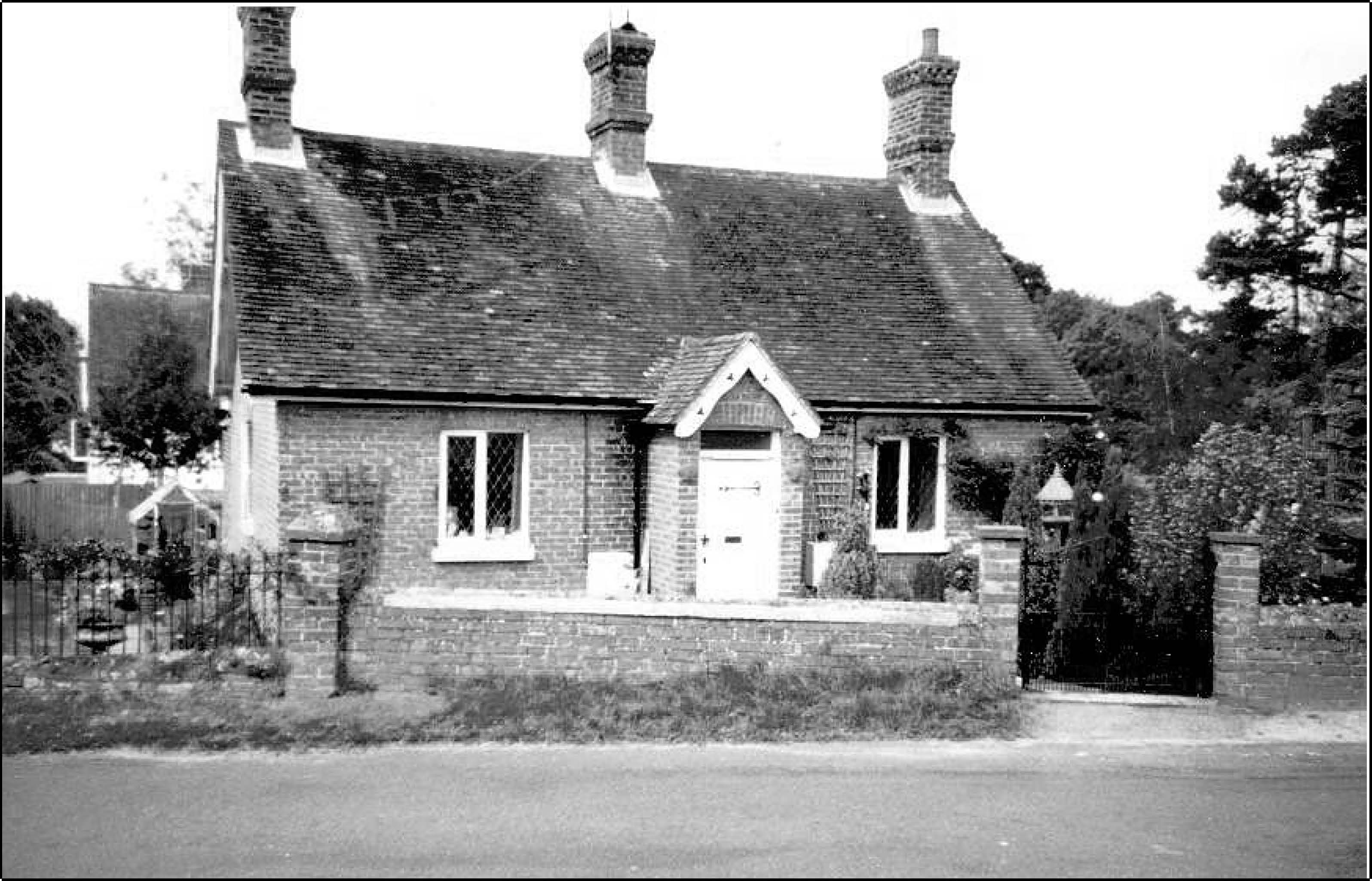
The Hochee Almshouses at Lingfield, Surrey
Above, left, the tombstone of Charlotte Hochee at Lingfield. Dated July 1st 1882. Aged 77 years
Above, right, the Chinese characters signifying “Ho Chee” inscribed on one end of the tombstone.
Right: The bust of John Hochee that stands in the hallway of the almshouses.
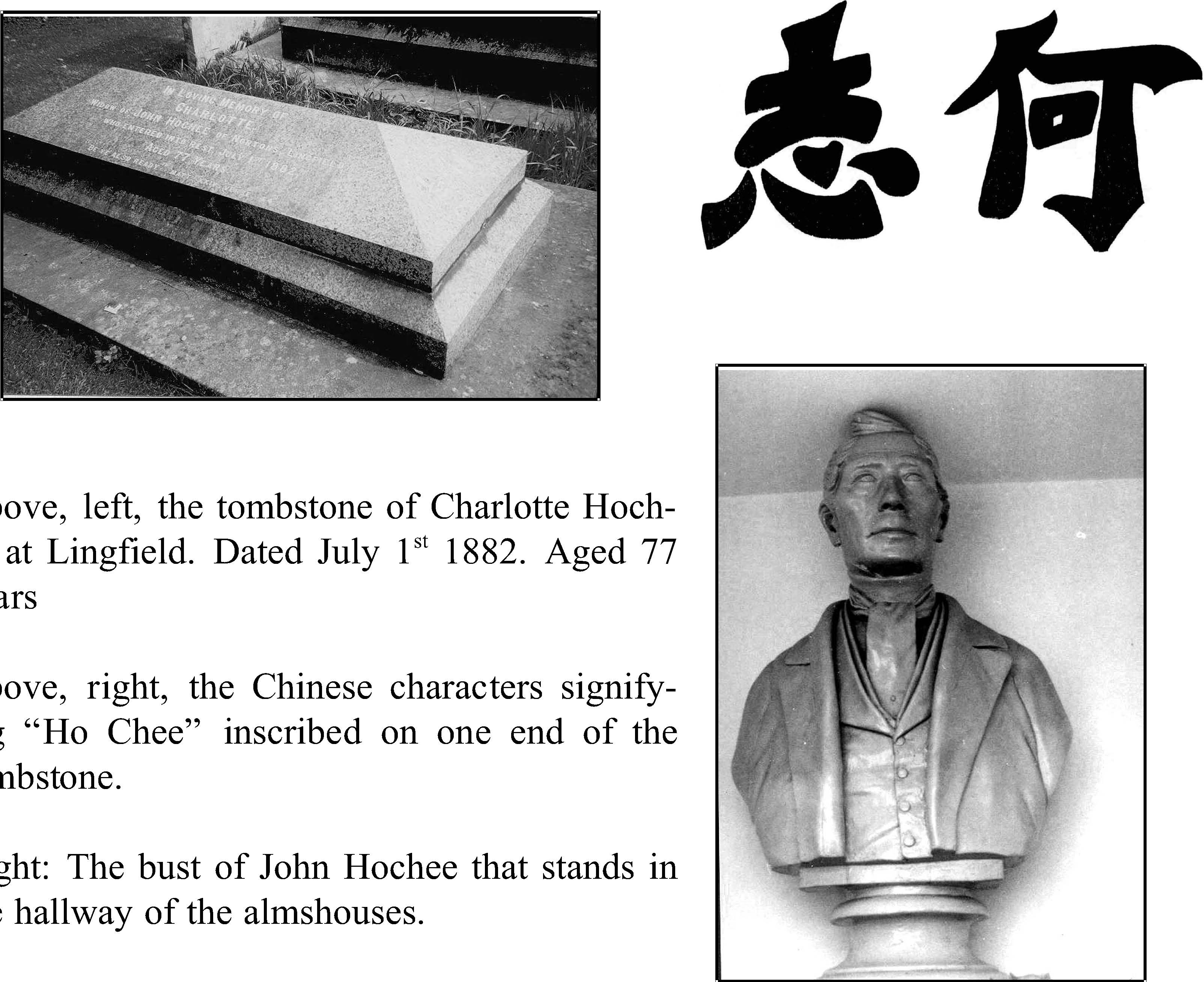 In
the Naturalisation records of the London Records Office there is a
letter that appears to have been written by Hochee himself applying
for citizenship. This initial application appears to have been
unsuccessful. He then employed a solicitor to write a second letter.
The record is as follows:
In
the Naturalisation records of the London Records Office there is a
letter that appears to have been written by Hochee himself applying
for citizenship. This initial application appears to have been
unsuccessful. He then employed a solicitor to write a second letter.
The record is as follows:
Ho Chee - The Petition of Ho Chee formerly of Hyan-Shan in Canton, China
but now of Nortons in the Parish of Lingfield in the County of Surrey, Yeoman.
To be a free Denizen - Awarded 21 Nov 1839
I Ho Chee of Nortons in the Parish of Lingfield in the County of Surrey, Yeoman a petitioner to Her Majesty for letters patent of Denization do solemnly and sincerely declare that I am a Native of Hyan-Shan in Canton, China that I was born of Chinese parents and am about forty-nine years of age. That I came to England in the month of August in the year one thousand eight hundred and nineteen and resided at Braughing in the County of Hertford until the year one thousand eight hundred and twenty five wherein I went to live in the Parish of Lingfield aforesaid and where I have continued to live ever since. That I have reason to believe I should come possessed of freehold landed estate either in Fee or on lease for life or years if the disability of my being alien born were removed by Letters of Denization or otherwise by Royal Concession or Favour and I further declare that I am the lawful Husband of an English Woman by whom I have a family of six children and am desirous of living permanently in England and that I am undeniably well affected to Her Majesty's person and Government and I make this solemn declaration conscientiously believing the same to be true and by virtue of the provisions of an Act made and passed in the fifth and sixth years of His late Majesty William the fourth entitled an Act to repeal an Act of the present session of Parliament entitled an Act for the more effectual Abolition of Oaths and Affirmations taken and made in various Departments of the State and to substitute declarations in being thereof and for the more entire supposition(?) of voluntary and extrajudicial Oaths and Affidavits and to make other provisions for the Abolition of unnecessary Oaths.
Declared at the Mansion House, London 23 July 1839
Ho Chee
and further,
1st August 1839
To the Right Honourable Lord John Russell Her Majesty's Principal Secretary of
State for the Home Department. The Humble Petition of Ho-Chee formerly of
Hyan-Shan, Canton, China but now of Nortons in the Parish of Lingfield in the
County of Surrey, Yeoman.
Thewth - That your Petitioner is a Native of China and was born at Hyan-Shan aforesaid of Chinese parents and is aged forty nine years or thereabouts. That your Petitioner came to England in the month of August in the year one thousand eight hundred and nineteen and took up his abode at Braughing in the County of Hertford and continued that residence til the year one thousand eight hundred and twenty five when he went to live in the Parish of Lingfield aforesaid and has not since resided out of that Parish. That your Petitioner farms an Estate which is called Nortons and he is aforesaid to the different County and Parochial Rates and Assessments in his own name.
That your Petitioner on or about the sixth of January 1823 married according to the Rites and Ceremonies of the Church of England at Braughing Church, Charlotte Mole of Braughing aforesaid Spinster and Native of that Parish. That your Petitioner and his wife have six children videlicet Sarah, Henrietta, John, Jane, James, Letitia. That your Petitioner has reason to believe that he may become entitled to an Estate of Inheritance in Fee Simple or Lease for Life of lands in the County of Surrey provided no legal impediment existed but your petitioner is advised that being born an Alien he cannot possess Landed or any other Real Property without Her Majesty's gracious Letters of Denization being first granted to your Petitioner.
Your Petitioner therefore humbly prays your Lordship that you will be pleased to grant to your Petitioner Her Majesty's most gracious Letters of Denization and that under the Authority thereof your Petitioner may be enabled to take either by Gift or Purchase landed or other property and your Petitioner will ever pray.
Ho Chee
We the undersigned are well acquainted with Mr Ho Chee and believe him to be rightly deserving of the Indulgence he solicits.
William Rixon Snr - Solicitor, Jewry St, Aldgate - intimate with him from his first arrival William Rixon Jnr - Solicitor W.H.Blackmore 16 Gauld(?) Sq, City Thomas Robson Aylesford, Kent Brailsford(?) Bright First Gate, Essex.
Alexandra in her research also noted the following:
The British 1841 census Lingfield HO107, 1077, 35 p16, Nortons, described him as a farmer. At that time there were three female servants in the house [Eliza Friend (20), Esther Longend (15) and Hannah Standish (15)] and an Agricultural Labourer [William Lambert (15)].
The British Census of 1861 for Nortons Lingfield, (reference R. G. 9/579, 143 page 5), states his age as 70, and that he was born in Canton, but became a Naturalised British subject.
Birth certificates and other records show that he and Charlotte had eight children: John, Sarah, Henrietta (known in the family as "Netta"), Jane, James, Letitia, Ann and Emily.
John Hochee died on 1 March 1869 {recorded in the parish of Brighton for the March 1869 quarter, 2b 128 (aged 80). }
A copy of his Last Will and Testament has been studied. It is a long, handwritten, and partly illegible, legal document that showed him as a man of some substance. He left his lands and premises for the use of his wife, although these were eventually to go to his son, John, to be sold, and the proceeds to be equally divided amongst his children. . He gave his servant, John White, £50. He left legacies to his children as follows: Sarah, £200; Henrietta, £700; Letitia, £200; Ann, £700; Emily, £1,700; John, £200; James, £200. He stated he had made these unequal as he had already advanced certain sums to some of his children.
In May 1994, when I published The Rumble Family Register, we knew little more of John Hochee than that which has been related on previous pages. We knew even less about the young seventeen year old girl, Charlotte, whom he married. We knew that her father was Chamberlain Mole and her mother Martha Milton. However, in October 1994, Alexandra Knight announced that she had completed extensive research on Charlotte’s family. We now know that Charlotte was the ninth of twelve children, as shown in the chart below:
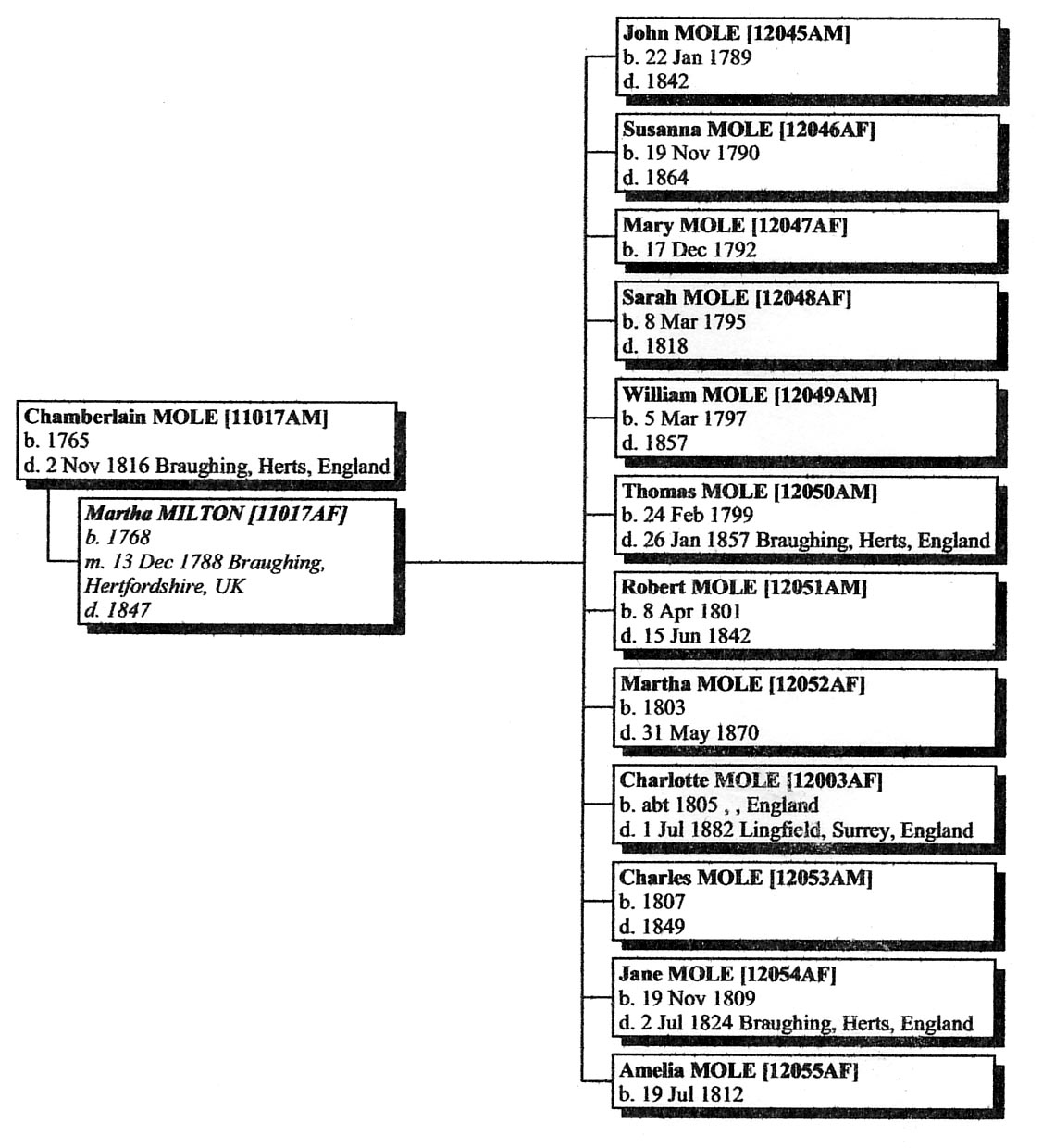 We
also know that she had an extensive pedigree as shown on the previous
page. This pedigree in one case has been traced back to my
ninth-great grandfather, John Merriton [05001], who died in 1642.
We
also know that she had an extensive pedigree as shown on the previous
page. This pedigree in one case has been traced back to my
ninth-great grandfather, John Merriton [05001], who died in 1642.
Tracing families back so far is very difficult and usually yields scant information. Alexandra Knight commented on this when she sent me the data in October 1994.
As we go back further into history, it becomes increasingly difficult to locate
records - and their accuracy is not always reliable. Some branches of the family
are well documented while others prove difficult to find.
Progress has been slow with the Knight family, particularly as they came from London where the population was large. We hope to go back further although this will take some more detailed research. It is always interesting to find more about individuals rather than their mere names and dates so, we have attempted to expand our information on ancestors already discovered. Valentine Knight [12030] is one of the most interesting characters who has also been reasonably well documented. [We know that] cartoons have been drawn of him and a bust of him and his wife Elizabeth have been sculptured but we have so far been unable to trace them. Also, no example of a watch engraved by Valentine has come to light although this is unlikely as engravers rarely signed their work. .....
Significant progress has been made on the Mole family and their ancestors. Of course it helps having the record office in Hertford19 so we are able to visit it regularly A detailed study of land tax returns, militia lists and other records has enabled us to build up a picture of these families and to trace their movements in the area.....
Alexandra and Henry Knight were able to research the Welch, Chamberlaine and Milton ancestry of Charlotte. Alexandra’s record of this follows:
The Mole family of Braughing are direct descendants of the Welch family who lived in the Parish of Little Hormead which adjoins Braughing Parish to the North. The family were farmers and their land covered areas in both Braughing and Little Hormead; they farmed mainly at Mutfords Farm but also had land at Hay Street, Dassels, Bozen Green and Braughing. During the eighteenth and nineteenth centuries there were many members of the Welch family in Braughing and, as well as farming, they were millers, maltmakers, grocers and woolstaplers.
The Parish of Little Hormead is quite small in comparison with others such as Braughing, which covers several villages. Little Hormead itself is only a hamlet originally part of "Hormead", along with nearby Great Hormead. The tiny church of Little Hormead was begun in the eleventh century and extended later. Mutfords Farm can be seen clearly from the church, only a stone's throw across the fields and it seems to have been the main residence of the earlier members of the Welch Family. Inside the church there was a special "Mutfords pew" which was situated immediately behind the pew of Little Hormead Bury at the front on the south side of the church.
19 Henry Knight and his family live in Hertford
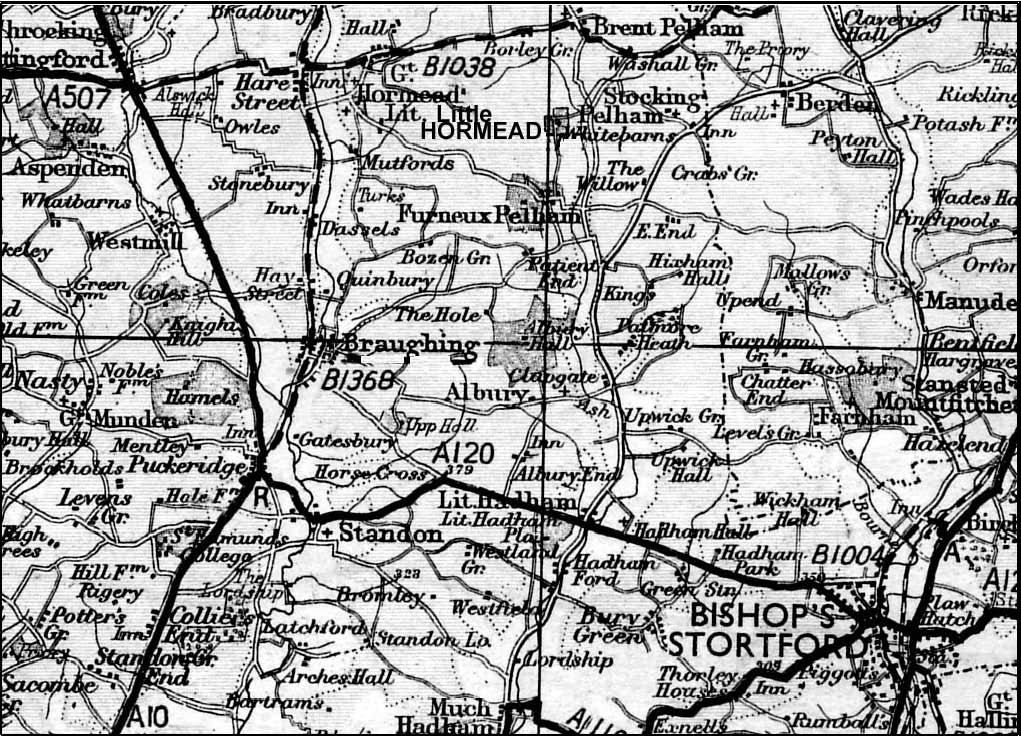
Brau ghing is a little left of cen tre in the above map. The nearest larg er town is Bishop’s Stortford near the bottom right. Great and Little Horm ead are m arked, north-north-east of Braughing. Bozen Green and Mum fords are marked between Braughing and Horm ead
Mutfords itself was part of the glebe lands belonging to the rectory and, in 1681, a survey of the glebe lands, known as a terrier, was drawn up by the rector with the help of his tenants, including William Welch [07004] of Mutfords. The farm took its name from the moat that surrounded it and from the nearby ford over the river Quin: It was the moated house by the ford, abbreviated to Mutfords. Many of the Welch family were buried at Little Hormead although, unfortunately, none of their gravestones survive.
The earliest records we have are of Edward and Katherine Welch [06004] and of Katherine's parents. She was the daughter of John and Margaret Merriton [05001] of Little Hormead, the third of eleven children. Katherine and Edward were married in the village on 13 July 1637 and their first child, a daughter, Margaret [07003], was baptised there on 8 May 1638. However, the family probably lived at Cottered20 as their other children were all baptised there. It seems that they later settled in Little Hormead and both Edward and Katherine were buried at the church there.
20 Between Buntingford and Baldock. . Buntingford is at the top left of the map on page 42 and Cottered is west of this, just off the map.
Family Charts Each family chart shows a married couple and those of their children who could be traced. The charts would generally not be complete in that there is no guarantee that all children are included. For each chart the child from whom we are descended is shown.
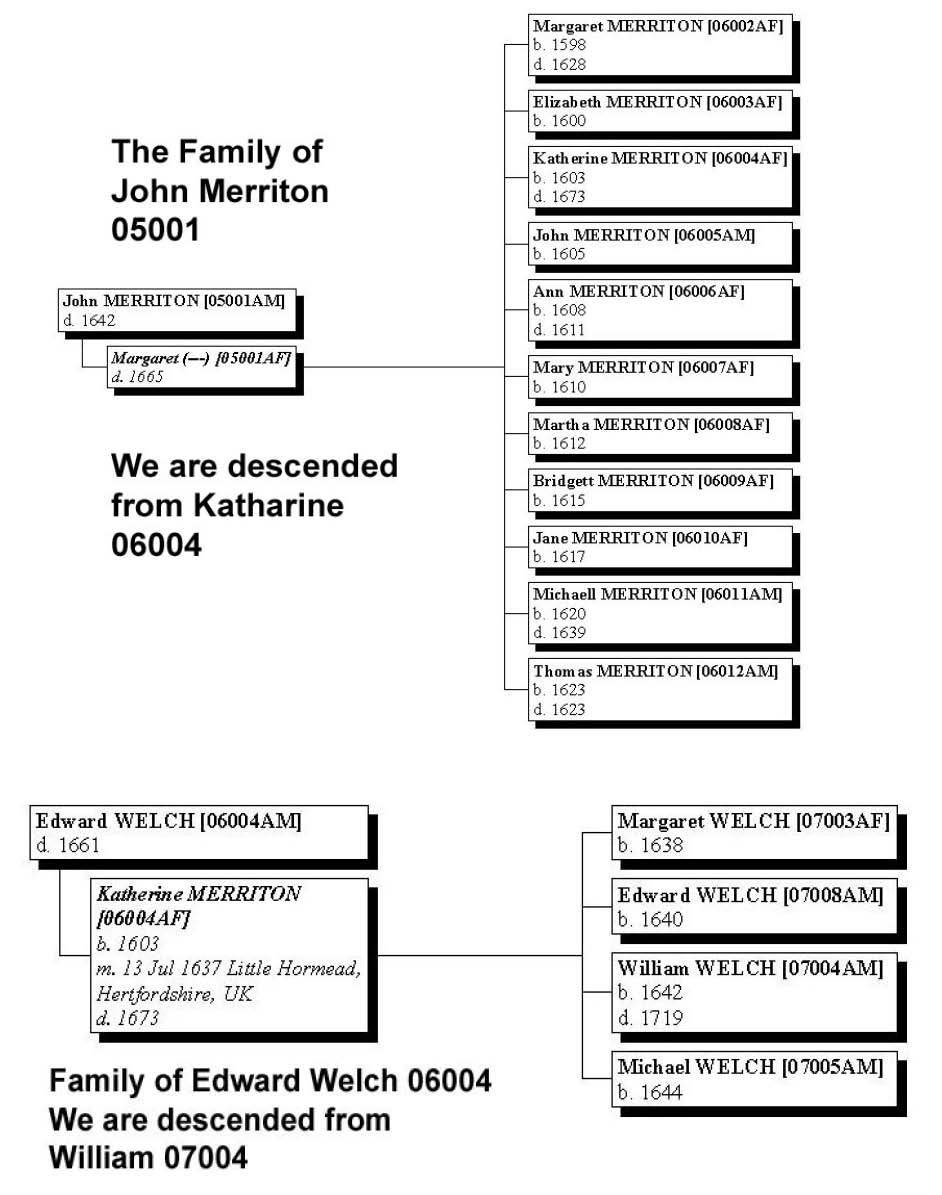
 William
Welch [07004], son of Edward and Katherine, was baptised on 20
October 1642 at Cottered and he married Frances in the early 1670s.
From 1694, William Welch (and later his son Daniel [08015]) was
regularly elected a County Surveyor at the Wadesmill Turnpike; the
turnpike accounts had to be submitted annually at the Quarter
Sessions meetings held in Hertford and the Surveyors were elected at
the same time. William Welch was also recorded as being the Overseer
to the Poor of Little Hormead in 1700 and he would have been
responsible for collecting money in the parish and distributing it to
the poor. Frances Welch, his mother, died in 1708 and William moved
to Braughing around 1714 although he, too, was buried at Little
Hormead on his death in 1719. William and Frances had several
children and we have records of George, William, Frances, Daniel and
Michael. Daniel was baptised on 22 November 1686 at Little Hormead
and married Susan Hammond in London on 19 June 1716. The marriage is
recorded in the Furneaux Pelham Parish Registers and it is assumed
that one of them was living there at the time of their marriage.
William
Welch [07004], son of Edward and Katherine, was baptised on 20
October 1642 at Cottered and he married Frances in the early 1670s.
From 1694, William Welch (and later his son Daniel [08015]) was
regularly elected a County Surveyor at the Wadesmill Turnpike; the
turnpike accounts had to be submitted annually at the Quarter
Sessions meetings held in Hertford and the Surveyors were elected at
the same time. William Welch was also recorded as being the Overseer
to the Poor of Little Hormead in 1700 and he would have been
responsible for collecting money in the parish and distributing it to
the poor. Frances Welch, his mother, died in 1708 and William moved
to Braughing around 1714 although he, too, was buried at Little
Hormead on his death in 1719. William and Frances had several
children and we have records of George, William, Frances, Daniel and
Michael. Daniel was baptised on 22 November 1686 at Little Hormead
and married Susan Hammond in London on 19 June 1716. The marriage is
recorded in the Furneaux Pelham Parish Registers and it is assumed
that one of them was living there at the time of their marriage.
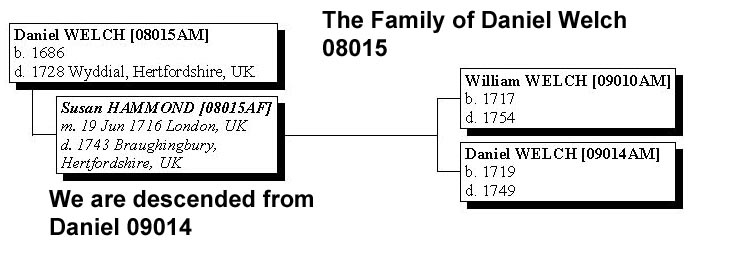 Daniel
and Susan Welch lived at Little Hormead for a while but in 1718 they
took the lease of a farm in nearby Wyddial. The original lease
agreement still survives although a small part is missing. It is a
very large document, approximately 3 x 2½ feet square, written
on thick parchment with the signature and seal of Daniel Welch at the
end. It is believed that the farm in question was Wyddial Bury Farm,
which was probably part of the Wyddial Hall estate belonging to
Richard Goulston; an annual rent of £220 was agreed and this
would indicate a substantial farm. In addition to the rent, the lease
details the farm buildings, the maintenance of hedges and fences
along with other rules and regulations. The document also states
various duties including:
Daniel
and Susan Welch lived at Little Hormead for a while but in 1718 they
took the lease of a farm in nearby Wyddial. The original lease
agreement still survives although a small part is missing. It is a
very large document, approximately 3 x 2½ feet square, written
on thick parchment with the signature and seal of Daniel Welch at the
end. It is believed that the farm in question was Wyddial Bury Farm,
which was probably part of the Wyddial Hall estate belonging to
Richard Goulston; an annual rent of £220 was agreed and this
would indicate a substantial farm. In addition to the rent, the lease
details the farm buildings, the maintenance of hedges and fences
along with other rules and regulations. The document also states
various duties including:
"... between the feast day of John the Baptist and St. Michael the Archangel the draught or carriage of three great wagon loads of sea coles containing sixty bushels apiece at least from the Town of Cambridge to Wyddial Hall aforesaid."
Daniel Welch also had to provide
"twelve good and well-fatted pullets at Christmas time or at any time when they
shall be required."
Daniel Welch died in Wyddial in 1728 before the end of the twelve-year lease and was buried with his family at Little Hormead. His widow, Susan Welch, probably moved to Braughing at this time. She was recorded as living in Braughingbury on her death in 1743. This was the first record of the farm in the family, which was passed down from the Welch family to the Moles for at least another one hundred years.
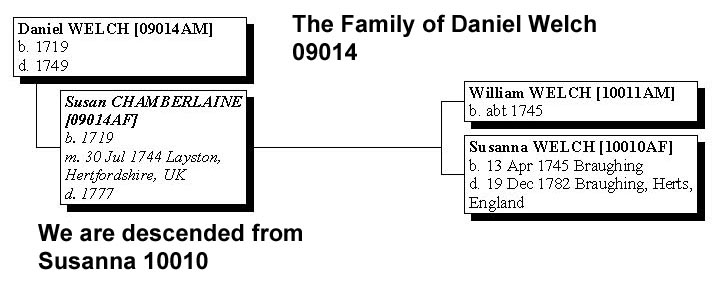
One of the sons of Daniel and Susan Welch, also named Daniel [09014], was baptised in Wyddial in 1719. Daniel Welch junior remained in Braughing and married Susan Chamberlaine, also of Braughing, on 30 July 1744 at Layston. However, Daniel died only five years later in 1749 and was buried at Braughing. Daniel and Susan had two children, William (baptised in 1745) and Susanna [10010] (baptised in 1746).
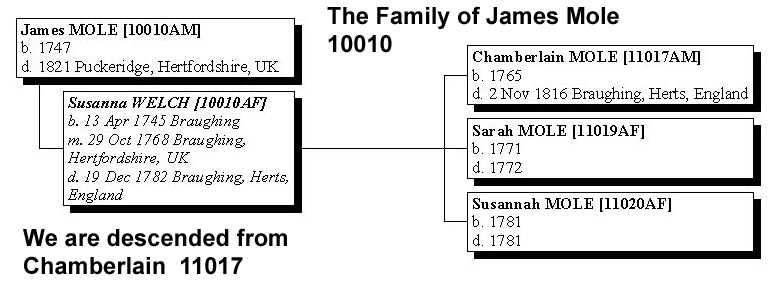 In
1765, Susanna Welch had a son, Chamberlain Welch [10010], who was
given his grandmother's maiden name. Three years later, in 1768 at
Braughing, Susanna married Chamberlain's father, James Mole of
Westmill. He was then twenty-one years of age and their son,
Chamberlain Welch, thus became Chamberlain Mole. James and Susanna
Mole had two more children although both died in infancy. Susanna
herself died in 1782 at the age of 36 and was buried in Braughing
next to her mother and other members of the Chamberlaine family.
In
1765, Susanna Welch had a son, Chamberlain Welch [10010], who was
given his grandmother's maiden name. Three years later, in 1768 at
Braughing, Susanna married Chamberlain's father, James Mole of
Westmill. He was then twenty-one years of age and their son,
Chamberlain Welch, thus became Chamberlain Mole. James and Susanna
Mole had two more children although both died in infancy. Susanna
herself died in 1782 at the age of 36 and was buried in Braughing
next to her mother and other members of the Chamberlaine family.
James Mole appears to have married again although there were no more children. He died in Puckeridge (to the south of Braughing) in 1821 at the age of 75. He was also buried in Braughing but his grave has not been located.
Chamberlain Mole married Martha Milton and had twelve children, the ninth being Charlotte who married John Ho Chee. [The family chart for this family has already been shown on page 41[
The Chamberlaine family appear to have lived in the southern part of Braughing Parish, around the Green End Area, although their precise residence is unknown.
The first member of the Chamberlaine family of which we have reliable records is John Chamberlaine who married Mary around the late 1670s; however, this marriage does not appear to have taken place in Braughing. They had at least six children, the youngest of whom was their only surviving son, also named John, born in 1688. Interestingly, in the Will of John Chamberlaine senior, he mentions his son John as being heir to an “estate” in Warwickshire although we know nothing further of this. It is possible that the Chamberlaine family originated in Warwickshire and later moved to Hertfordshire. Mary Chamberlaine died in 1710 and her husband died in 1716; both were buried in Braughing although their gravestones do not survive.
John Chamberlaine junior married Elizabeth Houlgate at St. Mary Woolnoth, Lombard St. London on 14 November 1712. It is not clear why John Chamberlaine went to London although the Houlgate family, who owned much land around Little Hormead and Braughing, were connected with that particular parish. The Chamberlaines had at least five children, all baptised in Braughing. John Chamberlaine died on 4 April 1727 at the age of 39 and was buried at Braughing. Many of the family gravestones from this date still stand in the churchyard and are probably some of the oldest remaining although they are becoming difficult to read without good light. The tops of the stones are carved with angel's heads and other patterns that had become popular at the time.
Susan Chamberlaine, baptised on 24 September 1719, was the youngest daughter of John and Elizabeth Chamberlaine. She married Daniel Welch at Layston, near Buntingford, on 30 July 1744; it is not known why they did not marry in Braughing as they settled in the village. [See chart, page 46] On 24 November 1765 Elizabeth Chamberlaine died at the age of 83 and was buried with her husband and two sons, John and William. Susan Welch died in 1777 and was buried alongside her parents and brothers at Braughing.
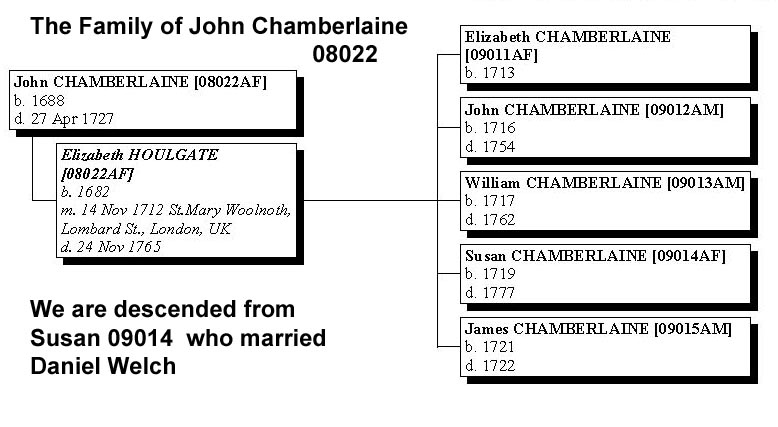
Very little of known of the Milton family other than that Joseph, the earliest member of whom we have a record, lived and worked as a grocer in Hare Street in the Parish of Layston, Hertfordshire. Around 1725 he married Mary.
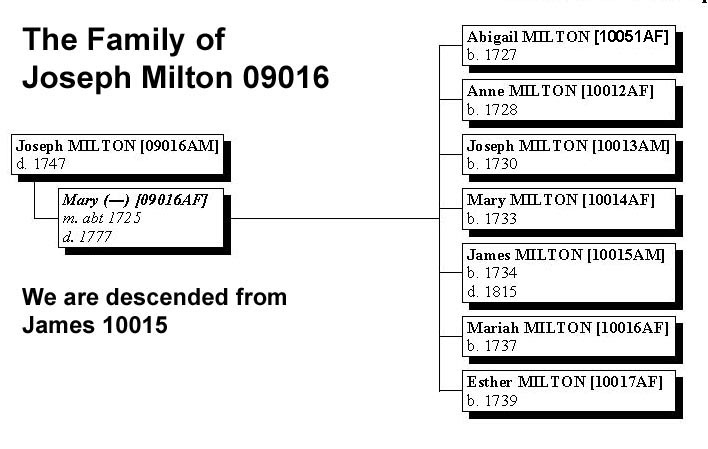
We have record of seven children. Their fifth child and youngest son, James, was baptised on 11 February 1734 and became a butcher in Hare street. James married Sarah Kent in 1760 and it appears that they remained in this hamlet all their lives.
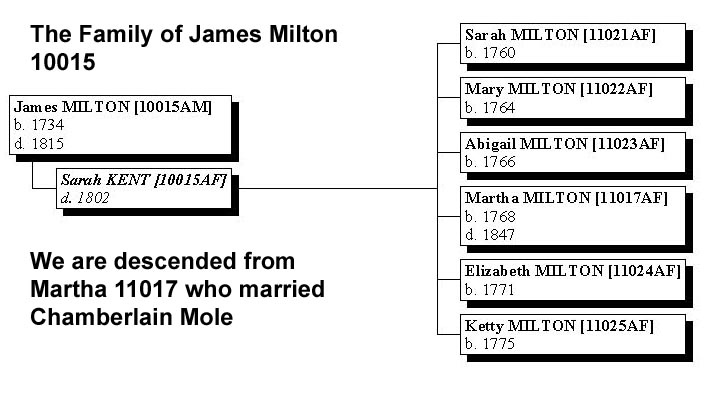
Both were buried at Layston Church, which has since fallen into disrepair and is no longer in regular use. James and Sarah had at least six children. Their fourth child, Martha Milton, married Chamberlain Mole at nearby Braughing on 13 December 1788 and they settled at Braughingbury Farm in the Parish. Their ninth child was Charlotte Mole who married John Ho Chee.
At the end of 1994, in spite of the research undertaken by the Knights into the background of Charlotte Mole’s family, we still knew very little about her. Charlotte was born in 1806. Ho Chee was born in 1789, and so he was 17 years her senior. They were married at Braughing on 6 January 1823 when she was seventeen and he was thirty four. Between March 1824 and October 1844 she had eight children [see chart on page 25] By this time she was 38 years of age.
We had snippets of information about her. In my 1994 Rumble Family Register21 I had written the following account:
Charlotte, a native of Braughing, Hertford, UK was born in 1806. She was the ninth child of Chamberlain Mole. Her mother's maiden name was Milton. Very little is known about her. Charlotte married Hochee in the Church of England at Braughing on 6 January 1823 when she was seventeen.
The Census records of 2 April 1871 give details of those residing at her home on
that night, as follows:
RG 10, 1057, 30 page 2: Nortons, Lingfield: Charlotte Hochee, Head, Widow, aged 65, (employs 3 labourers);Emily Hochee, daughter, unmarried, aged 26; M.D.Wearing, Servant, Unmarried aged 32 , cook; Esther Chapman, Servant, unmarried, aged 19, Kitchen Maid; Elizabeth
A. Lepard (?), Servant, unmarried, aged 15; Charles Hunk(?), servant, unmarried, aged 16, groom.
We know nothing of Charlotte's life. She died at Lingfield on 1 July 1882. Her
death, at the age of 77, is recorded in the parish of East Grinstead for the
September 1882 quarter, reference 2b 87. The entry in the Index of Wills states:
The Will with a codicil of Charlotte Hochee late of Nortons in the parish of Lingfield in the County of Surrey Widow who died 1 July 1882 at Nortons was proved at the Principal Registry by John Elphinstone Fatqua Hochee of Nortons Esq and James Hochee of Finchley in the County of Middlesex Surgeon Sons the executors. Personal Estate £14,837 3s 2d.
Charlotte's will is simple compared with that of her Husband, John. She starts by
stating:
I give and bequeath the oil painting of my late dear husband to the said John Elphinstone Fatqua Hochee and James Hochee and the survivor of them absolutely but with the hope that it may always remain in the family...
She directed that lands and property be sold, leaving legacies to John Hochee, £200; James Hochee, £200, with the remainder divided equally amongst her children. In a codicil she gave to her son James £600 to be divided equally amongst his children. The oil painting is today (1991) in the possession of the Lowdell family.
21 Page 109
That was the sum total of our knowledge. Further progress on John Hochee and his family had to wait until 1997 when a third cousin of mine, Guy Duncan, was discovered, and he embarked on a rigorous search for the relationship between Hochee and his benefactor, John Elphinstone.
On 4th July 1997 I received a letter from Henry and Rosemary Knight, part of which follows:
It is a long while since we were able to write to you with some family history information - and now have some great news. In the last month we have been in contact with Dr. Guy Charles Duncan, a third cousin, who is descended from Hochee through his son James.
At the end of last year Guy retired from the Foreign Office and has been very actively tracing his family history since then. From the amount of information he has amassed, we imagine he has spent every day in the records office!
Brenda Rohl had managed to trace as far as Peter Duncan but, as we have found, it is not so easy to come up to date as to go back in time. Guy Duncan had visited Lingfield and found the almshouses - and the potted history at Greathed Manor where he obtained our address. He said he couldn’t get home fast enough to get in touch with us. He and his wife, Jennifer, have since visited us and we have exchanged information.
During the war, Guy and his mother were evacuated from Malaysia to Australia, first to Perth and then to Sydney. He may well know your area. His address is: Dr G.C. Duncan, 18a Queen’s Road, Kingston on Thames, Surrey, KT2 7SN. . . . .
The chart on Page 6 shows where Guy fits into the family.
I immediately wrote to Guy and received a reply in August 1997, part of which follows:
How embarrassing it all is! There was I believing that I was making substantial progress after some six months of research, now that I have retired, only to discover that others have been at it much longer, but have predictably achieved much more. It’s enough to make one throw in the towel and go back to gardening!
I had, I must admit, reached the stage of having identified the names of several contemporary descendants of the venerable John HOCHEE, but had no idea how to get in touch with them. By the time one has found their will, in such cases - which with any luck gives an address - it is too late! Now suddenly 3rd cousins are appearing from every neck of the woods - Hertford, Lewes, Isle of Man, Austria and, yes, uttermost Oz!
The Knights were the first family I located, through a monograph written by their daughter, Alexandra, and deposited at Greathed Manor (the successor as you will recall to Ford Farm in Lingfield, which Elphinstone left to Hochee). . .
The Portrait of John Hochee in the possession of Guy Duncan
It’s nice to think that one has now established links between all three of the original Hochee lines. Something of a comment too, I suspect, on our forebears, who were too close to Victorian attitudes, being not very willing to bruit it about that they had a Chinaman as an ancestor. My grandmother, certainly, Alice, Marie Emma Duncan, nee Hochee, kept John Hochee’s portrait out of public view in the maid’s room, so as not to tarnish her reputation as the wife of a respectable doctor in Bournemouth!
When Guy Duncan discovered that much research had already been done by Alexandra and Henry Knight on his Chinese ancestor, he decided to explore further the relationship between John Hochee and his benefactor John Elphinstone. Alexandra and Henry had established much about the life of our ancestor but, inevitably, they had been forced to fall back on conjecture. When did Elphinstone first meet Hochee? Was it in Canton? Did they become friends there? It was apparent that Hochee did not accompany Elphinstone back from Canton in 1816. Why then did he arrive in August 1819? And what was his initial association with Braughing - and why did he so soon marry Charlotte Mole who was half his age? How was it that Elphinstone became such a munificent benefactor to Hochee?
Guy set about exploring these and other questions, and was soon immersed in the story of the Elphinstone family itself. After some years of work he privately published his findings in a 450 page book22. I reproduce below the key points in Guy’s introduction to the book:
This book arose from a study of the life of John Hochee, a Chinese immigrant to England in the early 1800s. But it proved impossible to write a meaningful biography of Hochee without describing in detail the life of his patron and employer, John Fullerton Elphinstone. Not only do we know very little about Hochee's life in China, whereas we can reconstruct fairly fully what his life must have been once he reached England in the service of Elphinstone. But also, without Elphinstone’s patronage and, ultimately, generous legacies, Hochee would not have been able to settle in England in the first place nor to have established his family here so successfully that his descendants have been living in the West ever since.
It is primarily for those descendants, including the author, that this monograph is intended. Though, after generations of English marriages, there are few apparent Chinese traits left in the family, the reticence of our Victorian predecessors about a foreign forebear has given way today to a curiosity about our origins, which this research should go some way towards satisfying.
Elphinstone (born in 1788) went out to Canton in 1794 as a member of the East India Company, where he served, with breaks at home, until he eventually retired in 1818. Hochee became an employee in some capacity of the East India Company in Canton and Macao. In 1822 he came to England to take up a post as Elphinstone's personal servant. Elphinstone never married. He was also regularly afflicted by illness as a result of his time in China. As a result he led a fairly secluded life once he had retired, becoming progressively more of a recluse as he grew older. In consequence he depended increasingly on Hochee who, as Elphinstone grew older, seems both to have been managing his estate and to have become his trusted personal servant.
In his later years Elphinstone employed no fewer than three Chinese in his household to look after him. Besides Hochee there was also a ‘butler’, Achow, and a younger servant, ‘Sam Ford’, who is specifically described as Chinese, despite his name. All three are cited in Elphinstone’s will. A fourth Chinese had preceded Hochee as Elphinstone’s servant in England, but was sent back to China after disgracing himself.
22 Duncan, Guy: The Lives of John Hochee and John Fullerton Elphinstone. Pr ivately published, 2003.
John’s father, Sir William Fullerton Elphinstone chairman of the East India Company
The only picture we have of John Fullerton Elphinstone is a portrait of him as a boy
Elphinstone's family was a distinguished one, coming from a long line of Scottish nobility. His father, William (1740-1834), was the third son of Charles, the 10th Lord Elphinstone, and became a long-serving Director of the East India Company; his first cousin, Mountstuart Elphinstone (1779-1859), was a Governor of Madras and of Bombay; and his younger cousin, John, the 13th Lord Elphinstone (1807-1860), was also a Governor of Bombay. Fortunately the family kept much of the correspondence of these three distinguished men, William, Mountstuart and John, which they eventually passed to the India Office and thence to the British Library. These letters provide a valuable picture of the life of our subject, John Fullerton Elphinstone, not only by illustrating the circles in which he moved, but also by preserving much of his own correspondence among them. . . . Other sources have been used to fill out the story where possible. Elphinstone’s mother kept a journal for 30 years in the late 1700s and early 1800s which, despite its entries being terse, adds crucial personal touches.
There are also many official records which have been tapped. Not least were the reports and accounts of the East India Company23, together with the logs of its ships. In England we have consulted inter alia parish records of births, marriages and deaths, the first two of which categories have often been collected under the International Genealogical Index (IGI); tithes and local tax records have helped; and wills have been especially valuable.
There are too a few physical memorials which have given wider dimensions to the work: eg Elphinstone’s ‘estate’ together with the house Hochee occupied in Lingfield, Surrey; the tombs of Elphinstone and Hochee, side by side in a Brighton cemetery, as well as a Hochee memorial in Lingfield churchyard; almshouses erected in Lingfield in his honour by his English wife; a portrait bust of him installed in them; and a number of other portraits.
As often as possible original letters and documents from Elphinstone have been quoted extensively, in order to give a feel for his particular `voice'. It would be nice to say the same of Hochee. Sadly however very few personal papers from him have survived. It is also the case that there are not many references to him in others’ correspondence. Elphinstone himself only rarely cites him by name in the letters that have come down to us (though that may be due in part to those who chose what correspondence should be preserved). But Hochee is referred to on occasion by other writers. . . . .
Our concern here is not so much with the Elphinstone family but what light it sheds on Hochee. Guy Duncan spent many hours in the British library pouring over the contents of numerous trunks of the papers of the East India Company, and the shipping records of the time, trying to trace Hochee’s origins and movements.
In chapter 33 of his book, Guy gathered together what he could discover about Ho Chee’s origins in China. It was not very much.
He wrote:
23
The English East India Company , formally (1600–1708) Governor and Company of Merchants of London Trading into the East Indies, or (1708–1873) United Company of M erchants of England Trading to the East Indies: English company formed for the exploitation of trade with East and Southeast Asia and India, incorporated by royal charter on Dec. 31, 1600. Starting as a monopolistic trading body, the company became involved in politics and acted as an agent of British imperialism in India from the early 18th century to the mid-19th century. In addition, the activities of the company in China in the 19th century served as a catalyst for the expansion of British influence there.
Hochee's Origins in China ‘ It seems natural to begin this account of his life with a description of his origins in China, of when he travelled to England and of how he first became
'
Elphinstones personal servant. But there are difficulties associated with each of these three topics. It is not as complete or as straightforward a story as we might wish. [However,] we begin with what we know about his life in China before he set sail for England.
He himself stated that he was born at ‘Hyan-Shan’ and that he was a native ‘of Hyan-Shan (in) Canton’, China’ An Oxford academic, who specialises in studying the East India Company's activities in China, has commented that Hyan-Shan is not far from Macao.'
Hochee himself said that he was born in 1789 and that he was in his 66th year in August 1854. In the front of a family bible, presented to his parents by their eldest son in 1846, his birth date is given as 13 February 1791. In July 1839, in his Denization petition he maintained that he was ‘49 or thereabouts’. In the 1861 census his age was recorded as 70.
When he died in 1869 his age was said to be 80. The family subsequently asked a nephew of his, with whom they were corresponding in China, what he thought his uncle’s birth date was: the reply was an enigmatic ‘179’ . The final digit was omitted! There was at that time an understandable difficulty in translating the Chinese system for specifying dates, eg in relation to the Emperor’s reign and the cycles of the moon, into the European calendar. The consensus from these various bits of dating evidence is that his birth date was sometime between 1789 and 1791 - and that is as near as we are likely to get. Which is near enough for our purposes! It meant he was about 12 years younger than his eventual patron, Elphinstone.
His name too posed a problem, as it was transliterated from Chinese and then gradually stabilised into its English form. Fortunately the family memorial tombstone in the cemetery of Lingfield parish church, Surrey has his name
'
engraved on it in Chinese characters.These confirm that ‘Ho Chee’ is a reasonable rendering into English24.
A problem arose all the same, since with Chinese names the ‘family’ or surname comes first, when spoken, followed by the given name(s). For example Mao Tse-tung was Chairman Mao, his family name. In England by contrast the assumption is that the last name is the surname. In consequence, so long as his two names were written separately, he was liable to be taken as ‘Mr Chee’. At his wedding and at the christenings of most, perhaps all, of his children (we lack the original evidence for some) the two sections of his name were recorded separately. The Mormons, collecting data from parish registers, have not surprisingly listed him as (Mr) Chee. Combining the names into a single English-type surname, Hochee, put an end to that misconception.
By at least 1840 (at a daughter’s christening) he had acquired additionally a ‘Christian’ name, John. One can see how that became necessary. English people would have expected a forename in front of his ‘surname’. Why ‘John’? Perhaps simply because Elphinstone’s name was John. So his ‘English’ persona finally stabilised as ‘John Hochee’.
We know virtually nothing though of his family in China. There is an oil painting handed down through his descendants which shows a venerable and
24 See page 37
distinguished Chinaman, in Chinese costume and seated inside a room25. Legend says that this was Hochee's father, ‘Ho Foo’, though we can not prove it. The painting is believed to have been brought to England sometime in the mid1800s.
There is a photograph of another Chinese, taken by a studio in Hong Kong. It has been annotated ‘Ho Ying’. It depicts a young man (in his early twenties?), in Chinese dress, seated beside a table . The assumption is that it is another of
'
Hochee’s family, but that is all we can say about him.
Ho Ying
25 See page 32
We do have letters from a nephew, Ho Foo, who was addressing his correspondence, in English, to Hochee's wife from Canton in the mid-1800s. He writes separately to Hochee, he says. Those letters we do not have: no doubt they were in Chinese. The three which have survived are addressed to Charlotte, his “dear Aunt”, in 1840, 1845 and 1854. In the last letter it emerges that he is employed “now” as a “Linguist - that is to say - an agent between the foreigners and the Chinese authorities in Commercial dealings and have my name inscribed at the Hoppoo as Collector of the Customs office - I attend to the discharging and loading of ships at Whampoa”. He owns a house at a suburb of Canton called Pou-ha-fong, “distant from the foreign factories by half an hour’s walk”. (In 1845 his address was ‘Dongmow, Canton’.) He is married to ‘Ngut-how’ and has three sons, ‘Akay’ (six years old), ‘Atchee’ (five) and ‘Ayok’ (two). (The middle son apparently bears Hochee's name.)
In 1845 his mother was still alive. In 1854 he wonders how he will earn enough to support not only himself, but the “great many members of my fathers family who frequently call upon me for support”. This suggests that his father, a presumed brother of our Hochee, had died: maybe his mother too by then, leaving his children looking to their parents’ extended family for support. In 1854 he is finding it hard to earn a living for his own family, let alone for others.. He is anxious about rebel activity threatening Canton and hindering trade.
Otherwise he writes mainly about Charlotte and his “cousins”, Hochee’s children. It looks as if he was corresponding as well sometimes directly with two of Hochee’s daughters, Sarah and Henrietta. He had visited England before his 1854 letter, in which he congratulates Sarah on her marriage, adding “I perfectly recollect the young Surgeon I used to meet on my road to Grinstead”. (Good try! It was however Henrietta’s eventual husband, Sydney Poole Lowdell, who was the surgeon. Sarah married a farmer, Thorold Lowdell.) In 1845, though, he expected not to see them all again. So his visit seems to have taken place before then.
The third letter ends with a cryptic comment: “although I cannot write to you myself I can always manage to get one of my friends to do it for me”. Already in 1845 he regretted that he had forgotten how to write English. If he wrote the first letter, whose English is pretty fractured, he seems to have given up trying to compose English himself later, dictating what he wanted to a friend instead. Let’s hope his spoken English was better, so that he could retain his post as ‘Linguist’!
That is the sole firm evidence for Hochee's Chinese relations.
Hochee named his first son ‘John Elphinstone Fatqua Hochee’ and Guy Duncan attempts to identify the ‘Fatqua’ in his name. Apart from the obvious fact that it is the name of a respected Chinese, no conclusive evidence has been found to identify the individual.
Guy Duncan searched all relevant shipping records for the period but nowhere could he find a record of a ‘Ho Chee’. He wrote several times to me and to Henry Knight about his frustration, because Ho Chee claimed to have arrived in ‘August 1819'. Then in January 1999, we both received a letter from Guy:
HOCHEE: Da-Daaaaah!!!
It may be premature - and I cannot claim to have any conclusive proof - but I have a very strong hunch that we have solved the mystery of Hochee's arrival in England. Da-Daaaaah again!!!
So what's it all about?
I could of course go on prevaricating and filling the page with further exclamation marks.
I could deploy all my old civil service skills to make this letter as prolix as possible.
And the whole aim would be to spin out the suspense for as long as possible. Etc etc etc!!!
But in all honesty I should put you out of your misery. Alternatively it might be expressed as dropping you into it, as you will doubtless be green with envy at this spectacular breakthrough (if that is indeed what it is).
How am I doing? Half a page filled anyway.
And, having achieved that much, the challenge is to continue until the entire page has been consumed in nonsense.
But if it’s only nonsense, you will cheat and turn immediately to page 2. So I’d better tantalise you by indicating where the secret lies.
Not surprisingly the clue appears to be buried in the archives of the India Office, in the records of the East India Company.
To be more specific in their ships’ logs. These are voluminous and bulky. It is just as well, in fact, that one is not allowed more than three of them on one’s desk at a time, since their weight has to be felt to be believed.
The other side of the coin is that there are a considerable number of them which could be relevant to any given date - of the order of about a dozen to 15. So it takes some time to check through them.
And there's the bottom of the page. So over we go at last!!!
In sum, I reckon Hochee was not telling any fibs when he said, in his Denization petition, that he ‘came to England’ in August 1819 - the clearest indication we have of when he arrived. But he was using weasel words to make the petition read as well as possible, making his apparent stay in this country seem longer than it was. (And incidentally, in a similar manner, he pretended to be an independent farmer at Nortons, rather than Elphinstone’s [what? bailiff? manager?]).
In short, it looks as if he came here with Robarts in 1819, returned with him to Canton in 1821, but came back once more to England in 1822, this time with Malony26.
26 Robarts and Malony where officers of the East India Company and members of the ‘Select Committee’ in Canton, which controlled administrative matters.
‘Aho’ is the natural term of address at that time (and still when I was in Malaysia 1966-1970) for anyone with the Chinese surname ‘Ho’, who was not important enough to be given his proper names, ie who was a servant. And ‘servant’ is exactly the description that ‘Aho’ receives in all the ships’ logs, which cite ‘him’.
‘Aho’ is not a common name in the logs otherwise. There are numerous lists of Chinese seamen taken on, by almost every ship, to supplement their crews for the voyage back to England, replacing the English seamen who had been lost on the voyage out. (On average it seems about one English seaman a month died or ‘run’.) Similar lists occur for these same Chinese returning from England to China on subsequent EIC ships: these give the names of the ships on which they first served, coming to England. On the return journey they are usually listed as ‘passengers’, not crew. Some 5 - 30 are not unusual for the numbers in the lists. I repeat: ‘Aho’ rarely occurs. Moreover it’s not just pride that convinces me that our Hochee would not have come to England as a common seaman before the mast: gentlemen’s servants were a cut above such lowly individuals, in intelligence as well as standing, one assumes (and hopes)!
Conversely it seems to be the normal practice, by 1816, when Elphinstone himself came home, for the members of the Select Committee to bring back with them a (single) Chinese servant. He appears in the ship’s log as a passenger below the name of his master.
Malony does not go out again to Canton. He is ‘at home’ in the EIC Registers for 1822 and 1823 and ceases to appear from 1824. So he did not take his ‘Aho’ back to China.
As Guy had been elated by his discovery that Ho Chee had been listed in ships records as ‘Aho’ - and had started his letter in light-hearted and flippant manner, I replied to him in a similar style:
Dear Guy,
Yo Ho Ho and a bottle of Rum I think you’ve got it, eh by gum! None of this nonsense - keeping us guessing We want to press on, and do our assessing.
So enough of this high-minded fiddle-dee-dee
It’s the life of Hochee, the Great, for me!
Our worthy ancestor’s not to blame
If, in records, we can’t find his name.
Aha! - or is it Aho? The point is, we really don’t know. But, my dear Guy, I must confess, I think you’ve made a jolly good guess.
There is much interest over here in your research and much admiration for your attempt to track down our elusive ancestor. How you managed to sift through 61 trunks of Elphinstone papers, and India Office records of ships is beyond us. It’s like trying to find the speck of gold trapped in several tons of muck dug from a mine. . . .
Guy Duncan established that, while Ho Chee did indeed arrive in England in March 1819, it was as a servant of another officer of the East India Company and not as Elphinstone’s servant. Furthermore, Ho Chee later returned to Canton and then came back to Britain in 1822 with Malony, another officer of the company. How then did he become Elphinstone’s servant and settle first in Braughing, where he married, and then move to Lingfield?
Ho Chee was not the first personal servant of John Elphinstone. Before 1819 this was Ahung. But Ahung disgraced himself by making a young Scottish lass pregnant. In 1819 he was dispatched back to China in disgrace, while Elphinstone was faced with the legal and monetary problems arising from the pregnancy. Presumably Elphinstone was then on the lookout for a replacement, but there is no hard evidence as to how he came to employ Ho Chee.
Of course Elphinstone, Robarts and Malony knew one another and it is not implausible that it was agreed that after Ho Chee returned to Canton in 1821 he would come back to Britain to the employ of Elphinstone.
There is evidence that John Elphinstone lived in the Hormead- Buntingford-Braughing area27 between 1819 and 1822 although during this period he visited the Continent three times. Ho Chee arrived back in England in June 1822 and his marriage to Charlotte Mole took place in January 1823. Normally it would be extraordinary for a man of Chinese birth to find, woo, win the hand of - and marry - a young English girl in such as short time. It seems more likely that it was a case of “Once bitten, twice shy”, and that Elphinstone was determined not to have another “Ahung” episode. Better to marry his servant off as quickly as possible.
At the time of the marriage Charlotte Mole was just 17½ years old. Elphinstone was not a witness to the marriage. Between 1784 and 1792 her father was listed in the local militia Rolls as a ‘farmer’ as distinguished from a ‘labourer’. His grandson, William Mole was listed as a ‘farmer’ in those same Rolls in 1870, 1882 and 1892. So Charlotte was neither an uneducated daughter of a labourer, nor the offspring of a very well-to-do family - neither of which would have suited Elphinstone. But, whatever the basis for the marriage, it proved most successful and endured for the rest of their lives.
In 1825 Elphinstone bought a ‘desirable’ London property at 23 York Terrace, Regents Park28, which he kept all his life. At about the same time he bought ‘Ford Farm’ at Lingfield and worked it as a commercial farm. His mother, visiting it in 1826 noted in her diary:
The house small but a great deal of Accommodation. In it a number of small
good Bed Chambers. Good Stables with excellent New Rooms attached to them.
The present day grand house, ‘Ford Manor’, was built after Elphinstone’s time and was not the house in which he lived.
27 See map page 43 28 York T errace is but a street away from Cornw all Terr ace - see page 19
Ho Chee’s first child, Sarah [13051], born in March 1824, was baptised in the Braughing church. His second child, Henrietta [13039], was also born at Braughing in March 1826 but was baptised in July 1826 in Lingfield. So by this time Ho Chee and his family had moved with Elphinstone to Lingfield. Land Tax records in 1831 show Elphinstone as the proprietor and occupier of ‘Ford Farm’ and ‘J.F. Elphinstone’ as the proprietor but ‘HO Chee’ as the occupier of ‘Nortons Cottage’. By 1845 it is no longer described as a ‘cottage’. It appears that somewhere between 1831 and 1845 the cottage was replaced by the present day substantial house29. As Guy Duncan wrote:
Elphinstone had built his faithful Hochee a house large enough to hold his family
of, by 1845, eight children. Its imposing character was also a tribute to how
much he valued Hochee.
< The map on the left shows the geographical relationship of Braughing to Lingfield.
Braughing is north of London. It is not shown on this map, but is a little north-west of Bishop’s Stortford.
Lingfield is also not shown on the map, but is south of London and a little north-west of East Grinstead.
Hochee played a substantial role in managing Ford Farm.
As each year went by he became more and more the trusted ‘servant’ of his master, assuming more responsibilities. Indeed, as the 1851 census records show, he is by then no longer regarded as a servant. On the night of the census, both John Elphinstone and John Hochee were present with others at the London house at 23 York Street, Regents Park.
29 See page 32
|
John F Elphinstone |
Head |
um |
72 |
Landed proprietor & |
|
|---|---|---|---|---|---|
|
annuitant |
|||||
|
John H ochee Esq |
Visitor |
m |
60 |
Denizen of Britain, annuitant |
|
|
China |
|||||
|
Johnsue Achow |
Servant |
um |
45 |
House servant |
China |
|
Sam Ford |
Servant |
um |
22 |
House servant |
China |
together with five other, non-Chinese. This shows not only how much Elphinstone depended on Chinese staff, but that Hochee had made a considerable ‘step up’ in the world. No longer a mere servant, but ‘Esquire’; ‘visitor’, ‘annuitant’. The word ‘esquire’ in those days meant a member of the English gentry. An ‘Annuitant’ referred to one who received income at regular intervals. No doubt Elphinstone had a hand in completing the census form and that he recognised the role that Hochee played in managing his affairs.
Elphinstone had retired from Canton and the East India Company because of ill-health. He remained somewhat unwell in the 1820 and 1830s but it was not until the 1840s that he began seriously to deteriorate, but managed to soldier on for another fifteen years or so. Increasingly he spent time at Brighton and often took Hochee with him. By September 1852 he was living in a leased house in Brighton and was, in his own words, “Sliding down the hill at double quick time.” On 13th March 1854 he died peacefully at Brighton, aged 75 years, through “natural decay from age and debility.” Hochee had had a long-standing relationship with him for 32 years, and it is Guy Duncan’s belief that he was with Elphinstone almost constantly in the closing period of his life.
To show his gratitude to John Hochee, Elphinstone bequeathed his estates in the Lingfield area to him. These are detailed on page 35. In addition, his will added:
And I further give and devise unto the said Mr John Hochee all the household furniture, wines and all other articles, together with all live and dead stock, agricultural implements that may be on the premises belonging to me at the time of my death.
He also bequeathed Hochee pecuniary legacies to the value of £19,999
Having acquired considerable property, in August 1854, John Hochee applied for full naturalisation as a British subject. He now described himself as ‘gentleman’ who “is engaged in the occupation of farming his own land ‘for amusement’”. He no longer had to ‘earn his living’, and could conduct himself as a ‘gentleman’. His social status was confirmed in that the four men who supported his naturalisation request were all undoubted gentlemen from Brighton. Two were designated as ‘Surgeon’ and two as ‘Gentleman’. He was now accepted in society. His status is confirmed by the existence of two life-size, half-length oil portraits of him in his later years.
The oil paintings are quite ‘English’ in appearance. The painter ‘smoothed away’ his Chinese looks. There are, however, also some early photographs of him30 which clearly show his true Chinese appearance.
Much of the above information about Hochee was gleaned by Guy Duncan from exhaustive research into Elphinstone papers. Once Elphinstone died, this source of information dried up. However, at the time of Elphinstone’s death, Hochee was 64 years old, and no longer a young man. Yet he did not survive until the next census. He died in Brighton in March 1869, his age being recorded as 80. He died of kidney failure and, like his benefactor he had retired to Brighton towards the end.
When he died, an extraordinary event took place: He was buried in Brighton at the same cemetery as Elphinstone, and alongside him. The memorials are identical in form. Both are horizontal, rectangular slabs of grey sandstone, about three by seven feet, set on a low stone base, about ten inches high. These in turn rest on low, slightly wider brick plinths. The memorials are parallel and so close together that the brick plinths have less than an inch between them. The inscriptions follow the same format.
To secure such a location, Hochee must have bought the plot immediately that Elphinstone was laid to rest - otherwise it would have been taken by someone else.
The Tombs of Elphinstone and Hochee in Brighton Extramural Cemetery (Woodvale Cemetery)
30 See page 34
In 1999 the following was found at a website on the Internet:
“It is interesting to learn from Dr Moon's autobiography how he had approached the staggering problem of printing Moon for the Chinese. He began by writing to the Secretary of The British and Foreign Bible Society, saying that he thought he could print some books for the blind in the Chinese language. The secretary replied, “Do you not think it a great piece of presumption to suppose that you can do anything for the blind inChina?” “Not at all”, said Dr Moon. “If I had, I should not have written to you”. The Secretary enquired what assistance he needed and was told, “Money and a Chinese dictionary.” Two days later he received a cheque for £25 and seven large quarto volumes of a Chinese dictionary and grammar. “To work I went”, reads the autobiography, “and studied the language and in short time was able to prepare a few texts of scripture in my simplified alphabet for the blind.”
He was given the opportunity of meeting Mr Hockee [sic], a Chinese gentleman, who helped him to prepare the Lord’s Prayer in the “Pekin Colloquial”. This was sent to the local missionary at Ningpoo, a Miss Alders. She liked it and ordered some portions of the Church liturgy and a chapter of St Luke's Gospel....”
The key to this passage comes a little later on the same web site: “William Moon LLD invented an embossed alphabet for the blind”. We have not been able to date precisely when this unusual encounter took place between Moon and Hochee. We can deduce that it was unlikely to have been much before the Treaty of Nanking in 1842, at the end of the first Opium War, which opened up access to some inland regions of China for missionaries, as well as ports other than Canton for traders. Moreover Moon, we assume, would need to have been some 30 years old to have had time not only to develop his alphabet for the blind (in 1847), but to range outside the obvious applications in England in order to contemplate trying it on the Chinese. Sometime over the twenty years then, prior to Hochee's death in 1869, came this curious encounter.
Maybe they met during Elphinstone's increasingly frequent and long sojourns in Brighton towards the end of his life, ie from the early 1850s onwards. This is made the more likely in that, until the 1881 census at any rate, Moon was resident in Brighton and, as his daughter had been born there 35 years before, he very likely spent his whole (adult) life there. In the 1861 census he was already living at 104 Queens Road, Brighton. He gave his profession then as ‘Publisher of Books for Blind’ and stated that he had been blind for 20 years ‘from disease’ - which makes his achievement even more remarkable.
The almshouses were briefly discussed on page 37, but the following additional comments made by Guy Duncan are pertinent:
“....ALL THAT small piece of freehold land, formerly planted with fir, on which a Limekiln formerly stood, situate at the Cross roads at Dormans Land in the Parish of Lingfield aforesaid, TOGETHER with the double cottage recently erected by the said Charlotte Hochee in memory of her late dear Husband thereon....”
This quotation from a deed sums up what use was made of the former lime kiln’s site, which was among the properties left by Hochee to his wife, Charlotte, in his will. Hochee died in 1869. The deed cited was dated in 1874, only five years later. She had not wasted time building a very public memorial to her husband. It transferred the land, with its ‘double cottage,’ to the Vicar and Church Wardens of the Parish of Lingfield, together with a grant of £50, as Trustees to look after what in essence were a pair of almshouses, “IN TRUST to permit the same to be for ever hereafter occupied by aged or infirm persons, inhabitants of the said Parish of Lingfield.”
The extraordinary outcome of this charitable act by Charlotte is that the two almshouses still exist and perform their original intended purpose of providing homes for deserving residents of the parish
The 1874 deed wisely foresaw the possibility that it would prove convenient to transfer their control from the Lingfield Vicar and Church Wardens to the Charity Commissioners. That has duly occurred. They are now administered within a group of similar local church charities. Moreover a wooden plaque inside their porch records that, “these almshouses were modernised by the trustees and generous friends in July 1956”. In essence they were enlarged a bit and given internal plumbing.
The spectacular object within the same porch however is a life size bust of Hochee. It appears to be made of plaster of Paris, or some similar compound, brought to a smooth finish like ceramic. He wears a frock coat and high stock. He has a prominent quiff of hair on the top of his head. He has not been made to look overly Chinese in appearance. He could in short be taken for an Englishman by those who did not know better. It is something of a miracle that the bust has survived undamaged on its shelf for over 130 years! A stone plaque on the wall beneath reads:
1870: IN MEMORY OF JOHN HOCHEE DIED MARCH 1869
Charlotte had in fact built the cottages within a year of Hochee's death. An extraordinary tribute to him and an assertion by Charlotte of his - and her - position in the local community.
By the 1871 census Charlotte, living at Nortons, describes herself as a landowner, employing 3 men and a boy, rather less than Hochee's labour force of 10 (or 19) men ten years before at the previous census. Only Emily, her youngest daughter, is living with her.
In 1877, she made her will, adding a codicil the following year. She was perhaps declining in health by then. For when the 1881 census was taken there is a nurse in the household at Nortons. Charlotte only survived one further year, until July 1882. She was 77 and had been married to Hochee for no fewer than 46 years.
< Rosemary, Alexandra, Henry & Lindsay Knight
The people who instigated the first search for Hochee
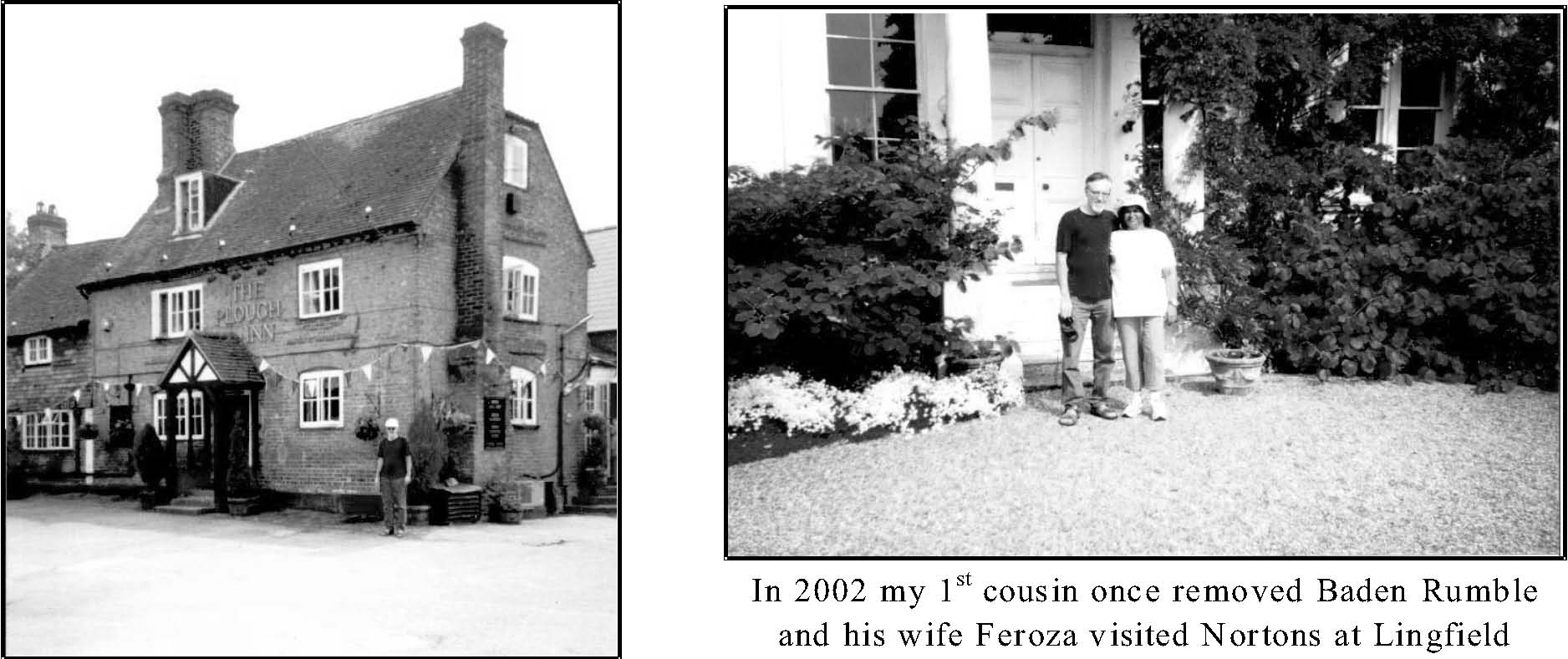
Baden Rumble outside an old Pub at Lingfield
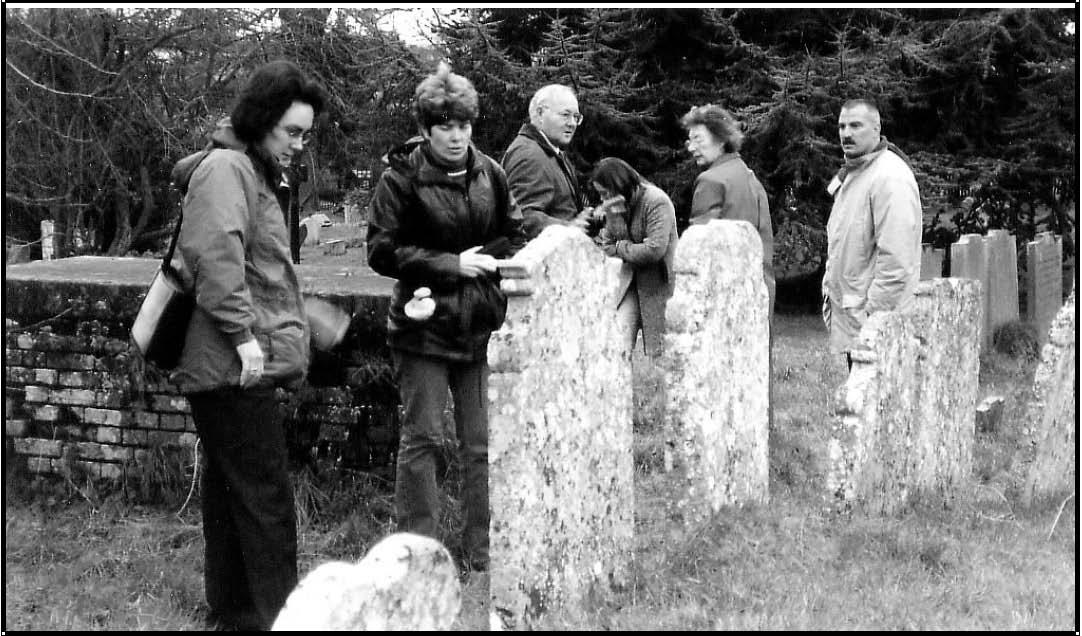
< In 2003 my niece Jane Collins, husband and daughters visited Lingfield with Henry and Rosemary Knight.
Above, they are exploring the tombstones at St. Mary’s church at Lingfield ( shown on the right)
The church was the scene of many activities of the Hochee family.
 UK
Descendants of Hochee at the launch of Guy Duncan’s book in
2003
UK
Descendants of Hochee at the launch of Guy Duncan’s book in
2003
We return briefly to the Chart of Hochee’s family, first shown on page 25. Although our interest is centred on the sixth child, Letitia, I present a ‘thumbnail’ statement about each of the other children:
Sarah Hochee married Thorold Lowdell, a farmer, on 20 April 1854 and had 9 children not all of whom survived. Thorold lived at Baldwins Hill, within 2 miles of Lingfield. As the chart on page 6 shows both Jane Seel (neé Lowdell) [16184] and Peter Morris Jones [16156] are descendants of Sarah. Peter died of cancer on 29 June 2003.
Henrietta Hochee married Sydney Poole Lowdell, Thorold’s youngest brother, in 1866. Sydney qualified as a doctor one year before his marriage and for a time practised in London. As Henrietta was 40 at her marriage, they had no children. By 1871 he was no longer practising medicine and eventually moved to Brighton. She died in 1911, and Sydney in 1922. He left a legacy to help maintain the almshouses.
John Elphinstone Fatqua Hochee did not marry. At the age of 16 he entered the East India Company Military Academy at Addiscombe. He then became a cadet with the EIC under the name ‘John Milton’. The Chinese names Fatqua and Hochee might have handicapped him in his career, so he dropped them, using instead his grandmother’s maiden name, ‘Milton’. By 1846 he was an ‘ensign’ serving at Madras in India. But he became ill and had periods of sick leave. He finally resigned from the army. When his father died in April 1869, he was living with his mother. He died in April 1883 at 33 Wimpole Street, London just three days after making his Will. His death was due to infection following an operation to remove a bladder stone.
Jane Hochee died in 1846 at the age of 16, and nothing is known of her.
James Hochee, on the other hand, lived to the age of 64, married Emma Fry, and eventually became a medical practitioner at Finchley, North London. In the year of his death he was recorded as ‘Medical Officer for the County and Convalescence Branch of the British National Hospital for the Paralysed and Epileptic’ - a post he had held from at least 1883. James married Emma on 27 July 1864 when he was 32; Emma’s father was James Fry, Curate of Lingfield from 1855 to at least 1863. James and Emma had six children between 1865 and 1872 - and were the great-grandparents of Guy Duncan [16146].
Letitia Charlotte Hochee married Anthony Knight. They were my great-grandpar-ents. They had six children, and it is their story that we will next take up.
Ann Hochee at the age of 31 married Crawford John Pocock. His father, Gavin, was a surgeon and a partner of George Lowdell. Crawford also became a surgeon. His marriage to Ann was his second marriage. His first wife, Mary Lynn, died at the age of 30 - most likely through complications of childbirth. Ann and Crawford had only one child, Mary Emily Pocock. Mary married into the Knight family. She and her husband Henry St.John Knight were the grandparents of Henry Knight [16078]
Emily Hochee at the age of 30 married Frank Abraham. They did not have children. In her Will Frank is described as a ‘foreign merchant’ but he ran up many debts and she was much concerned that he would not get his hands on her capital. The tone of the Will suggests that it may not have been a happy marriage. She died in 1904.
Anthony Knight and his wife Letitia Hochee
Almost fifty pages ago I was about to embark on the life-story of my great-grandparents Anthony and Letitia Knight, but paused to look at Letitia’s background31. It was a long pause because so much work has been done to probe into, and to establish that background. But now we can return to Anthony and Letitia.
Anthony was born on 24 October 1831, almost exactly three years before Letitia32. We know nothing of his childhood but he became a solicitor. His firm, Humphreys and Knight, was established in Spital Square and Parliament Street, London. Then in 1860 he married Letitia Hochee. He was 29 and she 26 years of age.
We do not know how they met and can only suggest that Geography may have played its part. Anthony’s father Valentine had lived at 3 Cornwall Terrace, Regent’s Park, while John Elphinstone had his London residence at York Terrace, Regent’s Park. The two streets are more or less adjacent to each other, and we know that John Hochee and his family were sometimes in residence there with Elphinstone. Perhaps Anthony and Letitia met through living in close proximity. Perhaps they attended the same church, met while strolling in Regent’s Park, or were introduced by mutual friends. This is a mystery for which we have no answer.
But there is another mystery, much deeper and unexplained: The nature of their marriage and that fact that they were married twice!
The record of their first marriage states:
Anthony Knight, solicitor, of Marylebone Father: Valentine Knight, gentleman 24 October 1860 m Letitia Charlotte Hochee, of Lingfield. Father: John Hochee Married by: Alfred Jones in All Souls, Marylebone Witnesses: Fred Elin Robert Blackmore
As Guy Duncan remarked in his book:
An apparently unexceptional record from the register, until one begins to examine it more closely. The oddity is that no one from either family signed as a witness. Certainly no woman, who might have been a bridesmaid to Letitia. Which is not to say that the families were not present, until we come to what happened next.
31 See page 22
32 The m aterial for this section is drawn partly from G uy D uncan’s Hochee and Elphinstone book, chapter 70, and from my own Rumble Family Register pages124-127, 219-221
THE CURIOUS TWO MARRIAGES OF ANTHONY AND LETITIA
73
In the 1861 census a few months later, Letitia is at home with her family. Nothing odd about that, except that she is recorded as unmarried and her husband is not there. Now that is odd! But, the most extraordinary oddity is the next step in this story. There is a second marriage, recorded as:
Letitia Charlotte Hochee, of Lingfield, Father: John Hochee
m
Anthony Knight, solicitor, of Regent's Park, London.
Father: Valentine Knight, gentleman
1 August 1861
Married by: James Fry in parish church, Lingfield
Witnesses: John Hochee, Henrietta Hochee, William W Knight,
Katherine Knight
As Guy Duncan noted:
Now this is what one would call a normal family wedding, with representatives of both sides present. The problem is that it was the couple's second marriage, only ten months after the first and with no indication that the first was not valid. One is driven to the conclusion that the first ceremony was held in secret, without the knowledge of either set of parents. And if any of their siblings were in the know, they kept their mouths shut and allowed the second wedding to go ahead unchallenged. William Knight was one of Anthony's older brothers and Katherine a younger sister. James Fry was Curate of Lingfield 1855-186333; One would love to learn how the couple conducted themselves between their two marriages!
The present-day Knight family believe that Anthony's father, Valentine, objected to the wedding and that this was the cause of the secrecy surrounding their first marriage. Their first child, Valentine Elphinstone Knight was not born until November 1862, so there is no unexpected pregnancy that forced them into their first marriage. Of course, racial prejudice would naturally play a role and perhaps Anthony’s parents would not initially accept a half-Chinese girl as a daughter-in-law. All of John Hochee’s children, being half-Chinese, could expect to face prejudice. After all, Alice Hochee - who married Percy Duncan - hid the portrait of John Hochee for years so as not to tarnish the family reputation34. James Hochee moved from general private practice to an institutional appointment, possibly because of the difficulty in attracting private patients.
For reasons unknown to us Anthony and Letitia migrated to New Zealand travelling, on the sailing ship, ‘Victoria’, of 600 tons, and arrived there on the 30th March 1862.
33 James Fry w as the father -in-law of Jam es H ochee. (See page 71) 34 See page 52
My mother claimed35 that Anthony was a wealthy man who “dabbled on the Stock Exchange” and travelled abroad with his family and servants to New Zealand. My cousin Jean [16005] said that her father Horace Rumble [15010] told her the same story. Knowing my mother’s penchant for romantic elaboration, there is probably only some truth in this as, when Anthony and Letitia sailed for New Zealand, they did not yet have a family.
Their first four children, Valentine Elphinstone [14013], Frederick William [14014], my grandmother Kate Rosaline[14004] and Henry St. John [14015] were all born in Christchurch New Zealand. We know nothing of their life there for the following seven years, though we assume Anthony practised as a solicitor.
In March 1869 they left New Zealand on the ‘Gothenberg’ bound for Australia and continued their return to England via Melbourne on the ‘City of Vienna’, arriving on 26th July 1869. They then went to live in Leatherhead36.
In his 1920 letter to Kate Knight, her younger brother Henry St. John Knight, wrote:
"I find the places we went to before settling down in Blackheath are
as follows:
1869 - Leatherhead, Cavendish (?) and Hastings;
1870 - Clevedon;
1871 - Ross and Worthing;
1872 - Harefield and Malvern;
1873 - Bournemouth;
1874 - Ryde and StokesBay;
1875 - Arundel, Worthing and Hastings;
1876 - Hawkhurst and Sandgate;
1878 - St Leonards, Sandgate and Folkestone;
1879 - Dover, Ashford and Eastbourne;
February 1882 - Lawn Terrace, Blackheath;
June 1882 - Vanbrugh Terrace, Blackheath."
Guy Duncan commented on this list:
We can fill in a location for 1877 too, as Anthony wrote his will in
August of that year in Gill's Green, near Hawkhurst.
It is a perplexing litany of change of residence. If Anthony was merely visiting towns in the course of his work, he would not have taken his children with him.
35 Rumble F amily Register, page 125
36 The account of dates associated with New Zealand and subsequent movements on returning to Britain w ere foun d in a letter to K ate Kn ight [14004] written by her younger brother H enr y St. John Knight [14015] in 1920 after the death of Letitia. He wrote that these dates were found in an old diary concerning Anthony and his family. U nfortunately the diary itself did not survive.
Apart from the picture of Letitia on page 8, this is the only photograph we have of her. The only photos we have of Anthony Knight are those on pages 4 and 8
In 1958 when I was studying in London, we drove in our car one day to Blackheath, south of Greenwich and walked across Blackheath to reach Vanbrugh Terrace. There we found Number 2, and took the above photos of it.
It does seem he actually stayed in these various places for some time on each occasion. His son, Churchill, for example, was born in Folkestone in 1879, as the 1901 census shows. (Both the grandchildren who were staying with them have descendants alive today.)
The 1901 census details for 2 Vanbrugh Terrace, Blackheath, Greenwich are as follows:
|
Antony Knight |
Head |
M |
69 |
Living on own Means |
Clerk enw ell |
|||||
|---|---|---|---|---|---|---|---|---|---|---|
|
Letitia C harlotte Knight |
Wife |
M |
66 |
Lingfield |
||||||
|
Fredk Wm A nthony Knight Son |
S |
36 |
Electrician Worker |
New Zealand |
||||||
|
Churchill Knight |
Son |
S |
22 |
Electrical Student W orker Folkestone |
||||||
|
Lottie Georgina Rumble |
Gddau |
S |
7 |
Birmingham |
||||||
|
An thony Henry K night |
Gdson |
S |
5 |
Plym outh |
||||||
|
Ellen Clarke |
Serv |
S |
30 |
Cook D omestic |
Devon |
|||||
|
Rosanna Fielding |
" |
S |
25 |
House Parlourmaid |
W ilts, |
|||||
|
Edith Anderson |
S |
24 |
Nurse |
Plym outh |
||||||
|
Harriet Spring |
S |
21 |
Housem aid |
Uxbridge |
||||||
Once they had settled at Blackheath though, the family remained there, Anthony dying on 25th May 1912, and Letitia on 9th July 1920. They are buried together in Charlton Cemetery, Greenwich.
Anthony’s Will was simple:
I give, devise and bequeath unto my dear wife Letitia Charlotte all I have in the world and direct all monies to be paid to her receipt only I appoint my said dear wife Letitia Charlotte and my brother-in-law John Elphinstone Milton - executrix and executor of this my will dated 3rd August 1877 at Gills Green, Hawkhurst in the County of Kent. Anthony Knight.
After Anthony’s death, Letitia continued to live at Vanbrugh Terrace until her death in 1920. In 1989, Brenda Rohl [17033] visited Anthony’s grave at Charlton cemetery, Greenwich, England. She wrote:
The grave has three people and looks quite expensive (it’s made of
mottled brown marble with a large square cross, total height 6 feet)
Valentine Elphinstone Knight37, b.22/11/1862, d. 12/3/1904 Anthony Knight b.24/10/1831, d.25/5/1912 Perfect Love Casteth out fear Letitia Charlotte Knight b.15/10/1834, d. 9/7/1920
37 First ch ild of A nthon y and Letitia
A small marble cross with “from Katie” written on, was on the plinth. The cross appears to have been moved for the addition of Anthony's name and again for Letitia.
A nearby grave also contained Knights, I’m not sure if they are related: ‘Thomas John Knight, D.5/2/1901 aged 38 yrs.’, ‘Alice Maude Knight, D.31/12/1901 aged 8 months , infant daughter of the above’, ‘Elizabeth Amy Knight, D.6/4/1922 aged 59 years, wife of the above.’
As a personal touch I reproduce below a letter written by Letitia’s Australian grandson Horace Rumble [15010] to his mother Kate Rumble [14004] in Western Australia when, as a soldier in the First World War, he found himself in Britain, and visited Letitia and other relatives at Vanburgh Terrace
10th December 1916
I'm sitting down to write to you all the news in your old dining room, with my back to a comfortable fire. Granny, Lottie [15001] and Aunt Jenny [14013] having just gone to bed.
We've all been sitting around the fire roasting chestnuts since supper. You do not know how much I wish you were here with me, but of course, you couldn't be, so I must tell you all about it. You have had my letter from Codford telling you all about my arrival in England. Well, we were fooled around a lot at Codford Camp which is a wretched hole compared with Blackboy Hill (West Australia) and then, last Friday, were told we were to have our four days leave from 6 a.m. Saturday morning.
Of course everyone was very excited at the prospect of going to London, and Saturday morning saw us up at 4 a.m. amidst rain and mud. It was a dismal morning. However, we had breakfast, got our tickets issued to us - 3rd class, for which we had to pay 8/-, and then marched down to Codford station, about 2 miles. The train left at
7.45 with 400 men on board and the first and only stop happened to be Reading, the place where I was born. You can imagine how interested I was, but I only had time to go up and down the old platform, and then we were off again to London and finally ran into Paddington station.
From here we were marched through Hyde Park gardens to the Australian Headquarters, Horseferry Road, Westminster. It was fairly late then, so I dug up a friend of mine W.O. Howard Eyles who I knew was on Staff there and he was very pleased to see me, and we both went and lunched together. After that the fun began when I started out from there, alone, for Blackheath.
London is a big place, but how dirty and cramped after Australia it is. I got into Victoria Street, Westminster, which seemed to go on forever, got on motor buses and off again, and on to others - dozens and dozens, it seemed - and at last, when it was almost dark, arrived at Blackheath Railway Station, and from there, of course, it was plain sailing. I walked across the Heath and soon found myself walking up the steps past Granny’s round garden, all of which was quite familiar to me from having seen the photo you have of your old home.
It would be hard to describe my feelings when I was shown inside into your dining room. It just seemed as tho’ I had known Granny all my life. Granny is still remarkably well for her age. We talked about a lot of things, Granny being quite alone except for the servants, and then Lottie [15001], who had been out, came in and I was introduced to my cousin, and we had tea, and I put on Grandpa’s slippers which fitted me like a glove, and we sat by the fire and talked some more until dinner time, which was at 7.30.
Granny sat at the end of the table away from the window with Lottie on one side and I on the other. Just fancy how I felt sitting up to the table where you had sat, so many years ago.
Granny has had the old fireplace taken out and a modern one put in, so as to throw more heat into the room, and after we finished we sat by this talking until 9.30, which is Granny’s bedtime now.
Usually she and Lottie are by themselves and don’t sit up late for, of course, at her age, Granny gets tired early. Having got up so early and had such a long day, I went to bed too, and had the front bedroom next to the bathroom. Granny has the room behind that, and Lottie has your old room. After that old troopship and the camp you can’t imagine how nice it was to go to bed in that comfortable big bed in a suit of Uncle Henry’s pyjamas38 - for I came up to London with no baggage.
Next morning after breakfast Lottie very kindly set out with me for Streatham Hill to see Auntie Blanche39 and everyone there, Lottie, the day before, having sent a postcard saying we were coming across. I don’t know what I should have done without Lottie to guide me about. We trained from Blackheath to Cannon Street, and took buses for the balance of the way. London is full of motor buses now, and
38 Uncle H enry is probably Henry St John Knight [14015]
39 Euanita Blanche Rumble [14008] , Harry Humfrey Rumble’s sister - She never married. Grace Rumble [14006] and Mercy Rumble [14009] were other sisters of Harry Rumble
they whiz everywhere, but it is very hard to get a taxi owing to the war. I managed to get one from Cannon Street to the Commonwealth Bank where I went for more money. From there we had to take buses again to Wavertree road which runs off the road going right down to Brighton, I think.
We got off at the corner and walked up to 46, which is only a few hundred yards up. There I met Auntie Grace, Auntie Blanche and Auntie Mercy39, and everyone talked at once, and then, when we went into their sitting room, who do you think I met? - Pa’s Uncle Tom, or is it Pa’s Great Uncle40, I forget which now. He was a doctor. Just imagine meeting him. He is 85, and Auntie Blanche says he had only visited them once before and only came in quite casually that morning.
He didn’t stay very long and after he’d gone we all sat down to lunch, and after the meal Auntie Grace’s husband came home, and later on, Uncle John. It appears that Auntie Blanche had wired to him I was coming across, so you see what a family party we had. Everyone was so nice, and it was so nice to be among my very own relatives, and next time I come up I have to go and stay with them.
Auntie Blanche looks so well and is so jolly, and Uncle John said he had a nice country place with six bedrooms and only used one of them, and anytime I liked to come across etc. etc. . . from which I gathered that the other five were at my disposal.
Uncle John is, I think, a bit of a sport. He said he built the huts at our camp at Codford and said they were so badly done that he hoped he’d never have to sleep in them. He likes a joke, I think. Well, we all just had a good old talk. I told them all about Australia and our doings and the time simply flew. Then we had tea and at last we had to tear ourselves away as Granny expected us home to dinner.
We got home frightfully late for dinner even then. London is awful to travel in now. I got hold of a taxi and the man flatly refused to go down to Blackheath, so we had to scramble around on buses again with no lights - for London is very dark now - all the street lamps having black painted over the glass except for a narrow strip at the bottom. When we got to Lewisham we gave up the buses as a bad job and took the train home to the next station and walked across the Heath.
40 If Thomas Rumble was 85 in 1916, he would have been born in 1831 or 1832. So he was probably Thomas William Rumble [13003], Harry Rumble’s uncle. Harry’s grandfather, also Thomas, [12001] died in 1856 aged 65 years
This morning I got up and went across to your little church, St. Germain’s, with Granny and Lottie and then after breakfast Lottie took me to St. Paul’s. We had the same trouble with trains and buses. None ran to time, and missed half the service, but I was glad I went to see the old building. Isn't it black outside with smoke, and what a lot of pigeons there are on the pavement in front. I thought it looked so grand inside and had a good look at everything around the walls.
We came home early to dinner, being Sunday, and I found Aunt Jenny had arrived in the meantime and she is staying the night. After dinner while Granny had a nap on the sofa in the dining room and Lottie took her Sunday school class, Aunt Jenny took me out for a walk in Greenwich Park. How familiar all these places must be to you. After tea Granny has been showing me all her curios in the drawing room, and she has such a lot, among them a plate you were painting and did not finish with an orchid and maidenhair fern in the centre. I haven’t seen your other paintings yet but Granny is going to show them to me in the morning, also the nursery.
Of course I have seen all around the garden which is so nice, and the holly bush outside the dining room window on which Granny hangs coconut for the dear little birds - there was a Robin there this morning. I wish I could just pick you up and whisk you across here without any sea journey. I know you would love to be with me to show me everything in your lovely home.
Everyone is so good to me, and Lottie is such a bright little girl, altho’ she is older than Maudie41 she is much smaller and weighs only 8 stone.
Tomorrow she is going to take me up to Selfridges and to see some of the other big shops after which we will come home and then, alas, my all too short leave will be up, as I have to be back at Paddington for the 4.45 p.m. train.
41 Maude Rumble [15013] - sister of Horace.
Anthony and Letitia had six children as shown in the chart below. On the next page we present a short sketch of each child before we go on to look at the life of my grandmother, Kate Knight.
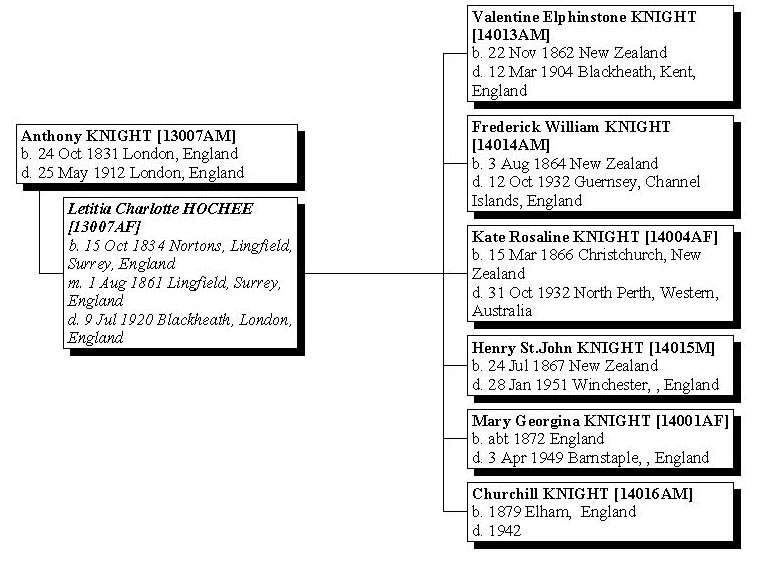
Valentine Elphinstone Knight [14013] their first child was born on 22 November 1862 in New Zealand. Back in England, in 1891 he married Lavinia Jane (Jenny) Reevell at Stockton. They had three children: Valentine Anthony (1892), Frederick (1895) and Courtney St.Aubyn (1899). In an 1897 letter to Kate, her brother Henry St. John wrote that Valentine was still living in the family home at Blackheath, “Val doing draftman’s work at Woolwich, but is looking for the first opportunity of going out to the Cape.” We know little more of his life. He died on 21 March 1904 at the age of 41 and was buried in the family grave at Charlton Cemetery, Greenwich.
Frederick William Knight [14014] was born on 3 August 1864. On 2 November 1894 he sailed for Rio de Janeiro to join the Western Brazilian Telegraph Company as an engineer, initially on a three year contract. He married Mary Gerard Rawlinson in Pernambuco (Recife), a coastal port in Brazil. They did not have children. My mother recalled that, when he retired, he returned to Britain but could not stand the cold, so he bought a home called “La Fosse” at Guernsey in the Channel Islands. He died on 12 October 1932. Mary Gerard lived for a further 16 years and was still living in Guernsey when the Germans occupied the island during World War II. She died on 28 February 1948.
Kate Rosaline Knight [14004] was born 15 March 1866. She married Harry Humfrey Rumble. As my grandmother, she is the next person we will consider in detail.
Henry St. John Knight [14015] was born on 24 July 1867 and was the last child to be born in New Zealand. As an adult he served in the Army Royal Engineers and was posted to South Africa, Palestine, the Far East and Canada. On 2 July 1894 he married Ellen Theresa Glanville. They had only one child Anthony Henry (‘Anton’) [15020] as Ellen died in childbirth at the age of 22. This second child, a girl, also died at birth. His second marriage was to his cousin, Mary Pocock, and they had three children. Henry Knight [16078] is a descendant. Henry St. John retired in 1927. His wife died in March 1943. The following August he married Susie Turrell who bore him three more children. He died on 28 January 1951 at the age of 82.
Mary Georgina Knight [14001] was born in 1872. She married Herbert Montague Rumble (‘Bertie’), younger brother to Harry Humfrey Rumble. Bertie became a mechanical engineer and for a period worked in Buenos Aires. Mary and Bertie had five children. She died on 3rd April 1949. Bertie had already died on 4th April 1942.
Churchill Knight [14016] was born in 1879, went to Oxford University, became an electrical engineer, and married Daisy Burnett in 1906. He then worked in Shanghai as an engineer. He retired back in England in 1934 at the age of 55 in Devon. They had one son, Ronald [15027] who was tragically killed in an air crash in Africa while flying his own plane. Ronald’s wife, searching for him, became lost in the desert and died of thirst and exposure. Churchill died on 8th May 1942.
The Lives of Kate Rosaline Knight & Harry Humfrey Rumble [14004]
When I discuss the lives of my grandparents, I am writing of people within living memory - at least partly so because, whereas my grandmother Kate died in 1932 when I was four years of age and I have no direct memories of her, Harry died in 1948 when I was twenty, so I do have strong memories of him.
However, I am the youngest child of the youngest child of my grandparents. They had seven surviving children six of whom married and had families, so I had many first cousins - as shown in the chart on the previous page. The oldest of these cousins was James (Jim) Rumble [16009] who was born in 1917; he had many direct memories of his grandparents. Indeed, all my cousins had many memories which, if not always direct, were told to them by their parents.
When I was compiling The Rumble Family Register between 1989 and 1994 I tape recorded interviews with most of my cousins and asked them to tell me about themselves, their parents and their grandparents - So I recorded the collective memories of my cousins.
After she died we discovered amongst my mother’s papers many small hand-written volumes of Kate’s diaries which covered the period of her life from mid-1911 until shortly before her death in October 1932. Some volumes were missing but we found these in the possession of my cousin Miriamme Young (née Spencer) [16014]. We borrowed them, and my wife Kay transcribed the entire set to produce a printed volume of over 520 pages, on which we could draw.
When, later, we delved into the background of the Rumble family, I was able to contact several relatives in Britain, who were interested in their family history. Those contacted are shown in bold underline in the chart below:
13001 Henry Euean RUMBLE Grace HUMFREY
14004 14003 14002 Harry Humfrey RUMBLE Ernest RUMBLE John RUMBLE Kate KNIGHT Martha SAELENS Glady SCOTT
15016 15008 Dorothy RUMBLE Frances RUMBLE Victor FALL George BAYNTON
15009 15006 Joseph Rumble John RUMBLE Joyce CAESAR Joyce (Judy) ROSE
There was one remaining valuable source of information: In July 2000 I bought a set of 25 compact disks, being a compilation, produced by the Church of Latter Day Saints, of the 1881 British Census records. With this I could search for the whereabouts of all my British relatives alive at that time, and the names of all those who resided in their homes on the night of the census.
Armed with all these resources I was ready to explore my Grandparents’ lives.
Kate was born on 15 March 1866 in Christchurch New Zealand. Of this she would have no memory as she was barely three years of age when her family returned to Britain and started a few years of moving from place to place.
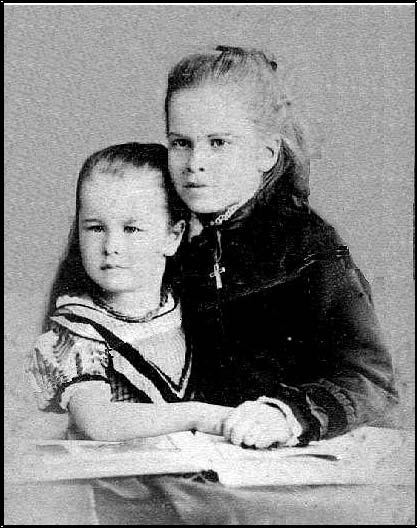
When the family returned to England and Mary and Kate had reached school age, Kate and her young sister Mary were sent to boarding school while they were quite young. A well known family story tells how Mary became very homesick, and Kate decided they would both run away from school and return home. This they did. When they arrived home, they received no sympathy whatsoever from their mother Letitia who forthwith packed them off straight back to boarding school
|
M ary and Kate Knight |
|||||||||||||
|---|---|---|---|---|---|---|---|---|---|---|---|---|---|
|
Apart from this, we know nothing of Kate’s early life. |
However, The 1881 |
||||||||||||
|
British census is revealing: |
|||||||||||||
|
Dwelling: 28 Hyde Gardens. Census place: Eastbourne, Sussex |
|||||||||||||
|
Anthony KNIGHT |
M |
49 |
M |
Head |
born: London, M iddlesex |
||||||||
|
occ: Solicitor |
|||||||||||||
|
Letitia C. |
KNIGHT |
M |
46 |
F |
Wife |
born: Lingfield, Surrey |
|||||||
|
Mary L. |
KNIGHT |
U |
9 |
F |
Daur |
born: Ross, Hertford |
|||||||
|
Scholar |
|||||||||||||
|
Churchill KNIGHT |
2 |
M |
Son |
born: Folkestone, Kent |
|||||||||
|
Elizabeth WATE |
U |
26 |
F |
Servant |
born: Ashford, Kent |
||||||||
|
occ: Nurse Domestic Servant |
|||||||||||||
Nineteen year-old Valentine was not at home, nor were seventeen-year-old Frederick, fifteen-year-old Kate or fourteen-year-old Henry. Only Mary and Churchill were there that night. The other children were presumably away at boarding school. Indeed, the census record showed that Kate was a “Scholar border” at Park House, Park Mansion, Hastings. The Head of the household and school was 46 year old schoolmistress, Jane Stewart. She lived there with one daughter and two sons, five teachers, five servants and thirty Boarder-Scholars. All students were named in the census record and, of course, Kate was among them.
We do not know how Kate met Harry Humfrey Rumble, but we suspect that, once again, geography played its part. When exploring households in the 1881 census CDs it is possible to examine all households in any given street. We found that Harry Rumble was at that time a fourteen-year-old scholar living at 27 Hyde Gardens, Eastbourne - and Kate was at 28 Hyde Gardens!

27 Hyde Gardens Eastbourne, the home of Henry Euean Rumble and his family in 1881
The house has since been divided into a group of flats.
Dwelling: 27 Hyde Gdn Census place: Eastbourne Sussex
|
Henry E. RUM BLE |
M |
46 |
M |
Head |
born: Gt Marlow, Buckingham |
|
|---|---|---|---|---|---|---|
|
Occ: A rchitect |
||||||
|
Grace RUMBLE |
M |
42 |
F |
Wife |
born: Upton, Berkshire |
|
|
Grace B. RUMBLE |
U |
18 |
F |
Daur |
born: Speen, Berkshire |
|
|
Eueanita B. RUMBLE |
U |
16 |
F |
Daur |
born: Eastbourne, Sussex |
|
|
Harry H. RUMBLE |
U |
14 |
M |
Son, Scholar |
born: Eastbourne, Sussex |
|
|
Herbert M. RUMBLE |
U |
13 |
M |
Son, Scholar |
born: Eastbourne, Sussex |
|
|
Frances M. RUMBLE |
U |
11 |
F |
Daur, Scholar |
born: Eastbourne, Sussex |
|
|
Joseph H. RUMBLE |
U |
9 |
M |
Son, Scholar |
born: Eastbourne, Sussex |
|
|
Ernest D.L. RUMBLE |
U |
7 |
M |
Son, Scholar |
born: Eastbourne, Sussex |
|
|
John E. RUMBLE |
U |
5 |
M |
Son, Scholar |
born: Eastbourne, Sussex |
|
|
Mercy G. RUMBLE |
U |
3 |
F |
Daur |
born: Eastbourne, Sussex |
|
|
Annie FILDER |
U |
27 |
F |
General servant |
||
|
Rachael HENDY |
U |
18 |
F |
General Servant |
||
So it seems likely that Harry and Kate met through living in the same street, but we know nothing of that except that they married on 30 July 1887 when they were both twenty-one.
There is quite a story about their marriage and the severe family quarrel that caused them to emigrate to Australia, but that is something I will relate after I have recounted Harry’s family background.
However, before I embark on that detailed background, I will present on the next page photos of them both when they were twenty-one year of age.
< This is Kate Knight at age
21.
She married Harry Humfrey Rumble
And this is Harry Humfrey Rumble > also 21 when he married Kate in 1887.
Little did they know the hardships which at first awaited them when they migrated to Australia - estranged from their families.
HARRY’S ANCESTORS - THE HUMFREYS 91
The Background of Harry Humfrey Rumble.
The ancestry chart on the previous page shows that we have limited knowledge of the Rumble line - only back to Harry’s grandparents, Thomas Rumble [12001] and his wife Frances de Brotherton. However, although we have no hard evidence of the forebears of Frances, there is long-standing family folklore that goes back to the fourteenth century. When I was a small boy my mother told me that I was descended from the famous “Black Prince” of English history. As a small boy brought up on a diet of fairy tales and stories of King Arthur and the Knights of the Round Table, this was very exciting indeed. Although it appears that this might not have been completely accurate, there is a general belief among various relatives in England that Frances was a descendant from Thomas de Brotherton, born in 1300 - but more of that later.
Our first pursuit is to explore the other major line - the ancestors of Harry Hum-frey’s mother, Grace Humfrey. Once again, my mother told me when I was very young, that we came from a long line of landed gentry, the Humfrey’s, some of whom were ‘Lord of the Manor’. I did not know what that meant, but it sounded important.
The Humfrey line shown on page 90 extends back many generations to a Thomas Humfrey [06001] who was born in 1616 and died in 1690.
In 1989 I contacted some of my mother’s first cousins, having found the address for Frances Baynton (née Rumble)[15008], her brother Joseph Rumble [15009] and Judy Rumble (née Rose) [15006] in her papers. When I enquired about the Humfrey branch, Judy42 referred me to her son Michael [16001] who was born on 21 February 195243. He was a sergeant in the Sussex Police Force in Britain but had been seconded to a helicopter unit based at Shoreham airport, about five miles from Brighton. Mike was interested in his family history and in 1990 sent me an A3-sized chart crammed with the names of members of the Humfrey family, going back to a Thomas Humfrey [06001] This family tree contained over 200 names, only a few of which were on our own direct line of descent. I do not know whether he researched this information himself, or obtained it from others, but it was very interesting to receive. But, while the information he sent included a very large number of names, there was little or no information about any individual - and nothing to support its authenticity.
I will start by going back to this earliest Humfrey ancestor and then follow his descendants down to my grandfather.
42 Judy was actually Joyce Florence Rose who marr ied John Faithful Scott Rumble, w ho was always known as ‘Jock’ Jock died in 1971.
43 See family chart on page 85
THE HUMFREYS - LORDS OF THE MANOR 93
Thomas Humfrey [06001]
The chart on the previous page shows that Thomas married Ann and that we have a record of two sons, Thomas [07001] and John [07001]. This second Thomas married Mary Stacey and had nine children, the oldest of whom, John [08001], married Ann Ilbury and had eight children. The first of these was also named Thomas [09001] and our line of descent comes through him.
Michael Rumble’s family chart shows all four of these ancestors (06001, 07001, 08001 and 09001) as “Lord of the Manor”. This agreed with my moth-er’s statement that the Humfreys had been powerful and important land-owners, and it brought back memories of my early schooldays when I learnt about the Medieval feudal system.
Of course, the feudal land tenure system with its Lords of the Manor, vassals and serfs was on its way out by the beginning of the 17th century. This was a system by which land was held by tenants from lords. The king was lord paramount with numerous levels of lesser lords down to the occupying tenant. Tenures were divided into ‘free’ and ‘unfree’. Of the free tenures, the first was tenure in chivalry and knight service which, up to the 12th century, entailed performing military duties for the king or other lord. Another form of free tenure required performing so many days’ plowing each year for the lord. The main type of unfree tenancy was villeinage - a form of servitude. The unfree tenant never knew what he might be called upon to do for his lord.
The manorial system had its origins in the late Roman Empire when large landowners consolidated their hold over both their land and the labourers who worked for them. The typical manor of the 13th century consisted partly of cottages, huts, barns and gardens of its peasants, which were clustered to form a small village. There might also be a church, a mill and a wine press in the village. Close by was the fortified dwelling, or manor house, of the lord, which might be inhabited by him, or by his steward if he happened to hold more than one manor. The village was surrounded by arable land that was divided into three large fields that were farmed in rotation, with one allowed to lie fallow each year. There were also meadows and pastures for livestock, pools and streams for fishing, forests and waste lands for wood gathering. Much of this was held by the lord, not granted to free tenants but retained by him for his own use.
Local government, law and order was usually controlled by the lord. The manor court was divided into criminal, manorial and civil areas. It dealt with petty offences, making regulations for the management of the manor and the recording of the names and duties of tenants. Following the 11th century growth of commerce and a money economy, and with the consequent growth of cities, lords increasingly allowed their peasants to commute their services for money, and often eventually they bought their freedom. For these and other economic reasons, the inefficient and coercive manorial system slowly disintegrated.
With increased prosperity and a desire for more commodious dwellings, the 16th century manor house evolved into a Renaissance country house. Back in the 11th century the manor house included a large hall, chapel, kitchen and farm buildings contained within a defensive wall and ditch. All this had changed by the 16th century: The hall had diminished in size and importance, and often reduced in status to an ‘entrance’.
Our earliest recorded Humfreys were probably large and well-to-do land owners with tenant farmers on their properties; their houses would have been substantial, and they would have wielded much influence in their local communities. More than this, we do not know.
In 1958 when I lived in Britain for three years, our only exploration into my mother’s family background was to seek the graves of members of the Humfrey family. All that I knew at that time was that my mother had told me that they had come from a long line of wealthy land owners from Upton. Unfortunately, our road map of the British Isles listed nineteen Uptons, apart from the hyphenated towns such as Upton-on-Severn. After several false leads, we eventually found many gravestones of the Humfreys at the Church of St. Andrew at Hagbourne, Berkshire which was within a mile of one of the many Uptons. On a tablet inside the church we read:
Near this tablet are deposited the remains of Joseph Humfrey who departed this life October 10th 1775 aged 80 years and also Thomas his son who departed his life on 29 May 1788, aged 64 years. `Nor love thy life nor hate but what thou livst, live well.'
Outside in the church yard there were the graves of many Humfreys, some of whom had been mentioned to me by Mother.
The Humfrey chart on page 92 shows a Joseph Humfrey [08030] who was born in 1693 and died in 1773. He would have been 80 years old at his death and, although the dates are not quite the same as in Michael Rumble’s chart, I suspect that the Joseph Humfrey on the Tablet is the Joseph in our chart. Michael’s chart also showed that Joseph had several children, but the chart only names one of these as Joseph [09025] born in 1724 and died in 1788. The tablet records a son, Thomas, who died in 1788, aged 64 years, so that he would have been born in 1724. Thus Thomas and Joseph have the same birth and death dates, which leads one to suspect that they were one and the same person.
This is one of the problems with family trees that have no supporting documentation to authenticate them. There may be errors in translation, or someone - such as my sister Dorothy Joan, who was always known as Joan may have used their second name, rather than their first name. Our Joseph Humfrey [09028] may have been christened ‘Joseph Thomas’ and may have always used his second name ‘Thomas’. We can never know the truth of such conjectures.
We also found several gravestones in the church of St.Mary at Upton near East Hagbourne. They have the following inscriptions: [1] In memory of Thomas Humfrey late of Stone, born October 19th 1823, died March 19th 1905;
[2] In loving memory of my dear sister, Mary Ann Humfrey [14108] passed away June 9th 1928; [3] Mercy Jane Humfrey [14102] died 12th July 1953 aged 86; [4] Blanche Amy Humfrey [14101] died 13th December 1958 aged 93; [5] Jane Humfrey [13006] 1830 - 1915; [6] Nathaniel Humfrey [13006] 1828 - 1914; [7] In memory of Fanny Jane Humfrey who died December 2nd 1863 aged 4 years;
[8] T.H. 1865; [9] A.H. 1876; [10] D.H. 1880; [11] E.H.1881.
Before we look at the descendants of Thomas Humfrey [09001] we will pause to make a brief comment on 17th century society.
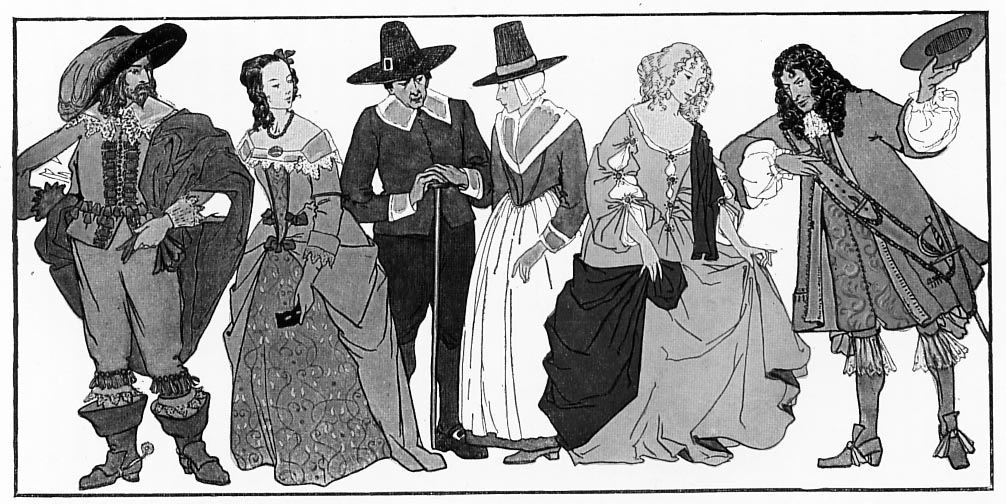
First we show typical 17th century dress: On the left a Cavalier in rich dress. Ladies skirts although full were no longer stretched out on a frame. Satin and stiff silk or velvet were generally used. The second man, above, is dressed as a Puritan - he wore the opposite of the prevailing mode, as a protest. Fashionable women sometimes wore aprons. The last couple on the right belong to the end of the period. The tunic has given away to a coat and waistcoat. This clothing is of the well-to-do, not the peasants.
On the left is a substantial house dating from 1636, such as might be used by the Lord of the Manor.
The plan of the house (right) shows a substantial entrance hall, but not as large as in the older manor
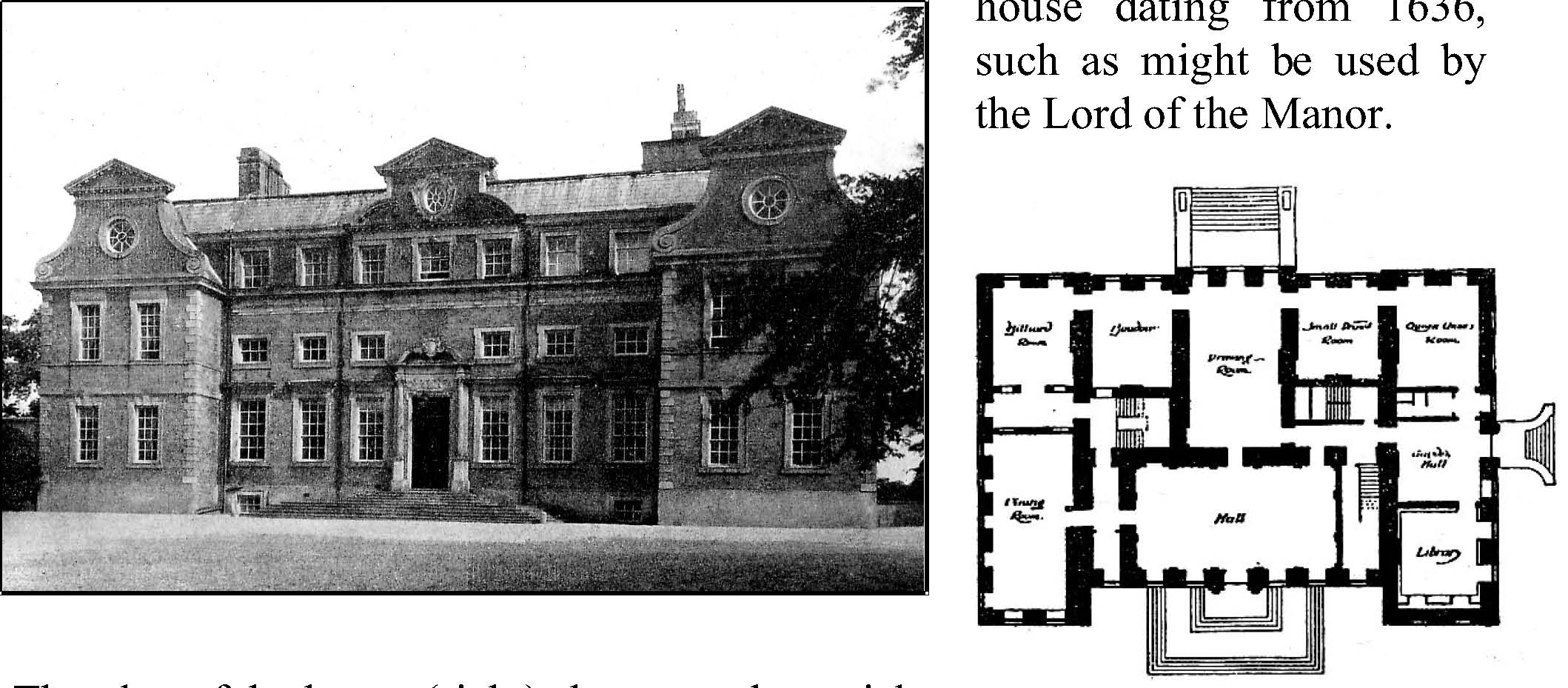
Finally, on the > right, a Stage Waggon of the day.
The charts on the last two pages complete the family tree for the Humfreys. We know virtually nothing about the people shown on page 96 other than what is given in the chart itself. As we come nearer to our own generation with the family tree on page 97, we know a little.
My mother said that Joseph Humfrey [12002] was a gentleman farmer at Upton, Didcot, in Berkshire, and that he held very large estates. We have a little more information about his children.
Nathaniel Humfrey [13006] inherited his father’s estates. The porch at the church at Upton, my mother said, was built in memory of his golden wedding anniversary. His gravestone, inscribed Nathaniel Humfrey 1828 - 1914, is in the churchyard of St. Mary’s church at Upton near Hagbourne. The entry in the Index of Wills states:
Hum frey, Nathaniel of U pton Lodge Upton Blewbury Berkshire gentleman who died 2 June 1914. Probate Oxford to William Joseph Hum frey farmer and Blanche Amy Humfrey spinster. Personal effects £26,010 9s 9d.
Nathaniel left the bulk of his estate to his oldest son, William Joseph [14098]:
I devise m y Upton and Blewbury Estate in the County of Berks including all manors or reputed man ors, messuages lands and hereditament....
His will shows that he kept horses, cattle, sheep, pigs, various crops, carriages and other farming equipment. He also had substantial debenture stock in the Didcot Blewbury and Southampton Railway Company - which he left to various children.
Philip Humfrey [13050] The records of Upton at the Berkshire Records Office show that Philip was baptised on 30 June 1830 and that he died on 23rd May 1872.
I first became aware of Philip through a copy of the book Swiss Family Robinson that is now in my possession and which was inscribed:
Philip Humfrey, Upton, Berks given by him to Grace Humfrey April 12th 1852 Sent out to H. Humfrey Rumble Perth W. Australia 1903 given by him to daughter Maude August 20th 1911 at Maude’s death to her youngest sister Dorothy Fall August 1928 At Dorothy’s death, handed to her son John Fall, 1988
< Inscriptions showing the progressive ownership of the book
The book is now in very poor condition
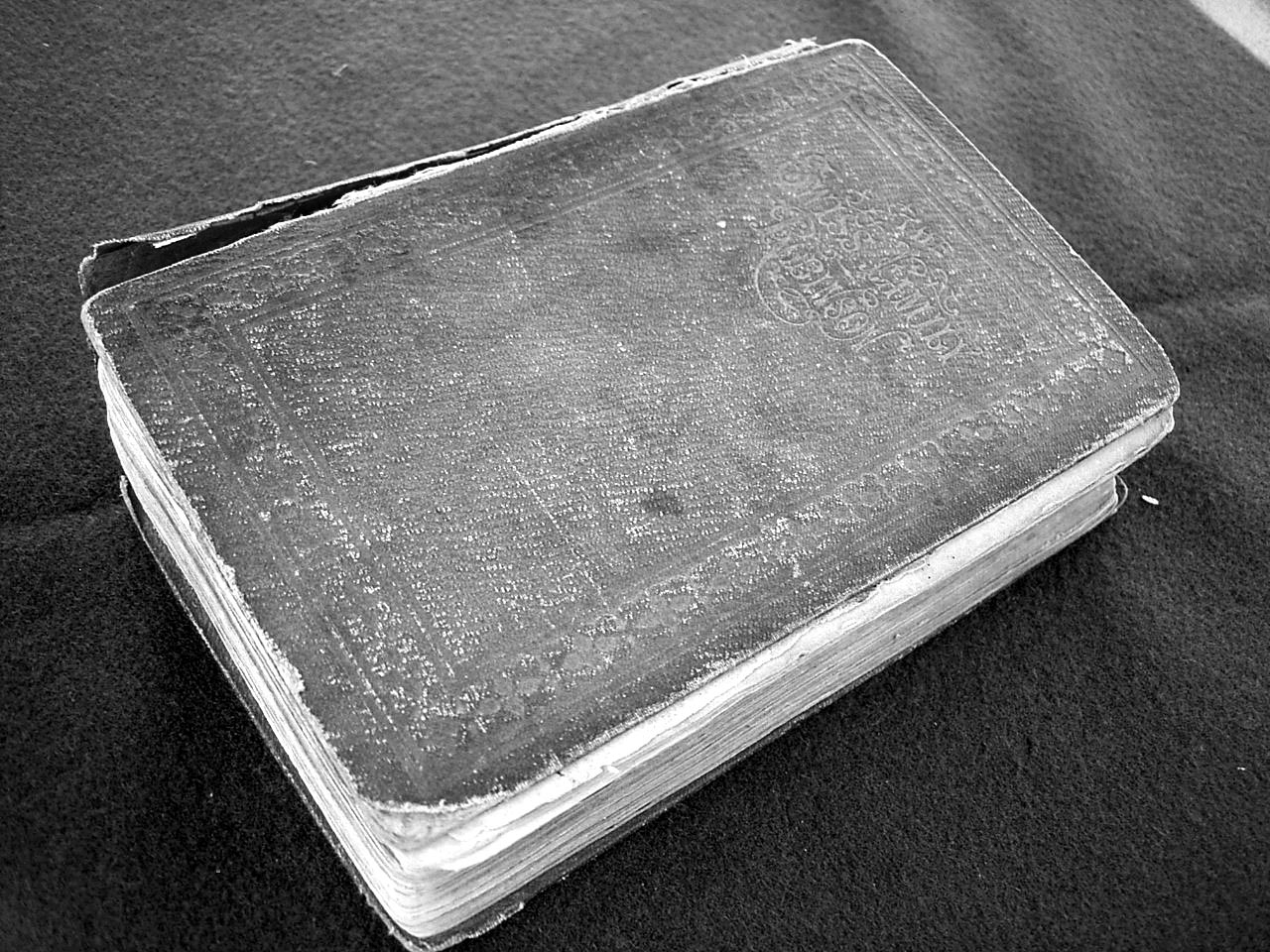 <
This is the entire book
<
This is the entire book
which measures
15c x 10c x 3c thick
Here is the title page >
Starting with Philip Humfrey in 1852 I am the sixth owner of the volume which has been passed down from generation to generation.
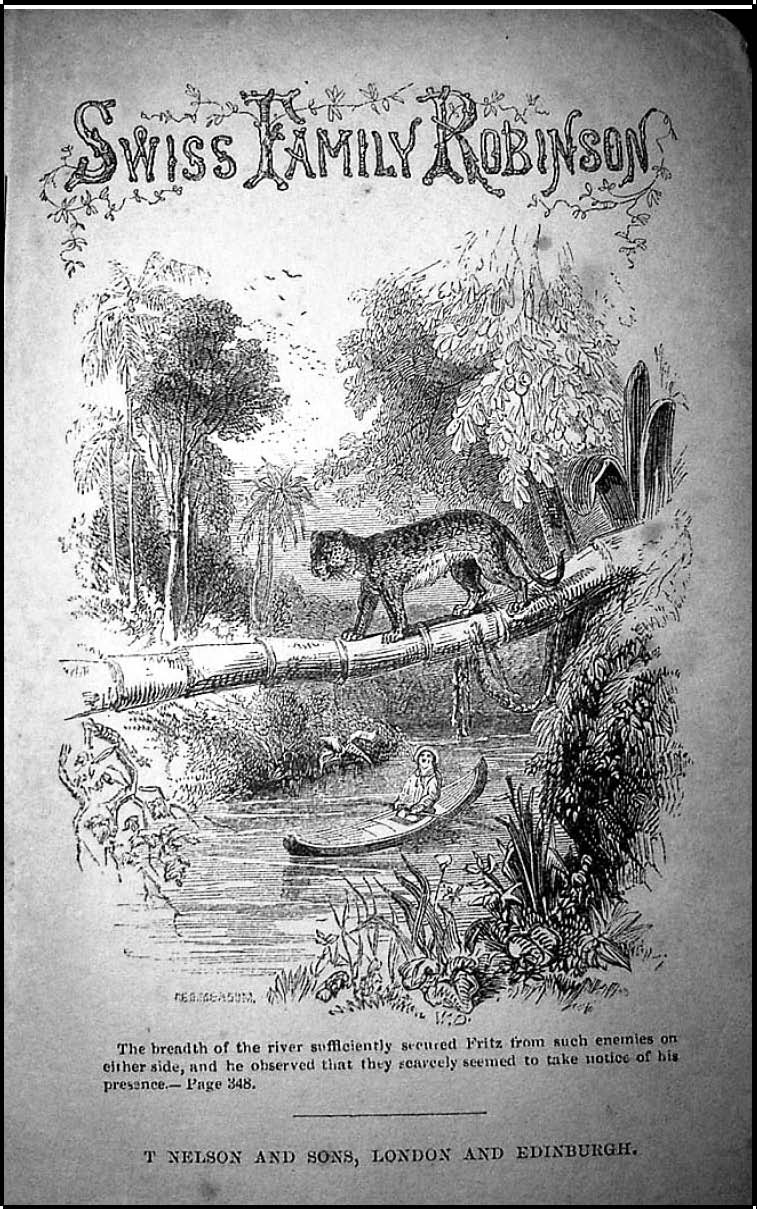 Of
the other children of Joseph Humfrey, both Simeon [13070] and
Zacchaus [13074] died under the age of one year, while we know
nothing more of Hannah [13072], Phoebe [13071] and Mercy [13073]
other than their year of birth.
Of
the other children of Joseph Humfrey, both Simeon [13070] and
Zacchaus [13074] died under the age of one year, while we know
nothing more of Hannah [13072], Phoebe [13071] and Mercy [13073]
other than their year of birth.
Records at St. Catherine’s House in London44 show Grace’s birth at Upton, Berkshire in the December 1838 quarter, parish of Newbury (ref 2 229). The Berkshire Records Office states that she was baptised on 26 November 1838. We do not know how she met and married Henry Euean Rumble but they had eleven children. She died on 16 January 1894 and was buried at Eastbourne on 19th January.
As shown in the chart of page 90, Henry Euean Rumble was the son of Thomas Rumble [12001] and Frances Mary de Brotherton. Frances’s father was Thomas de Brotherton [11001], and it his colourful ancestry that we will now take up.
The children of Harry Humfrey Rumble thought that Thomas de Brotherton was a descendant of the Black Prince in England. A letter written in 1938 by Blanche Rumble [14008]45 in England to Dorothy Fall seemed to confirm this:
On my father’s side we go back to the Black Prince of English history, who had several sons; one of them was Thomas De Brotherton and this was our ancestor. My great-grandmother’s father was a direct descendant, named Thomas de Brotherton
46
This information was incorrect. Mark Rumble [16075] stated in 1991 that he had researched the de Brotherton background and found that it was not possible to trace the line back directly from Frances Mary de Brotherton. He had approached the College of Arms in England, who were willing to trace her ancestry provided he could give them some initial detail, such as her place of birth. Unfortunately, this was not known.
However, it is still part of family folklore that Frances Mary de Brotherton was a descendant of the original Thomas de Brotherton. This Thomas was the eldest son by the second marriage of King Edward I to Margaret of France, half-sister to King Philip IV of France. Edward I had four sons by his first marriage. The relation to the Black Prince is shown in the abbreviated chart on the next page.
44 St. Catherine’s House was the central records office until some time in the 1990s 45 Eueanita Blanche Rumble was an older sister of Harry H umfrey Rum ble - see page 98 46 See chart on page 85
Eleanor EDWARD I Margaret of Castille m1 * * m2 of France .
Isabella EDWARD II THOMAS EDMUND ? Eleanor of France * of Brotherton of Woodstock T .- 1300-1338 * m. * Philippa EDWARD III 5 Many Generation later 5* of Hainaut *5 Thomas de Brotherton 5* -5 father of Frances Mary 5* *
EDWARD JOAN, the of Woodstock Fair Maid of Kent "The Black Prince" * .
RICHARD II
The original Thomas de Brotherton was born in 1300, died in 1338 and was buried in the abbey church of Bury St.Edmunds. He was called Thomas after Thomas de Courbridge, Archbishop of York, who christened him. In 1992 Mark Rumble visited the Chancery Lane Records office in London and discovered that the Court Rolls of Edward I showed that Edward I stayed at Brother-ton in Yorkshire on the way to fight in Scotland at the time of Thomas’ birth. In June 1300, a letter was written by Edward from that address. Therefore it seems reasonably certain that Thomas was called de Brotherton from his birthplace in Yorkshire.
Thomas became the Earl of Norfolk, and had many manors and estates, including Framlingham Castle. He first married Alice, the daughter of Roger De Hales of Harwich and had three children by her. His second marriage was to Mary, daughter of Sir Peers de Browse. By this second marriage there was a son, John, who became a monk.
The children by the first marriage were:
EDWARD, who married Beatrice, daughter of Roger Mortimer, Earl of March. Edward died in 1338, the same year as his father.
MARGARET, who first married John, Lord Segrave. He died in 1353 and she then married William d’Afford, Earl of Suffolk. William died in 1381 and she died in 1400.
ALICE, who married Edward Monti-Acuto. She died before 1351 and Edward died in 1361. They had a son, Edward, who died in 1361. The family name eventually became Montague, and Lord Montague is a descendant.
When Thomas de Brotherton and his son Edward died, the direct line of de Brothertons ceased. Mark Rumble has surmised that, as bastard sons at that time could be legitimised and titled, it is possible that the de Brotherton name was carried on in that way, and that the line to Frances Mary de Brotherton follows from this. Margaret and Alice became the co-heirs of their father Thomas. Alice and her husband were assigned Framlingham castle.
Fr amlingham Castle - as photographed in 1988
 The
castle is a little inland from Aldeburgh on the east coast of Suffolk
- as shown in the map on the left.
The
castle is a little inland from Aldeburgh on the east coast of Suffolk
- as shown in the map on the left.
Today, Framlingham castle is one of Suffolk's best known Norman Castles. The manor of Framlingham was given to Roger Bigod by king Henry I in 1101. Roger already held much land in Suffolk and when his son Hugh was created earl of Norfolk by King
Stephen in 1140, it was really the old earldom of East Anglia, both Norfolk and Suffolk, which was revived. Hugh Bigod had three major castles near the east coast, at Bungay, Framlingham and Walton. Hugh was often in rebellion against the Crown.
When king Henry II came to the throne, Hugh Bigod’s castles were surrendered to him and a royal garrison occupied Framlingham castle. This castle was eventually returned to Hugh Bigod in exchange for a heavy fine in 1165. In 1173 Henry II’s eldest son rebelled against his father and was backed by a number of barons including Hugh Bigod. Bigod had to surrender in the face of a royal counter-attack, and the castle was partly demolished. In the 1180s Hugh Bigod’s son recovered his father’s estates, rebuilt the castle and added to it. He remained loyal to King Richard I but not to King John. Besieged by foreign troops in 1216, the castle was surrendered after two days, the defeated garrison consisting of 26 knights, 20 men at arms, 7 crossbowmen, a chaplain and three others. The last Bigod, Roger Bigod IV, refused to serve the king, and on his death in 1307 his title and estates went to the king.
It was then that the castle and estates were put in the hands of Thomas de Brotherton, being a relative of the king. Thomas became Earl of Norfolk. When Thomas died in 1338 it was assigned to Alice and Edward Monti-Acuto. It stayed within the family until Thomas Mowbray was made duke of Norfolk by King Richard II in 1397, and was given Framlingham and other estates. Thomas Mowbray died in exile and his son was executed for rebellion against King Henry V. His brother John was recognised as Duke of Norfolk in 1425 and often lived at Framlingham castle as did his son and grandson in succession. Ann Mowbray was engaged to Richard, Duke of York, one of the princes who mysteriously disappeared in the Tower of London, and through her the estate passed to the Howard family.
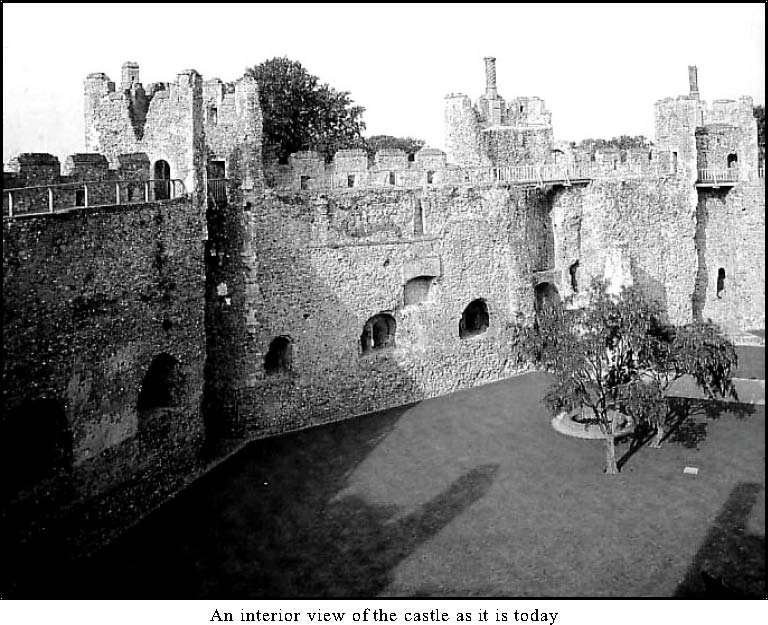
In 1991, Mark Rumble stated:
Framlingham is quite an interesting place as the castle still survives with some buildings in its centre. There is a coat of arms of the De Brotherton’s there I believe also, but just about everybody seems to use the De Brotherton Coat of Arms in one way or another, amalgamated with other parts. Still, I did find out one other thing interesting about Framlingham.
A reconstruction illustration of the interior of Framlington Castle in the 13th century (note that the castle was totally destroyed in the revolt of 1374, and subsequent castle is a total rebuild. M.R.)
In the 13th and 14th centuries everyday life in the castle was cold and uncomfortable for most of the inhabitants. Furniture was rudimentary, washing and sanitary facilities very basic. Foo d was simple: locally made bread, butter and beer, beef, mutton and pork, chicken and goose, fish from the coast. Vegetables were mainly cabbage - no potatoes yet. Torches and candles gave some artificial light. Warmth came from open fires.
The court of King Edward VI, son of Henry VIII, was full of factions. When he died in 1553 the throne was usurped by sixteen year old Lady Jane Grey, great-granddaughter of Henry VII. She did not want the throne but it was forced on her by what was in effect a military coup. Thirty-six year old Mary, the daughter of Henry VIII and Catherine of Aragon fled from London. She went via Cambridge to Framlingham and stayed at Framlingham castle. A fleet of some five warships, dispatched from London by the Privy Council, made its way to Yarmouth. This fleet was spotted going past Framlingham. Sir John Germy(?) and Edward Bedingfield, two prominent men at the time in the Yarmouth area, persuaded the fleet to defect. Instead of bombarding Framlingham castle, they changed sides and joined forces with Mary. As a direct result, Mary came to the throne as Mary I, or “Bloody Mary.” Lady Jane was queen for only nine days and was subsequently executed. Amongst the prisoners in the Tower of London was John Howard, Duke of Norfolk, who was restored and released by Elizabeth.
The Stoke-by-Nayland church also has a connection with the de Brothertons, the arms of the Brothertons appearing on one of the monuments.
DE BROTHERTON COAT OF ARMS 105
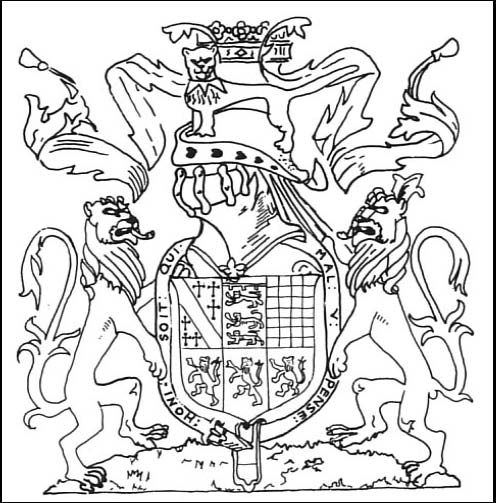
The Arms of Thomas de Brotherton were the three lions passant guardant. These arms are, of course, part of those of the Royal family to date. The Arms were first used by William I - the Conqueror and subsequent to the reign of Edward III, when Arms really came first into organised use. They were amalgamated with the French Arms or flag -the three fleur de luces. Subsequently all sons not in direct line had their own alterations and additions.
Coat of arms of the Howard family c1525, sculptured over the entr ance to F ramlingham C astle
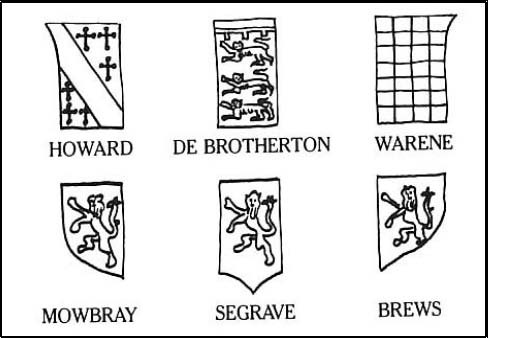 The
De Brotherton coat of arms appears in the ‘quarterings’
of the Howard heraldic shield at Framlington Castle, as shown on the
left.
The
De Brotherton coat of arms appears in the ‘quarterings’
of the Howard heraldic shield at Framlington Castle, as shown on the
left.
In the 1950s Mercy Rumble had
a framed parchment of the de
Brotherton Coat of Arms on her
wall. In 1989 this was in the
possession of Joseph Rumble. Th e ‘qua rter ings’ of the he raldic shield in more detail,
including that of the De Brothertons
Speculating on the origin of the de Brotherton name, Mark Rumble wrote:
I cannot finally decide where the name of Brotherton originated. It may have come from the place where Thomas de Brotherton was born. However, the family must have come over from France at the time of the conquest. Whether de Brotherton was somehow the family name of William the Conqueror and his descendants seems possible, but of course, different sons in the family all had different names, such as John of Gaunt, Thomas of Woodstock, even though they were brothers of the same father and mother. The descent of the Royal family was, however, very complicated and takes some following...
The Rumble Ancestry - Thomas Rumble 12001
As can be seen from the chart on page 90, the earliest member of the Rumble family of whom we have any information is Thomas, the father of Henry Euean Rumble who married Grace Humfrey. On page 106 we present a chart of the descendants of Thomas down to his grandchildren.
Thomas was probably born in 1791 in London and both trained and practised as an architect. My mother told me that he married twice and had six children by his first wife but that nothing was known about them47. His second marriage, on 5 August 1828, was to Frances Mary de Brotherton.
The Register of St George Hanover Square - Marriages 1824 -37 has the following entry: 5 August 1828: Thomas Rumble and Frances Mary Brotherton
-while his marriage certificate states:
Thomas Rumble and Frances Mary Brotherton both of this Parish were married in this church by banns this fifth day of August in the year 1828 by me ..(?).. Ash Curate. This marriage was solemnised between us Tho Rumble, Frances Mary Brotherton In the presence of Giles Makepeace and John Geo Leigh.
Thomas had many children by his second marriage. Those known included Henry Euean (who married Grace Humfrey), a twin of Henry Euean - who died in infancy, John, Jane, Thomas and Louisa48.
In 1990, Brenda Rohl49, researching in London stated that she found the children of Thomas and Frances Mary from the I.G.I. Unfortunately she could not be certain that Thomas himself was listed
“as it is a rather common name (especially in Middlesex, London, where the Census tells us he was born) and he could have been baptised anytime. He also appears to have moved around quite a bit understandable for an architect!”
The English Civil Registration from 1837 Index records his death in the parish of Reading for the March 1856 quarter, reference 2c 221. His death certificate is for the district of Reading, sub-district of St. Lawrence, Reading, in the County of Berkshire. He died on 1 February 1856 at 49 Friar Street, aged 65 years. The cause of death was stated as “diseased kidneys (several years)”.
47 This was confirmed in 1989 by Michael Rumble [16001]
48 My mother stated that there were 19 children, including several twins but details are unknown, so have not been included in the family chart. T here is also some doubt as to whether Louisa belongs to the first or second marriage but, on balance, I have placed her as a child of the second marriage.
49 See page 23 for a family chart showing Brenda [17033]
Thomas was buried in Reading cemetery. In 1991 there was a plain headstone carved in Old London script. At some stage the stone must have broken or fallen over as only half of it was above ground level. Part of the inscription reads:
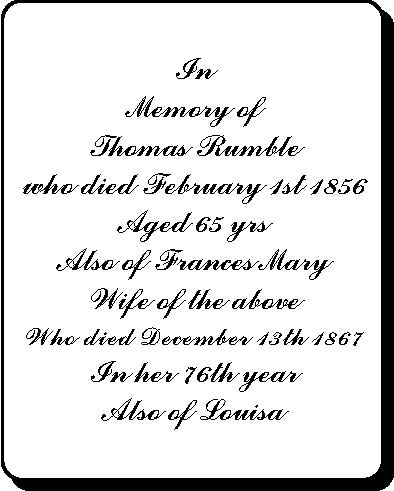
In 1991 Brenda Rohl wrote:
I have been to see the grave of Thomas Rumble. It is almost impossible to find as most of the other graves were not bought, only leased, and so were re-sold and had different people in them than what the plan said. The design of the cemetery is also a mess as the owners were running out of money and spaces, and started to bury people in the aisles! They finally went bankrupt about 1870. I was confident I would find the grave as Reading Cemetery told me Louisa was also buried there in 1877, hence Thomas must have bought the grave site..... “Also of Lou isa” was the lowest I could dig with my hands (to uncover the buried inscription).
In June 1836, when his son Henry Euean was baptised, Thomas was described on the baptismal certificate as
As an architect he was also connected with The Royal Berkshire hospital. For the one-hundred-and-fiftieth anniversary of this hospital, a book, “The Royal Berkshire Hospital 1839 - 1989,” was written by Margaret Railton and Marshall Barr.
Two entries in the book mention Thomas Rumble:
Page 14:
Mr Henry Briant of Reading won a competition for the design of the building with two plans "Spiro" and "Confido." He was awarded fifty pounds and the final design was actually a combination of the two winning plans. Mr Thomas Rumble of Great Marlow was appointed Clerk of Works for a fee of two and a half guineas a week plus 4/6d for lodging to superintend jointly with Mr Briant “the performance of the works”.
In October 1844 it was decided that the enlargement originally contemplated when Mr Briant produced his plans should now be carried out and the two wings at the back would be extended to accommodate a further forty patients. At the same time a Chapel did not provide sufficient funds to enable the whole work to be completed at once. It was decided to build the west wing as the cost of this could be met with the money already raised.
Mr Briant the original Architect was no longer in practice, having decided to take Holy Orders. In 1842 he had written to the hospital expressing a desire to carry out any alterations or extensions but at that stage none were contemplated.
Mr Rumble who had worked on the original building and who had designed and built the Porter’s Lodge at the Redlands Road entrance in 1842, had no difficulty in carrying out the extension in conformity with the original designs and he also produced a plan for the Chapel.
Post Office Directories and Gazettes in the Oxford City Library in 1990 yielded the following information:
1847 - Commercial - Rumble Thomas Architect, 5 Crescent, Queen's Road, Reading 1854 - Comm ercial - Rumble Thomas Architect and Surveyor, 49 Friar Street, Reading (1 of 16 Architects)
Very little is known about Frances. From information obtained in a 1938 letter from Blanche Rumble [14008], my mother wrote:
My Great-grandmother, Frances Mary de Brotherton became engaged, as quite a young girl, to her cousin, John Faithful Fortescue, afterwards Admiral Lord Fortescue. Uncle John has an oil painting of this Earl. But her parents did not approve of cousins marrying, so the engagement was broken off.
In later years she met a very tall, young architect, who was a widower with six children, and she married him. They lived in Reading, England. The first family soon grew up and married, leaving the home free for the new family of nineteen, several twins of which my Grandfather Henry Euean Rumble was the youngest, with a twin sister, who died in infancy.
It is believed that Frances may have been born in London in 1791. Her tombstone states that she died in 1867 at the age of 76 years, but the census records of 7 April 1861 state that she was 68 in 1861. This would put her birth year as 1793.
The census record is as follows:
RG 9, 747, ?. 49 Friar Street, St Lawrence, Reading Frances Mary Rumble, Head, Widow, aged 68; Louisa Rumble, Daughter, unmarried, aged 27; Jane Rumble, daughter, unmarried, aged 25; Elizabeth Cluey, Boarder, Widow, aged 76; Teresa Wakeman, Boarder, unmarried, aged 45; Harriett Marshall, servant, unmarried aged 15; John Curtis, lodger, widower, aged 49, clergyman.]
Frances died on 13 December 1867.
The Children of Thomas and Frances Rumble
The exact date of Jane’s birth is not known but she was baptised at St. Pancras Church, London on 13 November 1829, along with her Brother John and sister Louisa. The June 1841 census gave her age as 12 and the March 1851 census, as 21. The 7 April 1861 census recorded her age as 25; perhaps by this time she had learned to lie about her age! She married Henry Webb, probably in 186550
We know nothing of Louisa or of John other than what is shown in the chart on page 107: On 14 September 1851 John married Ann Blower.
Thomas was born on 26 December 1832 and baptised in Great Marlow New Church on 12 August 1835. His marriage to Lydia Mary Spicer was solemnised in the parish church of St. Martin's in the Field in the county of Middlesex, England, on 10 February 1853.
50 St. C atherine’s House recorded her marr iage in the parish of St. Saviour for the Decem ber 1865 quarter, Ref 1d 20. M y mother said that she had at least one child, Har ry.
On the marriage certificate he is described as an engineer living in Villiers Street51. Lydia’s father, John Spicer, was described by profession as “Smith.”
My mother stated that Thomas had four or five children, both boys and girls, but no details are known. It also appears that he married a second time.
The entry in the index of wills states:
Rumble, Thomas William - The Will of Thomas William Rumble formerly of the Cottage East Hill Wandsworth but late of Hawthorne House Upper-Richmond Road Putney both in the County of Surrey Civil Engineer who died 21 April 1883 at Sunnyside Bonchurch on the Isle of Wight was proved at the Principal Registry by Elizabeth Rumble Widow the Relict and Emily Beatrice Rumble spinster daughter both of Hawthorne House aforesaid two of the executors.
His Will52 refers to his wife as “Elizabeth Rumble,” whereas his 1853 marriage certificate names his wife as Lydia Mary. Thus, it appears that he married twice. His Will also mentions a daughter “Emily Beatrice Rumble” but it is not known whether this is a child by the first or second marriage. The Will implies other children, but they are not named.
The International Genealogy Index lists a marriage between Thomas William Rumble and Sarah Elizabeth Hoare on 2 April 1877, Bethnall Green. We assume that Sarah Elizabeth was referred to in his Will as “Elizabeth”.
At long last we arrive at my great-grandfather Henry Euean, who was born at Great Marlow, England on 9 September 1834 and baptised on 9 June 1835. The baptismal certificate stated that his was the first baptism performed in the Great Marlow New Church. At that time, you will recall, his father, Thomas, was the Surveyor of Works at the church. The baptismal ceremony was celebrated by Rev. Thos. Tracy Coxwell.
Like his father, Henry became an architect and surveyor and, at the age of twenty-six, on 11 October 1860, married Grace Martha Humfrey, who was aged twenty-one. They were married at the local parish church of the Humfrey family at Hagbourne in Berkshire53.
51
Villiers Street runs alongside Charing Cr oss station, central London.
52 There is an im plicit assu mp tion that the W ill obtaine d for Thom as W illiam R um ble refers to the sam e per son as in the m arriag e cer tificate for Lydia Spicer. The pr ofession of “ Civil En ginee r” is cor rect.
53
The m arriage was recorded in the parish of W allingford for the December 1860 quarter,
2c 67 1.
The census records of 7 April 1861 state:
RG 9, 721, 11, page 15: Speen, Berkshire Henry E Rumble, Head, Married, age 26, Architect & Surveyor; Grace Rumble, Wife, Married,Age 22; Louisa Harding, unmarried, age 15, House servant.
He obviously was not yet a father, although the first of 11 children, Henry [14005] was born later that year. The others followed in quick succession, their last child, Mercy [14009] being born in 187754.
Henry established himself as an architect in the Reading district - and his name appears in the Post-Office Directories and Gazettes of his day. For example:
|
1863 |
- Reading: |
Commercial - Rumble Henry Euean Architect and Surveyor, 49 Friar Street, Reading |
|
- Newbury : |
Comm ercial, Architect and Surveyor H.E.Rumble Market Place |
|
|
- Speen: |
Gentry, H.E .Rumble Esq Speen Hill |
|
|
1864 |
Comm ercial - No Architect Private - Rumble Mrs., 49 Friar Street, Reading |
|
|
1868 |
Comm ercial - H.E.Rumble Architect, 49 Friar Street Gentry - Mrs. Rumble, 49 Friar Street, Reading |
|
|
1869 |
Comm ercial - No Architect Private - Rumble Mrs.,49 Friar Street, Reading |
|
|
1876 |
No Rumbles |
Frances Baynton [15008]55, his grand-daughter, in a 1990 letter to me, stated:
Henry Euean Rumble was an architect, and very artistic. I have a book of his architectural drawings of houses and churches in the Eastbourne area. The landscapes, trees, etc., that surround these buildings are beautifully drawn. His father and grandfather were also artistic, and it seems to run through several branches of the family.
54 See the chart on page 106 55See page 85 for a chart showing the position of Frances in the family.
Some of his sketches are held in public places. For example, in 1991, the Reading Record Office held plans for extensions and equipment for the British Boys School at Newbury, designed by Henry Euean Rumble in 1860. The designs are colourful, and his signature, lavish.
Mark Rumble emailed me some of Henry Euean’s architectural sketches, and now is the right place to give a few examples:
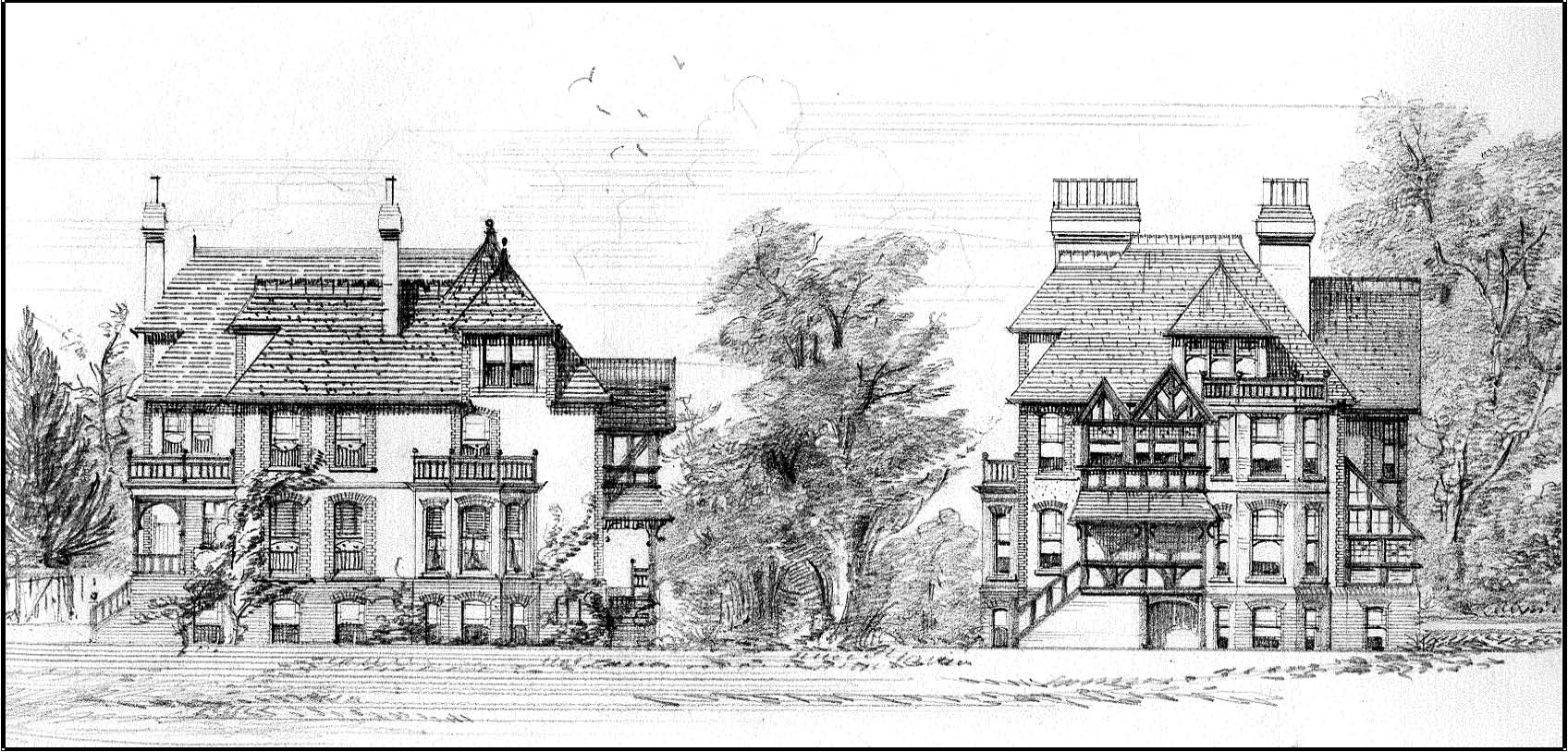
Blackwater Villas

Dorothy Fall believed that Henry became a Quaker and then only designed Churches and other ecclesiastical buildings.
This page shows further examples of his work.
< Heatherbrae private residence
Some examples of his church buildings.
The one on the right is unidentified.
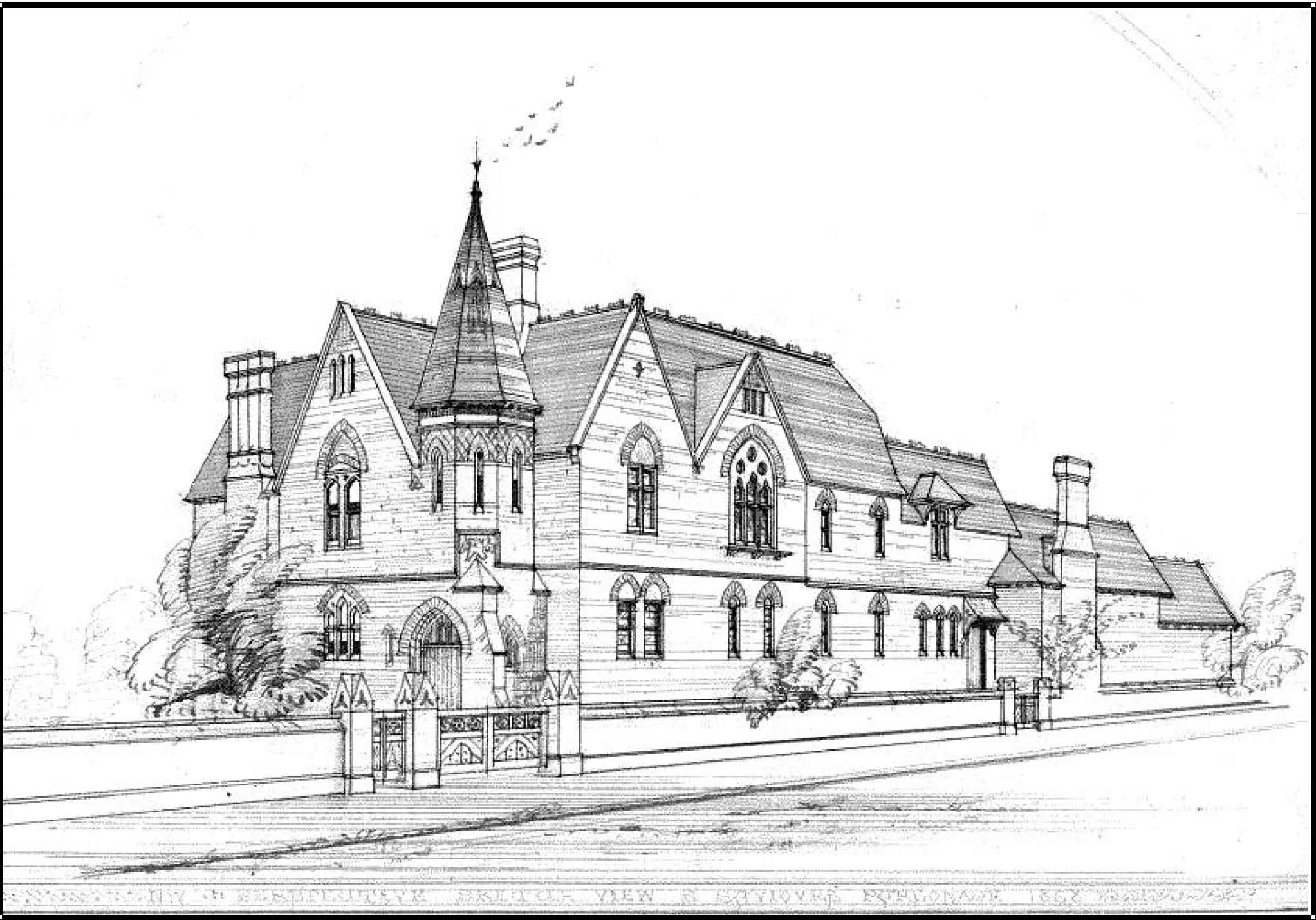
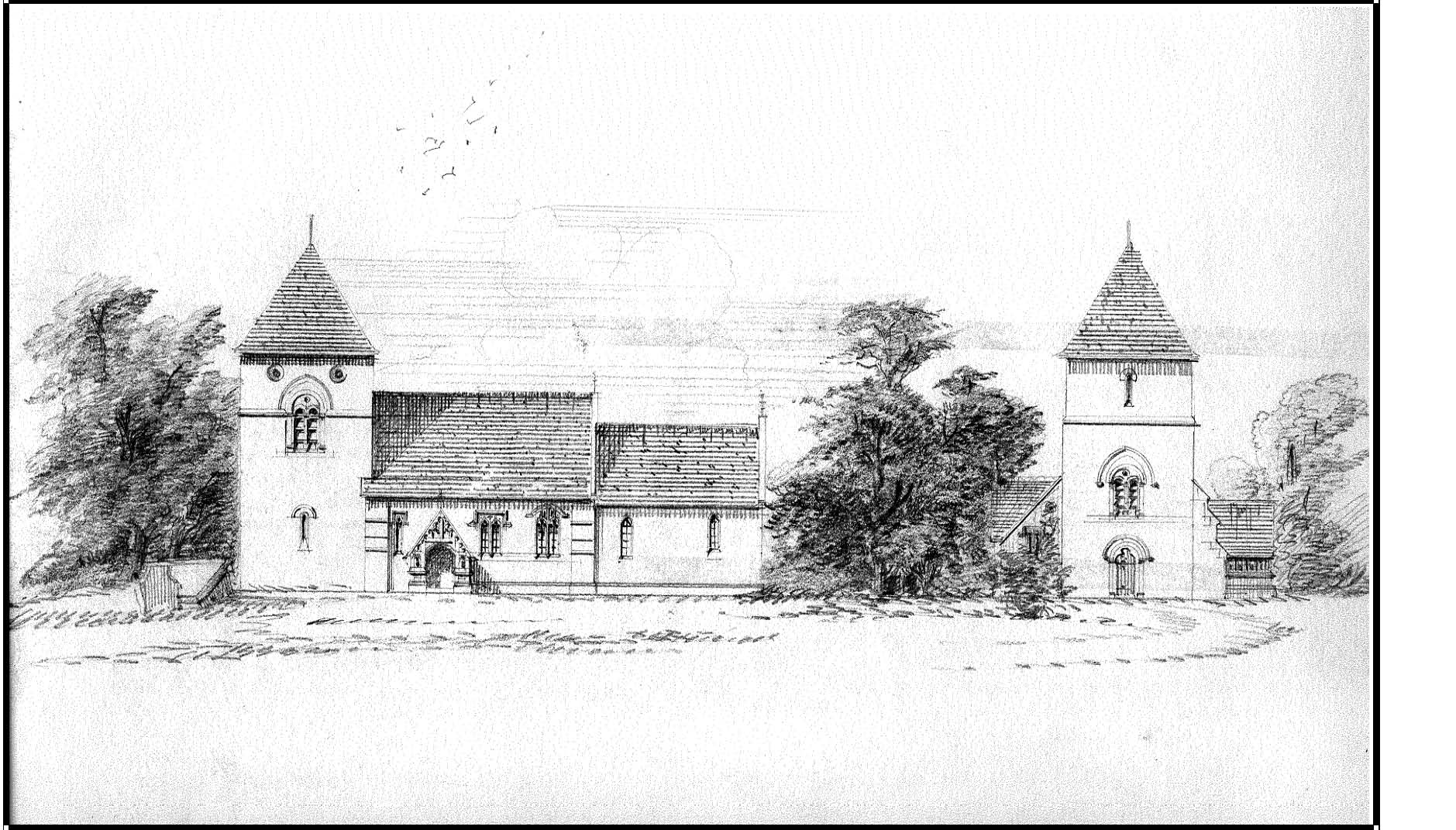 <
Jevington Church
<
Jevington Church
Jevington church with Mark Rumble [16075] >
Jevington is about 6 kilometres north-west from Eastbourne.
A family chart showing Mark Rumble can be found on page 85.
We do not know the full movements of Henry Euean during his life. In the 1860s he was living at Reading but later spent some years at Eastbourne. For a period in the 1880s he lived 27 Hyde Gardens Eastbourne. This would have been the time when his son, Harry Humfrey Rumble, met Kate Knight who was living at 28 Hyde Gardens.
However, when he died on 24 March 1902 at the age of 67, his address was 31 Criffel Avenue, Streatham.
His wife, Grace, had already died in 189456.
Part of his Will reads as follows:
Will of Henry Euean RUMBLE (formerly Surveyor)
.. I give my three said daughters the whole of my furniture plate linen silver and other household effects but not including books and pictures in equal proportion share and share alike. Free of duty I give my dear son Herbert Montague my gold watch and appendages. Free of duty I give my dear daughter Mercy Geraldine the sum of £50. Free of duty I give all my property not hereby specifically disposed of to my executors upon trust to convert into money the same by sale or otherwise and after payment (for) my funeral ... and the legacy of £50 ... to divide the net result between my following beloved children Grace de Brotherton Eueanita Blanche Harry Humfrey Herbert Montague Ernest Duncan Lambert John Euean and Mercy Geraldine all of whom I commend to God and the Word of His Grace and I express a hope that my said children will divide amongst themselves in species my books and pictures without resorting to a sale thereof.
Hy Euean Rumble 8th January 1900
56
See page 100
Probate was granted on 21 April 1902, and reads as follows:
RUMBLE Henry Euean of 31 Criffel Ave, Streatham Hill, Surrey died 24 March 1902 PROBATE London 21 April to Grace de Brotherton Wall (Wife of Robert Wall) and Eueanita Blanche Rumble and Mercy Geraldine Rumble (Spinsters).
Effects £2419 6s 2d.
Before we return to my Grandfather Harry Humfrey Rumble, we will look briefly at Henry Euan’s other children
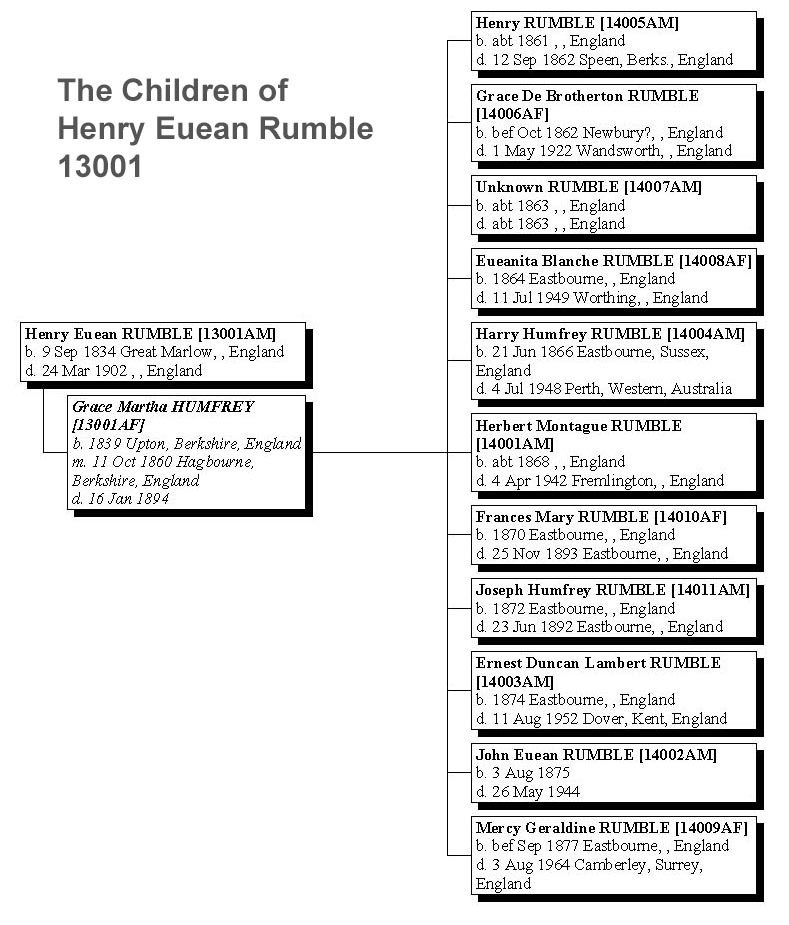
Henry survived for less than a year, and died as an infant on 12 September 1863. Obviously he did not leave a will, but his parents lodged a legal document, or ADMIN, before his death that allows someone (usually a relative) to take the property of a deceased person who had not left a will.
At the age of 37 Grace married Robert William Wall in October 1899. They did not have a family. Robert was a clerk.
Blanche (as she was always known) remained single, training as a nurse at St. Bartholomew’s Hospital, London. She corresponded regularly with both Kate Rumble and Dorothy Fall, and was the source of much of our information about the Rumbles. She was very interested in the family but Frances Baynton (née Rumble) [15008] said that she was sometimes regarded as a trouble maker.
Bertie, as he was known, trained as a mechanical engineer and married Kate Knight’s sister, Mary57. They had 5 children Lottie [15001], Letitia [15002], Mary Dorothy [15003], Montague [15005] and Cyril [15004]. Kate Knight [14004] entered the birth date of each of the five children into a birthday book, and gave it to her youngest daughter Dorothy [15016] when she was twelve years old.
Frances remained single and died at the age of 23 on 25 November 1893. We know nothing about her.
Joseph also remained single. He died from diabetes on 23 June 1892 at Eastbourne at the age of 21. At that time there was no treatment for diabetes. Like his father, he drew well.
John married Gladys Scott on 29 March 1916. They had two children John Faithful Rumble (“Jock”) [15006] and Thomas Euean Rumble (“Tim”) [15007]. John Euean became an engineer with Vickers Armstrong. From 1924 to 1928 he worked in New Zealand.
Mercy remained single and, in the latter part of her life, lived at West Worthing.
57
See the entry for Mar y on page 83
Ernest married Martha Saelens, a Belgian Refugee who was an orphan. When she was about twenty years of age, she became a nanny to the Mayor of Bruges. In 1916, during World War I, she escaped with him and his family to England on the last Mail Steamer to leave Ostend. Michael Rumble [16001] said that she died on 10 January 1939. Kate Rumble [14004] noted in her diary for 17 July 1918 that she “received a letter from Ernest in Folkestone telling us he was going to be married.” The next day Harry Humfrey Rumble “sent his nine illustrated books of celebrated artists by parcel post to Ernest for a wedding present.” Kate, in her 1926 diary gave his address as: Ernest Rumble, Manager, Westminster Bank Ltd., Ware, England. Ernest and Martha had two children, Frances [15008] and Joseph [15009].
In a 1990 letter to John Fall, Frances wrote:
My father Ernest was a magnificent painter equal to many of the great Victorians. It was his hobby only - he would never sell any of his painting - both oil and water colours. When he died my brother and I gave quite a few away to relatives and friends as I just did not have the room to keep them. I lived in a small flat in those days on my own, my mother having died (aged 42) when I was just 19. I wish now that I had been able to keep more of them, as I would have liked to give them to my nephew and nieces ... but, at the age of 19, you don't see so far ahead. It is obviously inherited and Grace, Blanche and Mercy painted quite nicely, and I have some nice drawings done by their brother Joseph who died young from diabetes....
This was confirmed in 1991 by Mark Rumble who wrote:
My grandfather Ernest left a lot of drawings which got destroyed I think when I was about ten years old. We moved house quite a number of times, and they just got left in places rather unsuitable and got ruined. However, there are a lot of his oil and water colours which have survived. Aunty Fra's probably got most of them.
I finish the account of Ernest by reproducing some of his work:
East Cliff, Dover
Goudhurst, not far from Tunbridge Wells
Of these four pictures the first two (pages 118 and 119) are in oils, and the last two (pages 119 and 120) are in pencil.
 Although
he died at the age of 21, Joseph Rumble [14011] was
also a talented artist.
Although
he died at the age of 21, Joseph Rumble [14011] was
also a talented artist.
This is illustrated by the drawings on the bottom half of this page.
As a final offering before I return to the lives of Harry Humfrey Rumble and Kate Rosaline Knight, I reproduce below two photos:
Grace de Brotherton Rumble’s wedding to Robert William Wall in October 1899.
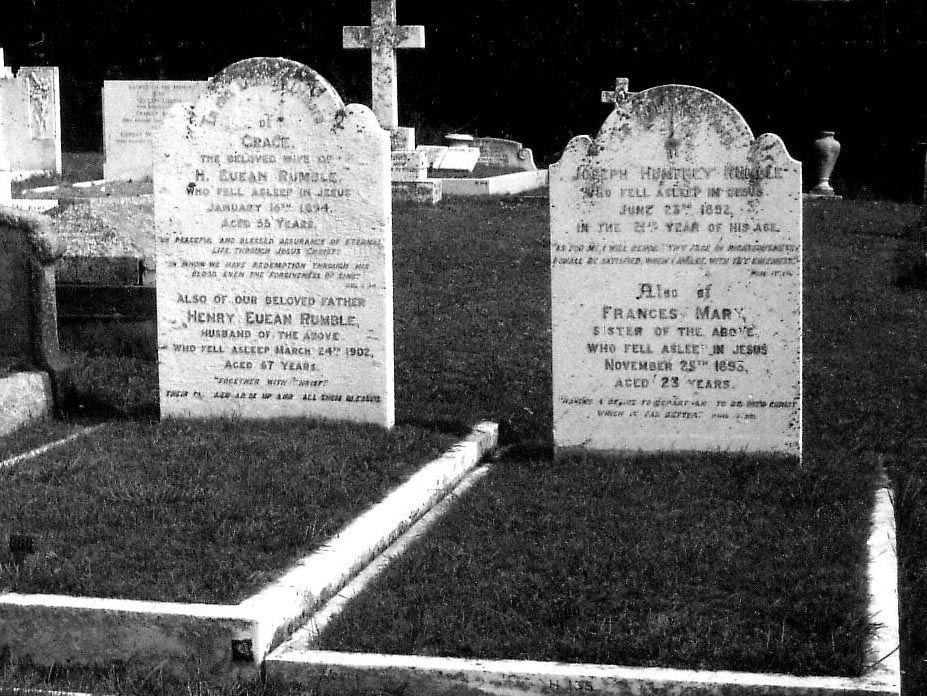
The family graves of Grace and her husband Henry Euean Rumble, and also of Joseph Humfrey Rumble and of Frances Mary Rumble at Ocklynge Cemetery, Eastbourne
We started our account of Harry and Kate on pages 85 - 89 but were then drawn away to study the ancestry of Harry, which included the landed-gentry branch of the Humfreys, the romantic background of the de Brothertons with its association with royalty and Framlingham castle, and with the early Rumbles who were architects. Now we are ready to return to Harry and his life with Kate.
Harry was born on 21 June 1866 at Eastbourne, Sussex, England. We know that in 1881, when he was 14, he lived with his parents at 27 Hyde Gardens in Eastbourne. They were deeply religious people and hoped that he would be drawn to the Anglican ministry - and so directed his early schooling to this end. He gained a profound knowledge of scripture, and of the Greek, Latin and Hebrew languages. But his parents desires were not fulfilled because, following the Rumble disposition, he finally studied and qualified both in civil engineering and architecture. For a period he worked for the London County Council.
While working for them there was a family quarrel, the details of which no one is sure and there are two different accounts, both of which may be partly true. The first concerns Kate’s parents’ disapproval of his change of religion, and the second, a serious quarrel with his younger brother Bertie [14001].
My sister Joan [16020] related the following story as told to her by our mother Dorothy [15016]:
Kate’s parents decided that she should marry Harry Rumble, although at the time she did not particularly like him. However, Kate and Harry eventually fell in love. All seemed well until Harry decided to change his religion and become a member of the Plymouth Brethren. Kate’s parents were horrified, and told her to break off the engagement, forbidding her to marry him. When, at the age of twenty-one, they married despite her parents’ wishes, they threatened to cut her off from all inheritance, and her father refused to have anything to do with her.
We do not know whether this is a true account, but we do know that Kate was estranged from her parents and that finally she had a reconciliation with her father not long before his death.
In 1989 I asked my last surviving uncle, Horace [15010], if he knew anything about the family quarrel, and why his parents had migrated to Australia.
He said:
I don’t know why my Father left England: It was a mystery. In 1916 I visited a Great-Uncle of his. Apparently this uncle had found my father a job in the London County Council. I don’t think he was a Rumble but, when I saw him, he was very old and very funny and he wouldn’t have anything to do with any of the male members of the family.
When he heard that I was the son of Harry Humfrey Rumble - for whom he had found a job - he saw me. You see, Harry Humfrey Rumble left that good job that had been found for him, without telling anyone. Something funny went on and I have never been able to find out why he came to Australia.
I know that there was some family quarrel. I could have asked my Granny, Letitia, when I was in England, but I wouldn’t. I thought that if she wanted to tell me she would volunteer it. In the same way I could have asked my Mother and Father but, if they wanted to tell me, they would have. So I never found out why they came, but there was some family feud because I remember my father’s brother, Bertie, once saying he was coming out to shoot my father - so it must have been a severe family feud.
The first two of Harry and Kate’s children, Horace [15010], and Eric [15011] were born in England at Reading; the next three Leslie [15013], Maude [15012] and Euean Humfrey [15014] were born in Sydney, New South Wales, while the last two, Phyllis [15015] and Dorothy [15016] were born in Western Australia58.
Harry and Kate left Britain at the end of 1891 with their young family of two and, travelling on the "Oonah," landed at Sydney at 11.30 p.m. on 12 February 1892. He then took a job in Sydney.
In 1991, my cousin Jean [16005] recounted the story that she had been told by her father, Horace:
They were very poor when they arrived in Sydney. Granny didn’t know that you had to work to earn money to live. Having come from a family with private means, she thought that you just had money, because that was the way she had been brought up. No one in her family had gone to work from nine to five. Twice her father had taken the entire family, complete with the servants, to New Zealand while he attended to business59. Kate was born in New Zealand on the first of these trips.
My grandparents had nothing when they arrived in Sydney. Grandpa didn’t have a job. They lived in one little room in Balmain, which had an open fireplace, over which they hung a curtain. They used that as a cupboard to store their food. There was a mattress on the floor on which they slept.
58
See the family chart on page 84. There is some uncertainty about the number of children. Seven survived, but daughters Phyllis and Dorothy always maintained that there had been a total of thirteen. Granddaughters Miriamme and Joan discussed this in 1990 and confirmed the number as thirteen. Joan said that one child had fallen down the stairs and been killed. Another had died on the boat coming out from England. Some children, on being born, died, and, being so poor, they had been buried in the garden. John Fall remembers his mother talking of this. Joan said that her mother, D orothy, was the thirteenth child. Nothing is known about those that died. It is possible that some were miscarriages, maybe at an early stage of pregnancy.
59
This may not be true, as I have record of only one period in New Zealand - but there are many gaps in my knowledge of Anthony and Letitia’s travels.
There were four of them initially: Harry, Kate, Horace who was two
and a half, and Eric who was one.
Because Granny came from an affluent home with servants, she was too proud to tell them of the way in which they had lived in Sydney. She wrote home telling them she was doing well, and that they had servants of their own. This, of course, was untrue, as they were living in poverty. Later, when my Dad visited Kate’s mother Letitia in 1916, he told her the truth.
On 1 May 1897 Harry obtained a Government position as a civil engineer in the Public Works Department of Western Australia, and he stayed with them until retirement. They landed in Fremantle at what was known as the “long jetty”. Not long after this, on 18 June 1897, Kate received a letter from her brother Henry St.John Knight [14015]60. This started as follows:
I have just heard from Father of your present abode and address and also of the terrible experiences you encountered on your voyage to Australia presumably, I suppose, from New Zealand.
You must be anxious I know, as so many years have passed since we heard anything of you or you of us, to know the news at home. I feel so sorry that you have kept yourselves outside the family circle for so long but now I have your address and, as I bear no ill-will to either of you, I cannot but write and tell you what news I can remember since November 1889 - the last we saw of you. You must yourselves have had a very trying time but I earnestly hope that you have sought the Lord’s guidance and not passed His love unheeded and that ‘ere long we shall rest in the spirit of love.
Kate was reconciled to her family in 1912. Her diary records:
Friday 19 January, 1912: Long letter from Daddy - wrote a letter of
reconciliation to my sister [Mary].
Several lines in the diary following this were erased. Two days later she wrote a long letter to her mother, Letitia, recording this in her diary, but again erased a line or two that she had first written. Her father died a few months later, on 25 May 1912, although she did not hear of this until she received a letter from her mother on the third of July.
It appears, however, that Harry and his brother Bertie may not have resolved their quarrel for some years. On 28 February 1920, Kate wrote in her diary:
Letter from Blanche and one to Pa61, that Bertie’s affair is settled
amicably at last.
60 See family chart on page 82 61 Blanche = 14008, Pa = Harry H um frey Rum ble
A view of Fremantle in 1890 showing the “short” and “long” jetties
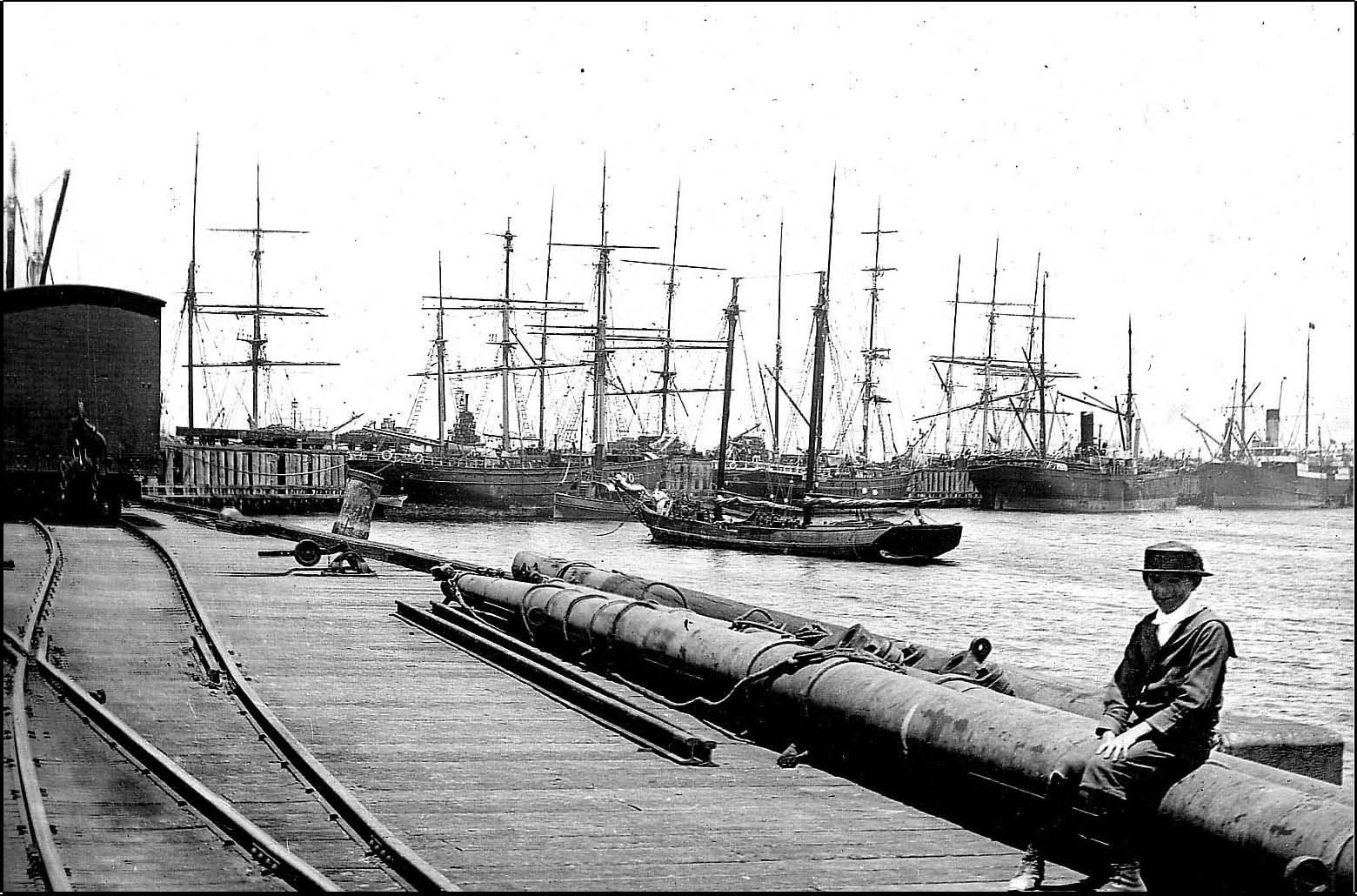 The
“long” jetty at Fremantle, 1898, a year after Harry and
Kate arrived there from Sydney. Note the predominance of sailing
vessels
The
“long” jetty at Fremantle, 1898, a year after Harry and
Kate arrived there from Sydney. Note the predominance of sailing
vessels
Fremantle 1925, corner of Henderson and William Streets. This is where a car park now stands not far from the police station, and fits Horace Rumble’s description of the two-storey building where his parents first lived in 1897. It is possible that this is indeed the building in which they lived
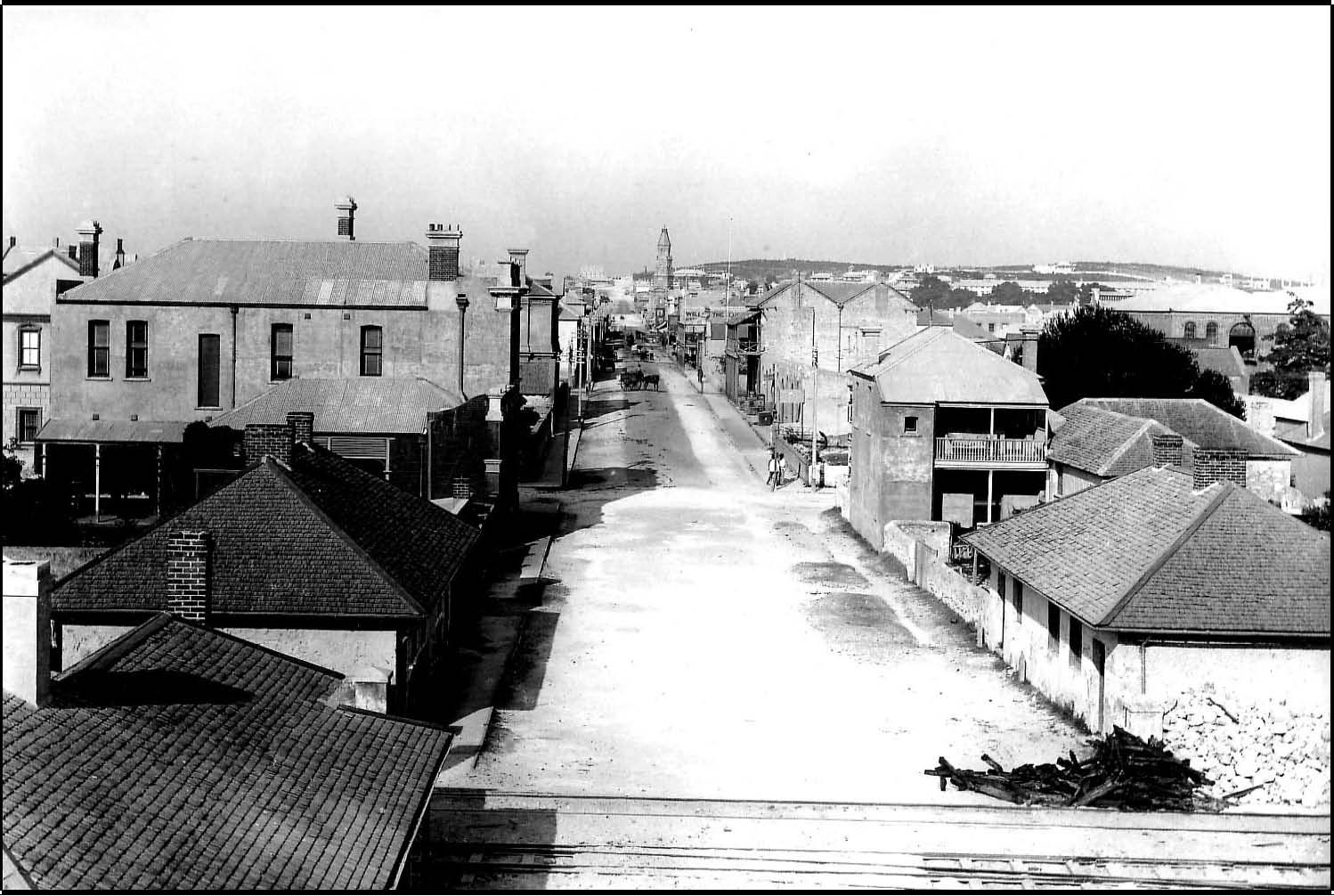
High Street, Fremantle as viewed from the Roundhouse in the mid 1890s.
A view of High street in the same period, looking towards the Roundhouse.
The Fremantle Markets were opened in 1897 - as shown by the sign above the entrance above. This photo was taken in 2005 - when they were still thriving.
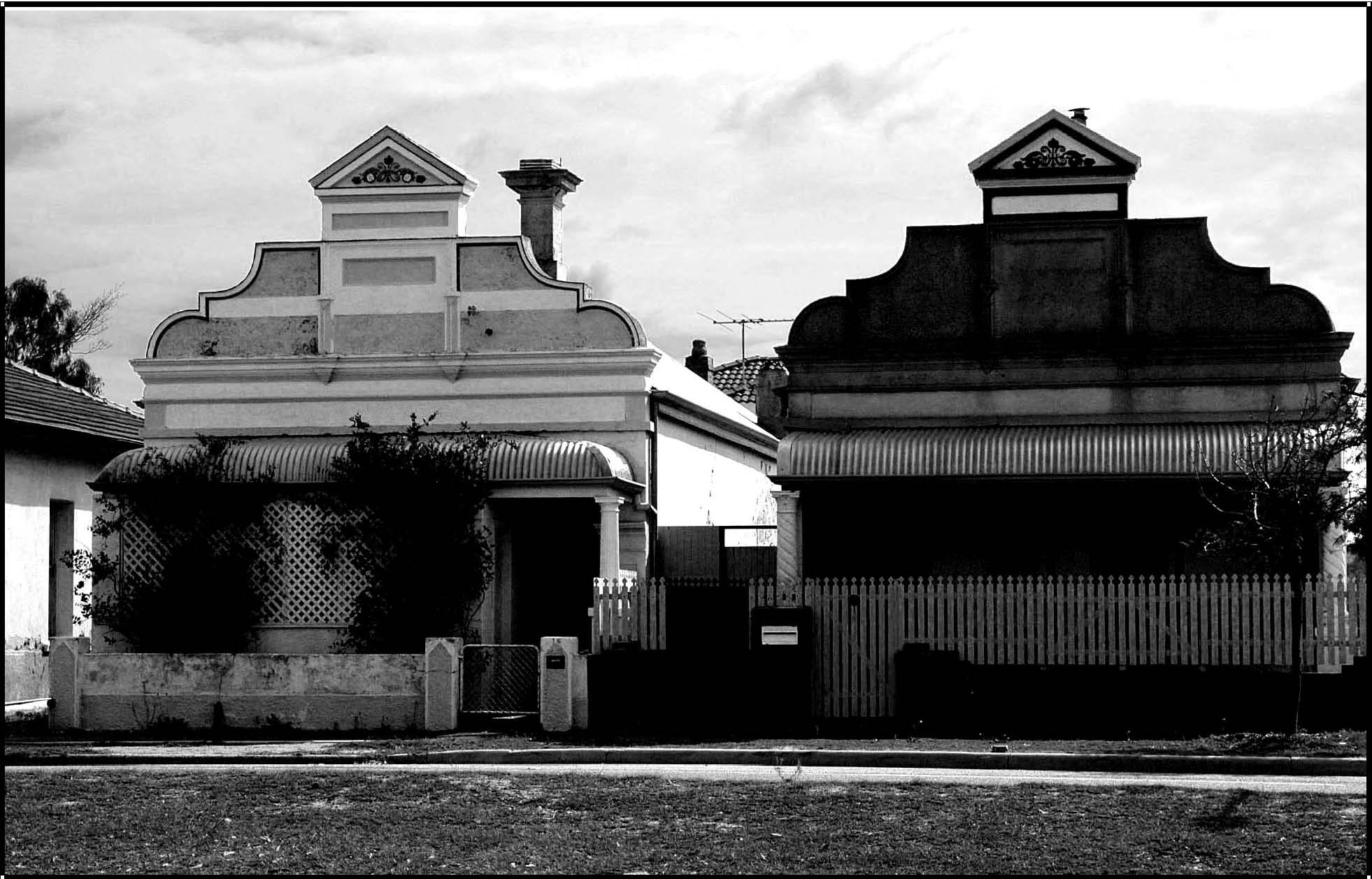
The Rumbles moved from Henderson Street to Marmion Street, Plympton (now East Fremantle). Their house was ‘directly opposite’ the East Fremantle school. In 2005, the two houses on the left were in such a position. Maybe, they lived in one of these.
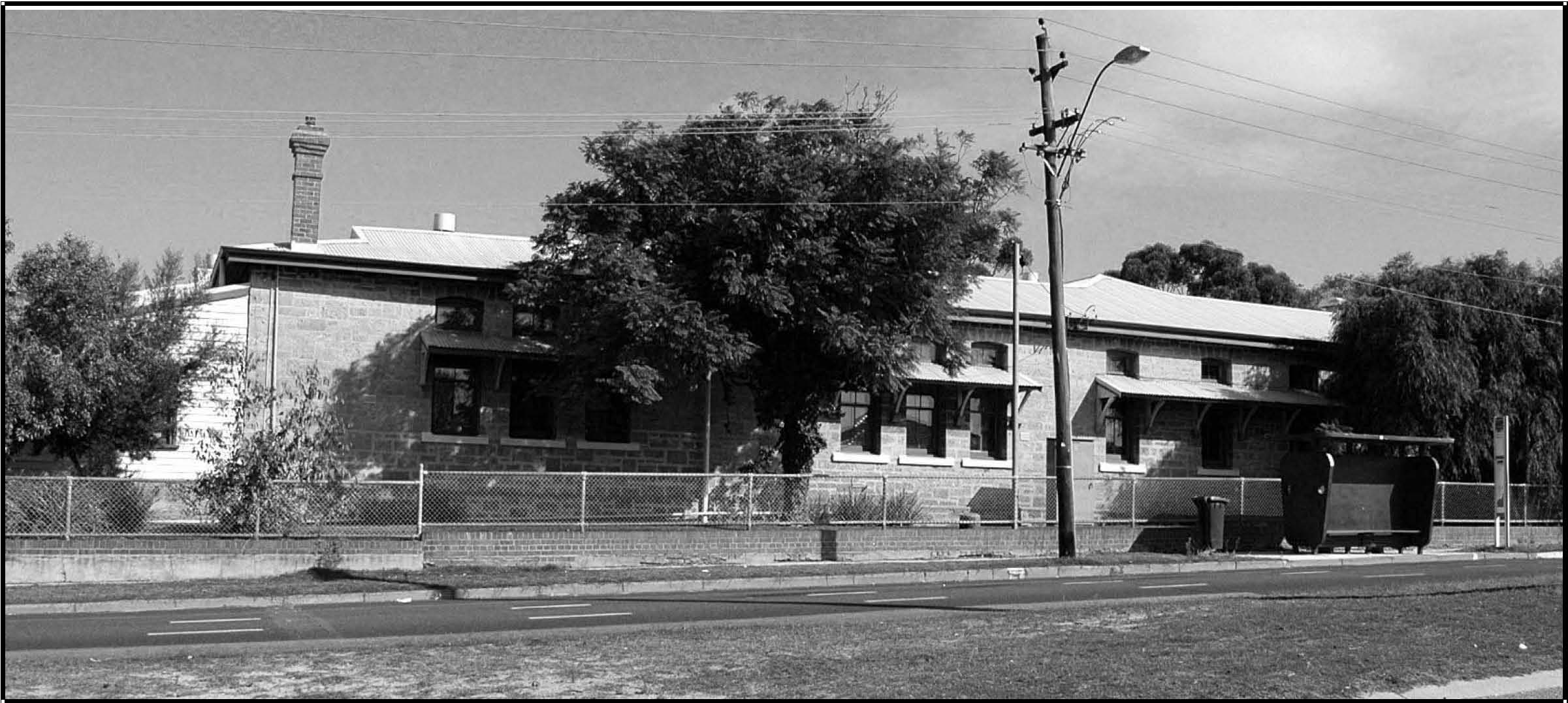
I photographed part of the old school buildings in 2005. It is directly opposite the two old houses above
The above is a view from East Street near Marmion Street in 1900. The Rumble children would have walked down this road to the river.
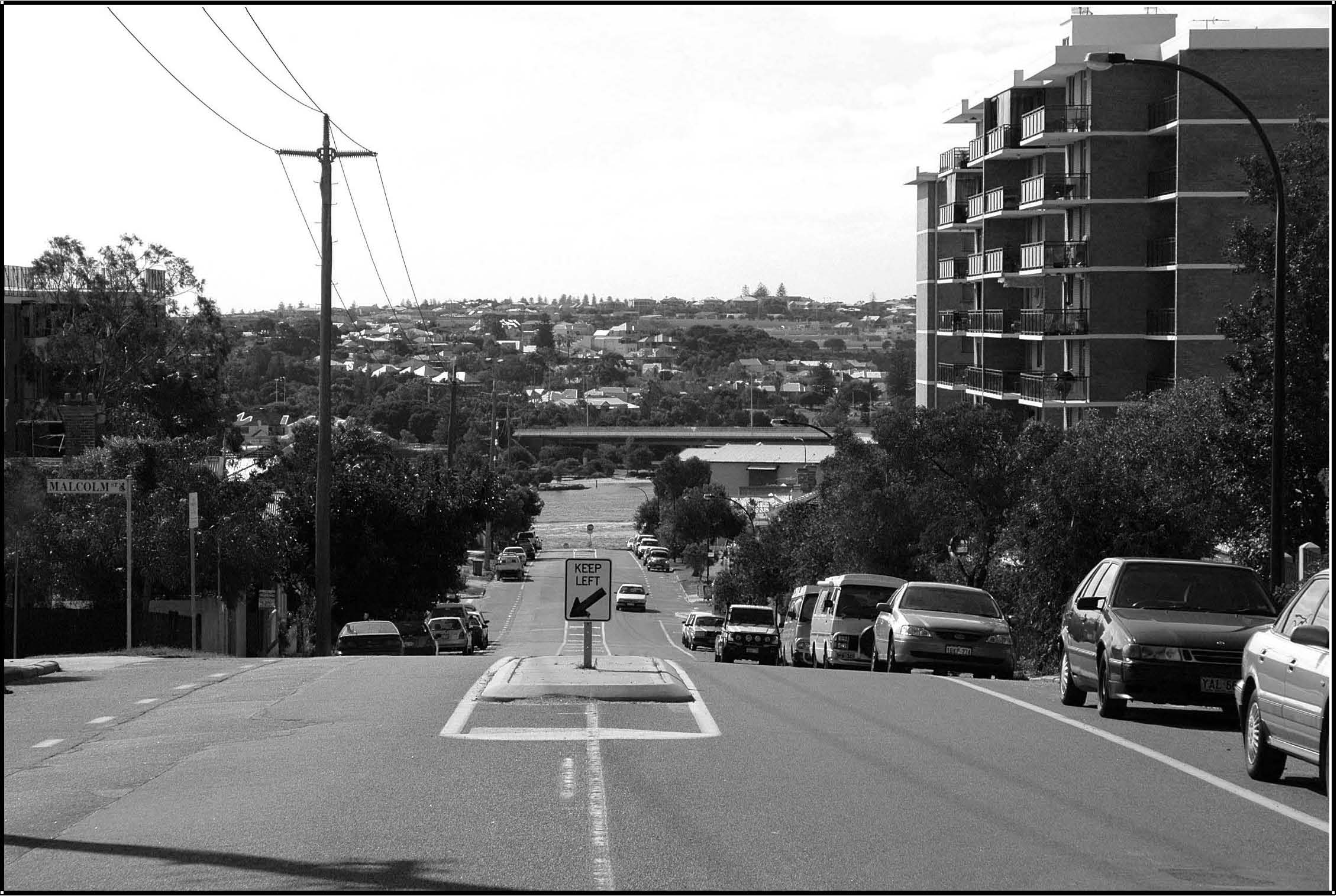
Approximately the same view, looking down East Street to the River but taken in 2005. The expanse of the Swan River can no longer be seen
Harry became interested in photography and above is his own photograph of Fremantle and its harbour in his day.
When I interviewed my uncle Horace in 1989 I asked him about the home in which they lived and his father’s work when they arrived in Fremantle.
Horace recalled:
I remember that we were in a two-storey place in Henderson Street, Fremantle, because on the day we sailed on a yacht to Rottnest at daybreak, when I was ten, we came back with a lot of fish on board. There was a smart sea breeze and she rolled the whole way home. They sat me up on the deck with my right arm around the main stay - and I copped every wave! When I got ashore, the whole place reeled about, and I was still physically reeling about when I tried to go up the stairs to my bedroom. So I remember the Henderson Street House. Today there is a parking lot near the police station. That’s where it was. There were four, two-story houses just there. We lived in the second one from the left.
Horace continued to reminisce:
When we lived at Henderson Street I went to Fremantle Boys School, but then, when we moved to Marmion Street, Plympton, I went to the East Fremantle School, which was just opposite our house. At about that time I stayed home from school for a whole year. My mother became ill and my father kept me home to help my mother do all the domestic work. I was about ten years old at the time; Dorothy and Phyl were both born at Marmion Street and I used to wheel them about in their prams, and I did their washing.
Before my father left Fremantle he built the second half of the North mole. He brought granite down from Mundaring, or somewhere. The two moles were originally made of sandstone - not worth a damn - and he opened up a big quarry at Darlington and brought down these big lumps of granite. He put a railway line up to the quarry - and later he did the same thing at Bunbury when he put a railway line out to the quarry at Roelands.
The above studio photo of the family was taken early in 1901. It shows, from left to right, Leslie (9), Harry (35), Phyllis (<2 - on Harry’s knee), Horace (12), Eric (10), Maude (7), Kate (35), Dorothy (<1 - on Kate’s knee) & Humfrey (5)
While Harry was in Fremantle he worked under the chief engineer C. Y. O’Connor on the closing stages of the construction of the Fremantle Harbour.
When Harry finished work in Fremantle he was transferred to Perth and worked in the old Barracks building at the top of St. George's Terrace. Many years later, when the Mitchell Freeway was built, the Barracks building was demolished, and only the arch now remains.
WORKING AT THE BARRACKS IN PERTH 131
The Barracks Arch in 2005 - all that is left of the original building
I remember the old Barracks which occupied a commanding position at the western end of St. George’s Terrace in Perth. Unfortunately the two extensive wings on either side of the central arch - shown above - were demolished in 1966 for the construction of the Mitchell Freeway. At the time there was intense public controversy over its demolition as many considered it part of our national heritage. But ‘progress’ prevailed, the freeway was built, and only the archway now remains.
The archway was part of the Pensioners’ Barracks - one of the brick buildings characteristic of Perth in the second half of the nineteenth century. It was built 1863-66 jointly by the British Imperial Establishment and the Public Works Department of the West Australian Colonial Government. The original design was by Capt. E. M. Grain and James Manning. The detail was developed in the course of construction by Richard Roach Jewell who also designed later additions.
The building originally housed soldiers of the Pensioner Force from which it took its name. In 1904 the Barracks became the headquarters of the Public Works Department and it was from here that the Goldfields Water Supply was planned, C. Y. O’Connor’s office being immediately above the archway. Many other notable public servants carried out their work from here.
Following the demolition of the building, the western elevation of the retained arch was faced to conform with the east facade with original hand made bricks salvaged during demolition.
Harry’s move from Fremantle to 1 Colin Street, West Perth, probably took place in 1904 when the PWD first occupied the Barracks building. Harry took a photo of the house at about that time.
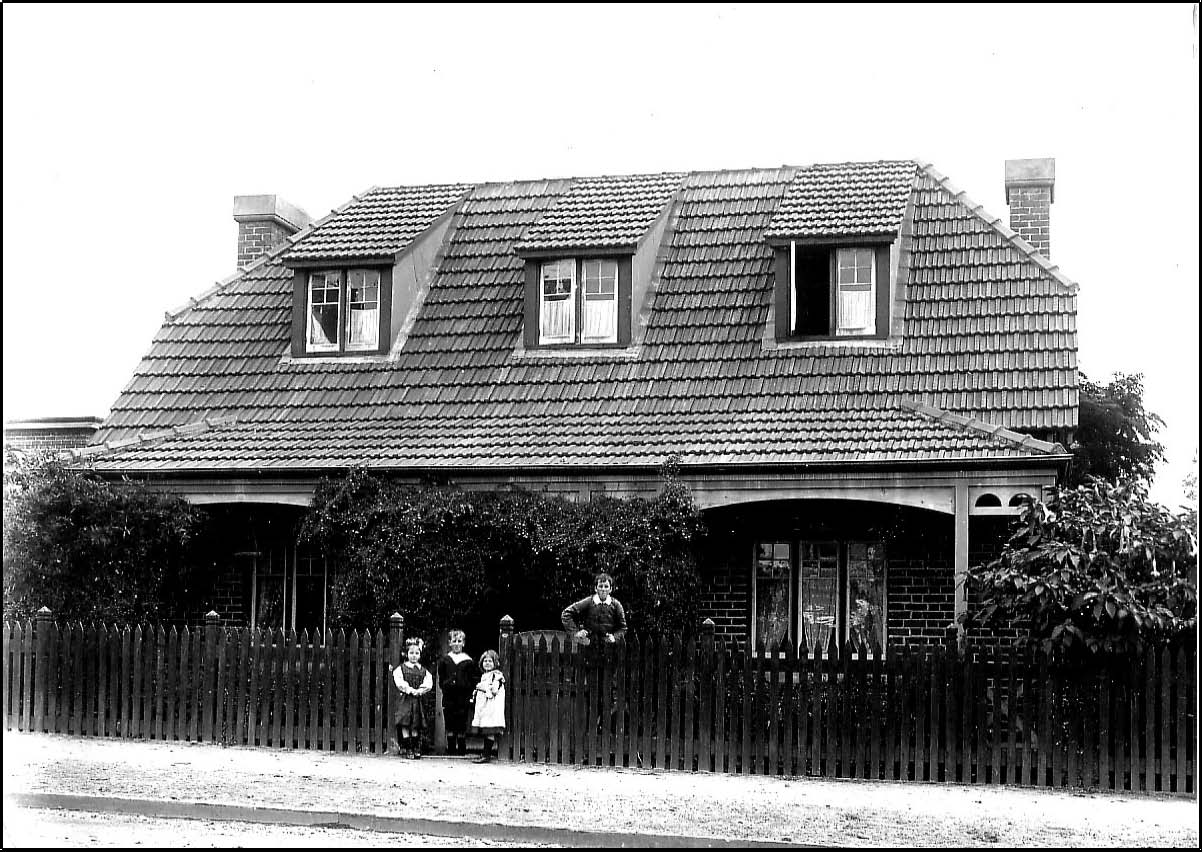
1 Colin Street West Perth with some of Harry & Kate’s children
Th e dr aw ing r oom in 190 5. N ote the studio photo of the fa mily on the wa ll
THE COLIN STREET HOUSE IN 2005 133
While only the arch of the old Barracks building remains, the entire house at 1 Colin Street is still in existence - surrounded now by office buildings. When I took the photos shown below in 2005, it was used by a legal firm.

Number 1, Colin Street in 2005
Harry Rumble had developed an interest in photography, so it is not surprising that some family photos appeared in the Photo Album.
< Kate on the front verandah at her Colin Street home.
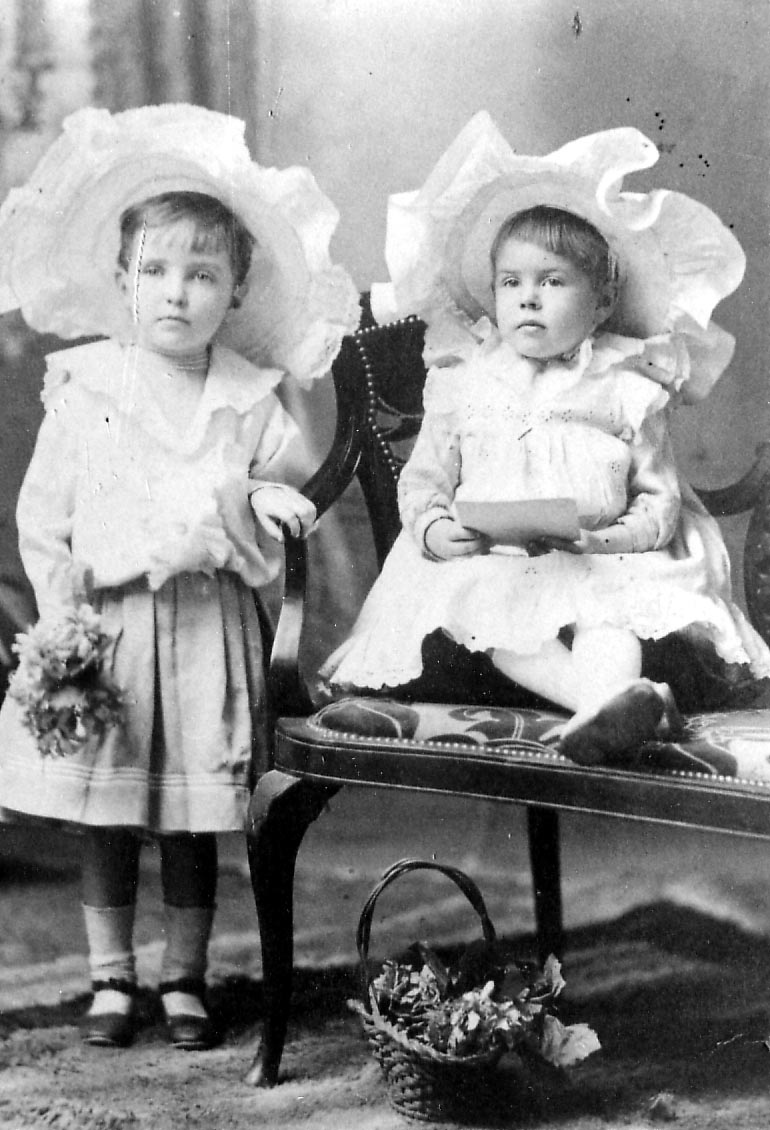 Above,
Phyllis and Dorothy
Above,
Phyllis and Dorothy
dressed in their Sunday best.
< Horace, now aged 15, also on the front verandah at Colin Street.
Leslie (13), E ric (14) & Horace (16) in the garden at Colin Street
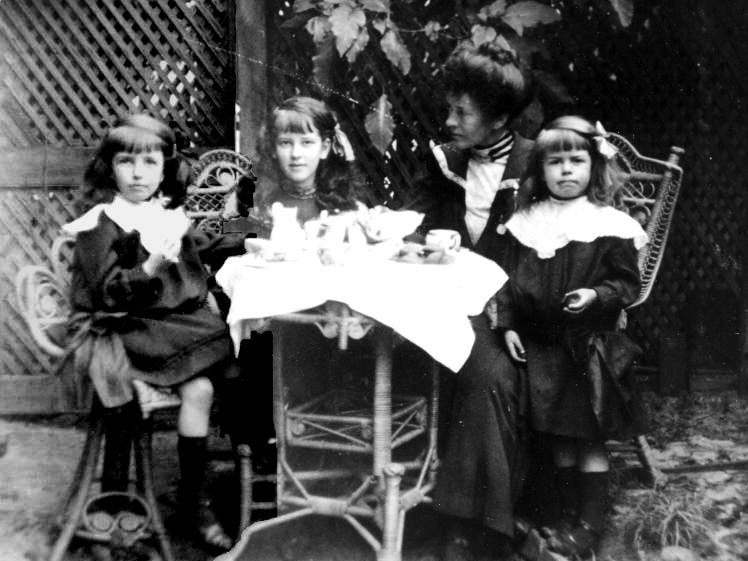 Phyllis
(6), M aude (11), Kate (39) & D orothy (4) in the garden at Colin
Street
Phyllis
(6), M aude (11), Kate (39) & D orothy (4) in the garden at Colin
Street
Harry became a Catholic in 1902. His wife’s diary states that he was received into the Church on 18 January 1902. We do not know what led to this conversion. Kate became a member of the Church shortly afterwards. His youngest daughter, Dorothy, said that her father was always interested in religion and that he changed his religion several times. She recalled that in the early days, being a Victorian father, every time he changed religion, the whole family had to change with him.
He appears to have left the Catholic church from 1914 to 1921 but returned to it on 12 October 1921. Kate's diary shows that during this period, while he was in Bunbury, he belonged to a Masonic Lodge. All his sons drifted away from the Church except Leslie, who became a Catholic priest.
From Colin Street, the family moved to 102 Aberdeen Street, Perth. Kate in her diary for 14 March 1912 has an entry:
Daddy came at a quarter to eight and saw our electric lights on for the
first time.
There is no mention of the form of lighting before this.
On 29 June 1912, Kate wrote in her diary:
Daddy applied today for another billet at £600 a year still under Gov
ernment.
She did not record the outcome of this. During this period, and until 1915, Harry made many short trips into the country, presumably inspecting and supervising work for the Public Works Department. Kate's diary records him visiting such places as Wongan Hills, Kununoppin, Korrelocking, Toodyay, Bolgart, Yilliminning, Corrigin . . . Whenever he went on these trips he sent a telegram or card back to Kate on his arrival, and then sent a letter or postcard to her almost every day.
Kate recorded an occasion when she travelled with Harry to one of his camps:
Thursday 19 February, 1914 Got up at 5.30. dressed, packed and caught the train with Daddy for Toodyay to visit his camp till Saturday. Riley met us with buggy62 & Jack at station, and Dad and I drove 25 miles to Bolgart, reaching camp just as Mr. Young was making afternoon tea. Had dinner at 7 - curried tongues, stewed cherries and blancmange. Sat in tent door for evening.
Friday 20 Camp bed lovely - tea brought at 6.30 - breakfast at 8, eggs & boiled bacon. Sat in tent till 11 a.m. cup of tea, then dressed and drove 25 miles back to Toodyay hotel. Had tea there and slept the night.
Saturday 21 Got up at 5.30. Cup of tea at 7 and caught the 7.30 train to Clack-line with Daddy, where he put me into the Albany express for Perth, and I got to our house at a quarter to one. Sent Dad a wire at once. He sent me one from Toodyay and another from Bolgart to say back in camp.
62 Buggy = a two-wheeled horse-drawn carr iage with or without a hood
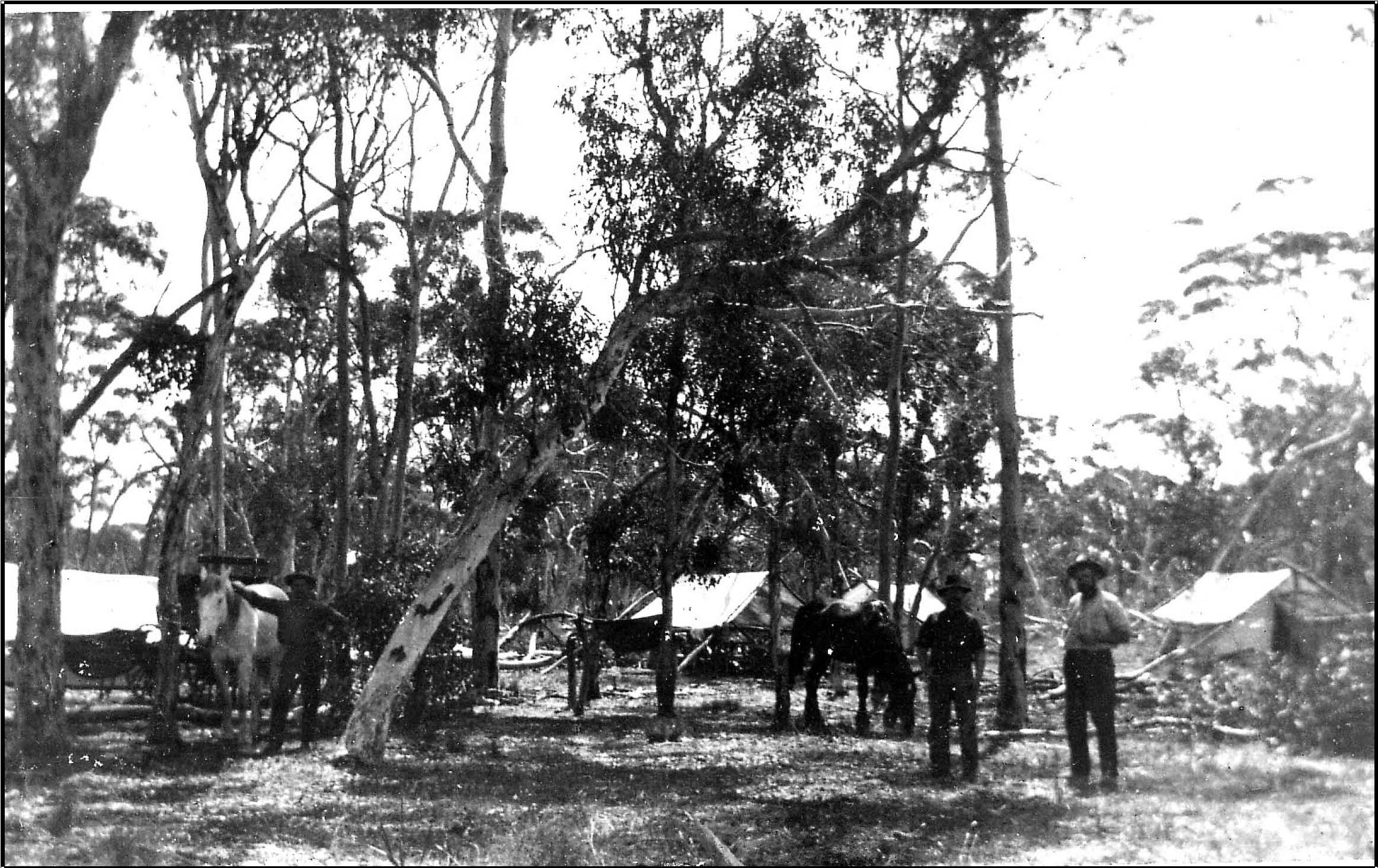 A
bush camp
A
bush camp

< Harry’s bush tent and its surroundings
The interior > of Harry’s tent in the bush
On 24 April 1914 the family moved again, this time to Mr Curlewis's house at 17 Heytesbury Road, Subiaco. Curlewis was the Government Astronomer, and known to the family. Harry continued his interest in photography.
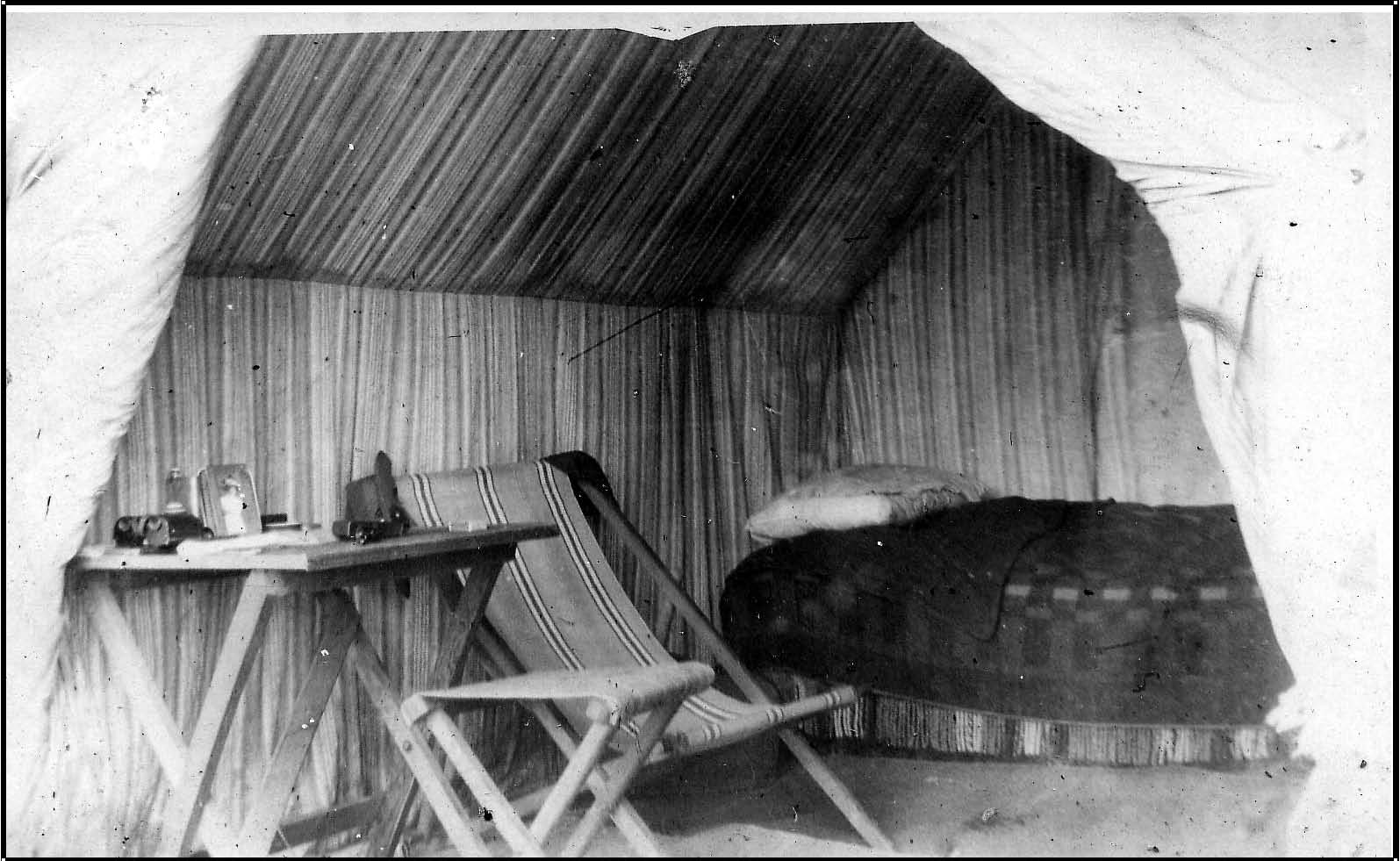 Harry’s
hobby of photographing Perth Buildings
Harry’s
hobby of photographing Perth Buildings
Not only did Harry enjoy taking photos of his family, he also took photos of some of Perth’s buildings in the very early 1900s. A few of these survive, but not all can be identified. I include a selection of these below:
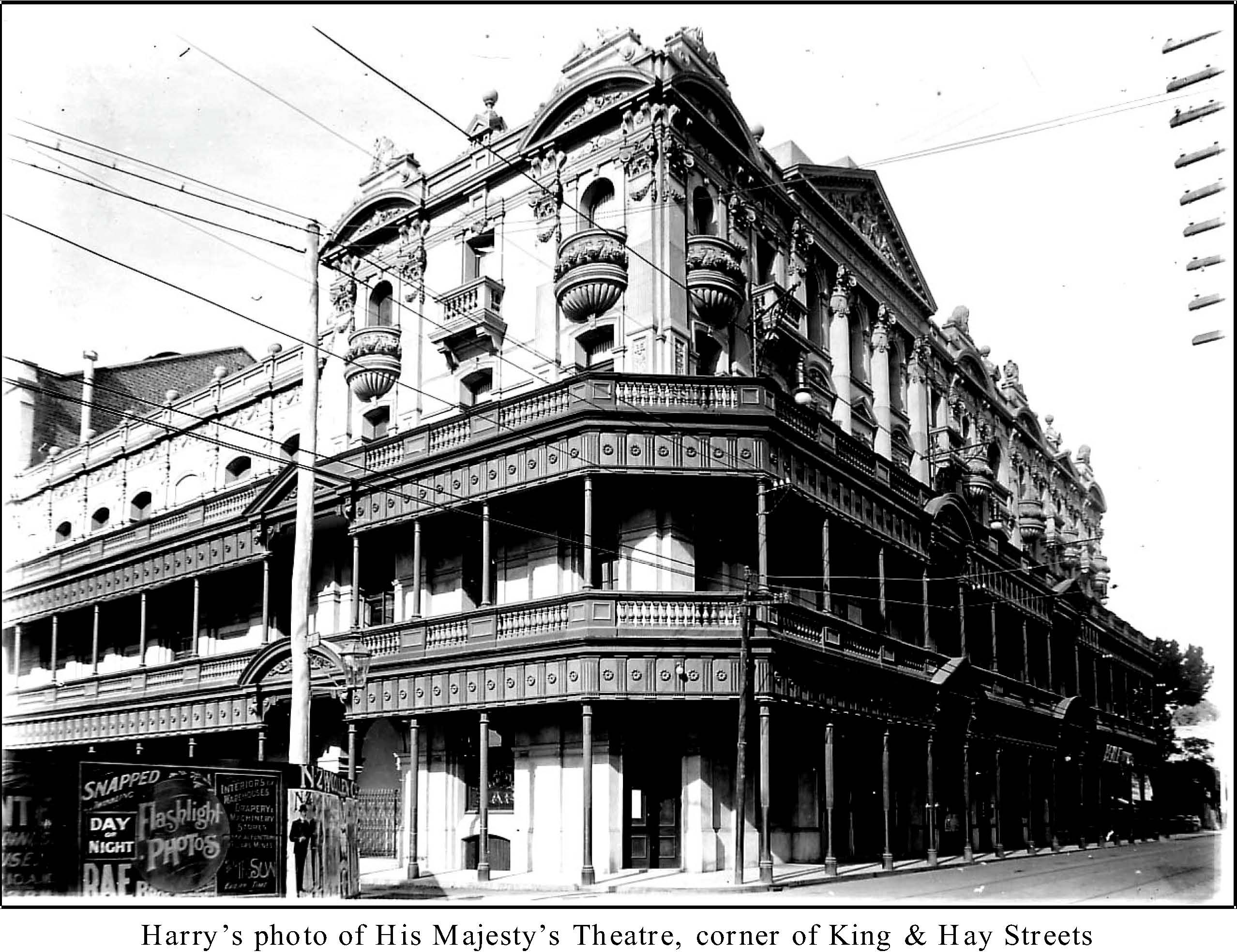
His M ajesty’s Theatre in 2005. Because of the large palm tree the view that Harry took can no longer be obtained
I show above another view of His Majesty’s Theatre that I took in 2005. The old verandahs on the original have gone, but it is unmistakably the same building
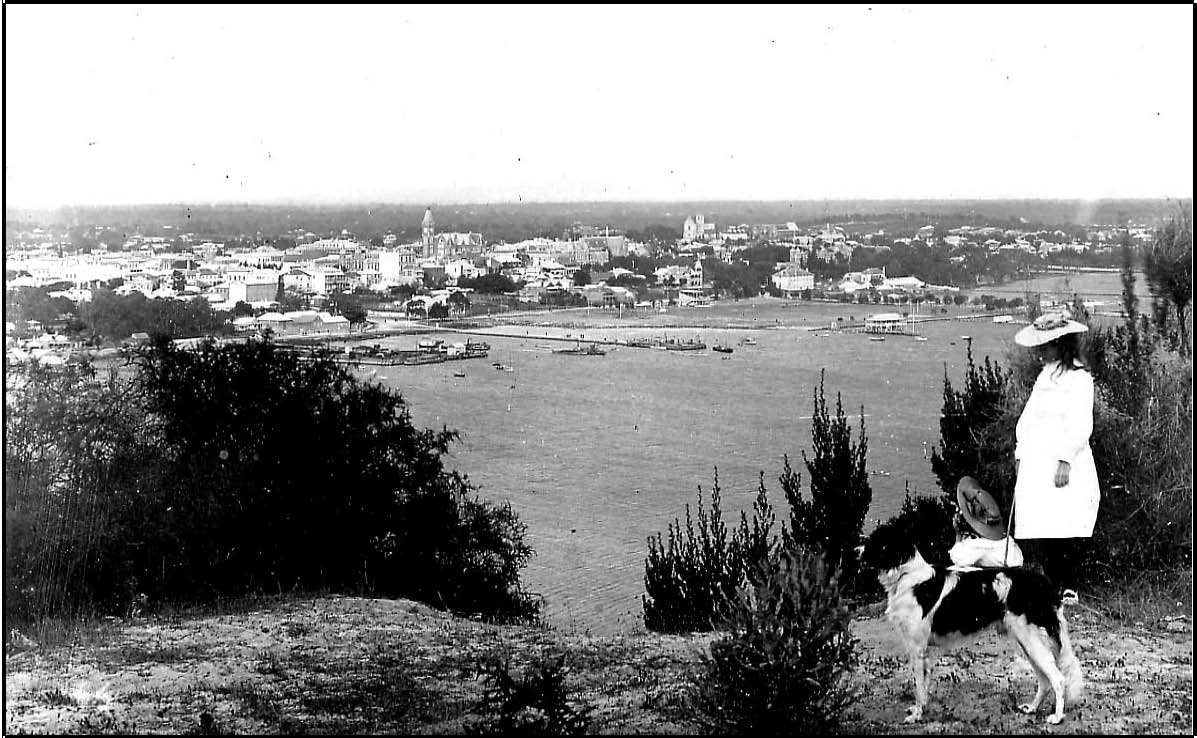
Harry’s photo of Perth from Kings Park - taken in the early 1900s The most prominent building is the town hall.
< Harry’s photo of the Boer War Memorial in Kings Park
The Statue of Queen Victoria in Kings Park >
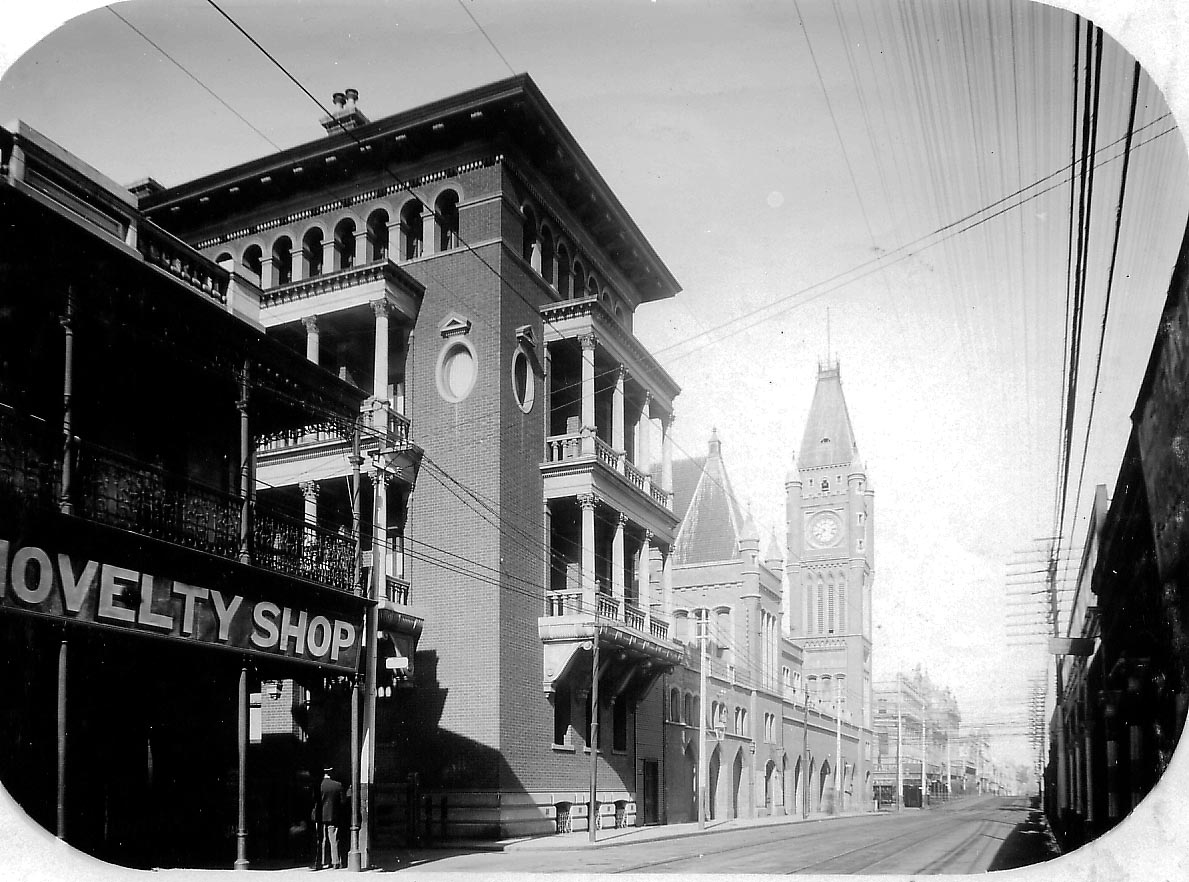
The Town Hall in central Perth

The West Australian Museum and Art Gallery
 <
Trinity Church in St. George’s Terrace
<
Trinity Church in St. George’s Terrace
Forrest Chambers, built 1904 >
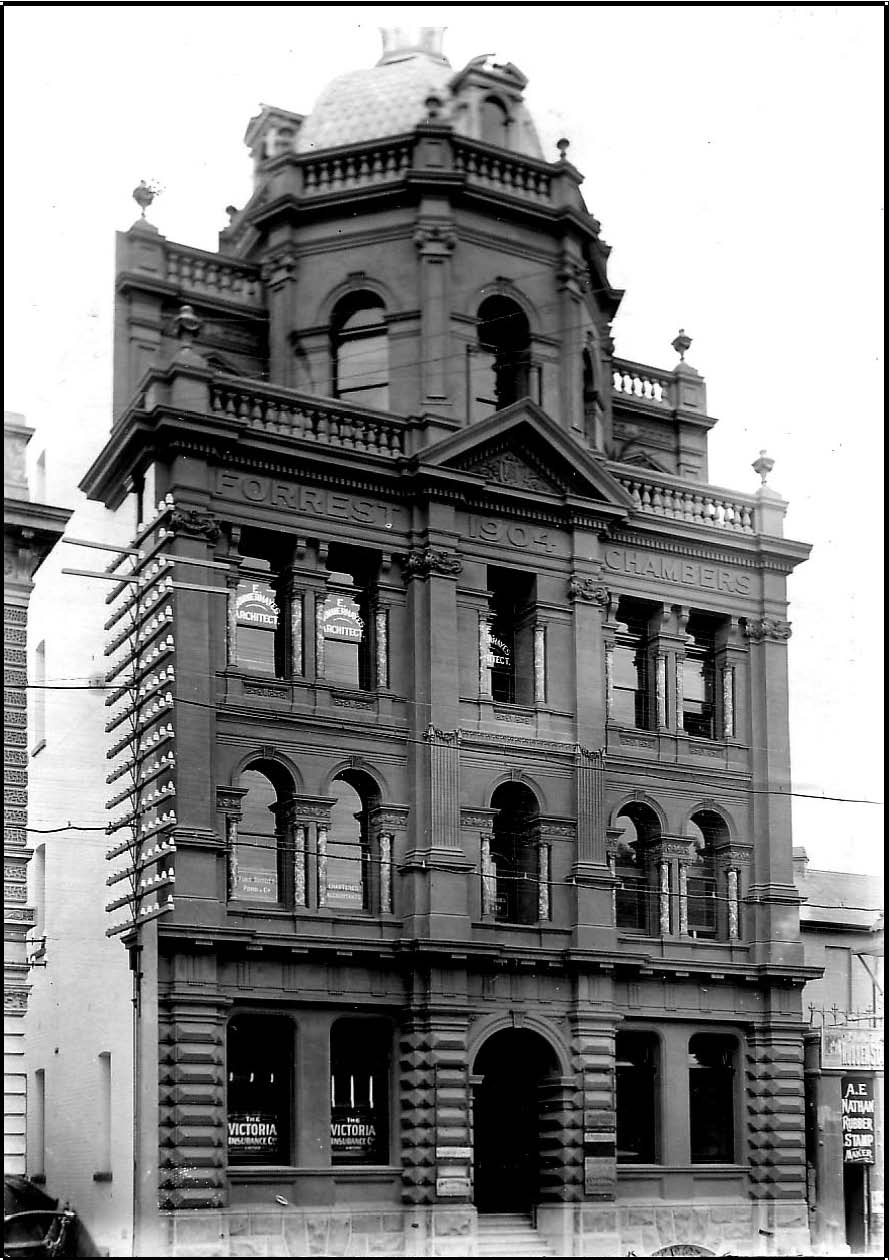

Medical and Health Department
Further examples of Harry’s Photography Queens Gardens
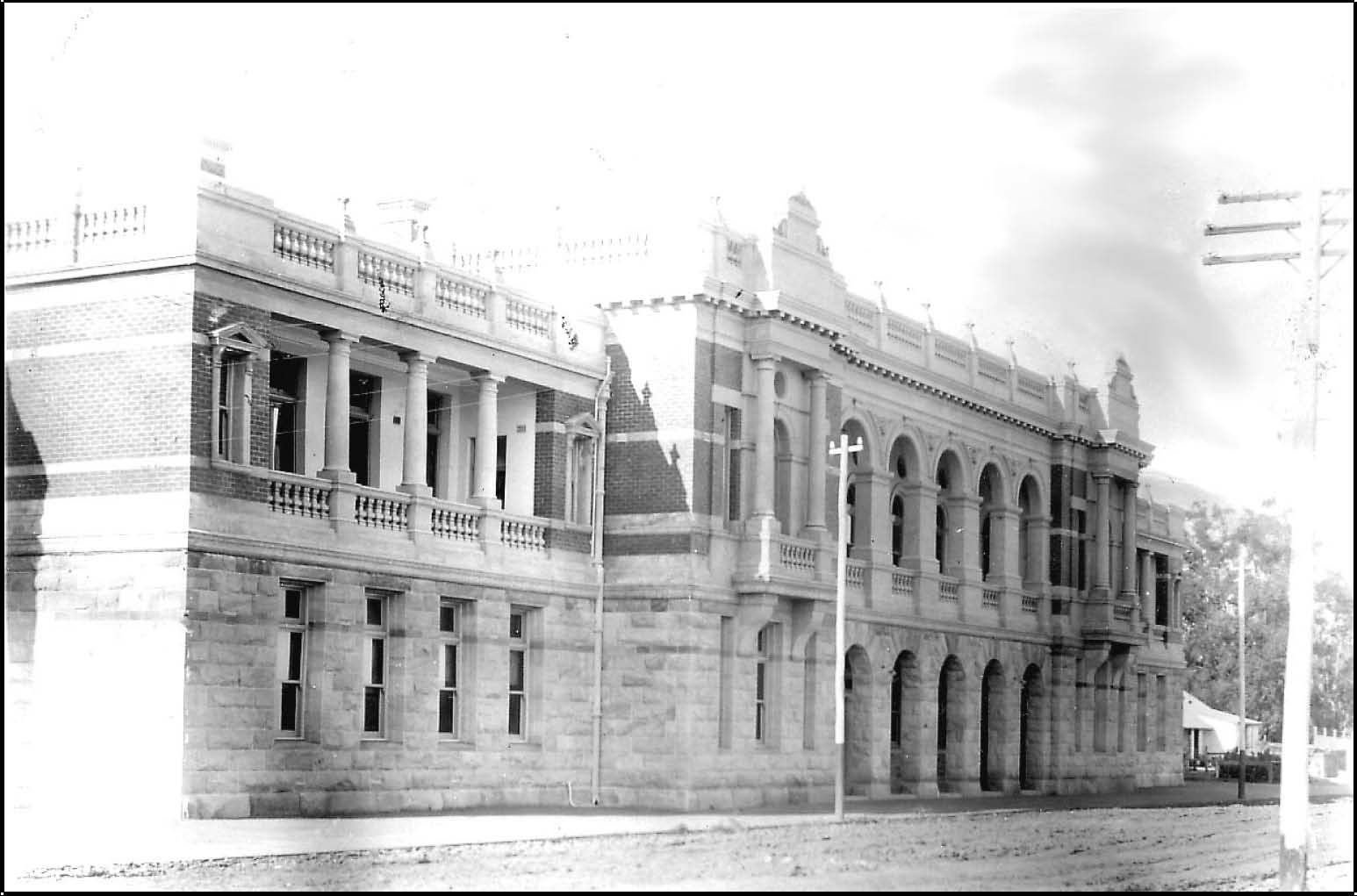
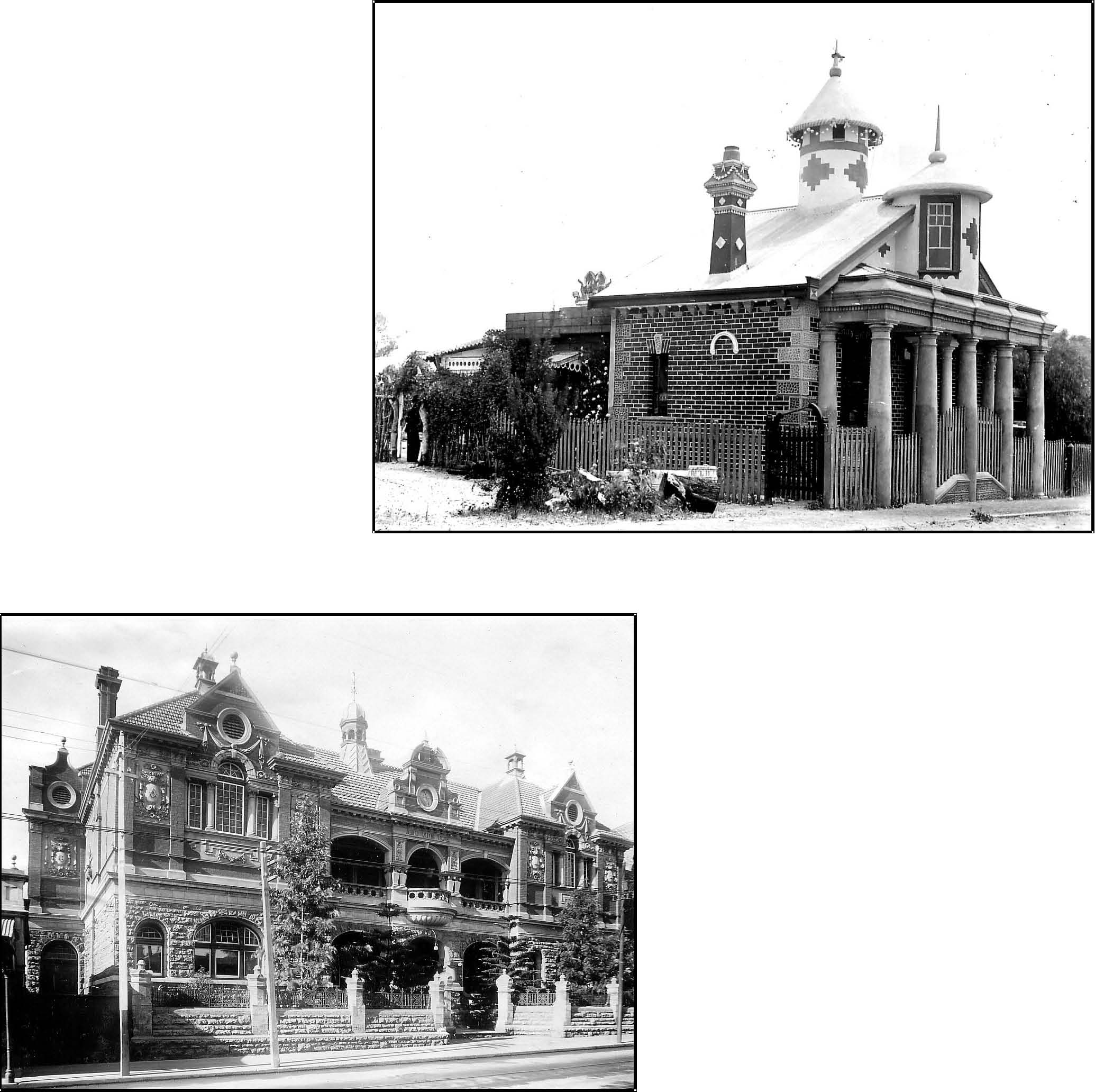
Mundaring Weir - the water supply for the goldfields at Kalgoorlie


< On the back of the original print, Harry wrote:
May 1904 The first photo I ever took. Negative got cracked after three drops of candle grease fell on it
HHR
On the 30 July 1912, Kate and Harry celebrated their silver wedding. Horace placed the following notice in the paper:
RUMBLE - KNIGHT (Silver Wedding). - On July 30, 1887, at Black-heath, London, S.E., Harry Humfrey, eldest son of the late Henry Euean Rumble, of Eastbourne, Sussex, to Kate Rosaline, eldest daughter of the late Anthony Knight, of Vanbrough Terrace, Black-heath. Inserted by their children Horace, Eric, Leslie, Maude, Humfrey, Phyllis and Dorothy, wishing them many happy returns of the day.
Kate wrote in her diary that day:
The whole family came to Mass and Comm union, kneeling together at the rails and immediately on our return home Horace brought me the daily paper, shewing me the advertisement of the Occasion, he had had inserted by all the children. Then breakfast and I opened all my presents, during w hich D oris and Hilda Hedges came in with another present from next door and stayed to see the fun.
from my Daddy 63 gold Mizpah ring, satin eider-down quilt, wedding dress, cake, etc., etc, Horace Silver and cut glass salad bowl and helpers. 1 dozen afternoon teaspoons, S.W. notice in paper. Eric two silver and glass butter dishes Leslie silver thimble in case Maudie a holy card and a lovely seal stole and pretty petti made by herself trimmed with Valenciennes lace and insertion Hum frey a silver "golf-stick" hat pin Phyllis a holy card and silver butter knife Dorothy a holy card and silver butter knife.
63 This refers to her husba nd, Ha rr y H um frey Rum ble
She also received presents from several friends. Her diary entry continued:
After the presents, the boys went to work, but Maudie got the day off to decorate up the dining room. The table was partly finished when Les came home at noon and photoed it, but it was not so good as when finished at 3 o'clock, when Mrs Hedges came in to inspect and admired Maudie's blue ribbons, twisted with asparagus fern from the centre electric light to the four corners of the table, tied with bunches of jonquils and fern. At 5.15 I dressed in all my new bridal array, wearing one red rose Horace brought, and we sat down to the Wedding Breakfast an hour later, at which, by the uproar, all enjoyed themselves immensely.
Later that year Kate received a letter from her mother on 20 November telling her that her nephew Freddie Knight64 had left Britain for New South Wales on the "Orama." Some years later, in 1919, she was to receive a letter from Freddie asking for financial help in setting up a farm.
When Kate’s father, Anthony, died in 1912, he left his entire estate to his wife Letitia. However, on 11 February 1914, Kate received a letter from her brother Henry St.John [15015] enclosing an “Indenture” for her to sign, to provide something for Jennie [14013] out of her father’s Will. Jennie was the wife of her brother Valentine who had died in 1904. Apparently Kate did not approve of this as her diary for 16 February records
Posted letter to Henry returning the ‘Indenture’ with a protest.
Harry caused many problems for his family through excessive drink. Kate and her children suffered through this, but she stood by him always, in spite of the difficulties and sufferings that this caused. Her diary does not record his drinking bouts, but there are several entries such as ‘brought Dad home’, ‘Dad did not come home’, or references to him being ill in bed that may be oblique references to his problems. I will return to this problem later.
Whenever Harry was away on jobs, he corresponded almost daily with Kate and they clearly had a close relationship.
She and Harry played the piano and banjo together. In the evenings they played cribbage or card games - always for a very small wager, and she recorded in her diary who won. Once, her diary stated that they had learnt a new game called "Rummy."
64 Fr ederick 15018
In 1915 Harry became resident engineer at Bunbury, and extended the breakwater there. He left Perth for Bunbury on 10 August 1915, his family following later. Initially the family stayed at Miss McKay’s Boarding house and then, on 9 October 1915, they rented Newton Moore’s63 house on the corner of Moore Street and White Road64 .
When they lived in Bunbury, the life of the family centred around home entertainment, tennis, swimming, fishing, crabbing in the estuary, and boating. They established a wide circle of friends, and Kate held regular ‘At Home’ days. One of the well circulated, amusing stories about Harry was how one day he returned home unexpectedly from his work to find a group of ladies and the local clergyman with Kate at one of her “At Home” days. As he entered the room, Harry observed the clergyman taking a large bite of sponge cake. With his usual sharp wit he remarked: “Ah, Reverend, about your Father’s business as usual, I see.”
Obviously the Rumble’s were considered one of the important families in the town. In June 1917, the Bunbury paper had the following notice:
Mrs Rumble and Miss Maudie Rumble, left Bunbury for Perth today, and Mrs Rumble wishes to intimate to her friends that she will not be "at home" for a month.
Kate made a wide circle of friends, and people were always coming in and out of her house. She was interested in gardening. As the family grew, and left home, they often returned to visit her. Kate kept in very close contact with them, either by letter, or by visiting them. Often on the train she sent packages of “goodies” to her children. Her children, on reflection in later life, considered her a caring, loving, and almost saintly person.
On 26 May 1920 Kate wrote in her diary:
Wet and stormy today - We entertained this evening Captain Pearson and Mr Webster (from the ship “Huntress”), Mrs Forrest and Doris, Mr and Mrs Johnston of Moore Street, and Mr. Phillips - so stormy they stayed here till a quarter to two a.m., when Dad lent the ladies overcoats, boots, hats, etc., and they left their best gowns here!
63 New ton Moor e was State Premier 1906-1910 64 White Road is now known as Stirling Street
Two scenes of quarrying stone from Roelands
FAMILY LIFE - AND WORK AT BUNBURY 149
Kate gave another example of their home entertainment in her diary for Saturday 25 September 1920. That day, Phyllis and Maudie had come down on the train from Perth.
In the evening Captain Pearson, Mr.Webster, Mrs Telford, Mr.Coles
and Doris Bettesworth came for banjo, piano, recitations and some
jazzing to wind up with till 12.30. Bed at 1 a.m.
The S.S. “Huntress” often came into Bunbury harbour, making trips to and from South Africa, and the Rumble family became firm friends with the Captain and officers. Webster eventually became the Captain and, as he played the banjo “beautifully”, became a frequent visitor. Kate referred to him as “Uncle Webster.”
Harry had always hankered after a good telescope. He ordered one from Britain, and it arrived in Bunbury on the 17 July 1921. The next day the Huntress was leaving Bunbury after one of its many visits. The family took out the new telescope to watch the ship steam away.
Part of Harry's work entailed establishing a quarry at Roelands to provide stone for the breakwater. Kate recalled the first "big blast" in her diary for 17 May 1917:
Pa motored to Roelands to meet Chief & Mr Carlin, who brought him
down an oak framed photo picture of his “big Blast”, 1915.
In 1917, the following notice appeared in the local paper:
On Sunday morning the second big blast was carried out successfully at the Roelands Quarry, when over a ton of explosives was discharged, 68ft. from the crest, and over 50ft. behind the face. It is estimated that 30,000 to 40,000 tons of stone were blown down on to the floor. The blast was fired with dynamite fuses about 100ft. long. The explosive this time was in very fissured ground, though it was cemented in as before. This will probably provide enough material for the next six months without further blasting. The Engineer-in-Chief and Mr. Carlin (of the Harbours and Rivers Department) were present and congratulated Mr.H.Rumble, the engineer in charge, on the highly successful issue of the work, which exceeded expectations, as it was feared, owing to the ground being fissured, that much of the force of the explosion would be lost.
A further comment on his work appeared in the paper in July 1917:
When a week ago one of the severest storms which have ever been known in this portion of the State swept over Bunbury, it left the superstructure of the new Bunbury mole a perfect chaos. Railway lines and all the paraphernalia of a great public work were twisted and dismantled. After the storm the spectacle must have been anything but pleasing to the eyes of those entrusted with the undertaking. We are glad to say, however, that the work of making good the damage was tackled with such good heart that the first truck of stone after the storm was tipped today. Such expedition does the Engineer-in-Charge, Mr. Rumble, and those associated with him every credit.
On the 29 and 30 April 1918, Kate recorded in her diary:
Daddy to a conference with the Minister and Chief at the Council Chambers over the Harbour works . . . Dad had a meeting with Minister and Chief at his office at 9.30. He is to be kept on here, have a bonus, also a rise in salary. Girls and myself most disappointed not to go to Perth.
Bunbury Harbour in the early 1900s.
There was another storm that caused damage. On Sunday 22 June 1919, Kate wrote:
We all went in the launch to see the damage done to the end of the
mole in the late storm, viewed Pa’s extension work, then they dropp
ed me at our jetty and went up to Turkey Point, returning for dinner.
Newton Moore’s house in White Road Bunbury which was rented by the Rumble family from 1915 - 1922
By the time they moved to Bunbury, the older boys were working in Perth. Horace was by now 26 years of age, while Maude was 21. She spent some time in Bunbury working at the local hospital, but eventually transferred to the Children’s hospital in Perth. Maude was very talented theatrically, and also drew beautifully. She took part in an amateur theatrical group in Bunbury, called The Rustics. Phyllis and Dorothy lived with their parents in Bunbury.
Family members working in Perth usually came down to Bunbury for Easter and Christmas. Easter, 1916 is a good example. Kate recorded:
Friday: Humfrey arrived a quarter to nine just in time for breakfast. Maudie at dress rehearsal at the “Lyric” in the afternoon. Dad, Humfrey, Phyl, Dolly, and I rowed to mouth of Preston River in afternoon.
Saturday: . . . Dad and I rode round the Ocean Drive at 5 p.m. for the first time on our bikes. At 6 p.m. Horace and the girls did the same. Horace and Vera went to tennis in the afternoon . . . Pa, Humfrey and I played “Bobs.”
Easter Sunday: Horace hired another rowing boat and we all went up (in the two) the Preston River to Glen Iris for a picnic. Dad photoed us all several times. Dolly lost the rowlock of the hired boat, so Holl and Humfrey had to tow it back with Pa and I in with Phyl and Doll, so it was long after dark when we got back.
Boating, Easter 1916: From left to right - on the land, Humfrey. In the first boat: Kate, Dorothy and Phyllis. In the second boat: Horace, Maudie and Vera Glover (who married Horace)

Easter 1916: The “Crocodile” Horace, Vera, Kate, Humfrey, Maudie, Phyllis and Dorothy
It was on Easter Monday evening 1916 that The Rustics - a local amateur group
- gave a concert in the Lyric Theatre and Horace, Humfrey, Vera, Phyl, Dolly, Harry and Kate went along to the 2/6d65 seats with friends Kitty and Frank McAdam.
Kate wrote:
Maudie got on wonderfully, quite one of the stars! We all went to the
station afterwards and saw them off for Perth on the night train.
It was also in 1916 that Harry bought a motorcycle. In her diary for 30 September Kate wrote:
Dad got up at 6 a.m. to see his motorbike, a Triumph, which he
wheeled up last night from the station. Rode four miles today after his
alterations had been made to it by Mr. Clifton.
On 11 November he went out to Waterloo, on the outskirts of Bunbury, inspected, and then bought a second-hand sidecar for £3.10.0d [$7]. Next day he went out at 1.15 a.m. for a moonlight ride on the bike, returning a little after 3
a.m. "All the worse for it", Kate recorded. Kate did not go for a ride in the sidecar until Saturday 24 March 1917, when they rode to Collie bridge and back. In April the sidecar broke down, so Harry sold it. In June he bought another one. Kate recorded:
Saturday 2nd June: Pa and I walked down town in afternoon and had
a peep at my new sidecar, coming home tomorrow . . .
Sunday 3rd: Dad took me for a ride in our new sidecar at 11 a.m. and
again after 4 p.m. to call on the Johnston’s at Leschenault.
Harry was very cautious on his motorbike. Everyone laughed at him because he refused to drive at more than five or, at most, eight miles an hour. Once, the local policeman stopped him for obstructing the traffic. On Saturday 22 June 1918, the following notice appeared in the "South Western Times":
Mr. and Mrs. H.H. Rumble, who are to be complimented on their courage, went through to Perth on a sidecar on Monday and Tuesday. They were incidentally bogged two or three times and had to lever the machine out, and passed through several vivid thunderstorms, which were an experience in themselves; but they were out for a holiday and thoroughly enjoyed the novelty of their experiences.
It all depends on the point of view.
65 2/6d = 2 shillingss and six pence = 25 cents.
Kate’s diary records that they set out at 10 am on the Monday travelling 48 miles to Waroona, putting up at the “Farmers Arms”. On Tuesday they reached Armadale and stayed at the “Olde Narrogin Inn”. Kate wrote:
Dad Banjo'd in evening, also at Waroona, greatly appreciated.
On Wednesday they pushed through to Perth.
The motorcycle was not without its problems. Kate, on 29 September 1918 wrote in her diary:
Hot sunny day, Dad took me for a motor to Dardanup . . . broke down, our second in 3,500 miles, walked to the Johnston's at Leschenault. Worty drove me home in their trap66, towing Dad behind . . . I went to bed after dinner with a bad head.
Finally on Friday 15 October 1920, Dad sold our motorbike and sidecar . . . this morning for £95 cash down.
66 A carriage, especially a light, two-wheeled one
WORLD WAR I - HORACE ENLISTS 155
The 1914 - 1918 war hit most people in the British Empire, Australia included. On August 31, 1914, the following appeared in Australian newspapers:
The response of the Australasian Dominions to the crisis facing the Empire has been swift and unequivocal. On both sides of the Tasman, thousands of men have joined up. The Australian Prime Minister, Joseph Cook, spoke for all when he declared at the start of hostilities: “Our duty is quite clear to gird up our loins and remember that we are Britons”.
The initial outburst of patriotic demonstration and flag-waving has quickly given way to more practical action. No sooner had Australia offered an expeditionary force of 20,000 to Britain, than plans for a second, larger force were being laid. In the days after August 5, mobilisation got quickly under way and Major-General William Bridges was put in charge of the first force. It will consist of one infantry and one light horse division. The Navy was immediately put at the disposition of the British Admiralty and the Army Medical Corps said it was ready to go into action at any time.
Men have rushed to volunteer for service. In New South Wales, for example, more than 1,000 men had signed up within two days. In New Zealand, where there has been compulsory military training since 1912, the reaction has been similar. City councils have set up patriotic funds and women's groups are collecting provisions for the troops’ comfort. More horses are urgently needed, however, and in New Zea-land there is a shortage of suitable arms and equipment.
Kate and Harry’s eldest son Horace quickly volunteered. On 15th May 1916 he entered Belmont and then Blackboy camp and sent his mother in Bunbury
‘his letter case, watch and chain, and links and land title to mind for
him until he returns from the war.’
Promoted to sergeant he left Fremantle by ship on 10th October 1916 to serve in the AIF’s 16th Battalion.
While Horace was overseas, Kate received his pay and banked it for him. In 1916 she and Harry campaigned for the introduction of conscription. On the thirteenth October Harry bought a ‘Union Jack’ flag and hung it on their front verandah to show they favoured conscription. On the sixteenth she attended a meeting on the subject at the Council chambers. The next day they went to the Lyric theatre in the evening to hear Sir John Forrest and Frank Wilson speak for conscription. On the evening of the twenty-sixth they went to an anti-conscript-ion meeting in Bedford Hall. Next day they were at a meeting in the afternoon about the forthcoming referendum. That evening they went to a stormy meeting in the Lyric theatre that was addressed by Mr Thomas, MP and Mr Gardiner. Finally, on Saturday the twenty-eighth, she bicycled to the polling booth and voted “YES” - in favour of conscription.
Unfortunately Horace became a casualty in France, having part of his hand blown away by shrapnel, and became a prisoner of war in Germany. After suffering and recovering from Tetanus, he was exchanged with a German prisoner, and eventually returned to Australia.
In 1998 I completed my autobiography and in the first chapter I told, in narrative form, of the meeting of my parents in Bunbury. I reproduce part of that story below.67 The story starts in 1918, just a few months before Dorothy’s 18th birthday.
‘Mum had had a bad cold but was getting better. On Monday afternoon she had visitors. Mrs Herbert Johnston, Mrs Bell, Mrs and Dulcie Robinson, and Mrs Vershuer all came for afternoon tea. Even when it was not an official "At Home" day, friends were always dropping in. Since Bunbury was a small town, you knew almost everyone in your social circle, and were never short of company or conversation. But Dolly felt at a loose end.
‘Mum,’ she said, when the visitors had gone, ‘Come to the pics with me tonight? There’s a Douglas Fairbanks film on. I'll shout you.’
In the end, Phyl, Cora Gibbs and Mrs Telford from over the road also decided to come along. Together they walked to the Lyric theatre in Victoria Street. The Lyric had many associations for Dolly. When Maudie had been in Bunbury, she had taken part in an amateur theatrical group, the Rustics. They had enjoyed listening to her tell them about the rehearsals, before going to the opening night at the Lyric theatre.
Tonight there was an unexpected crowd. Maybe the double “draw” of Doug Fairbanks in The man from Painted Post together with that heart-throb Vivian Martin in Give Becky a Chance had brought them along. However, half way through the film, the screen suddenly went blank.
A disappointed, impatient murmur rippled through the crowd. A moment later a hastily written message appeared on the screen:
“GERMANY SU RRENDERS!”
It was 9.30 at night on 11th November!
Forgetting Douglas Fairbanks, all interest in the film was lost. Everyone stampeded out into the street. All Bunbury seemed to appear in Victoria Street simultaneously.
67 Fall, John: The Pot of Gold. P rivately published 1998. A ll the ‘facts’ in the excerpt above are factually accurate, being taken from entries in the diaries of Kate and her daughter Dorothy. I have woven a story in fictional form around those facts.
WORLD WAR I - VICTORY CELEBRATIONS 157
One group of youths had found some leftover firecrackers from 5th November Guy Fawkes night, and was letting them off in the crowd. People shouted, linked arms and danced down the street. One or two motor cars - there were not many in Bunbury - were trying to drive through the crowd. They joined in the fun and started honking their horns. Others jumped on the running boards68 for the ride. Kerosene tins69 became instantaneous drums, and there was an air of infectious excitement.
Slowly, calm returned. The crackers had all been expended, and people dispersed to go home and talk about it, far into the night. Soon, sons and husbands would be returning from overseas. Little by little, people wandered back to the Lyric and, when the projectionist thought that most were there, the show continued.
Back home, Mayor Baldock put his mind to victory celebrations.
The next few days saw a flurry of hastily arranged festivities. Early Tuesday morning Dolly and Phyl, with Cora and Selma Gibbs, attended a thanksgiving service in the Council Chamber grounds and then took part in a procession, all the way down to Haywards. Someone had suggested a victory dance for that night, so the girls spent all afternoon helping to get the State school room ready. Dolly’s parents practised their musical pieces and, while the dance was in progress at the school, they played four piano and banjo duets at a Soldiers’ Gift Concert in the Council Chambers.
They all felt a little tired on Wednesday morning, but Phyl, full of energy, went over to the Council chambers in the evening to cut sandwiches for the school treat next day.
It was an exciting week. The Mayor decided that a party was in order for the Captain, officers and young midshipmen from the sailing ship that was in port, to be held on Wednesday the twentieth at the Baldock’s home.
‘Do you know,’ said Mrs Baldock, ‘there are ten young lads on that ship, scarcely out of school?’ She spoke as though she did not approve of such young people going to sea.
‘They say there was a Mutiny on board at Rio de Janeiro and, to make up the crew, the Company shipped these young lads out from London.’
68
In the early days of cars on each side there was a ‘running board’ - on which one stepped before climbing aboard. Perhaps these were used because they stood further off the ground than modern cars.
69 Kerosene, sometimes known as paraffin oil, was widely used in Western Australia for fuelling domestic lamps in the days before electricity was in heavy use, particularly in country towns. It was often supplied in 4 gallon tins.
Her husband had already met Captain Donaldson from the Monk-barns since, while in port, he was staying, not on board, but at the Rose, Bunbury’s best hotel.
‘With all these celebrations, I think it would be nice,’ she said, in her best motherly tone, ‘to give them a good time. They are all probably very homesick, what with the war ending, and everything.’
Phyllis wanted to go to the party. She loved parties and was often the centre of attraction. Already, she knew all the boys in Bunbury. When someone asked her ‘How many boys in Bunbury have you kissed?’, She had replied: ‘It would be easier to ask me how many I haven’t kissed!’
‘There was another reason she wanted to go. When serving drinks at the school children’s treat, she had met a young officer from the ship. Mr Chown was third mate and seemed a very nice person; she would like to meet him again.
‘Pa, can Dolly and I go to the party at the Baldock’s?’ In social matters like this they always had to have approval but, knowing that Pa was sometimes strict, they had approached him together. Dolly remembered the time she had asked for a new hat earlier in the year.
‘Stand up against that wall, girl,’ he had said sharply. ‘I have fed you and clothed you these last seventeen years, and you ask me for a new hat! Show me your old hat.’
Dolly felt like weeping. ‘There's nothing wrong with your hat’ he had declared, on inspection. And that was that!
Both Dolly and Phyl sensed that he was in a bad mood, not inclined to be soft-hearted. It was true that they had already been to a dance and to the pictures and had had an exciting time.
‘You’ve been out enough already.’ They were on losing ground. ‘And I'm not going to have my daughters going out with sailors.’ They thought he was about to add the cliche about sailors having a girl in every port, but he didn’t.
They were bitterly disappointed. Selma and Cora would be going. ‘Can’t you do something Mum,’ they had pleaded, ‘to get him to change his mind?’
Their mother was a resourceful, but gentle, person and she knew her husband well. She had handled worse crises than this. ‘I’ll wait ‘till he’s in a better mood,’ she had said.
By Tuesday they had permission. Mum had a way of doing things, and she always did it so nicely that everyone liked her. Dolly and Phyl went over to Baldock’s to help with cooking and the preparation.
The Captain had a daughter who lived in Melbourne and, because his nine-year-old granddaughter could not remember him, they had come over from Melbourne to see him. They, too, were going to the party.
The party was a great success and everyone enjoyed themselves. By the end of the evening Phyl had made friends with an Alfred Donnithorne, and he brought her home. Dolly was attracted to a young cadet who said he was eighteen; he seemed just what she imagined a polite, quiet, refined young English gentleman would be. Mr Fall had walked home with her.
Next morning the girls, still in their nightdresses, talked about the party. Dolly sat at the end of Phyllis’s bed.
‘How long are they going to be in port?’ Dolly wondered.
‘I was told the other day that they were loading jarrah timber to take back to London and would be here a few weeks yet.’ Phyllis always knew the local gossip. ‘Why don't we ask them to tea on Sunday?’
So Phyllis wrote a letter to Mr Chown asking if he would come to tea, bringing Mr Donnithorne and Mr Fall with him.
And this is how Dolly and Phyllis met Victor Fall and Ted Chown - who were later to become their husbands.
Officers and midshipmen on the Monkbarns, Bunbury, 1918 Victor Fall is third from the right. Captain Donaldson is seated at the front and his grandaughter, from Melbourne, is behind him
The Monkbarns, the three-masted, square rigged sailing ship that called at Bunbury in November 1918 - Pastel drawing by Maude Rumble, 1922
In 1919, Harry was elected a member of the South Western Club, attending his first meeting on 30 August. Kate also records that on 14 November 1919, ‘Pa went to (Masonic) Lodge Banquet and banjo'd in front of the Governor’. But change was afoot, not only in that they would soon be leaving Bunbury, but also in life-style. Kate noted events in her diary such as seeing aircraft, and hearing the radio for the first time.
The first appearance of aircraft in Bunbury caused much excitement. Kate wrote in her diary:
Saturday 24th April, 1920: We saw Major Brearley flying his aero
plane over Bunbury for the first time this morning . . .
Sunday 25th: (Dad) motored me to Leschenault fields in the after
noon to see the aeroplane start and return twice. Great crowds there.
Radio when it was introduced had an immediate impact on society. Although the first transatlantic wireless message was not sent by Marconi until 1901, a wireless station was constructed at Applecross on the southern side of the Swan River at the outskirts of Perth as early as 1912. After World War I, my uncle Horace, returning from Britain to Fremantle by ship in January 1919 wrote in his diary of the 14th of that month:
Our wireless picked up the first messages from Australia today when
we got news from Applecross
And, on Monday 20th :
Sent off two wireless messages in the morning -one to Mother in
Bunbury and the other to Vera in Perth to say that we should arrive in
Fremantle on Wednesday.
Radio was just one of the many technical innovations between 1920 and 1930. The first commercial radio station in Australia, 2SB, opened on 23 November 1923, and radio quickly spread in popularity. On 18 December 1925, after they had returned to Perth and Phyllis had married Ted Chown, Kate wrote in her diary:
Ted came in evening and accompanied Phyl to the Williams’ to hear
their ‘listening in’ set.
On the 29 March 1920, Kate received a letter from her sister-in-law Mary Gerard Knight70 telling her that her mother, Letitia, was very ill and was not expected to live long. Kate immediately wrote back to Mary Gerard.
70 Wife of Frederick Knight [14014] See page 83
Then on the fourth of May 1920 she received a registered letter from Letitia, enclosing a twenty-first-birthday letter and gold chain with diamond and pearl pendant for Phyllis.
Another letter came from Mary Gerard on the twenty-eighth of June to say that Letitia was now expected to be a permanent invalid. On the twelfth of July Kate received a cable from her brother Fred stating that Letitia had died on the ninth. Kate pasted into her diary the death-notice she received:
Knight - On July 9th, Letitia Charlotte, widow of Anthony Knight, of 2 Vanbrugh Terrace, Blackheath, aged 85. An old and respected resident in Blackheath for about 40 years.
Kate received a copy of the local Blackheath paper with an account of her mother's funeral. Unfortunately the paper was not kept. The House at Vanbrugh Terrace was sold quickly, and her brother Fred sent her some postcards of the old family residence. Fred also sent her a power of attorney for her to sign concerning her mother’s affairs and, on 15 November 1920, a small box arrived from Mary Gerard containing Kate’s share of her mother's jewellery.
On 30 March 1922 she sent a registered letter to her brother Henry St.John [14015] containing two guineas towards the cost of maintaining her parents' grave.
Over the years Kate received several legacies. She noted in her diary the receipt of a legacy from “Uncle Henry” on 1 July 1915. She received a further £10.14.4d on 6 January 1916. It is presumed that “Uncle Henry” was Henry Knight [13062], a brother of her father, but it could have been Rev. Henry Shortland [13063], who married her father's sister, Alice. We do not know the date of death of these relatives. Kate was in the habit of referring to other people in terms of their relationship to her children. “Uncle Henry” could even refer to her brother [14015] who might simply be passing a legacy on to her.
She also received a small legacy of £25 on the third of April 1919 from “Aunt Kate”71 .
In his Will, her Uncle Sydney Poole Lowdell [13039] , who married Henrietta Hochee, left £2,500 stg. to Letitia. However, Letitia died before Sydney. Under the provisions of Sydney’s Will, the sum was then divided equally between Letitia’s children. Kate received news of this from her brother Henry on 1 June 1922. Kate received about £500 sterling.
On 29 March 1921, she received a letter from Beaumont’s, the family solicitors in England, regarding her mother’s estate, and enclosing a cheque. Letitia left Kate an inheritance of about £1,700. She also received another letter from Beaumont’s regarding the estate of her grandfather, John Hochee, and enclosing another cheque.
Kate thus had some means of her own. From her diaries it appears that besides some legacies as lump sums, she also received periodic income from England.
71 This was possibly Katherine Chapman, née Knight [13061]
HOLIDAYS IN PERTH AND IN DARLINGTON 163
For example, her diary states:
1st. February, 1922: Biked to Cooper’s Bank72 at 11, to get £28 awaiting me there from Beaumont’s; 10th March, 1922: Letter from Beaumont’s notifying my January money sent out, and the yearly account of estate.
25th January, 1923: Letter from London Lawyers, ½ yearly income
sent.
In October 1920, Kate and Harry took the train to Perth for a week’s holiday. They travelled on the afternoon train as far as Pinjarra where they broke their journey, staying overnight at Jackson’s Hotel. Next morning they continued to Perth and booked in to a boarding house at 257 Hay street East at 30/- for six nights.
Harry had contracted a poisoned foot and wanted to consult a Perth doctor. He also wanted to buy a new suit. Kate wanted to visit Maudie and Phyl who were working at the Children's hospital.
Harry's foot proved quite troublesome. Sometimes, after a walk, they returned to their lodgings to boil a kettle of water. He then bathed his foot in hot water and Lysol73.
While they were in Perth they went several times to the pictures. Going to the “Pics” was a very common outing in Bunbury. They usually went at least once a week. Sometimes, with a group of friends, they booked an entire row at the Lyric theatre. After the film, everyone returned to their home until quite late for supper and entertainment - music, recitations and games.
Late in 1921 Harry took over three months’ leave. In October they rented a cottage at Darlington for five weeks at 25/- per week. They took the train to Perth from Bunbury, stayed the night with Eric and Issie74 and then, next day, Kate wrote:
Saturday 22nd October: The motor came at 7.30 a.m. and we all went to Subiaco station, catching the early train for Darlington. Jack and Ralph Pilgrim were on the Subiaco station to see us before leaving for their house we are renting for 5 weeks. Changed at Midland Junction . . . We were all delighted with this house in the hills, it’s so comfortably furnished . . .
They went for long walks, played rummy in the evening, had visits from family members on the weekends, and made frequent train trips to and from Perth.
72 This was the Australasia Bank. Cooper was probably the manager. 73 Lysol / Tradem ark: A clear, brow n, oily liquid, a solution of cresols in soap; used as a disinfectant and antiseptic. 74 Issie / Isobel Anderson, first wife of Eric Rum ble. See the family chart on page 84
Harry returned to work in Bunbury on Wednesday 18 January 1922 to find a letter awaiting him, telling him that he was transferred to Perth. The following Saturday he took the train to the city, leaving his family temporarily in Bunbury.
So ended his seven-year sojourn in that town.
Harry and Kate looked around to buy a house. Kate wrote:
2nd February, 1922: Wire from Dad for me to come up to Perth this
afternoon . . . Dad met me and we went and had supper, then to 257
Hay Street East to sleep.
3rd February, 1922: After breakfast went to bank, then tram’d to North Perth to see over Mrs Solomon’s house, corner Vincent & Fitzgerald streets. Ended by buying it off her. Final payment on possession on 30th April next.
This was the first house that they had owned and not rented. Presumably the inheritances received by Kate made this possible.
Harry and Kate’s house at 317 Fitzgerald Street, North Perth. This photo was taken in 2005. In their day there was not a tall, solid front fence
Before leaving Bunbury permanently, Kate packed some possessions to take with her, while disposing of other items. She sold her dining table to Mrs Lloyd for £5, and two old iron beds were taken by Chadd’s, who owned the shop next door, for £1. Then, on 29 April 1922, she left Bunbury on the 2.30
p.m. train, to live permanently at 317 Fitzgerald Street, North Perth.
The following notice appeared in the Perth paper:
Mr H. Rumble, accompanied by Mrs Rumble and his family, arrived in Perth from Bunbury last week. They will in future reside here. Mr. Rumble had been stationed for many years in Bunbury, as resident engineer of the Bunbury Harbor works.
In the following months they set about furnishing the house and re-establishing the garden.
Early in June there was much activity. Harry planted three Virginia Vechii plants at the side of the house and started making a trellis for passion fruit. Kate purchased a new occasional drawing-room chair, while Harry bought a new piano stool and Maudie made drawing-room blinds. Humfrey came round and helped Harry paint the chimney. Harry also started painting the tank that held rainwater from the roof, but then decided to replace it. The new tank arrived on 17 June, and he painted it red.
In July, Eric came to dinner and put up the drawing room-bookcase; Humf came and strengthened a form in the Hallway. He also made Harry a ladder. Harry painted the front verandah roof, then the main roof and finally “the new roof to the back porch red, to match the house roof.” They also had carpenters make alterations to some woodwork. This was completed on 18 November 1922.
Soon after his return to Perth, Harry became dissatisfied with the Public Works Department. He was now to work on roads and bridges, classified as an Assistant Engineer. He appealed against this and sought a higher classification, although his Department stated that the work of roads and bridges was always paid at a lower scale and could not be compared with that of an engineer constructing a large harbour. A report of the appeal appeared in the paper:
. . . . A.S. Galbraith, City Engineer, gave evidence in support of the appellant's claim. H.H.Rumble, assistant engineer (first class) sought a classification of £708 - £804, with a salary of £804, together with the title of supervising engineer. His present range was £504 - £576, with a salary of £504. He had been 6½ years in sole charge constructing the Bunbury Harbour works, and during the whole of that time he was officially addressed as resident engineer. He considered that the title assistant engineer usually referred to a young man who worked under a senior. During the time he had been at Bunbury they had spent a fifth of a million of money on the works. He had also to take charge of the Geraldton harbour works. Calculating on the basis of the salary received by the resident engineer at Bunbury in 1900, he should be paid £780.
The board adjourned until 10.30 a.m. today.
Kate recorded in her diary on 30 May 1922 that “the appeal finished this morning. A most successful hearing.”
On the first of May 1922 the PWD informed Harry that he had officially been appointed Resident Engineer at Geraldton. His family remained in their new home at North Perth, and he made many trips to and from Geraldton, sometimes staying up there for lengthy periods. His first trip was on Monday 26 June 1922, when Kate recorded in her diary:
Dad left at 5 p.m. for Geraldton with Mr Carlin, till Thursday.
During this time he kept constantly in touch with Kate. Between November 1922 and April 1923 he made nine trips away from home, most of them to Geraldton. In April 1923, when Harry failed to write home, Kate sent him an urgent, reply-paid telegram75 and received the reply:
‘Quite Well. Cannot leave til Tuesday. Love Father.’
On 4 August 1923 he returned from Geraldton and brought home a new banjo. Then, early in October, he had a telephone installed at the North Perth home. The technicians started installing the wires on the first of October, and completed the work on the fifth. Kate wrote the telephone number in her diary: "5784".
Harr y and Kate in later life
75
The telegram was a very popular means of communication in the early days of telegraphy when few people had a private telephone. O ne went to the post office, lodged a telegram by com pleting a form with the short message to be sent. T he charge depended on the number of wor ds sent. The m essage was then sent (initially by M orse Code) to the post office nearest to the recipient. A boy on a bicycle would ride to the address given and hand-deliver the message. This service was not disbanded until towards the end of the 20th century.
A small notice appeared in the Geraldton paper in October 1923:
CATHOLIC CHURCH St Francis Xavier's Cathedral A Special Mass will be said at 10 o'clock on Sunday (the 21st inst)
for the prosperous construction of the New Harbour Works.
Harry was not always pleased with his working conditions. For example, on 4 May 1926, Kate wrote in her diary,
Pa came home in afternoon very disgusted with the Govt.’s treatment
of him.
He retired from the PWD on 30 April 1928.
Kate died of a heart attack on 31 October 1932. Harry survived her until 1948, when he died on the fourth of July.
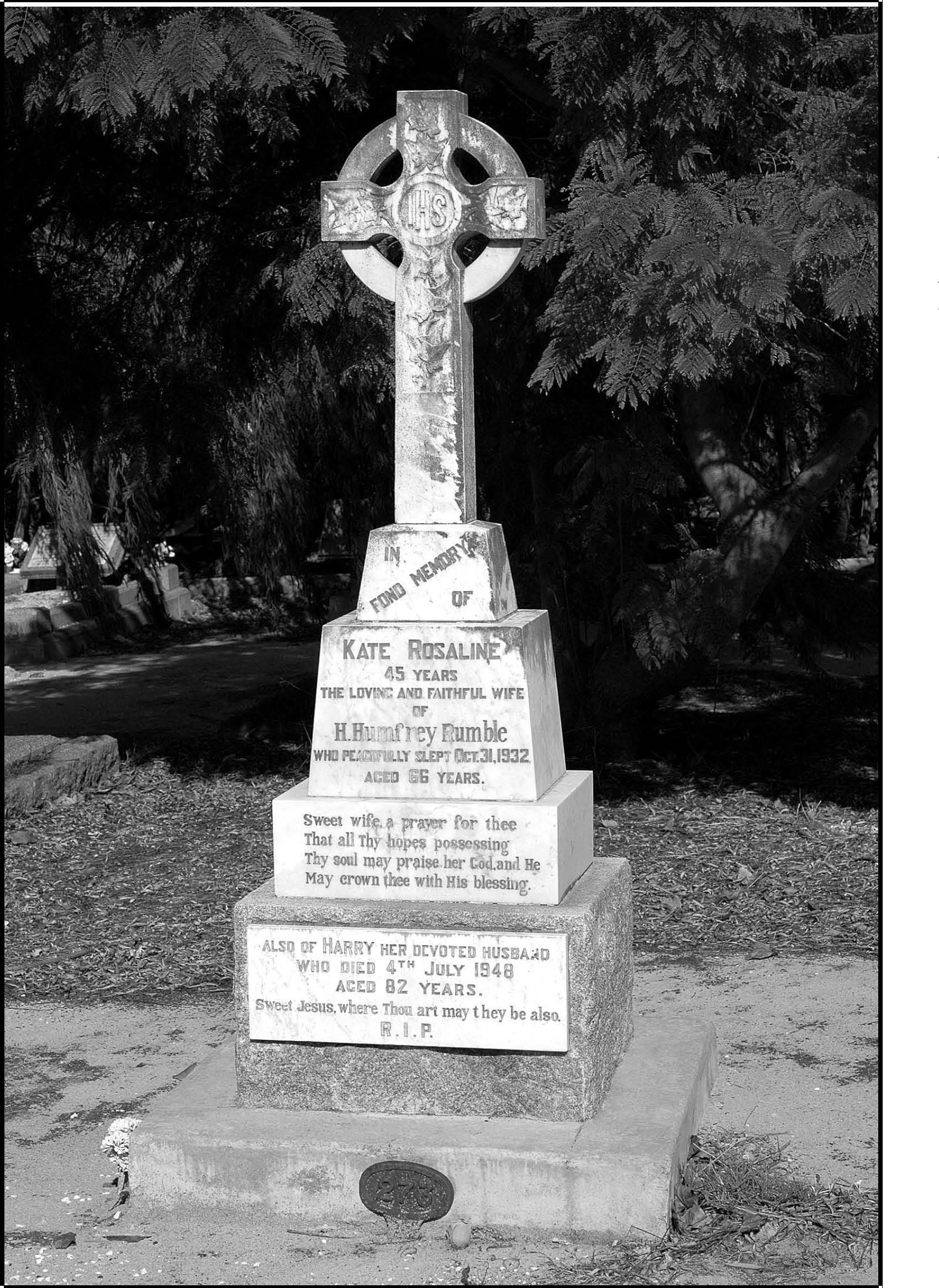 Both
Harry and Kate were buried in the same grave at Karrakatta cemetery
in Perth. [Location: Roman Catholic Section HC 0273]
Harry is recorded as ‘Henry Humfrey Rumble’
Both
Harry and Kate were buried in the same grave at Karrakatta cemetery
in Perth. [Location: Roman Catholic Section HC 0273]
Harry is recorded as ‘Henry Humfrey Rumble’
To the left of this grave is a smaller one for Maude who died 23rd October 1926
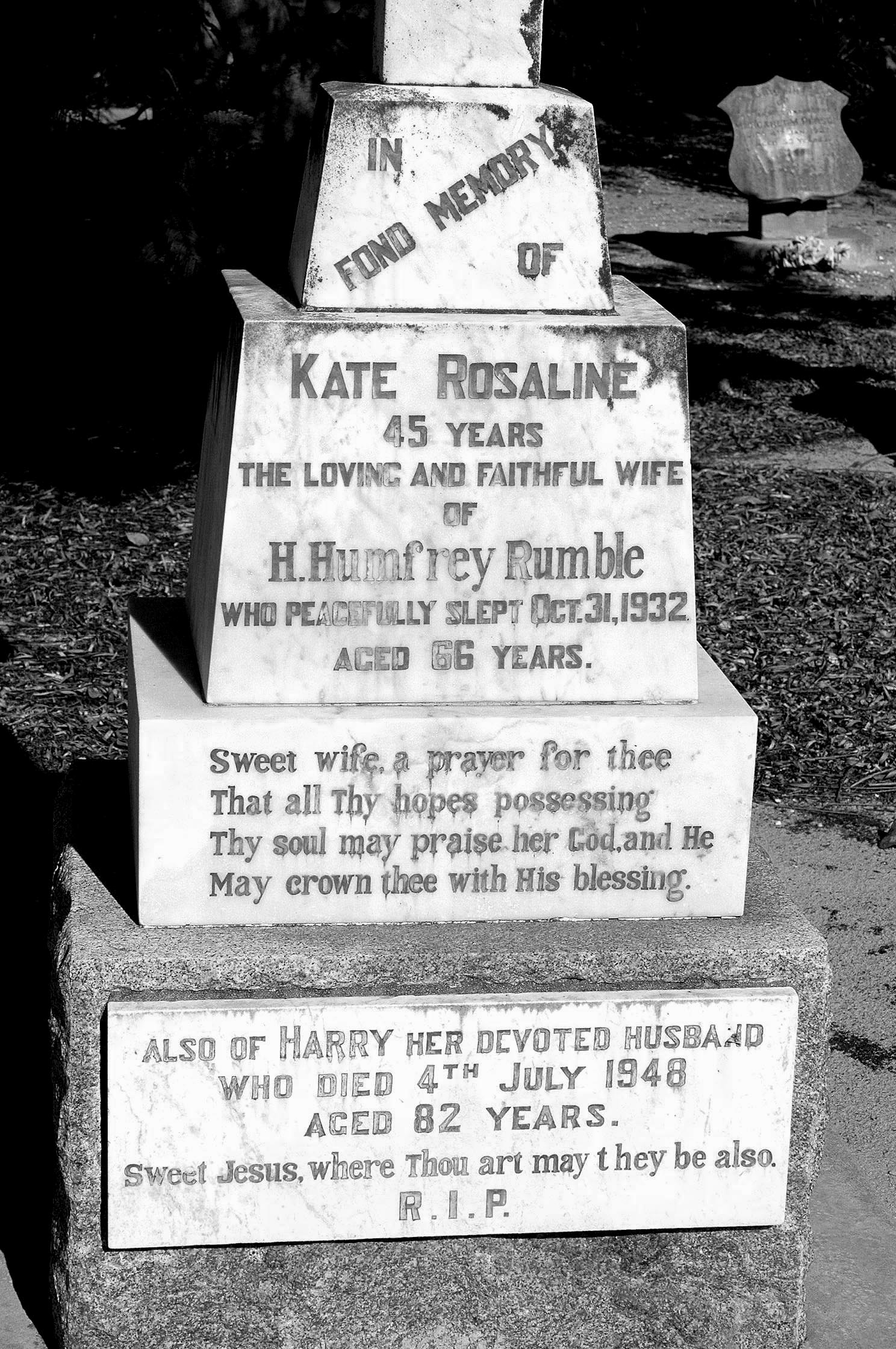 When
Kate died, her private estate became the subject of a complex Will,
drawn up, it was said, under the influence of Harry.
When
Kate died, her private estate became the subject of a complex Will,
drawn up, it was said, under the influence of Harry.
Dorothy Fall [15016] said that her father did not want the capital of Kate’s estate to go to her children. Under the terms of the Will, dated 14 March 1932, she gave £1,000 to her son Lesley who had become a priest. Half the annual income from the estate (or £120, whichever was the greater) was to be paid for life to her husband. Half the remainder of the income was to be shared between her two daughters, and the other half between her other three sons. When any son died, his share went to his wife. When a daughter died, one half of her share went to her husband, while the other half was to be shared between all surviving grandchildren. As each child and their partner died, their share was to be divided between all the grandchildren. Only when the last child and partner had died was the entire estate to be converted to cash, distributed between all grandchildren, and the administration of the estate completed.
Kate's children were unhappy with this Will. It seemed much more reasonable that, at least on the death of both Harry and Kate, the estate should be wound up, and the capital distributed among all the children. In this way, each would receive a worthwhile sum.
According to the terms of the will, the entire income was distributed each year. The Will made no allowance for inflation. As each year went by, the real value of the estate and its income declined. It was over sixty years before the estate was wound up and the capital sum, no longer of any real value, was distributed amongst a great many grandchildren.
We do not know the circumstances that led Kate and Harry to become Catholics. In the back of one of her diaries she made the entry:
Dad and I received into Catholic Church at St.Patrick's, Fremantle,
by Rev. Fr. Cox in 1902. Dad on 18th January, myself on 1st March.
From that time until April 1914 Kate and Harry went to mass almost daily. The family then moved from 102 Aberdeen street to 17 Heytesbury Road Subiaco, before which there is a ten-day gap in her diary (from 14th to 24th April) following which there is no further mention of church.
Through the years 1915 to 1922, when they were at Bunbury, there was no mention of church, but she and Harry had a social association with the Anglican clergy. It can only be presumed Harry had changed religion. Seven years later, in 1921, both started attending mass again. While they were holidaying at Darlington, Kate recorded that she attempted to go to confession and mass at Midland Junction with Harry, but finally felt too unwell to make the journey. On 18 December 1921 she wrote in her diary:
Rose at 6 a.m. and accompanied Pa to Mass and Communion in
honour of the Feast of the Immaculate Conception. My First Mass for
seven years.
She double underlined the last sentence. She and Harry then went to Mass on an almost daily basis, and the church again became a central part of her life. Kate noted her attendance at mass and the taking of Holy Communion in her diary.
She established strong relations with St. Brigid’s church and convent at West Perth and carried on daily devotions. In the diary for January 1930 she made a marginal note:
Have several times missed saying the Litany of the Sacred Heart since
getting ill health, that I have said regularly since 1922 - so determine
from now to initial each day I say it to help me not miss any more.
Each of the following days has the initials "L.S.H." in the margin.
In later years Kate was often unwell with a heart problem. When her daughter Maude [15012] died in October 1926 about a month after giving birth to her daughter, Miriamme [16014], Kate was very upset. Kate and Harry looked after Miriamme for a considerable time until she was adopted by Phyllis [15015] after she married Ted Chown.
Her diary entry for Sunday 1 December 1928 stated:
Too ill to get up - only Pa and Ted went to Mass. Phyl could not leave
me and baby. They rang up doctor early and she came along about 11
a.m. and gave me a thoro’ overhauling - heart trouble again thro’ getting run down. Also patch on 1 lung accounted for my cough. She ordered anti-flo across my back and hot water bottles . . . Pa took baby’s cot into his room tonight, and she only disturbed him once, so Phyl and Ted got a decent night’s rest, she needed badly.
Harry kept the baby in his room for several nights, and on one night had to get up to her four times, and slowly Kate recovered.
Following Kate’s death the following notice was in the West Australian newspaper:
RUMBLE. - On October 31, 1932, Kate Rosalie, dearly loved mother of Horace, Eric, Leslie, Maudie (deceased), Humfrey, Phyllis (Mrs.E.J.Chown), and Dorothy (Mrs. V. G. Fall), and grandmother of Jean, Bob, Peter and Nancy; Jim, Ross and Elsa, Miriamme, Lesley and Ailsa, Joseph, and Joan and Jack.
In 1989, Jim Rumble76 , Kate's eldest grandchild, recalled:
Grandma died in 1932 and I remember this very well; it stuck in my memory - she was the first dead person I had ever viewed in my life. I was at Hale school at the time. I remember going in the morning of
76 16009. See page 84 for the family tree
the funeral to a service in their lounge room. The priest and everybody was there, waving the smoke around. Everybody had to view the body and her face. She was dressed in white in a high collar, as she always had done: I never saw her in anything else; lying in her open coffin. We subsequently went to the funeral; there was Eric my father, myself, . . . I don't remember Ross being there, he was a bit on the young side. I remember that to this day, because of the shock to me of never seeing a dead person before.
Harry’s daughter Dorothy said that her father was a brilliant but eccentric man. He gave the family many worries through excessive drink, and ruled the household as a true Victorian father. Although Kate kept a detailed diary, there are only oblique references to his drinking problems. For example:
Monday 25th November, 1918: Mr Burns brought Dad home and
put him to bed.
In 1921 Kate wrote:
July 20: Had a bad night with Pa, so I stayed in bed all day....
July 21: Mr. Burns came up to see us at a quarter to 11 and again at 2
p.m. to let me and the girls go to town. . .
July 22: Not well so stayed in all day . . . I moved my bed into the
back room, the girls fixed up for me.
July 24: Pa better.
And again:
October 6: Pa due home on 6.20 train. Dolly had a cup of morning
tea ready for him - but no appearance - wire came from Pinjarra at
10.15 a.m. to say arriving 1.30 . . . Pa did not come home after the
1.30 train came in.
October 7: No sign of Pa. Maudie rang up a car at 10 a.m. and we
went to see Mr Burns at office - who soon located Pa at Picton and
promised to motor for him this evening . . . Burns arrived with Pa at
7.15. Maudie sat up with Pa all night. He gave her £1 in the morning.
October 8: Pa got better middle day. I amused myself making a new Will.
It is not clear that all these, and similar diary entries, related to Harry's drinking problems. Mr Burns appears to have been a younger man, with a young family, who worked in Harry's Bunbury office, and obviously helped Kate in times of trouble.
Harry appointed his eldest son Horace [15010] as his Executor, but eventually became unhappy with this and asked his youngest son Humfrey [15014] to take over his affairs. Horace’s daughter Jean [16005] recalled how this was due, in part, to her father's lack of sympathy for Harry's alcoholic binges:
Grandpa got Dad to handle his affairs, and Horace was his executor. But Grandpa went on these benders every now and again, and Granny would ring up Dad and ask him to come over to the North Perth house. Dad wasn’t very sympathetic with Grandpa. If Harry was put in hospital, or if one of the other family members looked after him, they would wean him off the alcohol by watering it down, bit by bit. Dad didn't do this. He locked Grandpa in the bathroom, and said “There you are. There’s a tap if you want a drink.” He gave him a pillow and said, “You can come out when you are sober.”
Dad would then return home, leaving him locked up all night. First thing next morning, before Dad went to work, he would go over to the house and let him out. One time Dad said that Grandpa was a cunning old devil. During the night he found a nail file and used it to file the wood around the lock. By the time Dad returned in the morning, Grandpa had just about got the door open.
Jean did not know how bad these binges were because it was kept very quiet in the family and the children were not told. Horace always wanted to keep such matters “Hush-Hush.”
Later Horace said to his daughter:
“Pa didn’t like me anymore. He’s taken his affairs away and given
them to Uncle Humf. He’s executor now.”
Harry’s youngest daughter Dorothy told me that her father was not a person you could ignore, and recounted several anecdotal stories:
Harry played the banjo and, with Kate at the piano, they entertained their friends, or gave an item at a concert. Sometimes he would wake up at two or three in the morning, sit up in bed beside Kate - who was trying to sleep - and practice his banjo.
Dorothy also said that the family had a difficult time when Harry bought a violin. Kate recorded this in her diary for 10 March 1923:
Dad came back from Geraldton at 10 a.m. He changed his banjo at
Flight’s for a violin, worth £17-7-0, this afternoon and bought a tutor
to teach himself. I went to bed with a bilious attack.
Usually he went to bed at 10 pm and if Kate had friends in for the evening, he would come into the room precisely at ten, ostentatiously wind up the clock and pronounce, in a loud voice:
“I don't know about you, Mother Darling, but I am going to bed.”
All the ladies would scurry home as fast as they could.
Once, when he was due to return from a bush camp, an amused boy delivered a telegram to Kate:
“Hot Bath. Macaroni Cheese. 8.30pm.”
He did not believe that everything in the newspaper was suitable for his children to read - especially the girls. So he cut out anything of which he did not approve. Dorothy and the others received the paper with little pieces missing.
When he studied the bible carefully, he cut out of it all those passages with which he did not agree.
Many years later, in the early 1940s, long after his retirement, a photo appeared on the front page of the daily newspaper in Perth. This showed him, arm raised over his head, laying down the law to a young policeman.
At that time a traffic law had been introduced forbidding people to “J-Walk”77 across the street. The police officer had caught Harry allegedly doing this in the centre of the city. Harry always spoke with great certainty and authority. He expostulated with the young policeman:
"J-Walking? J-Walking? I am not J-Walking, young man. I am
He was cautioned.
In spite of all his eccentric ways and problems, he did many things for his family, and Kate stuck by him and defended him always. Her diary reveals a strong positive side to him, as well as a negative. He and Kate appear to have helped their son Eric [15011] financially when he set himself up in business78. He also helped his daughter Maude [15012] financially when she and her husband Frank were first married, and bought a house in Goomalling.
Kate’s diaries also reveal how she dealt with some of Harry’s problems. For example, a cryptic entry in 1918 about “Whisky Tax” reveals that he had to pay her a tax of eight shillings every time he brought a bottle into the house!
77 J-Walk / To walk diagonally across a busy street
78 It seem s that they per mitted Er ic to take a bank loan , lodgin g the title deed o f their Nor th Perth home with the bank as security.
Dorothy said that, when her father was in Bunbury, he invented an ingenious quay wall to minimise harbour silting. Kate stated in her diary on 31 October 1917 that Harry received a wire79 calling him to Perth to see the Commonwealth Committee about his invention. Further diary entries followed:
12 March, 1918: Dad shewed the Harbour Board, Mayor, Jack
Anderson and Mr. Paisley over the mole, also his patent and working
model . . . .
16 March: An account of Dad's mole and quay wall invention in
today's paper.
Unfortunately, Harry was egocentric and wished to claim total credit - and benefit arising from the invention - for himself, rather than share with colleagues. As a result he was thwarted by others, and nothing came of the idea.
Dorothy said that, after her marriage, whenever she came up to North Perth to stay with Harry and Kate, she would arrive at the house after a weary trip with small children. Even before she stepped in the door, Harry greeted her with the words: “When are you leaving?”
His granddaughter Jean recalled that sometimes, when she was eight or ten, the grandchildren gathered at the North Perth home if one of them had a birthday, or was up from the country:
Before long, Grandpa would have us all sitting round in a semicircle, cross legged, and he’d get these wretched peppermints out of his pocket and break them into about a quarter each, because he said they were very strong. We would have to sit and suck these peppermints while he played his banjo to us. That could have gone on until I was about ten, I suppose, from when I was little. We didn't dare speak, and I don’t think we enjoyed it very much.
Jean continued:
I was terrified of Grandpa. I didn’t say a word in front of him. Also, I didn’t like it when he wanted to kiss me, because of his moustache. I remember when he was old my brother Bob once drove us to the home at which he was staying. I refused to go in because I thought he would kiss me. Then he came out to the car and kissed me.
In 1989, Jim Rumble [16009], Harry Rumble's eldest grandchild, recalled some memories of his grandparents:
79 “Wire” / telegram
I don’t remember much of Harry pre-second world war. He and Katie used to visit us at 419 Rokeby Road, Subiaco, on a Sunday afternoon. He would leave sixpence or threepence for us. My mother, Isabel, would provide afternoon tea, then they would catch the tram back to North Perth. I would have been eight, nine or ten at that time80.
My father told me that he wondered how Harry kept his job with the PWD - but no-one ever knew, because he would be on drinking bouts, sometimes for days on end. They would find him thrown out of an hotel, or wherever it was, and he would be brought home in a horse and cart. Where they got the horse and cart from, God only knows.
After Katie’s death in 1932, he must have sold the North Perth residence; I can’t remember where he took up residence then. I remember he visited my father’s place at 2 Webb Street, Cottesloe. He then lived at John street, Cottesloe and got involved with some landladies - there was a little bit of shade around some of the landladies who would get hold of his pension. He used to discuss this with me. He bought one of them a car at one time; I remember my father telling me this.
I went to see him at his boarding house in John street; this rather fat woman, who was older than I, was there at this time. She was the one who had been getting at his money. Aunty Phyl [15015] also had said that he bought them a piano. The landladies would get all sorts of gifts out of him, plus money.
It was at this stage that this woman wouldn’t have drink in the house. Harry used to get me to smuggle it in. Every Tuesday on my way to Fremantle for Rumbles Limited81, as a Rep., I would call on him at a quarter to nine in the morning, and he would give me six times one and tuppence - or whatever the beer was in those days. This must have been postwar, since I would not have been allowed into a pub until I was twenty-one in those days. He used to get me to purchase this material for him. I would have my lunch at Fremantle, call back on my way through Cottesloe, and drop the grog off. Before I left he would pull the tops off the six bottles and put them in his wardrobe; they used to go flat and warm - he never refrigerated it.
On occasions, when I would call there on a Tuesday morning, he would have consumed the lot and have been without beer for a day or two. At that stage, since the woman wouldn’t allow it in the house, he couldn’t get out to buy it for himself. I would always bring it in a box
-she would never know what I had there.
80
1927 - 1929
81 A com pany set up by Eric Rumble firstly as a manufacturer’s representative. It developed as a representative for pharmaceutical manufacturers.
This went on for a few years. Always he would give me the great sum of two shillings and sixpence for my labour. I also did his banking: draw his money out of his savings bank: the Commonwealth Savings Bank in Fremantle. He always kept the passbook. Whether he strapped it to his waist to keep it out of the woman’s sight, I do not know.
He never drank spirits, only beer. Always Emu Bitter, the other was too sweet for him. I always saw him each week, and the experience was repetitious. He would grizzle about his gout and get me to cut his toe nails, because he couldn’t reach them. He wouldn’t go to a chiropodist because that would always cost him money.
He had money, but he never gave anything to me. Except that he said he was going to die one night. I was called down there in a hurry, and he was convinced he wasn’t going to last the night. I was given his beautiful barometer - which was his retirement present from the PWD. Then, when he didn’t die in the next couple of days, he wanted it back. But, No Way! I’ve still got it. This was the only gift I had from him, other than the two and sixpence.
He had few interests. His only real interest was the bible - which he cut to pieces with scissors: pieces he didn't like he would cut out. After I married - this would be wartime82 - my wife Joan sometimes came with me to see him. He would greet her with: “What are you doing for the war effort?” This put Joan on the defensive since she said she wasn’t doing anything much in those days, apart from working in the “colour patch” tea rooms and restaurant, where the proceeds were given to military camp comforts.
He was pretty frail at times. He would walk with a shuffle; always have slippers on. He would never come down into the street to see me off. I would always say “cheers” to him in his bedroom. He never shouted83 me a meal: never would I have had lunch there. There was just this two and sixpence given to me.
Once he got to the hotel84 I ceased buying him beer. It was supplied by the hotel, but it was always soft. He always took the tops off.
He was an eccentric. He would lecture me on religion and how he fought with this priest and with that, and he was swapping from one religion to another during the latter part of his life. He got back into Catholicism time and time again.
82 Second World War, 1939 - 1945 83 To “shout” someone is to give to or pay for something, such as a drink or a meal. 84 This was the Esplanade Hotel in Fremantle. He had a permanent room there.
The 80th Birthday of Harry Humfrey Rumble 21 June 1946 Gathering at 2 W ebb Street,
Cottesloe - the home of his son Eric.
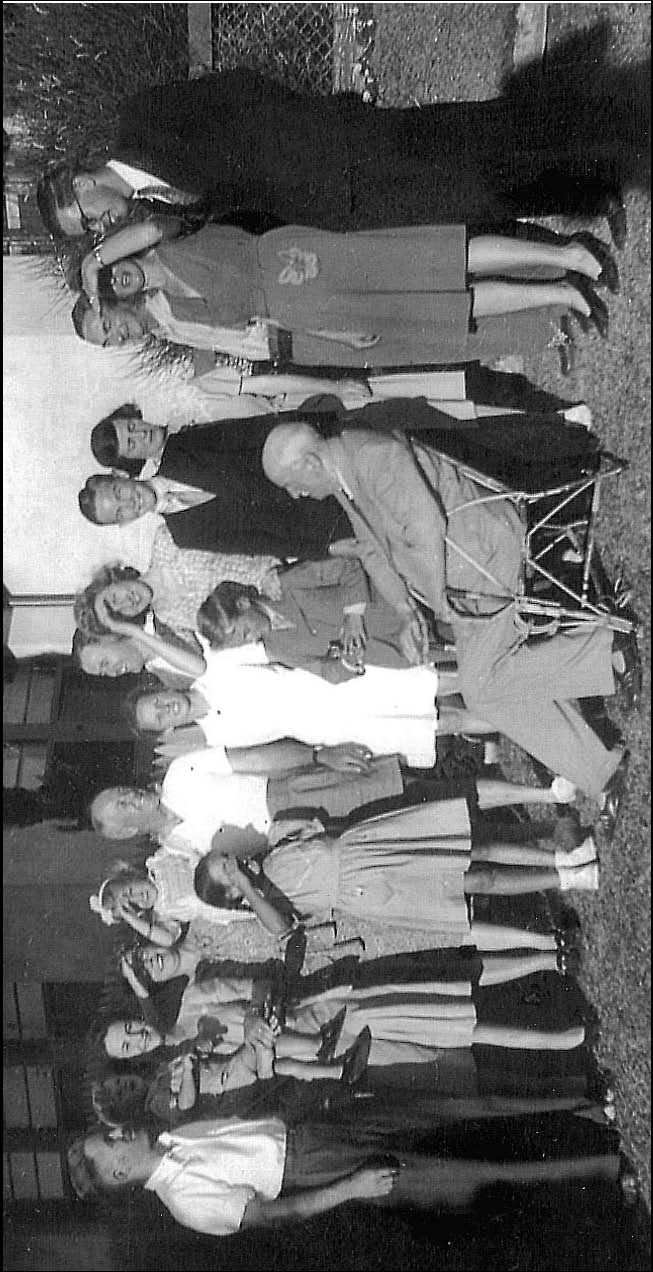
The names are opposite each person in the photo
John Fall [16021]
Dorothy R umble
[15016]
Edward Chown
[16019 - in front],
Phyllis Rumble
[15015], Joseph Chown [16018], Harry Humfrey Rumble [14004 in front]
Beryl Osborn [16010], Edward Chown
[16019] in front Ross Rumble [16010],
Elsa Rumble [16011],
Eric Rumble [15011],
Robin Rumble [16012] Penelope Rumble [16013],
Lydia Bassett [15011B],
Joan Davey [16009], Graeme Rumble [17013],
Jim Rumble [16009],
HARRY’S DEATH IN 1948 - HIS FAMILY 177
His granddaughter Jean [16005] recalled that when he was staying at Cottesloe and, she thought, almost eighty years of age, he was sued for breach of promise. She did not know the details, but said:
It’s only what I overheard, and I think it was in the paper. At this time Grandpa was receiving periodic payments from Granny’s estate. Whenever the money arrived, he splashed it around, and his landlady thought he had plenty of money. One time, when he got on one of his periodic alcoholic benders, she got a proposal out of him. Of course, when Grandpa sobered up, he wasn't having anything to do with it. The landlady sued him for breach of promise.
Other members of the family recalled that it cost Grandpa some money to get out of the difficulty.
Because of his domineering ways his children were reluctant to have him live with them, although he asked most of them to do this. He ended his days, a lonely man, in a boarding house in Rivervale. He died on 4 July 1948.
Before I move on to discuss my parents, Dorothy Rumble and Victor Fall in detail, I will present a short sketch of the other members of Harry and Kate’s family.
As a reminder, on the next page I present again the family chart that I showed on page 84
Horace Rumble born in 1889 started work with the National Mutual Insurance Company in 1905. He served in World War I and was wounded in France and taken as a German prisoner of war. After the war he returned to his company, married Vera Glover and had four children. He worked all his life for National Mutual. His major interest was competitive and recreational sailing with the Royal Perth Yacht Club. In 1989 he and Vera celebrated their 70th Wedding Anniversary. He died in December 1989 at the age of 100. His wife died in October 1992. He was a man of great bearing and strong character.
Eric Rumble, born in 1891, started his own business as a manufacturer’s representative in 1921. He married Isabel Anderson in 1915 and had two sons, James and Ross. This marriage failed and he later married Lydia Bassett and had three daughters, Elsa, Robin and Penelope. His son, Jim, said he was a very good positive thinker. He, also, was interested in sailing. He retired in 1963, passing the business to his sons. He died in a road accident in 1965.
Leslie Rumble, born in 1892, after an early career in photography he became a celebrated Catholic Priest, receiving his Doctor of Divinity in Rome. In Sydney, in 1928 he instituted a radio program, being a question and answer series on the Catholic Faith. His book, ‘Radio Replies’ based on this series, sold over four million copies world wide. With the Second Vatican Council came sweeping changes in the church in the 1960s, to which he did not easily adapt. In retirement he lost most of his sight through glaucoma and died on 9 November 1975.
Maude Rumble, born in 1894, trained as a nurse. She was artistically talented. She drew in pencil and pastels, and took part in amateur theatricals, marrying Frank Spencer on 14 April 1925. Her daughter, Miriamme, was born on 7 September 1926, but it was a difficult breech birth. The instruments used in the birth had not been properly sterilised and Maude died of septic meningitis on 23 October 1926. Eventually, Miriamme was adopted by Maude’s sister Phyllis.
Euean Humfrey Rumble, always known as Humfrey or Humf. was born in 1896. He left school at the age of 14 and worked as a copy-boy for the West Australian newspaper before joining the firm of Charles Atkins for whom he worked for the rest of his life. He became manager of their “Mechanical” Department, which dealt with the wholesale distribution of hardware, handyman and industrial machine tools. In his youth he was a keen cyclist, belonging to the Perth Cycle Club. In 1922 he married Muriel Love and they had three children. He became an enthusiastic fisherman, enjoyed camping, and took an interest in horse-racing. At home he was a handyman and a great hoarder of things that might prove useful. He died in 1979
Phyllis Mary Rumble, born in 1899, trained as a nurse and met Edward (Ted) Chown in Bunbury in 1918 when he was a young officer on the sailing ship Monkbarns. They were married in 1927. Phyllis and Ted adopted Miriamme and had two sons of their own, Joseph and Edward. For many years they lived at Goomalling where Ted became Road Board (Shire) secretary. Phyllis was an extravert and an enthusiastic supporter of the church. She was proud that her son Joseph became a priest. In 1942 they left Goomalling and came to Perth , but she was shocked when in 1972 Joseph left the priesthood and married. Ted died in January 1976 and Phyllis died in February 1988.
Now we are ready to move on to my mother, Dorothy, Kate and Harry’s youngest child.
Dorothy, the youngest child of Harry Rumble & Kate Knight, was born on 29 December 1900, when the family lived at Marmion Street, Fremantle. When she was about three years old, her family moved to 1 Colin Street, West Perth. Dorothy ran down to the back fence at the new house and, through the open pickets, saw another three year old from the house behind. They played the game of “I can see you!” , “No you can’t” through the pickets and eventually became friends. From this she developed a lifelong friendship with Isabelle Greayer, who eventually married a John Reynolds, and settled in Tasmania.
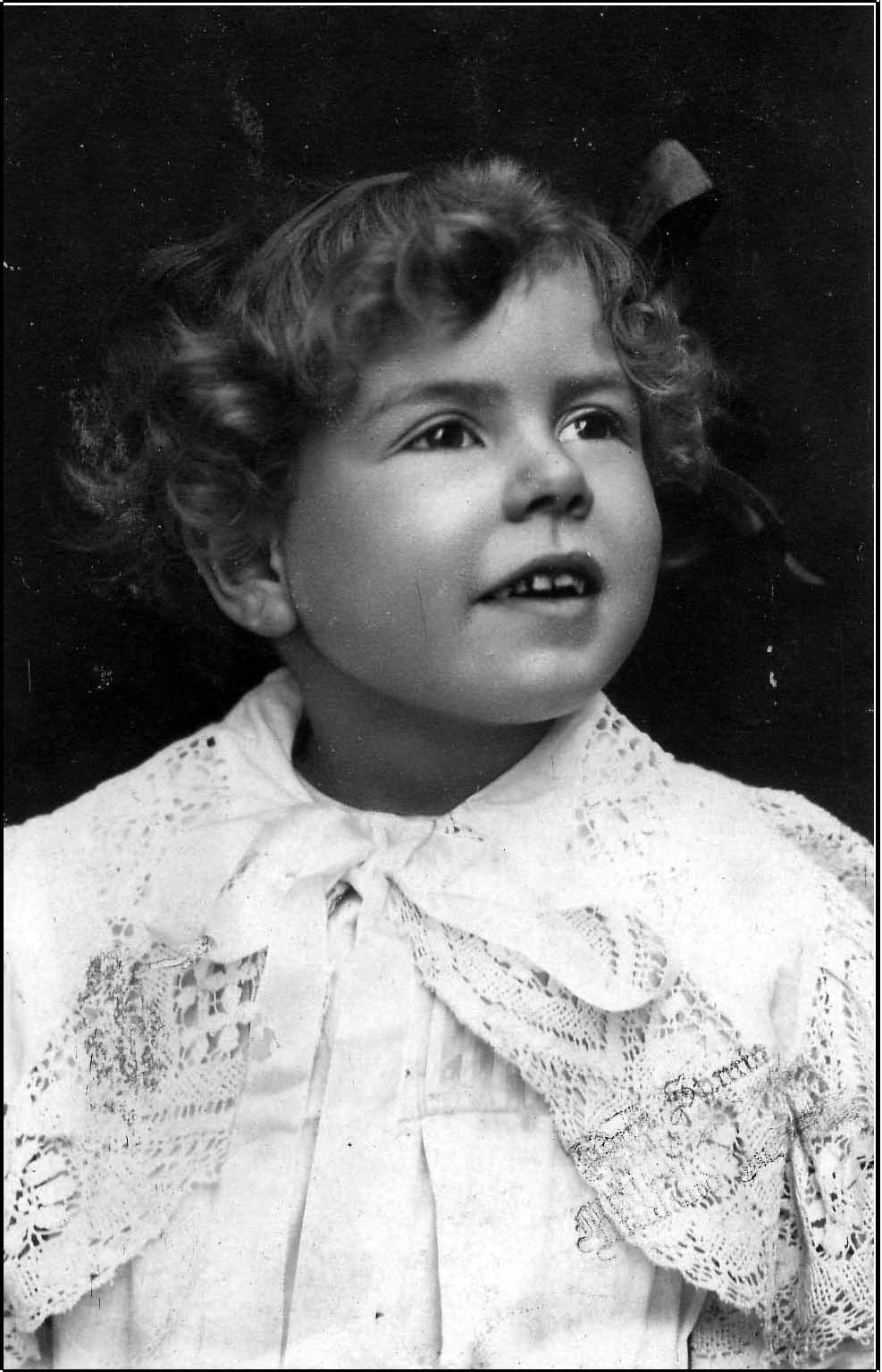
In 1989, Isabelle, then in a nursing home, recalled this incident, She also recalled that, when the Rumble family lived in Colin street, they had a small dining room with the children sitting on forms along the sides and Pa, as he was always called, had a long cane with which he tapped the hands of anyone not behaving at table.
She recalled:
“I was always a bit frightened his stick would reach me when I was visiting. . . All the boys grew up such nice people, considering. . . we used to hear them being whacked in the back yard by their father.
“My Dad used to say, ‘They’ll have trouble with those boys, they’ll turn on their father one day,’ but they never did.”
However, in 1989, Horace, the oldest boy - and then almost one-hundred, denied that the boys were beaten.
When she was a little older, but still living at Colin Street, Dorothy remembered that one evening, when her parents went out, the three girls, Maudie, Phyllis and Dorothy climbed onto the roof from the dormer windows in their nightdresses. The boys promptly locked the windows so they could not get back. They stayed on the roof until their parents returned.
 It was also in this house that Dorothy remembered being
terrified by her brothers. The boys put sheets over their heads and
pretended to be ghosts, pouncing out on her as she went up the steep,
narrow stairs to bed. Dorothy became very frightened and
It was also in this house that Dorothy remembered being
terrified by her brothers. The boys put sheets over their heads and
pretended to be ghosts, pouncing out on her as she went up the steep,
narrow stairs to bed. Dorothy became very frightened and
said she remained scared for years. She always regretted being the youngest child because her parents did not want her to grow up. She was
encouraged to use baby talk - saying "Geen" and "Boo" for "Green" and "Blue," up to an age where other children laughed at her. This made her feel very under-confident.
We do not know the year in which the family moved to 102 Aberdeen Street, Perth, a house that provided more space. Dorothy related how the boys rode their bicycles round and round the dining room table, and how, when home, their father was very strict. No one could speak at the table, and Harry kept a stick nearby that he used to tap on the head, those who broke the rules. When Harry and Kate talked, everyone else had to be silent. With such a family of “talkers” as the Rumbles proved to be, perhaps this was the only way in which Harry and Kate could hold a conversation!
Dorothy was very conscious of the teasing she received from her older brothers, particularly Horace, who was sixteen by the time she was five. She was also gravely affected by her father’s drunkenness, and in later life felt that she never overcame the effects of her childhood experiences, and was always afraid of life. She felt very close to her Mother and also to her older sister, Maudie, who often acted as mother to her.
She once wrote in a letter:
“For my Mother, to save her suffering, I did everything.”
In the same letter she said that her Mother and Maudie were her only true friends.
Recalling her mother’s death in 1932, she wrote in her diary:
Mother had written and told me how much she was suffering, because I have always understood her so much and she could never hide her sufferings from me. How I worshipped her and how I shall miss my mother and Maudie thro all the years to come - Maudie who knew how terrified I was to face things alone - but I could not tell my mother because she had already had too many sorrows, and I did love her so.
Dorothy was closest in age to Phyllis, very similar in temperament, but often had disagreements through sibling rivalry. When they were teenagers, Phyllis, always very popular with the boys, teased Dorothy by saying, “No matter what boy you get, I will take him from you.”
When she was sixteen and living in Bunbury, both she and Phyllis attended dancing classes each week. In September, 1917, they both starting learning shorthand. Dorothy also went for a short period to night-school to learn book-keeping, but, unlike her two older sisters, she remained at home until marriage. Her mother’s diary shows that during the Bunbury period from 1915 until 1922 Dorothy led a life of leisure, with few responsibilities. She socialised with a wide group, helped her mother at home, went swimming, boating, crabbing, dancing, and played tennis.
She often day-dreamed about how she would like life to be. She thought of her grandmother, Letitia Knight, living, as she thought, in a grand house with servants, and dreamed of such a life.
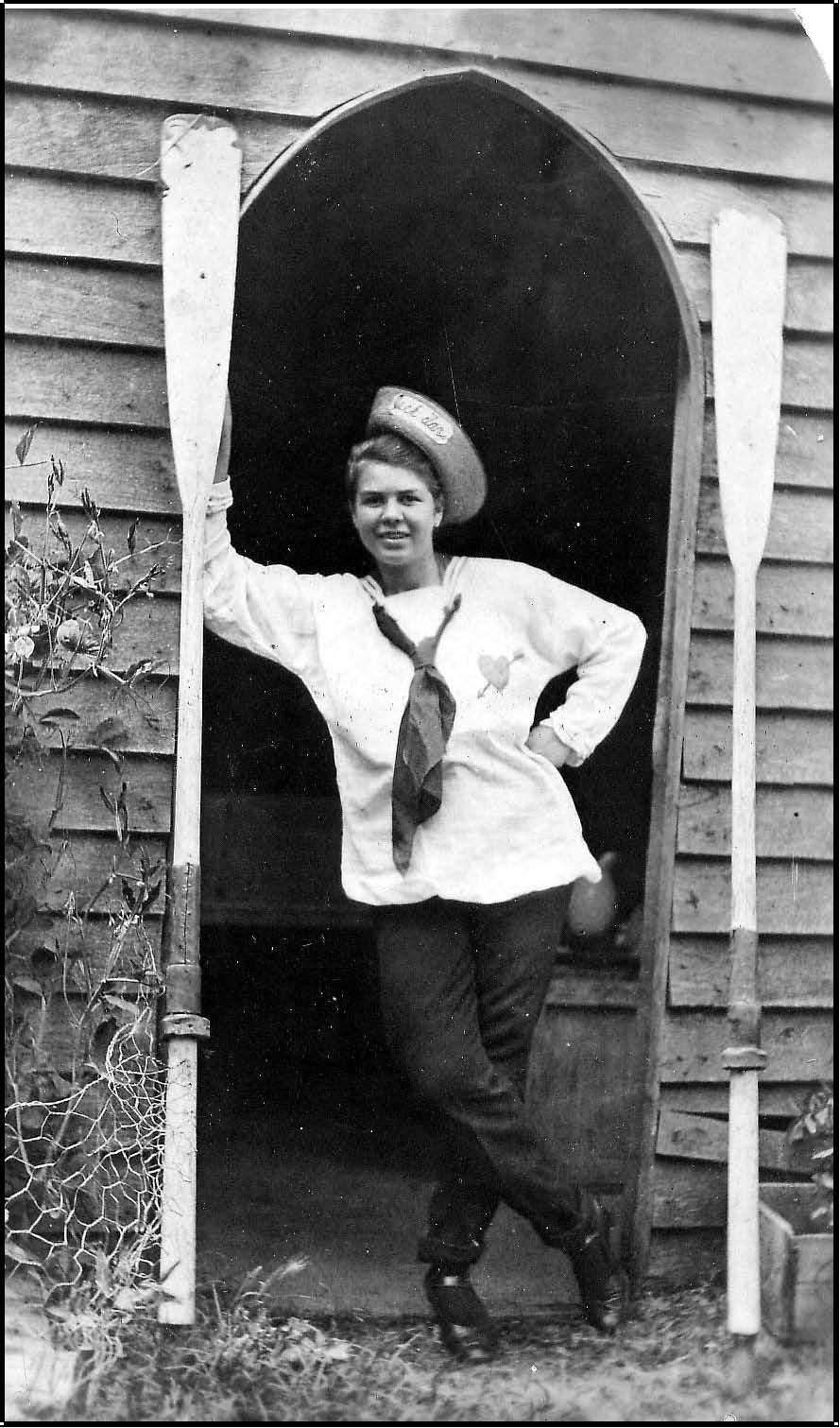
Throughout her life, she remained simple in her outlook, and loved children. Once she had the opportunity to work as an untrained helper for two weeks at “Lady Lawley’s Cottage by the Sea” for crippled children, at Cottesloe. It was early June 1922 when Phyllis contacted her to see if she could help them for a fortnight as they could not find a nurse for the convalescent ward, and more patients were arriving.
This short experience meant much to her since she spoke of it again and again throughout her life, as though she had been working there for a much longer period.
Dorothy in Bunbury
She loved fairy tales because they always ended with “and they lived happily ever after”, and she brought her children up on a diet of Grimm’s Fairy Tales, King Arthur and the Knights of the Round Table, and Alice in Wonderland, together with
A. A. Milne’s stories of Winnie the Pooh.
She did not start school until she was seven and left at the age of fourteen. She was always conscious of her lack of education and would sometimes say, quoting from Milne, “You must remember, I am a bear of little brain.”
Life changed for Dorothy in 1918. The sailing vessel “Monkbarns” arrived at Bunbury just before 11 November - the end of the First World War - to load timber, and it remained there until 5 December.
I have already recounted how Victor Fall was a midshipman on the Monk-barns and met Dorothy at a party given by the Bunbury Mayor in November 1918.85
Recapping the story, it was on 20 November that the Mayor, Mr Baldock, gave a party at his home for the officers and apprentices on the Monkbarns. Both Dorothy and Phyllis went to the party, and there Dorothy met Victor Fall who was almost sixteen years of age, but said he was eighteen. To Dorothy, Victor seemed just what she imagined a polite, quiet, refined young English gentleman would be, and he walked home with her that night.
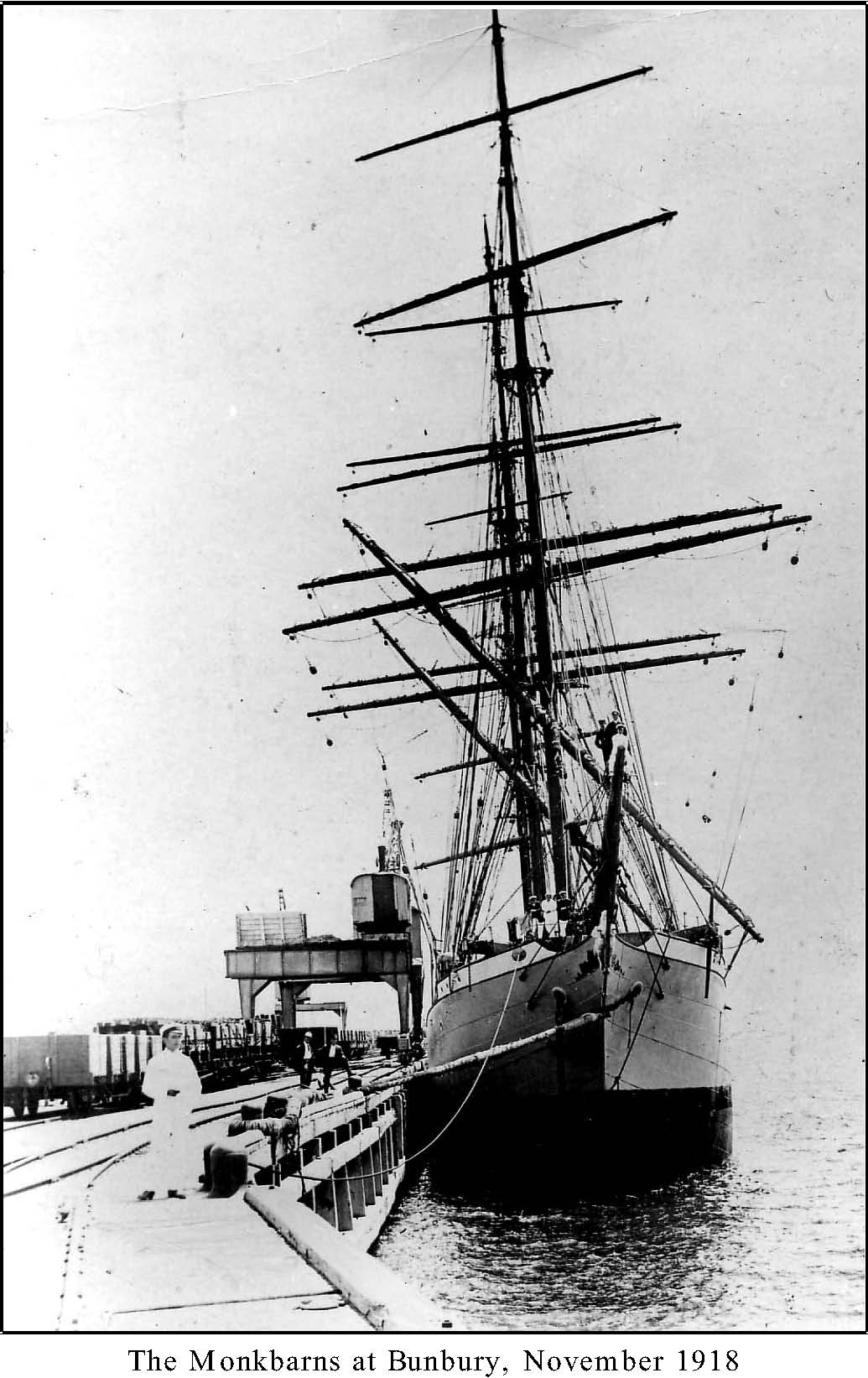
We are now ready to read on . . . . .
85 See pages 156 - 159
Dorothy’s sister, Phyllis, had met a Mr. Chown at the party, so the girls decided to ask them home. Phyllis wrote a letter to Mr. Chown asking if he would come to tea on Sunday, bringing Mr. Donnithorne and Mr. Fall with him. They also asked the Mayor’s daughter, Connie Baldock, to come so it would balance the group.
On Sunday Dolly was bitterly disappointed; they all arrived except Mr. Fall. Mr. Chown gave Vic Fall’s apologies saying he had been rostered for duty. At 3 pm the boys rowed the girls up to Turkey Point, but were thankful when the Bath family offered to tow them back behind their launch. It was a swelteringly hot day - the first real foretaste of the West Australian summer - so after tea, they all strolled over to the back beach. Dolly excused herself. She wondered why she had felt so terribly disappointed all day. While the others were out, she wrote a letter in her neatest hand:
Dear Mr. Fall,
It was so disappointing that you should suddenly have to go on night duty instead of coming here today, for I felt quite out in the cold; so I am sending you these few lines to ask will you come to tennis with me on Tuesday afternoon, it is nearly opposite our house, so could you call here for me at about 2.30 pm
I had better tell you that I am only a beginner, also will you please bring tennis shoes, if necessary I can borrow a racket for you. Hope you will not disappoint me again,
Yours sincerely
Dolly Rumble.
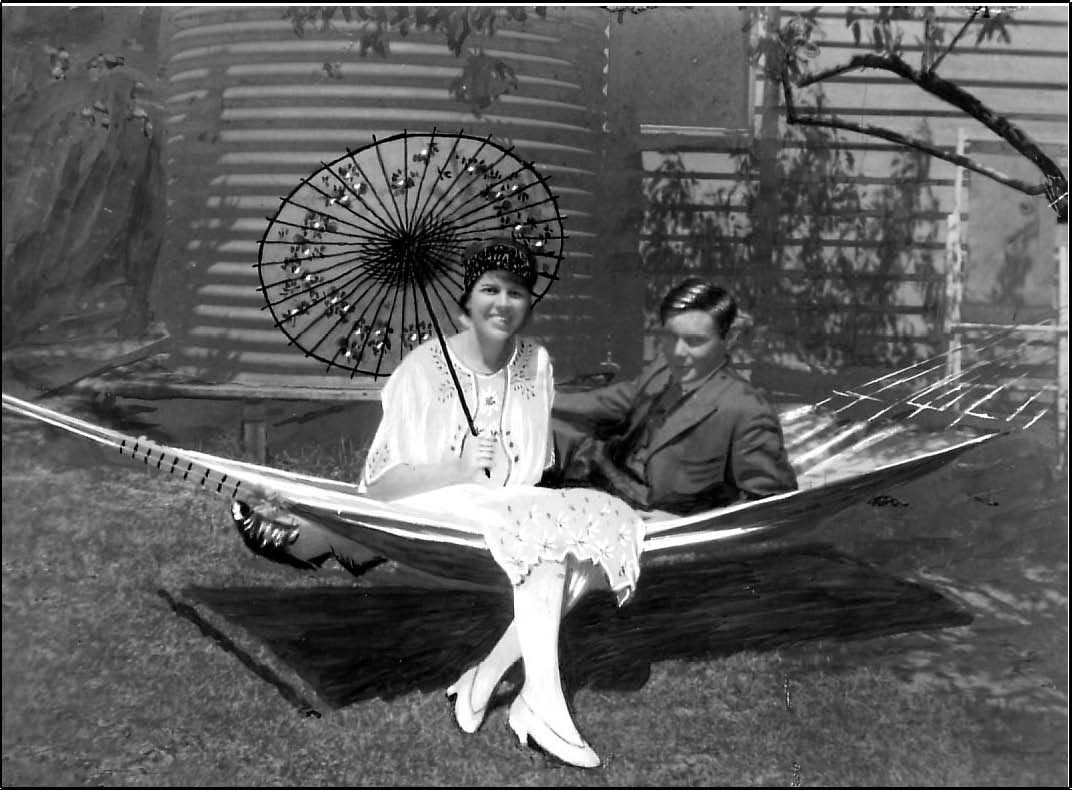
Dor othy and Victor at Bunbury, 1918
Dolly did not have to wait until Tuesday to see Mr. Fall again; On Monday afternoon she went down town and met him by chance. It was her mother's last “At Home” day for the year, so she invited him back to the house. Her mother introduced him to the ladies as “one of the young Middies off the Monkbarns.” He had been so polite and gentlemanly.
On Tuesday he arrived at 2.45, ready for tennis, and they enjoyed several games together. At four o'clock, Phyl came over with some afternoon tea, and they all sat down on the lawn and talked.
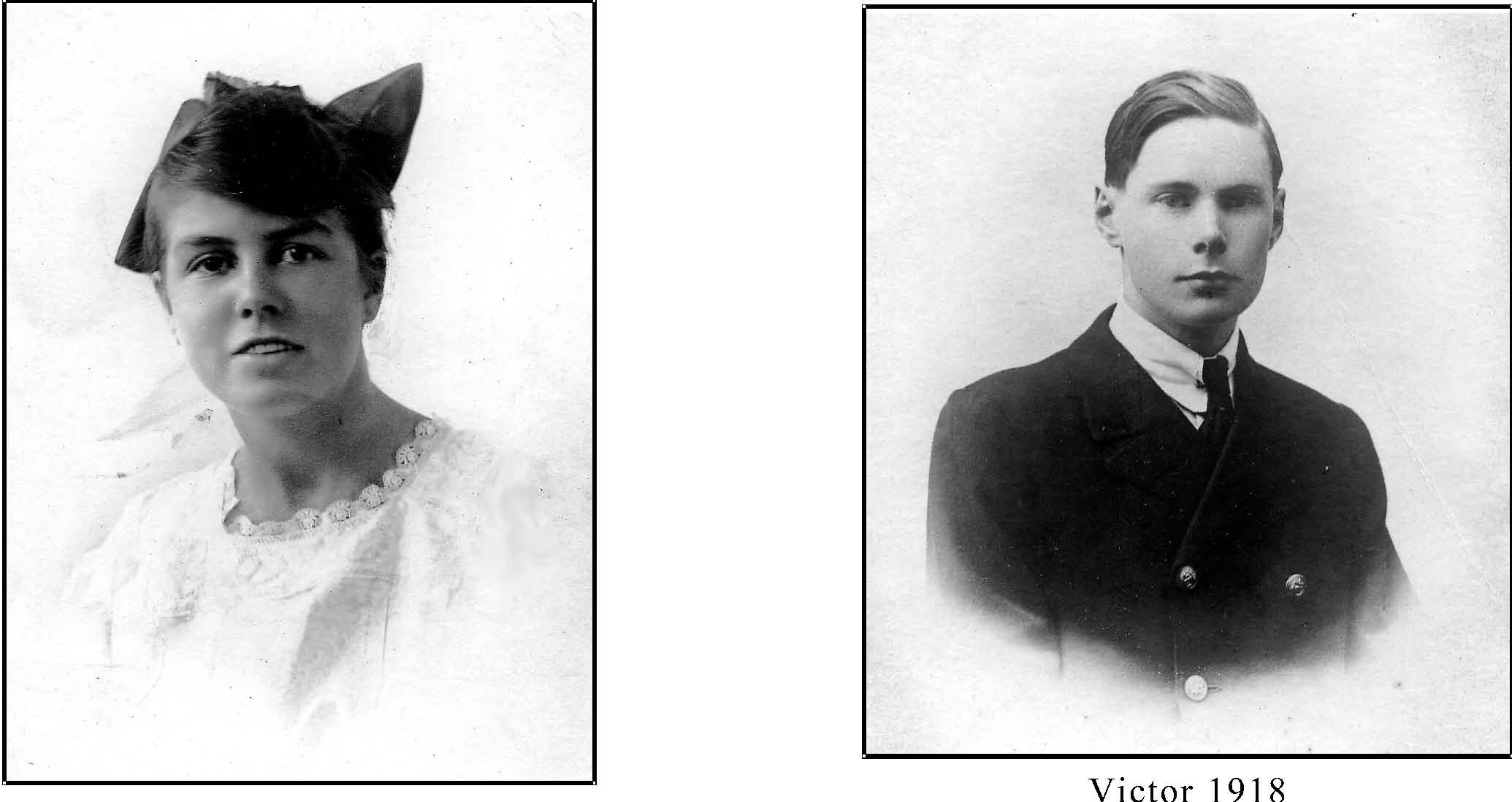
Dor othy, 1918
Between that day and when the ship sailed, Victor and Dorothy saw each other constantly. By the time the ship sailed she knew that Victor was the man she would marry. The Monkbarns set sail from Bunbury on Thursday, December the fifth. Victor pencilled the record of the departure in his little log book:
Dec. 5th.: Left Bunbury for Cape Town - with a cargo of Jarrah wood. There are no tugs in Bunbury so we had to sail right away from the buoys. I was aloft on the fore - loosing sail. We set the jibs & fore-lower top’sle first and then, once she had her head to the sea, crowded sail after sail on her.
I had plenty of work to do up aloft, from where there was a fine view of the bay & town. The jetty with the “Auldgirth” alongside, the long breakwater with the lighthouse on the hill at the back. The wreck across the Bay at Turkey-Point, White Road, with the roof of Rumble’s house showing plainly in the sunlight. Everywhere blue sky & sea with glistening sands & in the far distance the hills of the Darling Range.
By the 2nd Dog watch the coast had become a faint blue line. The last most of us will ever see of Bunbury. . .
In her diary for that day Dolly wrote:
Thurs. 5th. : The boat sailed today for Capetown, Phyl and I went to
tennis in the afternoon, I did some ironing. Phyl and I walked down
town after tea for some stamps.
And so started a courtship by correspondence.
It is time now to break away from our story of Dorothy and Victor and to look at Victor’s family. The previous page shows what little we know of the ancestry of my father. It is very little because neither his brother nor sister had children, and so there was no one in Britain who could provide family information. My father had left Britain at such a young age that he also knew very little of his background, compared with the many sources we had for my mother’s Knight and Rumble ancestors.
The ancestry chart shows that the earliest Fall of whom we have any information is the Reverend Edward Fall, my great-great grandfather, so we will start with him.
There is one sense in which I have known my great-great grandfather for almost all my life, perhaps better than any of my ancestors other than my own parents and my mother’s parents.
In 1937, when I was nine years old - and still living in Yarloop, I became aware of a large rectangular crate stored in a spare room. Dad said that it contained an oil painting of my Great-Great-Grandfather, Rev. Edward Fall. He told me that he had received it from England in 1925 but until now could not afford to have it framed in Perth. Eventually the job was done, and my reverend ancestor appeared on the wall of our house. The painting was probably executed around the time of his retirement from the Baptist Church in England in 1848.
From 1937 until the present time, almost seventy years later, he has looked down on me from the wall of each successive home in which my parents have lived. He now hangs on the wall in my own home. At first I was intrigued by having a painting of an ancestor, but soon thought nothing of it. However, as the years went by, I became more aware of him.
For many, many years he has watched me from his place on the wall in a benign, benevolent way. Today, I feel that I know him well and, strangely, that he knows me; he created in me a sense of my ancestry. Born in 1779, he died in 1859 at the age of eighty.
I often looked at, and pondered on the portrait of my old ancestor. What had life been like for him? What had been his attitude to the changes around him? He had lived in that most exciting of times: The First Industrial Revolution. This started in Britain around 1760 and was at its height during his lifetime. There were technological, socioeconomic, and cultural changes with which he and the rest of society had to contend. How aware of them was he?
When Edward was 28 in 1807 there was the abolition of the slave trade. Technologically there were new materials introduced in manufacture, notably iron. There were new energy sources and new machines such as the spinning jenny and power loom. James Watt had already perfected the steam engine when Edward was just two years of age and, when he was 32, in 1811, the Luddites started smashing textile machinery that was displacing them from their handcraft work. With this there was a new organization of work known as the ‘factory system’, which entailed increased division of labour and specialization of function. By 1815 London streets were being lit by gas, and in 1825 when he was 46 - the first railway from Stockton to Darlington was opened.
The Reverend Edward Fall 1779 - 1859 Baptist Minister